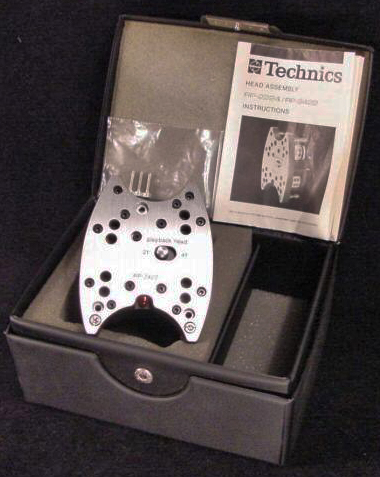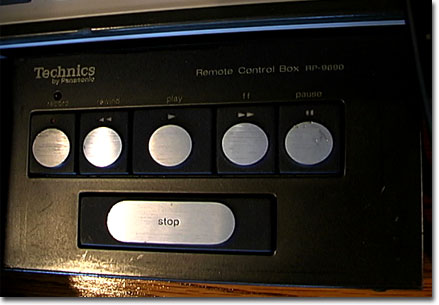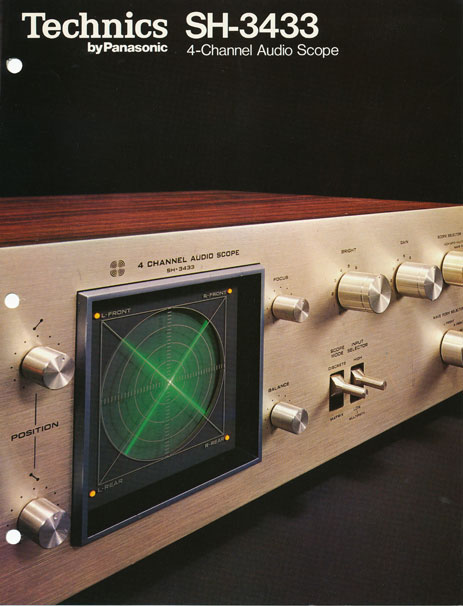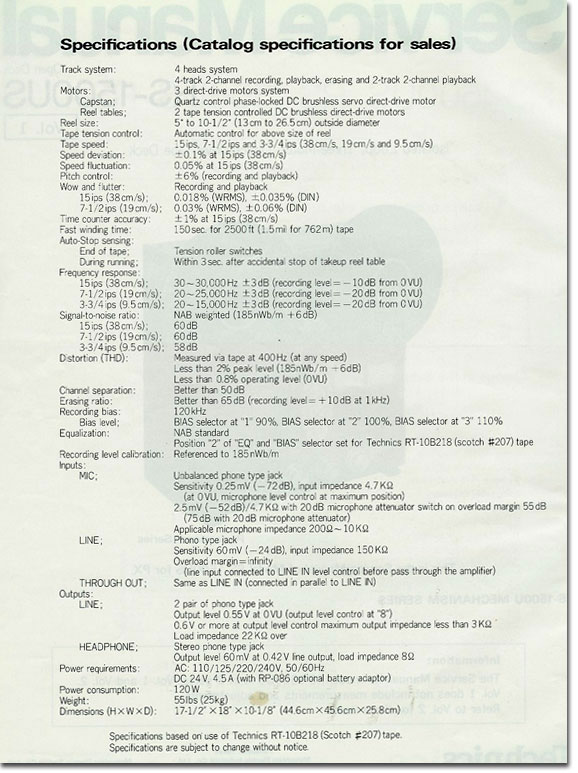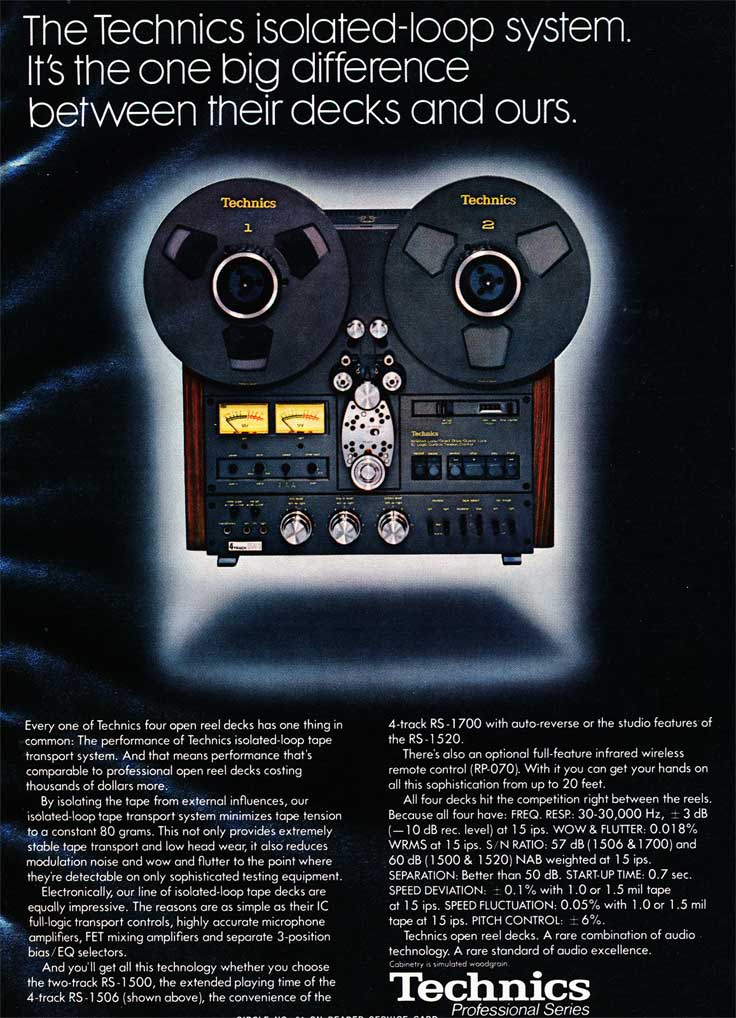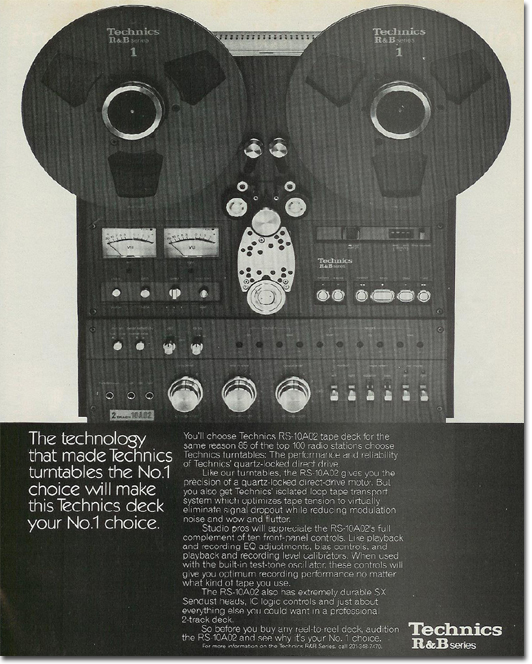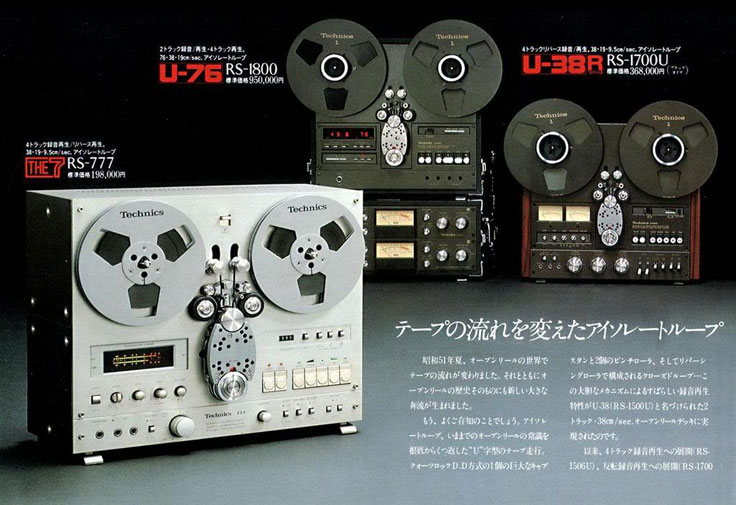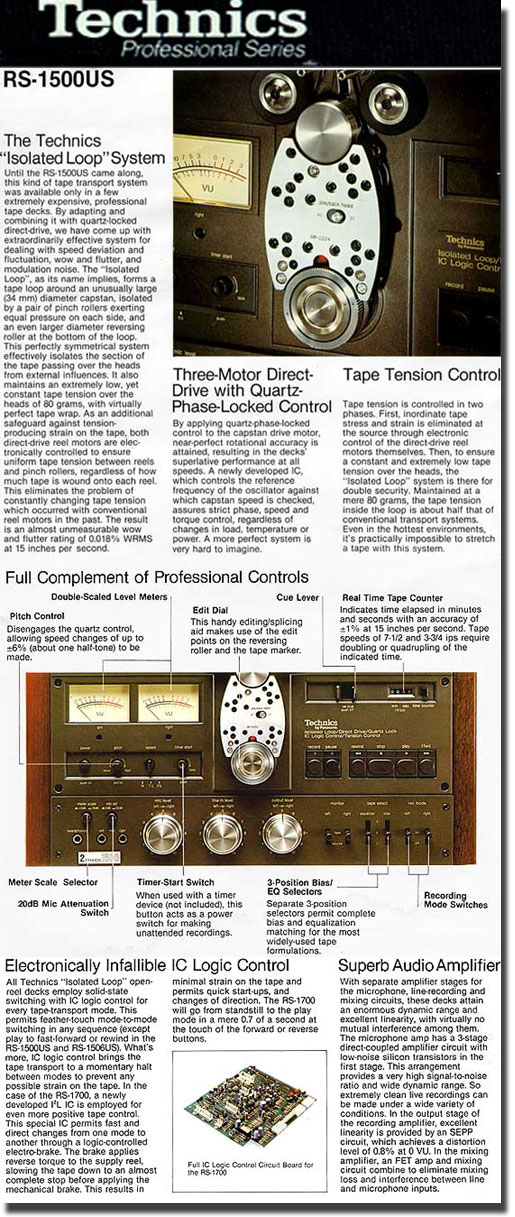"Phantom
Productions" is the registered trademark of Phantom Productions,
Inc. Copyright 2012 • All pictures and content on this web site are the property of Theophilus/Reel2ReelTexas
This
is a list of information we have gathered from a variety of sources on some of the major analog reel to reel tape recorder manufacturers. Please note the source "credits' at the end of this page. While we have strived to provide the best information available to us, there will be corrections and additions. We include personal stories about the companies when they are provided to us. We always invite input on corrections and updates. Thank you!
These company histories, plus photos and much more information is available in the three DVD set available at this link.
Go to: Akai • Amplifier Corp • Ampex • Ampro • Bell • Bell & Howell • Bell Labs • Berlant Concertone • Brush • Craig • Crown • Dokorder • Edison • Eico • Ferrograph • Fostex • Grundig • HeathKit • KLH • Magnecord • Marantz • Nagra • Otari • Pentron • Philips • Pioneer • Presto • Rangertone • Roberts • Sansui • Scully • Sony • Studer ReVox • Tandberg • Tapesonic • Teac/Tascam • Technics • Telefunken • Toshiba • Uher • Viking• Webster Chicago/Webcor • Wilcox-Gay • Wollensak • UK - Brenell • Spectone
| |
Akai Electric Company Ltd.
Akai Electric Company Ltd. was founded by Masukichi Akai in Tokyo Japan in July of 1929 as a manufacturer of radio components, sockets and other electrical parts.
Masukichi's business expanded rapidly through the 20's and 30's. Masukichi's eldest son, Saburo, grew up in the factory and later enrolled himself in night school at the Tokyo Institute of Technology to study electrical machinery.
This turned out to be a watershed event for as Akai grew, they expanded into the production of electrical motors due largely to Saburo's new expertise in electrical engineering.
The motor Saburo eventually designed caught the attention of a company which was making 16mm film projectors. This was a time when the first 16mm movies were being made in Japan.
The new business generated by the production of electrical motors allowed the father / son team to move their facilities from the backyard premises to a factory in Kamata in 1933.
Akai foundered at the onset of the Second World War. Only ten days after getting married in 1939, Saburo Akai received his military enlistment papers
Masukichi had sold all of his premises and equipment to Sawafuji Electric Co., where Saburo took up employment as an engineer after the war.
Business was so good that by 1947, Saburo raised his capital investment in the new firm, bought back the Kamata plant from Sawafuji and changed the name of the concern to Akai Electric Company.
By 1948, Akai had started producing and selling phonograph motors. At this time recording technology was changing rapidly and there was demand for higher precision record players. Akai responded to this demand by continually upgrading the technology of their phono motors.
By 1951, they had developed the C-5 Variable Speed Motor, which produced minimal noise and vibration and proved extremely popular with audio enthusiasts of the period.
The C-5 aroused considerable interest in the US as well and this led Saburo to change his market perspective.
In 1953-4 Akai was one of the few medium sized companies to export goods without going through a wholesaler. Saburo had advertised in the American technical journal "Electronics." The headline "Why not buy Akai technology?" generated inquiries from 5 interested companies.
One of these companies was a small producer of audiovisual equipment for education, Roberts Electronics founded by Robert Metzner.
The company presented Saburo with overwhelming demand for anything Akai was producing and business expanded rapidly for both as Roberts Electronics began using Akai products.
Then in answer to a query from Akai about how their products were being used, Roberts sent back a tape recorder.
Technicians at Akai looked over the model, made one of their own and quickly sent this back to their US client. Roberts replied in no time.
Roberts asked Akai to manufacture the completed tape recorders and said that they would take charge of sales.
In 1954 Akai made its first foray into the tape recorder field by bringing out the AT-1 model, a tape recorder kit. This was followed in 1956 by their first independently developed tape recorder, the 900.
The model was well received and orders started coming in fast.
Saburo decided to take a trip to the U.S. to further study the market. He was completely taken aback by the immense market he found there, and returned to Japan with the realization that if you had a good product, you could be sure of selling it in America.
From then on the firm focused on expanding their facilities and gearing their production towards improving quality.
In 1957 Akai unveiled a deluxe version of its high grade tape recorder. With the deluxe stereo model which was brought out the following year, Akai had acquired a firm position in the domestic market. In the same year, Saburo took over from his father as president.
Although well established in terms of capital and selling power by 1960, the firm had concentrated on investing the market with low-price tape recorders through its volume production system.
Akai was now at a turning point. The company would no longer view the tape recorder as simply a machine for the production of sound; the tape recorder was to be refined as a device for the pursuit of sound quality.
At a time when most music listening consisted of listening to live performances, the radio and the record player, Akai was firmly advocating the pleasures of listening to tape recordings. The tape recorder's ability to record, of course, distinguished them from the other types of audio media.
While costs would rise with the pursuit of sound quality, Akai was nonetheless committed to the belief that the tape recorder should be an instrument of sonic excellence and set out to make products that demonstrated this conviction.
Throughout the early '60's Akai produced models that made their reputation as a premier producer of audio tape recorders.
In the US, OEM-supplied Akai products were being marketed under the Roberts brand name. Despite the wide range of tape recorders available from US manufacturers, Akai sales were exceptionally high.
On the strength of this success, Akai decided to expand its sales network into other countries, first moving into Southeast Asia and then the Middle East and Europe.
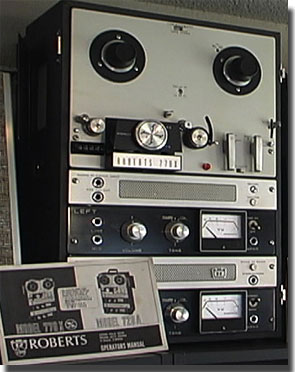 Akai debuted the M-7 model tape recorder in 1962 and its successor the M-8 in 1964. Equipped with the then new X'Field magnetic recording system (licensed to Akai by Tandberg), these two models gave superior frequency response which resulted in a vast improvement in tape economy. Akai debuted the M-7 model tape recorder in 1962 and its successor the M-8 in 1964. Equipped with the then new X'Field magnetic recording system (licensed to Akai by Tandberg), these two models gave superior frequency response which resulted in a vast improvement in tape economy.
Together the M-7 and M-8 (Roberts 770X) recorded sales of over 160,000 units in four years and thus established Akai in an unshakable position in the tape recorder field. The X'Field Head development brought Akai sudden world renown, and the company went on to produce many top selling models.
By 1972, the company was diversifying into the cassette tape recorder field and video.
The company's most popular products were the GX-747 and GX-77 open-reel recorders (featuring an auto-loading function), the three-head, closed-loop GX-F95, GX-90, GX-F91, GX-R99 and CS-702DII cassette decks, and the TA-2030 and TA-2045 stereo amplifiers.
The company set up Akai America, Ltd. in California in 1970, with the intention of selling products under its own brand name, rather than the hitherto used name of Roberts.
Billboard July 3, 1971 - "Akai America will introduce a full line of tape players Sunday (27) at the Consumer Electronics Show, The Califone-Roberts division of Rheem Manufacturing Co. has entered into an agreement with Akai Electric Co., Ltd. of Japan that will allow certain tape products to be sold in the U.S. under both the Roberts and Akai brand names. 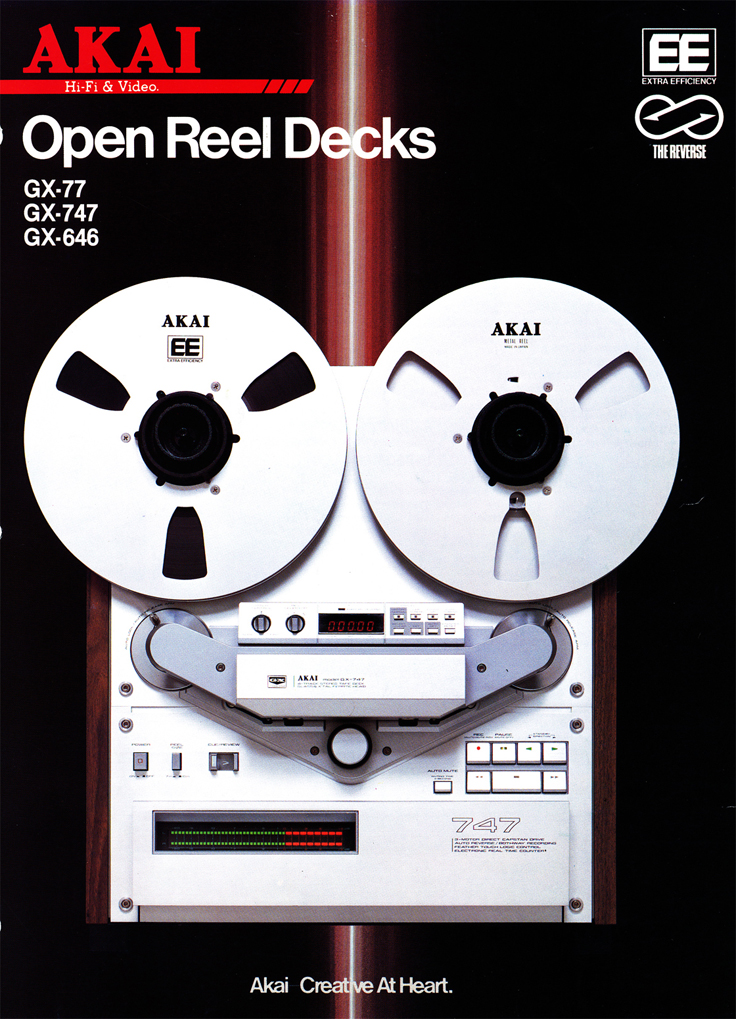
Under terms of the agreement, Roberts will continue to market the major part of the Akai made products under the Roberts label on an exclusive basis.
"The benefits to both parties this new agreement are numerous and mutually desired,." said Roberts president C.R.Phillips. From 1974 to 1985, Mr. Phillips was Executive Vice President and Director of Akai America, Ltd.
In 1973 Saburo Akai died during a New Year's trip to the ski resort of Shiga Kogen
Akai halted production of open reel decks in 1985 after the release of the GX-747, thirty one years after Akai had begun sales of its AT-1 tape recorder kit. To take the place of open-reel deck production, Akai poured all of its energies into the development of cassette decks.
There is more information about the early Akai reel tape recorders in our Roberts summary.
Akai is now headquartered in Singapore as a subsidiary of Grande Holdings, a Hong Kong-based conglomerate, which also owns the formerly Japanese brands Nakamichi and Sansui. The Akai brand is now used to rebadge electronics manufactured by other companies.
|
| |
Amplifier Corp. of America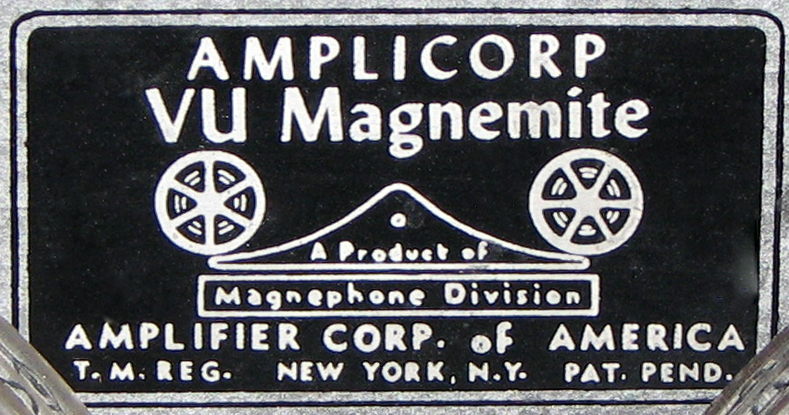
Peter Paul Kellogg helped design the first lightweight tape recorder built in North America, the Amplifier Corp. of America's Magnemite recorder. It weighed less than 20 pounds; it went into commercial production in 1951
|
| |
Ampex
Ampex recorders were well known as the best built American professional reel tape recorders.
The first time I saw Ampex in action was in 1964 when I was helping a band called the Believers in Alpine, Texas. I recorded the band as they developed some new songs. In late 1964 they went to a San Angelo, Texas studio to record a song called "Motor Mouth."
The San Angelo studio belonged to Ron Newdoll and his company was Accurate Sound Company. Ron was using the Ampex 350s and had just recorded the number one hit "Last Kiss" for J. Frank Wilson and the Cavaliers .
When I entered Sul Ross University's Music Department, I was given the task of recording all the school's band and choir concerts, as well as their music recitals using the Ampex 600 and 620 amplifier and speaker system.
The $545 dollar Ampex 600 first came out in 1954 and Ampex ads boasted that it met the specs of the 350s. 80,000 Ampex 600s were manufactured in various configurations.
In creating this segment on Ampex, I have researched the company history using books, magazines, and AES media. I've also had discussions and correspondence with folks who worked on the Ampex equipment during the early period. There are some source differences and I have tried to represent the essence of the process as the original Ampex equipment evolved.
As many folks know, after WW II , John "Jack" T. Mullin, who was in the US Army Signal Corp, brought back to the US, 2 German Magnetaphon reel to reel magnetic tape recorders. Mullin took the 2 Magnetophons apart and shipped them back to the US in 18 boxes to comply with US war souvenir size requirements. Also included were 50 rolls of German magnetic tape.
In late 1945 as Mullin was returning from France, he shared the Magnetophon information with a friend, Col Richard Ranger. Ranger decided to go to Germany, research the information and build an American version of the Magnetophon.
When Mullin arrived at his home in San Francisco he was happy to find the 18 boxes had arrived safely. He decided to go to work with a friend William A. Palmer who had founded W.A. Palmer & Co., a film production company in San Francisco in 1936.
After tweaking the electronics and converting to US tubes the Magnetophons were used to support Palmer's film business. To their knowledge, this was the first time magnetic tape was used to record motion picture sound with the subsequent transfer to film.
A Palmer-Mullin demonstration of their magnetic recorders at the MGM studios in Hollywood in October, 1946, gained a great deal of attention when they provided a stunningly clear recording of a studio performance by the MGM Symphony Orchestra.
The first public demonstration of the recorders was to the local chapter of the Institute of Radio Engineers in San Francisco on May 16, 1946. Attending the demonstration was Harold Lindsey.
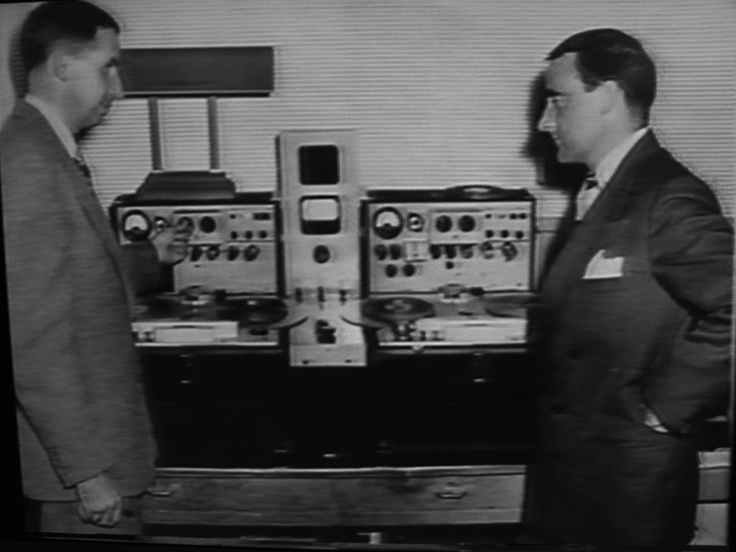 Following a number of demonstrations, Mullin and Palmer attracted Bing Crosby's production folks. Crosby had been frustrated by the poor end quality of disc editing for his radio program. After Mullin and Palmer demonstrated the ability to not only capture a great recording, but also to be able to edit the content with noloss of quality, the Crosby folks decided to adopt the technology. Following a number of demonstrations, Mullin and Palmer attracted Bing Crosby's production folks. Crosby had been frustrated by the poor end quality of disc editing for his radio program. After Mullin and Palmer demonstrated the ability to not only capture a great recording, but also to be able to edit the content with noloss of quality, the Crosby folks decided to adopt the technology.
Mullin eventually went to work for Crosby as his Chief Engineer, using the 2 Magnetophons and the 50 reels of German tape. He edited the Crosby shows splicing the various tape pieces together as Crosby and his producers directed. Crosby expressed concern regarding there being only 2 recorders and a limited supply of tape.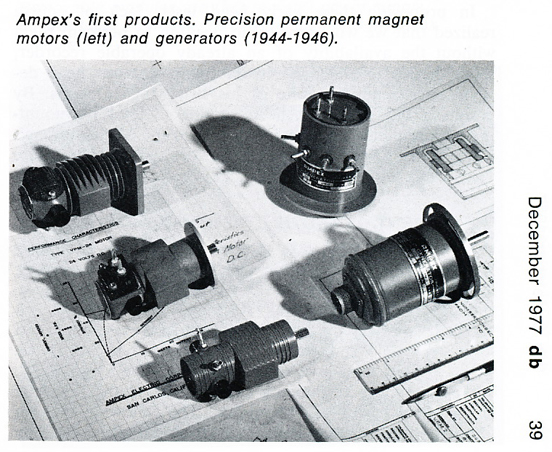
In an article written for the db magazine published in December of 1977, Harold Lindsay describes how excited he was about the magnetic recording technology Jack Mullin was demonstrating. Lindsay worked for the Dalmo Victor Company in California and a company named Ampex was building radar motors and generators for Dalmo to supply the US Navy. Given the  lessening demand for the motors, Ampex was looking for another product to produce. Lindsay connected Alexander M. Poniatoff with Jack Mullin and Pontiatoff agreed that magnetic tape recorders was the way to go. He asked Lindsay to join Ampex and work with Myron Stolaroff to develop an Ampex tape recorder. lessening demand for the motors, Ampex was looking for another product to produce. Lindsay connected Alexander M. Poniatoff with Jack Mullin and Pontiatoff agreed that magnetic tape recorders was the way to go. He asked Lindsay to join Ampex and work with Myron Stolaroff to develop an Ampex tape recorder.
At Jack Mullins suggestion, they began by developing a playback head. It proved to be superior to the one Mullin had on the original Magnetophons. Mullin had by this time agreed to record and edit for Bing Crosby and Bing Crosby Enterprises. As Mullin had committed to help Col. Richard Ranger with a recorder for Crosby, he could not share the electronics information with Ampex. However when Ranger's work failed to meet Crosby's expectations, Mullin encouraged Ampex to make a presentation.
Several interesting things occurred. As there was limited tape available from Mullin, Ampex was in a bind to have tape for testing. Luckily within a few weeks of each other, two tape manufacturers (Audio Devices and 3M) approached Ampex asking them to test their tape development. That solved the tape problem and the tape quality improved as did the development of the first Ampex recorder
By the end of August 1947, the Ampex 200-A development was progressing well and the Crosby demonstration was scheduled. Just before the Crosby 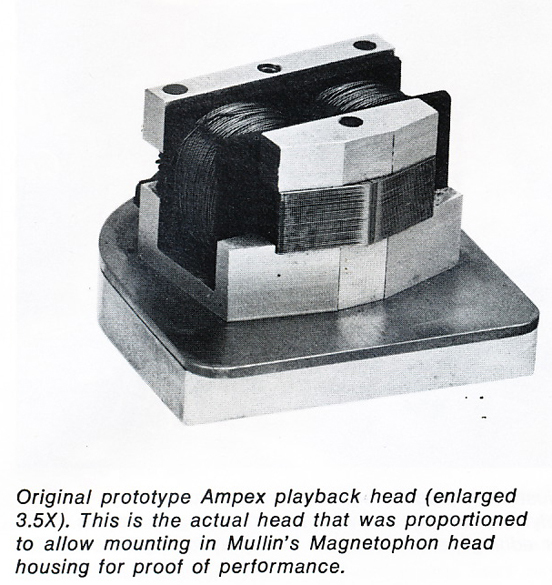 presentation, the Ampex 200-A record electronics developed a bug. The prototype was demonstrated anyway with playback only using Jack Mullin's tapes. It was lucky that in their development, Ampex had decided to match Mullin's Magnetophon tape speed (which = 30 ips), or the playback would not have been possible. In spite of there being a wide range of engineers who witnessed the demonstration, no one asked to see how the unit recorded. presentation, the Ampex 200-A record electronics developed a bug. The prototype was demonstrated anyway with playback only using Jack Mullin's tapes. It was lucky that in their development, Ampex had decided to match Mullin's Magnetophon tape speed (which = 30 ips), or the playback would not have been possible. In spite of there being a wide range of engineers who witnessed the demonstration, no one asked to see how the unit recorded.
A few days after the demonstration, folks from Crosby Enterprises approached ampex with a request to distribute the recorder in eleven western states. An agreement was reached, contracts signed and immediately Croby's reps gave Ampex an order for twenty Ampex 200-A's. They were all for ABC in New York, Chicago and Hollywood.
As Ampex geared up to meet the demand they realized they had no funds and banks were not willing to loan to them given the new technology. However Lindsay states in his db article, an envelope arrived with a Hollywood postmark and inside was a check for $50,000 from Bing Crosby with no strings attached. Pretty amazing!
Ampex was named after the company's owner, A. M. Poniatoff , using his initials plus EX for excellence. Alexander Mathew Poniatoff was born in the Kazan District of Russia, about 400 miles east of Moscow, on March 25, 1892. His middle name is the first Christian name of his father, such designations being a Russian family tradition. Mathew Poniatoff was a successful businessman with a couple of dozen employees engaged in cutting timberland and producing firewood and parts for carriages and sleighs. (tonbandmuseum)
As 3M was working on developing magnetic recording tape and the products were tested, Mullin and the ABC folks decided the high end 3M tape was not as good as their low end product. Interestingly the iron oxide for the low quality tape was called 112 Raven Red which was also used for red barn paint.
The Ampex 200A was first demoed at Radio Center in Hollywood in October of 1947. It had cost $76,000 to develop. When the Ampex 200A was released for sale in April of 1948, it cost about $7,500. That was later reduced to $5,200. Ampex numbers 1 and 2 went to the Bing Crosby Show and were used to record his 27th performance of the 1947-1948 season. Weeks later ABC ordered 12 more recorders and record companies and broadcasters soon followed. Other sources indicate that ABC ordered 20 Ampex 200-As.
There were only 112 Ampex 200A's built.
The 200A ran at 30 ips and threading was called a "B" wind with the backing to the inside. This was later reversed. The over-engineered deck was built into a polished or stained wood console weighing 240 pounds.
We can hardily attest to the weight as it is most difficult to move around. The recorder was full track using 14 inch reels, 1/4 inch tape and was capable of a performance that was flat within .5 db from 30 hz to 15 kHz.
By May of 1949 most major recording studios had one. By June, 1950, NBC, CBS, Mutual, Dumont, etc. had at least one.
There are quotes with folks stating the Ampex 200-A was a wonderful sounding machine. Songs said to have been recorded on one of the Ampex 200A's included "(We're Gonna) ROCK AROUND THE CLOCK" ,Nat King Cole's "MONA LISA", "UNFORGETTABLE", Mario Lanza's "BE MY LOVE", Frank Sinatra's "YOUNG AT HEART" and Tennessee Ernie Ford's "SIXTEEN TONS"
Les Paul used his Ampex 200A and later the 300, 400 and 350 8 track to make his amazing records with Mary Ford. The 8 track, Ampex 350 based recorder produced by Ampex in 1957 was sold to Les Paul for $10,000. Les Paul loved the recorder, however commented that he never recorded a hit on it.
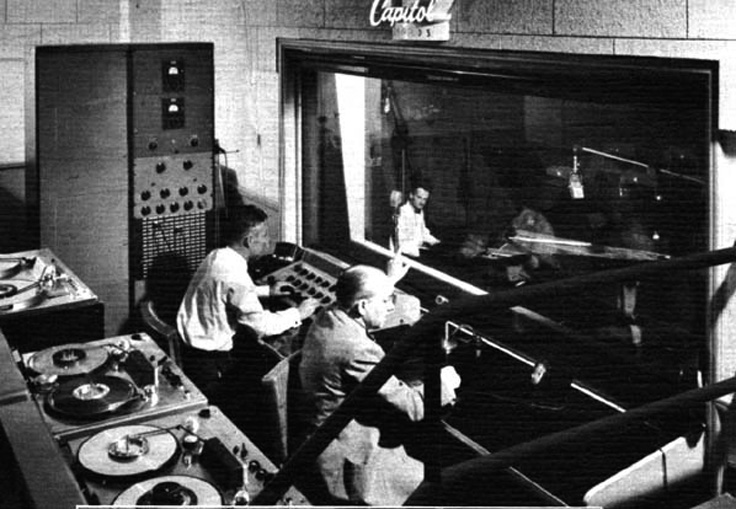 Our Ampex 200-A, Serial Number 33 was originally bought from Bing Crosby Enterprises, Inc. by Capitol Records in Los Angeles, California in 1948. Our Ampex 200-A, Serial Number 33 was originally bought from Bing Crosby Enterprises, Inc. by Capitol Records in Los Angeles, California in 1948.
News clips detail some information regarding ABC and Capitol Records decisions to acquire the new technology. They include one in October 1947 saying that if magnetic tape was to air on radio really "materializes" ....reflecting a tone of reservation regarding the technology. And even in May of 1948 an article talks of capitol Records recording on both tape and a disc cutter to check the quality.
We have Capitol Records detail regarding the Ampex 200-A, #33's upgrade in 1949. This upgrade was to the Ampex 201 specs and involved the replacing of the original head cover and installing an Ampex 300 head cover and tape lifters. They also updated this Ampex 200A in 1954 and 1955.
Our Ampex 200A was subsequently acquired by Leo De Gar Kulka, known in the record and recording industry as "the Baron." Documents indicate he moved the Ampex 200A from Los Angeles to his Golden State studio in San Francisco around 1964. The Baron is remembered for his recordings of Frank Sinatra, Nat King Cole, Sonny Bono, among others. One story states Cher worked as the Baron's receptionist for awhile. He also produced the song "Tequila."
We were told that "the Baron" was always striving to keep up with the latest technology. The Ampex 200-A we acquired was upgraded to stereo using Inovonics amps. We initially were going to restore the recorder to its original state. However after learning more about the history of the unit, we have decided to work to acquire the original electronics, but will leave the unit as is for now.
During the early 1950s Ampex began marketing one- and two-track machines using ¼" tape. The line soon expanded into three- and four-track models using ½" tape. In the early 1950s Ampex moved to 934 Charter St. Redwood City, California. Ampex acquired Orradio Industries in 1959, which became the Ampex Magnetic Tape Division, headquartered in Opelika, Alabama. This made Ampex a manufacturer of both recorders and tape. By the end of that decade Ampex products were much in demand by top recording studios worldwide.
In 1952, Ampex was approached by movie producer Mike Todd, who wanted to develop a high fidelity movie sound system using sound magnetically recorded on the film. The result of this development was the Todd-AO motion picture system, which was first used in movies such as Oklahoma and The Robe. In 1960, the Academy of Motion Picture Arts and Sciences awarded Ampex an Oscar for technical achievement as a result of this development.
In 1966 Ampex built their first 16-track recorder, the model AG-1000, at the request of Mirasound Studios in New York City. In 1967 Ampex introduced a 16-track version of the MM 1000 which was the world's first 16-track professional tape recorder put into mass-production. Both used a 2 inch tape transport design adapted from the video recording division. The 16-track MM-1000 quickly became legendary for its tremendous flexibility, reliability and outstanding sound quality. This brought about the "golden age" of large format analog multitrack recorders which would last into the mid 1990s. MCI built the first 24-track recorder (using 2 inch tape) in 1968 which was installed at TTG Studios in Los Angeles. Later machines built by Ampex starting in 1969 would have as many as 24 tracks on 2 inch tape. In addition to this, the introduction of SMPTE time code allowed studios to run multiple machines in perfect synchronization, making the number of available tracks virtually unlimited.
By the late 1970s Ampex faced tough competition from Studer and Japanese manufacturers such as Otari and Sony (who also purchased the MCI brand in 1982.) In 1979 Ampex introduced their most advanced 24-track recorder, the model ATR-124. It was considered by many to be the finest machine of its type. The ATR-124 was very ruggedly constructed and had outstanding audio specifications which nearly rivaled the first digital recording machines. However, sales of the ATR-124 were slow due to the machine's very high price tag @ $62,500. Only 62 of the ATR-124 machines were sold. Ampex withdrew from the professional audio tape recorder market entirely in 1983.
Ampex Audio Recorders TimeLine
This information is based on ad and catalog information in our collection
1947 - 1948 Model 200A $7,200 > $5,200
1949 - Model 300 - $1,550
1950 - 1953 Series 400 $985 pic 2
1953 - Model 350 replaced 400, Ampex 450 (background music) name Ampex Corp adopted, 402C, 403C, 403P
1954 - Model 600, Speaker 620, Ampex prosumer Series "A" Stereo models A121, A122,& Mono models A111 & A112 Later called 960
1955 Ampex 350 and 600 Stereo has arrived
1956 Ampex 612 Ampex Models List Data recorders, S-5290 (basically a 601 mono set up for stereo and later called 601-2
1957 Ampex 8 channel Les Paul
1958 - 1965 AG 351 $1,675 601 & A112
1958 Ampex 351, Ampex 601-2 stereo, Ampex prosumer 960 Caprice,
1959 Ampex 601 and 601-2, Model 910 Universal "A", Ampex prosumer 960, 970
1960 Model 970 Model 351, Model 351-C
1961 Ampex The Fine Line Ampex prosumer 1200, 1250, 1260, 1270, Ampex 934, 936
1962 Redwood City facility ground breaking, Ampex 970, Ampex 960, 934 & Fine Line 1200
1963 Ampex moved into Redwood City facility, Ampex prosumer Fine Line F-44, Ampex 351-2P, Ampex 1250 & 2012 Speaker system, 601, 601-2 & PR-10, MX-35, 351 & 352
1964 MR-70, PR-10, F-44, 602-1 & 602-2, PR-10-2 - Ampex prosumer 2050, 2070, 2080, F-4460 & F-4470
1965 Ampex 602, 602-1, Ampex prosumer 860, 1070, 1160, 2070 duplicators, F-44, 4450, 4452, 4460, 2050, 2060, 2070, 1070,1050, 1080, 850, 961, 1161, 2161, Ampex Music Center
1966 AG-300, AG-350, solid state, PR-10, Ampex 600 Solid State, Ampex prosumer 860, 1160, 2060, 840
1967 AG-440 series, AG-500 series, AG-600, 602, 602-2, Ampex prosumer 850, 861, 1150, 1161, 2050, 2061, AV 770, 961, 1161, 2161, Ampex Music Center
1968 AG-500, AA-620 speaker system, AM-10, Ampex prosumer 755, 1455, 1461, 1461A reversing, 750, 761, 850, 861, 895, 1150, 1161, 2050, 2150, 2061
1969 AG-440B, AG-445, AG-500, AG-600 prosumer 755, 761, 861, 1461, 2161 $449, AM-10, 985, 1161, 750,
1970 AG-600, AG-500, AG440B, Ampex prosumer 755A, 767, 985A, 1455A, 1467, 2150, 2161,
1971 prosumer AX-300 $599.00, 2161, AX-50, 755A, Broadcast recorder ABR10 & ABR 15, AG440B, AM10 & MX 35
1972 - AG-600 Solid State
1973
1974 AG-440X MM-110 AG-440C
1975 AG-440C MM-1100 ATR-700
1976 ATR-700 ATR-100 MM-1200
1977 MM-1200 AG-440C
1978 ATR-700 ATR-100 MM-1200
1979 ATR-100 ATR-124 MM-1200
1980 ATR-100, ATR-700 ATR-124
1981 MM-1100 ATR-124
1982 ATR 800 $5,450
1983 ATR-700 ATR-100 ATR-116 $48,500 ATR-124 $62,500 was the last Ampex reel tape recorder only 62 were made
Ampex Basic Concepts of Tape Recording
Harold Lindsay db articles
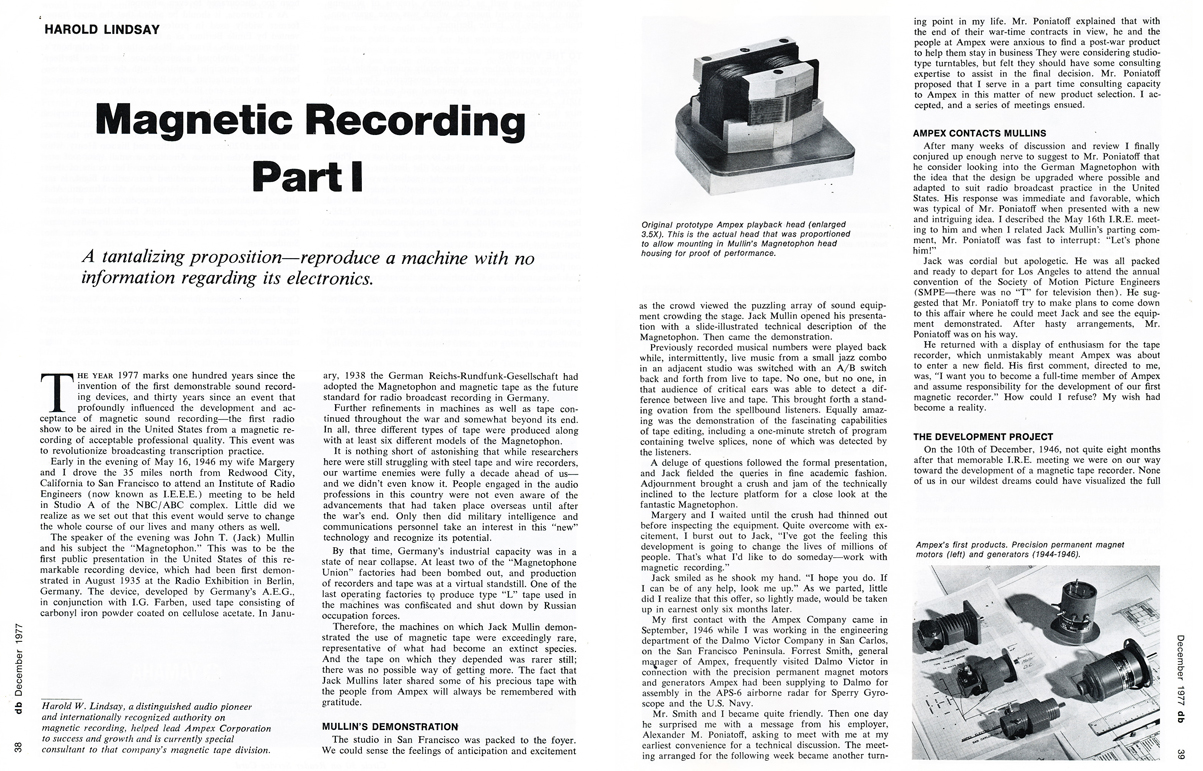  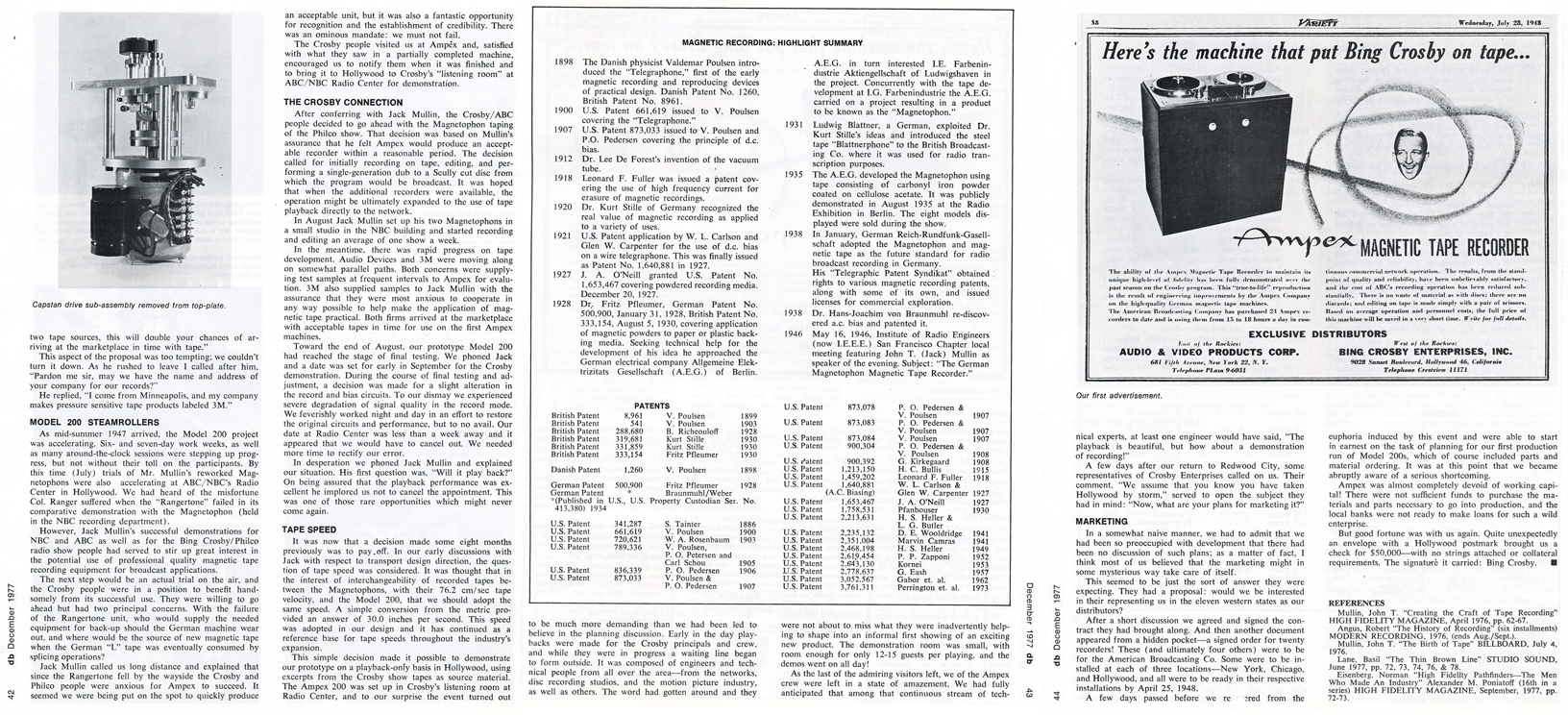  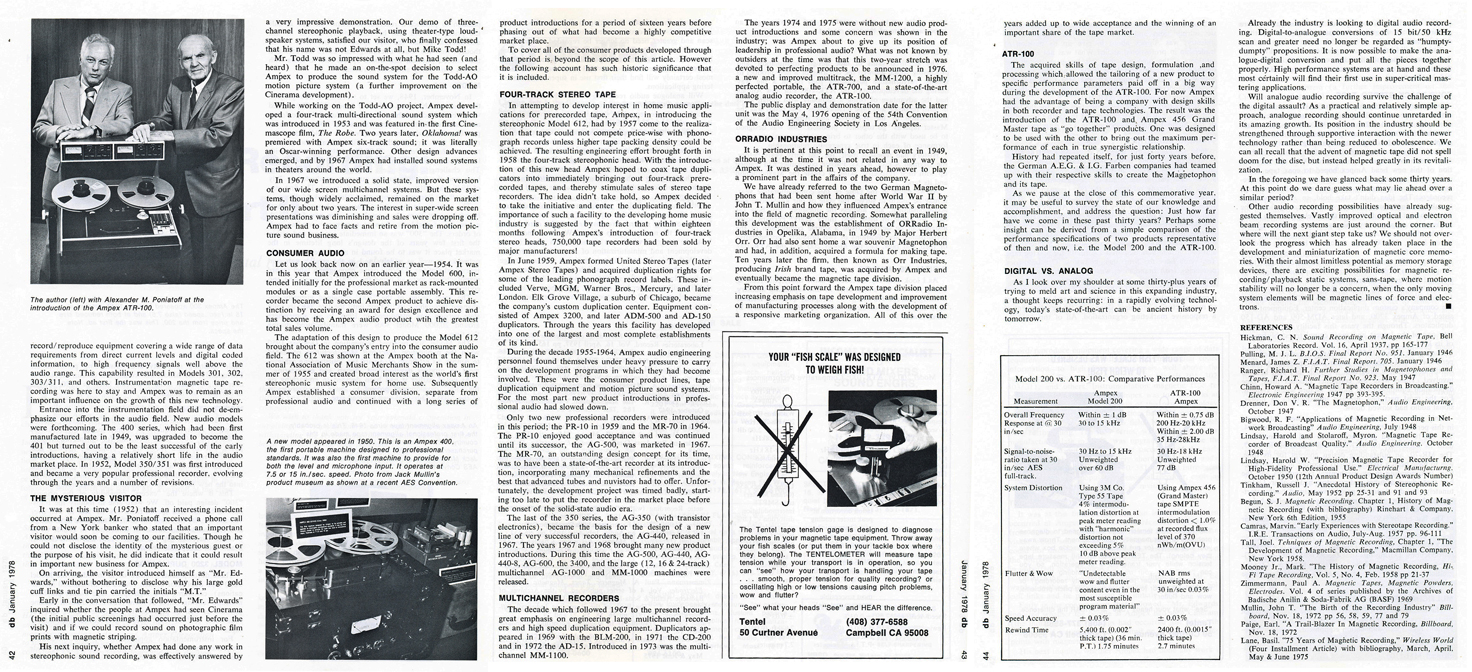 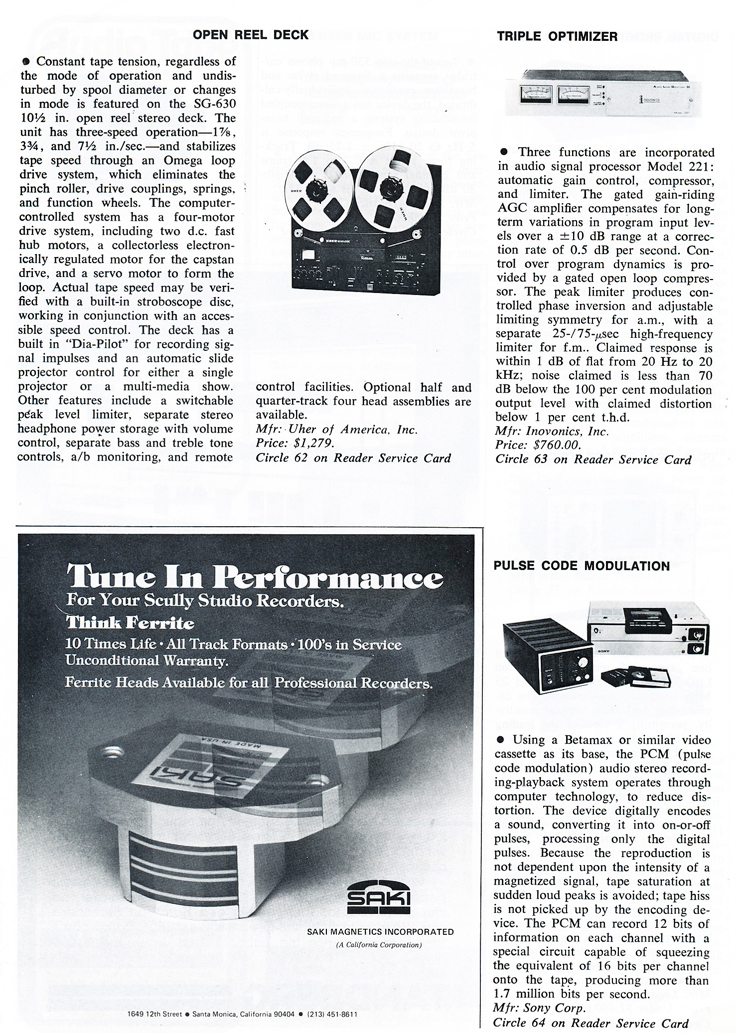
|
| |
Ampro Corporation
Ampro Corporation was founded by Axel Monson who was born in Sweden in 1883. He arrived in the U.S. in 1902 and was employed by International Harvester.
In 1924 he began to study the motion picture industry and by 1929 had perfected a new 16mm. silent projector, known under the trade name
AMPRO, a name coined from Axel Monson Products. The business grew to such proportions that it employed 700 people.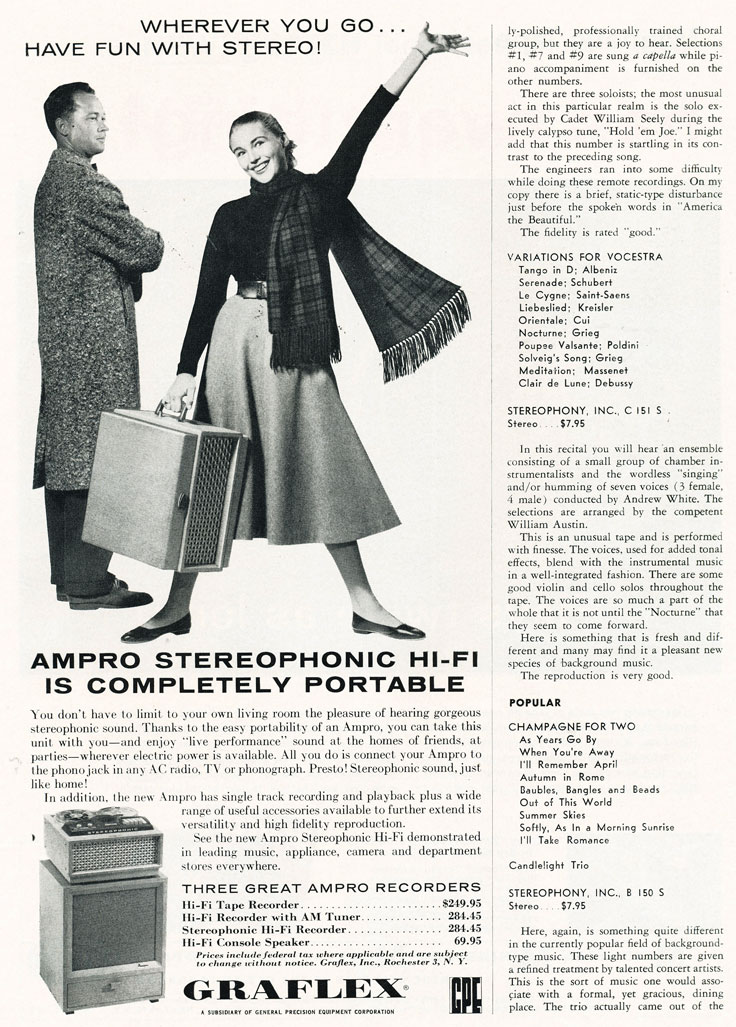
In the early to late 1950's Ampro also produced a line of consumer reel tape recorders.
At some point it was acquired by the General Precision Equipment Corporation (a name that may be seen on the 1954 ads). The General Precision Equipment Corporation was a major manufacturing company involved in the defense and space industries as well as educational products and control devices for consumer goods.
General Precision, Inc. was the principal operating subsidiary of General Precision Equipment Corp. headquartered in Tarrytown, New York.
In 1956 the Corporation also acquired the Graflix company and the Ampro film equipment production was moved to the Graflix plant in Rochester, NY.
In 1968 the General Precision Equipment Co. was purchased by Singer.
We did come across this information, however unknown if it is related to the same Ampro company. "Ampro was sold to Scully in 197x. In November 1983, Ampro/Scully was sold to TTC" www.oldradio.com
We could find no ads nor mention of Ampro tape recorders after 1957.
|
| |
Bell Labs and Bell Sound Division Thompson Ramo Wooldridge, Inc. are not associated.
Bell Sound Division was part of TRW originated in 1901 with the Cleveland Cap Screw Company, founded by David Kurtz and four other Cleveland residents.
It lasted more than a century until being acquired by Northrop Grumman in 2002.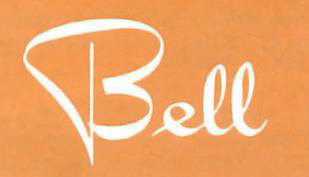
In 1950, Simon Ramo and Dean Wooldridge worked for Hughes Aircraft, leading the development of the Falcon radar-guided missile, among other projects. They grew frustrated with Howard Hughes’ management, and formed the Ramo-Wooldridge Corporation in September 1953.
With continued backing from Thompson Products, Ramo-Wooldridge diversified into computers and electronic components, funding Pacific Semiconductors in 1954. They also produced scientific spacecraft such as Pioneer 1.
Thompson Products and Ramo-Wooldridge merged in October 1958 to form Thompson Ramo Wooldridge Inc.
In February 1959, Jimmy Doolittle became Chairman of the Board of Space Technology Laboratories (STL), the division which continued to support the Air Force ICBM efforts.
Dean Wooldridge retired in January 1962 to become a professor at Caltech.
Simon Ramo became President of the Bunker-Ramo Corp in January 1964, a company jointly owned by TRW and Martin-Marietta for the production of computers and displays.
This reel to reel tape recorder was built in 1964. We could find no mention of Bell Sound Division manufacturing this reel tape recorder.
Thompson Ramo Wooldridge officially became TRW Inc in July 1965.
The company was #57on the Fortune 500 list of highest revenue American companies in 1986, and had 122,258 employees in 2000.
They had operations in 25 countries.
When aerospace company Northrop Grumman purchased competitor TRW in 2002, it sold TRW's automotive division to private equity firm The Blackstone Group.
TRW Automotive went public in a February 2004.
The company's operations primarily encompass the design, manufacture and sale of safety systems and is one of the world's largest players in the field. It operates approximately 200 facilities with 70,000 employees in 26 vehicle-producing countries
|
| |
BELL & HOWELL
Donald J. Bell worked as a projectionist in theaters around northern Illinois, where he became well acquainted with the equipment used for showing movies. As his interest in films and equipment grew, a friend helped secure him permission to use the machinist tools in the powerhouse of Chicago's Northwestern Railway, where Bell remodeled an Optoscope projector and later modified a Kinodrome projector.
Bell met Albert S. Howell at the Crary Machine Works, where many of the parts for projectors were manufactured.
Howell was born in Michigan and traveled to Chicago to work in a machine shop that built and repaired motion picture projectors.
In 1906 he applied for his first patent, a device that improved framing for 35mm Kinodrome motion picture projectors.
With Bell's experience as a movie projectionist, contacts in the movie industry, and ready cash, and Howell's inventive genius and mechanical aptitude, the two men decided to start their own business.
Incorporated with a capitalization of $5,000 in February 1907, Bell and Howell Company entered the business of manufacturing,jobbing, leasing, and repairing machines.
With business expanding rapidly, the number of employees at Bell and Howell increased from 18 to 85 over a few years.
In order to meet the needs of a growing business during his absences, Bell hired Joseph McNabb as both bookkeeper and general manager in 1916.
When Bell returned from one of his trips, he discovered that McNabb had made drastic changes in the operation of the company.
While confronting McNabb, Bell accused Howell of acting as McNabb's accomplice.
Bell gave them their last paychecks and fired them.
The following day, McNabb and Howell returned to the office and offered to purchase Bell's holdings in the company. The purchase of Bell's interests in Bell and Howell amounted to $183,895.
Bell moved first to New York and then to California and was never again associated with the company except in name.
In 1934 Bell & Howell introduced the first light weight amateur 8-mm movie camera
The fortunes of the company improved dramatically with the onset of World War II.
The firm added microfilm products in 1946.
During the 1950s, the company continued to emphasize development and expansion of its product line, which eventually included inexpensive amateur equipment, tape recorders, and hi-fi phonographs.
Historically, Bell & Howell Co. was an important supplier of many different media technologies.
The company merged with Böwe Systec Inc. in 2003; it was knownas Böwe Bell & Howell until 2011, when Versa Capital Management bought the company and returned it to its original name.
|
| |
BELL
Donald J. Bell worked as a projectionist in theaters around northern Illinois, where he became well acquainted with the equipment used for showing movies. As his interest in films and equipment grew, a friend helped secure him permission to use the machinist tools in the powerhouse of Chicago's Northwestern Railway, where Bell remodeled an Optoscope projector and later modified a Kinodrome projector.
Bell met Albert S. Howell at the Crary Machine Works, where many of the parts for projectors were manufactured.
Howell was born in Michigan and traveled to Chicago to work in a machine shop that built and repaired motion picture projectors.
In 1906 he applied for his first patent, a device that improved framing for 35mm Kinodrome motion picture projectors.
With Bell's experience as a movie projectionist, contacts in the movie industry, and ready cash, and Howell's inventive genius and mechanical aptitude, the two men decided to start their own business.
Incorporated with a capitalization of $5,000 in February 1907, Bell and Howell Company entered the business of manufacturing,jobbing, leasing, and repairing machines.
With business expanding rapidly, the number of employees at Bell and Howell increased from 18 to 85 over a few years.
In order to meet the needs of a growing business during his absences, Bell hired Joseph McNabb as both bookkeeper and general manager in 1916.
When Bell returned from one of his trips, he discovered that McNabb had made drastic changes in the operation of the company.
While confronting McNabb, Bell accused Howell of acting as McNabb's accomplice.
Bell gave them their last paychecks and fired them.
The following day, McNabb and Howell returned to the office and offered to purchase Bell's holdings in the company. The purchase of Bell's interests in Bell and Howell amounted to $183,895.
Bell moved first to New York and then to California and was never again associated with the company except in name.
In 1934 Bell & Howell introduced the first light weight amateur 8-mm movie camera
The fortunes of the company improved dramatically with the onset of World War II.
The firm added microfilm products in 1946.
During the 1950s, the company continued to emphasize development and expansion of its product line, which eventually included inexpensive amateur equipment, tape recorders, and hi-fi phonographs.
Historically, Bell & Howell Co. was an important supplier of many different media technologies.
The company merged with Böwe Systec Inc. in 2003; it was knownas Böwe Bell & Howell until 2011, when Versa Capital Management bought the company and returned it to its original name.
|
| |
Berlant Concertone
|
| |
Brush
Originally founded in 1919 by Charles Francis Brush Jr. as Brush Labs, a research company based in Cleveland, Ohio, the company was started with the intention to develop phonographic products that utilized piezoelectric crystals. Mr. Brush died prematurely in 1927 but his backers founded the Brush Development Company in 1930 to commercialize the inventions of Brush Labs. The newly formed company became the USA's biggest manufacturer of instrument recorders and other test and measurement instrumentation in the latter half of the 30s. Brush's main business in 1943 was the production of piezoelectric phonograph pickups.
Another of their products was wire recorders. These used ferromagnetic stainless steel wire, with a composition similar to high carbon high chromium cutlery steel as the recording medium. The recording head was a split ring, with the wire running in a groove in the head, quite similar to the heads used today. High frequency AC bias was used to linearize the recording. The ferritic stainless steel was quite strong. Diamond dies were required to draw it into wire.
The Brush Vice President for Research, Dr. Semi Joseph Begun, obtained a contract from the US National Defense Research Council to perform research and development on a substitute for the stainless steel wire. The work was justified by the military use of the recorders and the shortage of facilities for producing the diamond dies. It resulted in the production through work at Battelle Memorial Institute of iron oxide magnetic recording tape of exceptional quality. After the war Brush released the Mail-A-Voice dictation recorder in 1946 and the first USA built tape recorder in 1947. For a time in the early 50's the company became the primary supplier of automated tape recorders for businesses such as aviation control and telephone exchanges.
Brush Development Co. merged with the original Brush Labs and the Cleveland Graphite Bronze company in 1952 with the resulting new company named Clevite. Audio products continued being sold using the Brush trademark as late as 1960. The Clevite company exited the audio market altogether in 1963 and was taken over by Gould-National Batteries in 1969.
|
| |
Craig Recorders
 Talton R. Craig (1899 - 1952) founded a company called Craig Movie Supply Company and a company called Craig - Panorama. Talton Craig became a distributor for Califone, Robert G. Metzner's company founded in 1947. Robert Craig was a co-founder of Roberts Recorders. After Rheem bought out Roberts Recorders, Robert Craig concentrated on developing Craig tape recorders and automotive tape players. Talton R. Craig (1899 - 1952) founded a company called Craig Movie Supply Company and a company called Craig - Panorama. Talton Craig became a distributor for Califone, Robert G. Metzner's company founded in 1947. Robert Craig was a co-founder of Roberts Recorders. After Rheem bought out Roberts Recorders, Robert Craig concentrated on developing Craig tape recorders and automotive tape players.
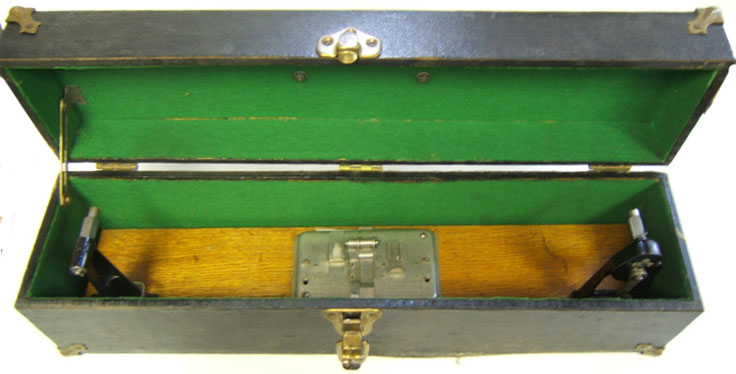 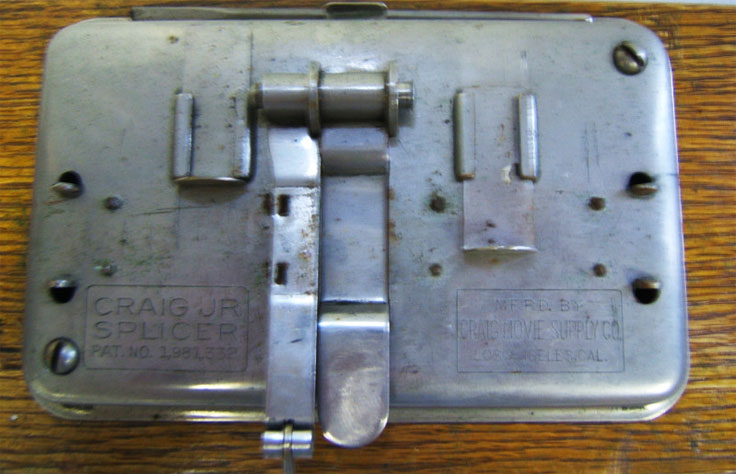 
From www.radiomuseum.org
Located in Los Angeles, California and originally founded in the 30's as Craig - Panorama by Robert Craig to distribute photographic products.
In 1952 his son, the economist T. Robert Craig Jr., took over as chairman of the company and quickly transformed the business into an importer and distributor of Brown Goods, although in the late fifties and 60's the company did some of their own design, quality control and final assembly but this was mainly to get around the very stringent USA import tax regulations at the time and by 1972 the company had ceased all local assembly.
In 1963 the company changed from a California registered company into the Delaware registered Craig Corp.
Although the company traded in all kinds of CE products ranging from alarm clocks through calculators (very high tech at the time) the company's became best know in the 60's for their tape recorder products that they sourced from Sanyo, Pioneer and others, initially these were mostly Reel to Reel but the company expanded into the 8 Track Cartridge market in the latter half of the decade and met with spectacular success in the ten emerging car audio market, the end result being that in last 2 decades of the company's life it was mostly known as a provider of car audio products and novelty high tech electronics.
The company had for a time very close ties to Pioneer and when Pioneer USA was set up in 1972 a number of top Craig employees left to work for that company. The company's assets including the brand name were sold to Bercor in 1985.
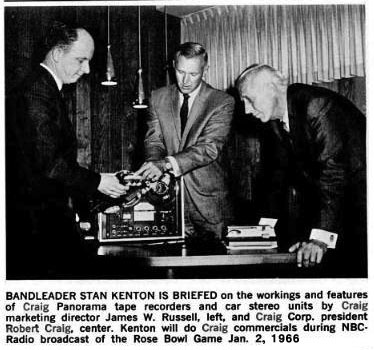 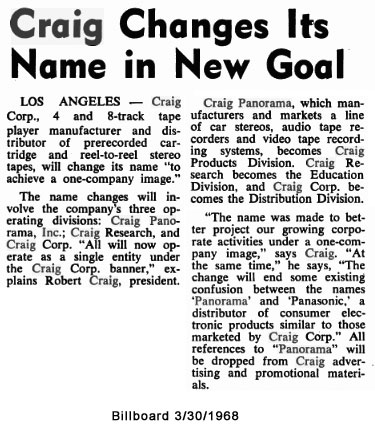 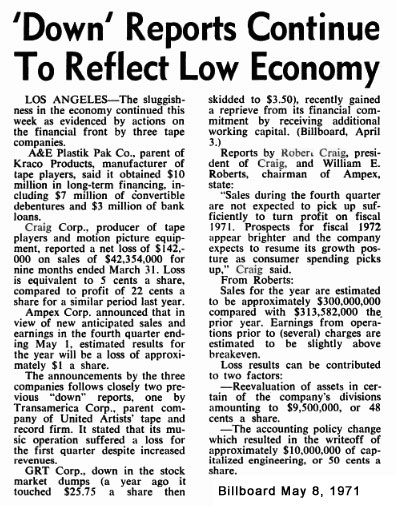
Craig, Corp Ads
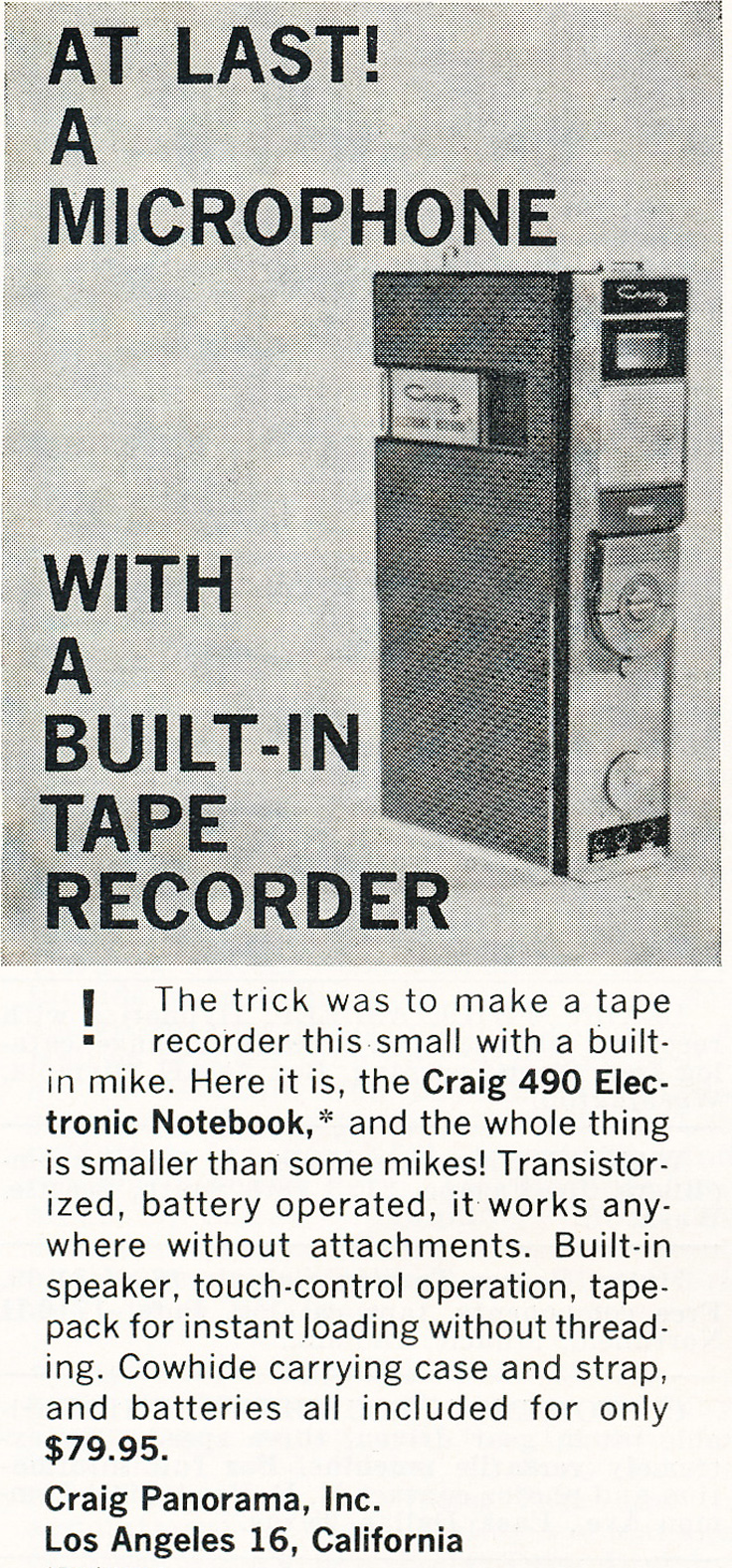  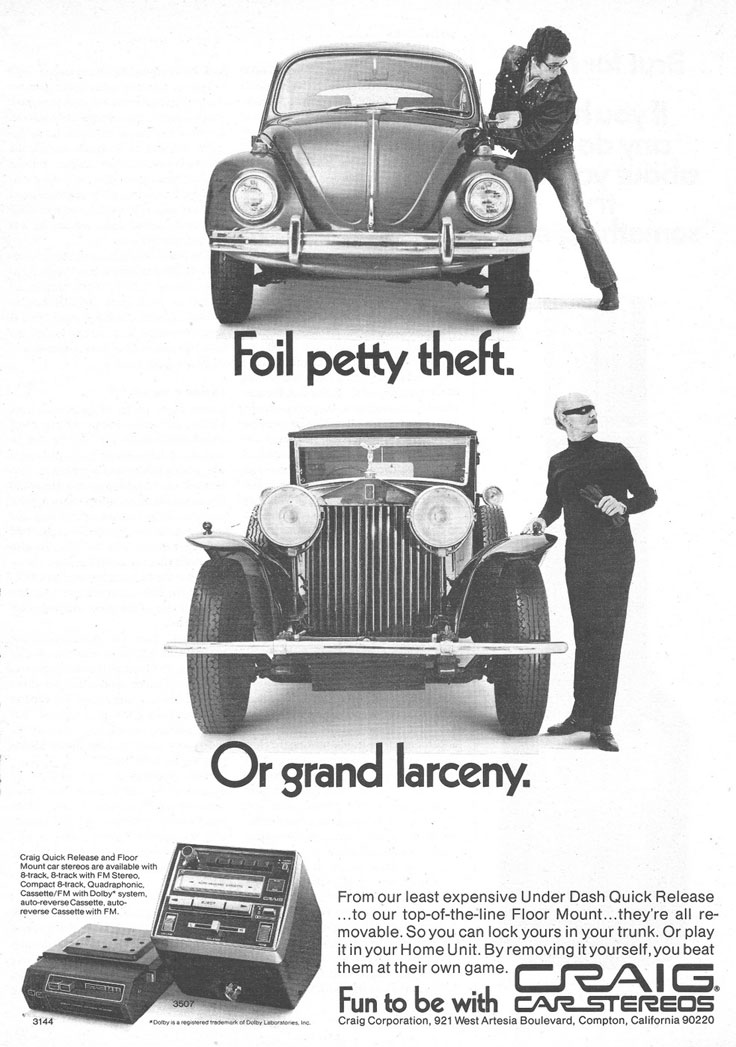 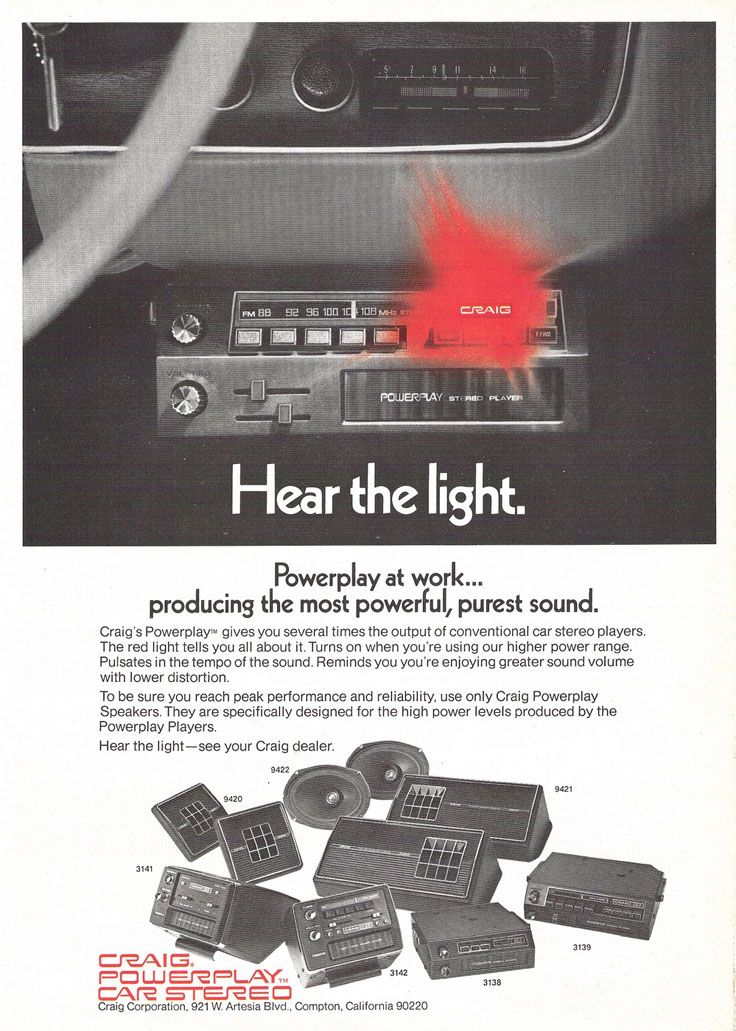 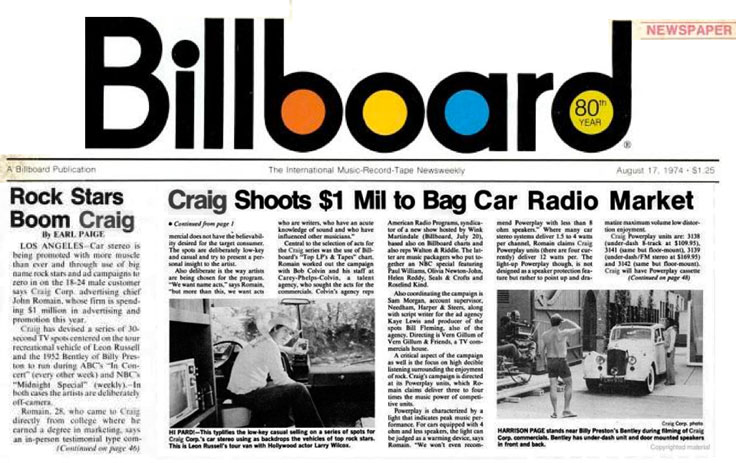
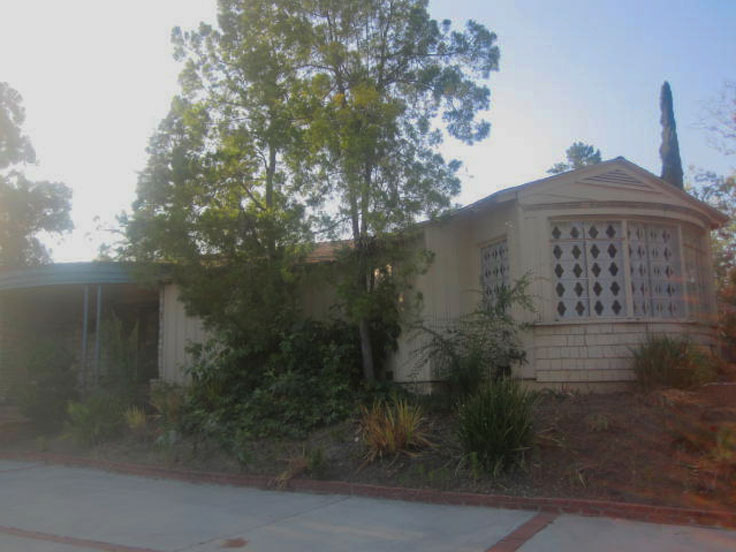 992 Craig Residence "Peppergate Ranch" - Built in 1939 and located in West Hills, this one-story single-family residence was designed by master architect Paul Revere Williams (1894-1980) in the Ranch Style. One of the foremost architects of Los Angeles in the mid-twentieth century, Williams was the first certified African-American architect west of the Mississippi River, the first African-American member of the American Institute of Architects, and also served on the first Los Angeles Planning Commission. The residence was built for Talton R. Craig, founder of the Craig Movie Supply Company. The home was built as the primary residence of Craig’s 29-acre ―Peppergate Ranch,‖ later subdivided in the 1960s as Woodlake Estates and Pinelake Estates. (Description from: City of Los Angeles - Office of Historic Resources) 992 Craig Residence "Peppergate Ranch" - Built in 1939 and located in West Hills, this one-story single-family residence was designed by master architect Paul Revere Williams (1894-1980) in the Ranch Style. One of the foremost architects of Los Angeles in the mid-twentieth century, Williams was the first certified African-American architect west of the Mississippi River, the first African-American member of the American Institute of Architects, and also served on the first Los Angeles Planning Commission. The residence was built for Talton R. Craig, founder of the Craig Movie Supply Company. The home was built as the primary residence of Craig’s 29-acre ―Peppergate Ranch,‖ later subdivided in the 1960s as Woodlake Estates and Pinelake Estates. (Description from: City of Los Angeles - Office of Historic Resources)
|
| |
Crown
Crown Audio, Inc., 1718 W. Mishawaka Road, Elkhart, IN 46517
USA 1947 to present
From its humble beginnings in 1947, Crown International grew to become one of the world's largest and most respected manufacturers of power amplifiers and microphones for professional audio markets.
Crown’s history traces back to 1947 and an Elkhart, Indiana minister named Clarence C. Moore (1904-1979). Moore, a longtime radio enthusiast, had spent the early part of the ’40s in Quito, Ecuador working for HCJB, a non-profit Christian broadcasting and engineering group.
Following his return to the United States, he felt the desire to supply Christian broadcasters like HCJB with quality electronic products. As a result, Moore founded International Radio and Electronics Corporation (IREC) in 1947 and converted a former chicken coop into the budding manufacturer’s first production facility.
The company’s early reputation was built on a family of rugged and compact open-reel tape recorders designed to operate reliably when used by missionaries in remote, often-primitive regions of the world.
After modifying and distributing several existing models (Magnecord, Recordio, Pentron and Crestwood) for the first couple of years, Moore obtained a patent in 1949 for a ground breaking invention: the world’s first tape recorder with a built-in power amplifier (15 watts).
Eventually, Moore’s wife and co-founder, Ruby (deceased 2002), suggested that ‘International Radio and Electronics Corporation’ was too long a name for the company. Since IREC had by this point produced vacuum tube tape recorders branded ‘Royal’ and ‘Imperial’, in addition to the fact that the emblem on those products was a fancy crown, she felt that the company should simply be called Crown.
Her husband agreed, and, in the ’60s, the company’s name was changed to ‘Crown International, a division of International Radio and Electronics Corporation’.
Over the years, state-of-the-art innovations have made Crown one of the most successful manufacturers in the marketplace.
By 1963, solid state electronics development allowed Crown to produce a more robust tape recorder, and in 1964, their first solid state power amplifier: the low-profile SA 20-20.
In the '60s, the introduction of the DC300 high-powered, solid-state amplifier offering 150 watts per channel at eight ohms and AB+B circuitry moved Crown into a leadership position in worldwide markets.
Well over 30 years later, many DC300s are still faithfully being used in professional audio applications.
A fire destroyed 60% of the Crown facility on Thanksgiving Day 1971 and rendered much of the remaining building severely damaged. US$1 million of uninsured assets were lost.
The plant was rebuilt, and D-60 amplifier production was brought back on line within six weeks.
Finally, in 1975, the stockholders voted to change the name of the corporation to Crown International, Inc.
Acquired by Harman International in March of 2000, Crown has continued to move forward, producing numerous innovative designs.
In 2002, 55 years after Mr. Moore founded the company, Crown has more than 500 employees and over 1600 dealers worldwide.
 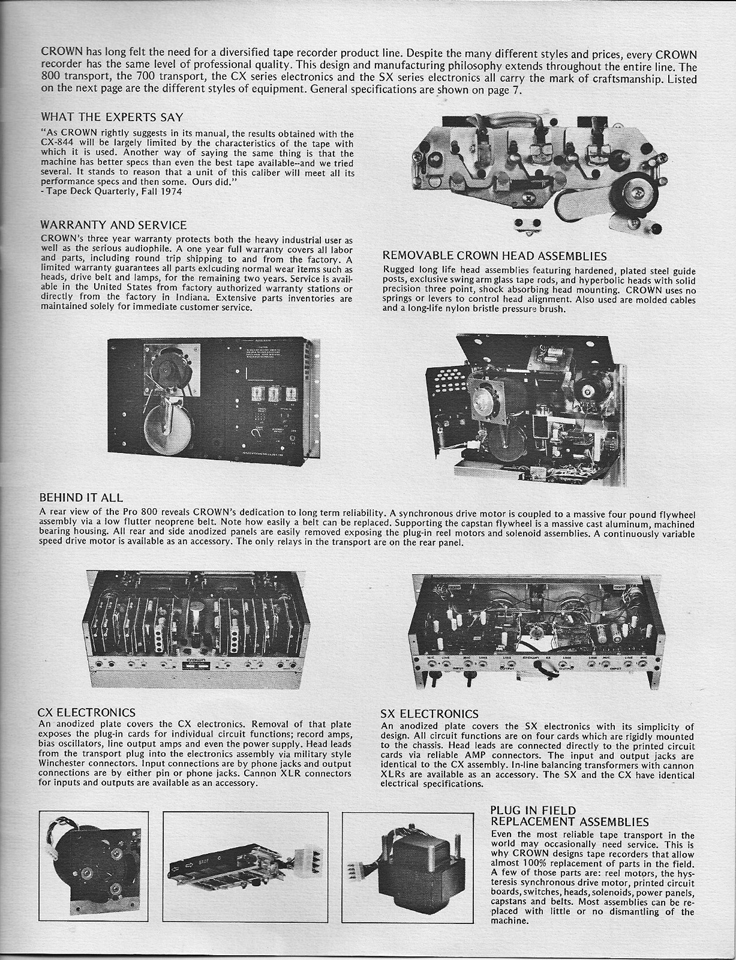 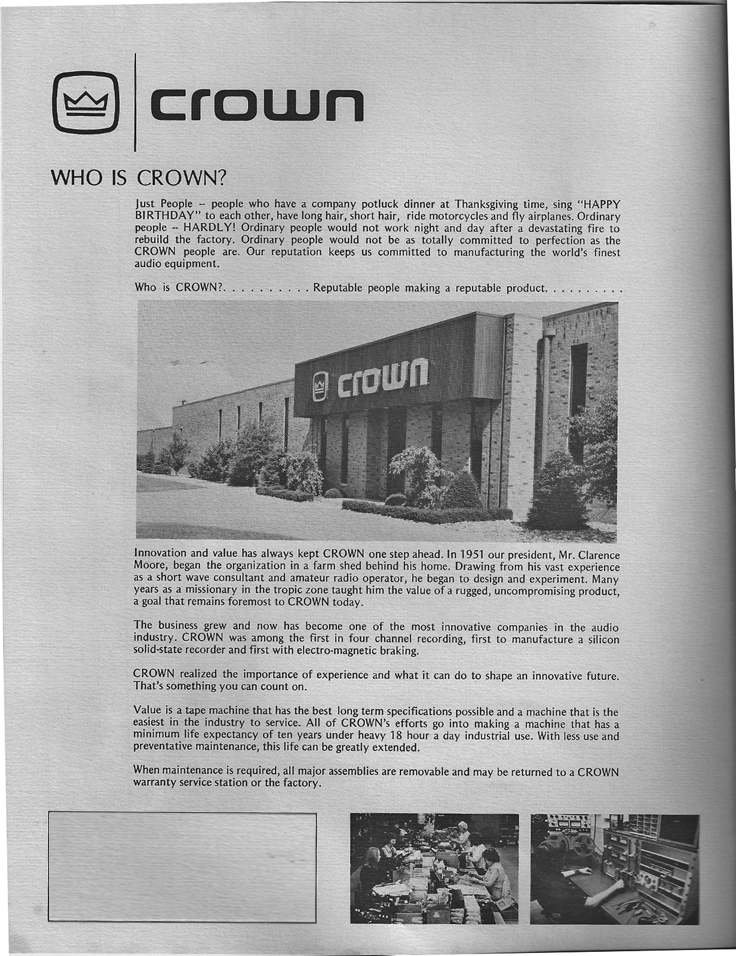 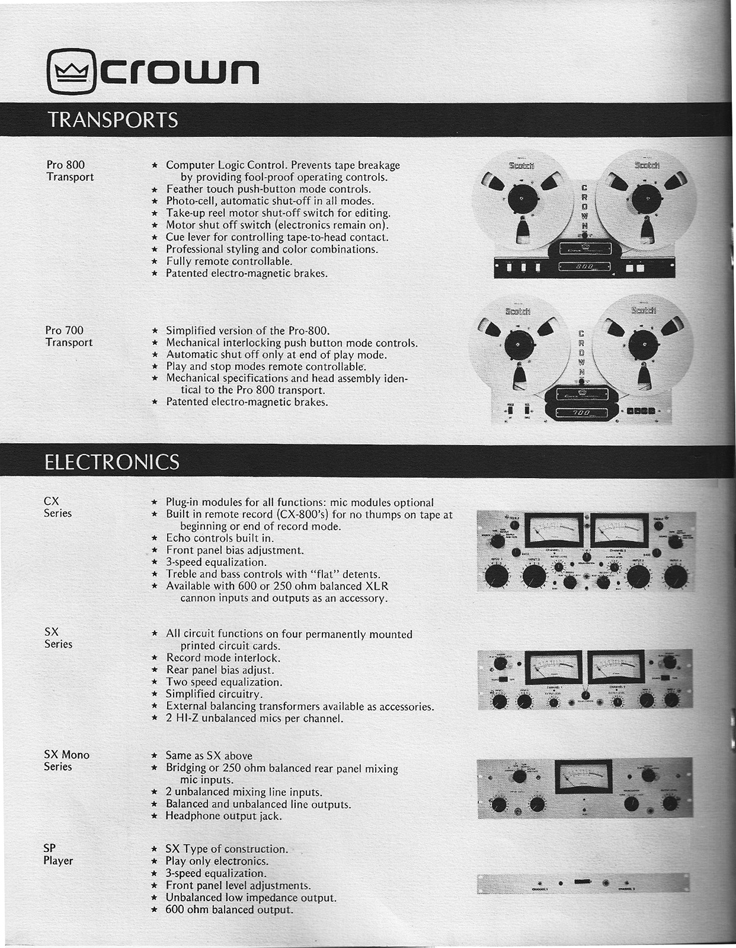 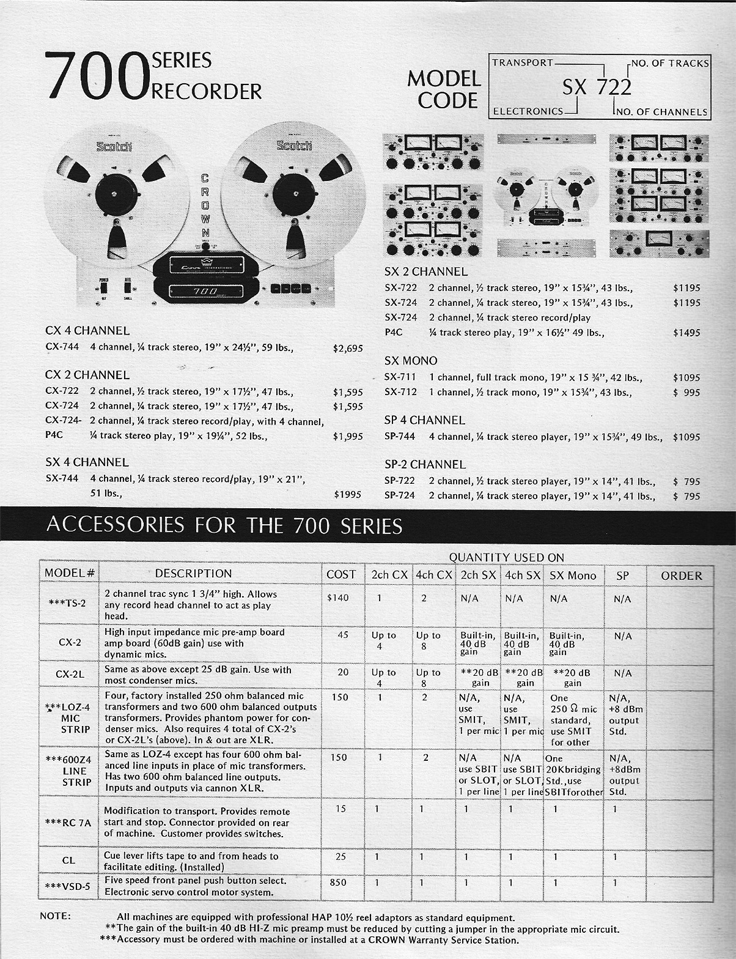 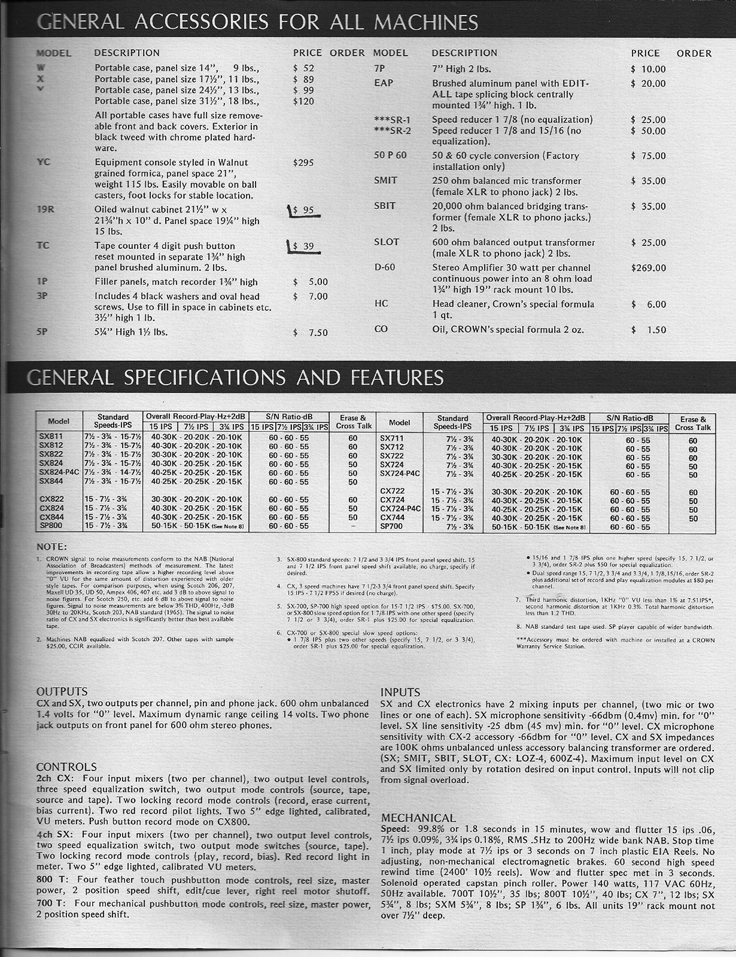
|
| |
Dokorder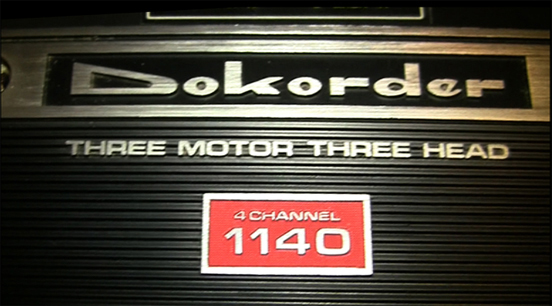
1958 - ? No further info found on company
Denki Onkyo KABASHIKI Kaisha
25, 3-Chome, Nishirokugo, Ota-Ku, Tokyo-To Japan
US trademark filed 3/30/1960 - cancelled 2002 - not related to the Onkyo audio company, located in Osaka
Denki Onkyo Company Ltd.; Tokyo, Japan (min. 1970 - min. 1977).
Brand: Dokorder, labeled also "DOK".
On Wednesday, March 30, 1960, a U.S. federal trademark registration was filed for DOKORDER by DENKI ONKYO KABASHIKI KAISHA , OTA-KU, TOKYO-TO. The USPTO has given the DOKORDER trademark serial number of 72093990. The current federal status of this trademark filing is CANCELLED - SECTION 8. The DOKORDER trademark is filed in the category of Houseware and Glass Products . The description provided to the USPTO for DOKORDER is Tape Recorder((, Tape for Tape Recorder and Accessories and Parts Thereof; Radio, Television, Microphone, Announce Machine, Loudspeaker, Automatic Transformer, Eraser of Recorded Tape, Microphone Mixer, Amplifier, Inverter, Monoprinter, Signaltracer, Signal Injector, Transistor Batteries, Electric Vacuum Tubes, Converter, Pickup, Wireless, Ultrasonic and Light Wave Telegraph and Telephone Transceivers, Dictating Machine)) and Accessories and Parts Thereof.
|
| |
Edison
Thomas Alva Edison
2/11/1847 – 10/18/1931
The Thomas Edison Center at Menlo Park, 37 Christie Street, Edison, NJ 08820
Thomas Edison was born in Milan, Ohio, and grew up in Port Huron, Michigan.
Edison is the fourth most prolific inventor in history, holding 1,093 US patents in his name, as well as many patents in the United Kingdom, France, and Germany. His first patent was for the electric vote recorder, (U.S. Patent 90,646) which was granted on June 1, 1869.
Edison became a telegraph operator after he saved three-year-old Jimmie MacKenzie from being struck by a runaway train. Jimmie's father, station agent J.U. MacKenzie of Mount Clemens, Michigan, was so grateful that he trained Edison as a telegraph operator.
The phonograph was developed as a result of Thomas Edison's work on two other inventions, the telegraph and the telephone.
In 1877, Edison was working on a machine that would transcribe telegraphic messages through indentations on paper tape, which could later be sent over the telegraph repeatedly. This development led Edison to speculate that a telephone message could also be recorded in a similar fashion. He experimented with a diaphragm which had an embossing point and was held against rapidly-moving paraffin paper. The speaking vibrations made indentations in the paper.
Edison later changed the paper to a metal cylinder with tin foil wrapped around it. The machine had two diaphragm-and-needle units, one for recording, and one for playback. When one would speak into a mouthpiece, the sound vibrations would be indented onto the cylinder by the recording needle in a vertical (or hill and dale) groove pattern.
Edison gave a sketch of the machine to his mechanic, John Kruesi, to build, which Kruesi supposedly did within 30 hours. Edison immediately tested the machine by speaking the nursery rhyme into the mouthpiece, "Mary had a little lamb." To his amazement, the machine played his words back to him.
Edison took his new invention to the offices of Scientific American in New York City and showed it to staff there. As the December 22, 1877, issue reported, "Mr. Thomas A. Edison recently came into this office, placed a little machine on our desk, turned a crank, and the machine inquired as to our health, asked how we liked the phonograph, informed us that it was very well, and bid us a cordial good night." Interest was great, and the invention was reported in several New York newspapers, and later in other American newspapers and magazines.
The Edison Speaking Phonograph Company was established on January 24, 1878, to exploit the new machine by exhibiting it. Edison received $10,000 for the manufacturing and sales rights and 20% of the profits. As a novelty, the machine was an instant success, but was difficult to operate except by experts, and the tin foil would last for only a few playings.
A process for mass-producing duplicate wax cylinders was put into effect in 1901. The cylinders were molded, rather than engraved by a stylus, and a harder wax was used. The process was referred to as Gold Moulded, because of a gold vapor given off by gold electrodes used in the process.
Sub-masters were created from the gold master, and the cylinders were made from these molds. From a single mold, 120 to 150 cylinders could be produced every day. The new wax used was black in color, and the cylinders were initially called New High Speed Hard Wax Moulded Records until the name was changed to Gold Moulded.
By mid-1904, the savings in mass duplication was reflected in the price for cylinders which had been lowered to 35 cents each. Beveled ends were made on the cylinders to accommodate titles.
In terms of playing time, the 2-minute wax cylinder could not compete well against competitors' discs, which could offer up to four minutes. In response, the Amberol Record was presented in November 1908, which had finer grooves than the two-minute cylinders, and thus, could last as long as 4 minutes.
Although Edison began experimenting on the phonograph using wax coated paper as a recording medium, his phonograph recorded sound onto a tinfoil sheet phonograph cylinder.
Alexander Graham Bell's Volta Laboratory made several improvements in the 1880s, including the use of wax-coated cardboard cylinders, and a cutting stylus that moved from side to side in a "zig zag" pattern across the record.
Then at the turn of the century, Emile Berliner initiated the transition from phonograph cylinders to gramophone records: flat, double-sided discs with a spiral groove running from the periphery to near the center.
In American English, "phonograph", properly specific to machines made by Edison, was sometimes used in a generic sense as early as the 1890s to include cylinder-playing machines made by others, but it was then considered strictly incorrect to apply it to the upstart Gramophone, a very different machine which played
discs.
"Talking machine" was the comprehensive generic term, but in the early 20th Century the general public was increasingly applying the word "phonograph" indiscriminately to both cylinder and disc machines and to the records they played.
By the time of the First World War, the mass advertising and popularity of the Victor Talking Machine Company's Victrolas (a line of disc-playing machines characterized by their concealed horns) was leading to widespread generic use of the word "victrola" for any machine that played discs, which were however still called "phonograph records" or simply "records", almost never "victrola records".
After electronic disc-playing machines started appearing on the market during the second half of the 1920s, usually sharing the same cabinet with a radio receiver, the term "record player" was increasingly favored by users when referring to the device.
The brand name Gramophone was not used in the USA after 1901, and the word fell out of use there, though it has survived in its nickname form, Grammy, as the title of the Grammy Awards. The Grammy trophy itself is a small rendering of a gramophone, resembling a Victor disc machine with a taper arm.
|
| |
EICO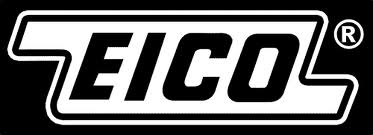
Electronic Instrument Co. Inc. , 84 Whiters St., Brooklyn 11, N.Y.
1945 - late 1970's - Property Management until 1999
EICO was established in New York City in 1945 to manufacture electronic test equipment in kit form.
In the 70's the only audio products they sold were kits made for them in South Korea
EICO existed as a property management company until 1999, when the company was liquidated at the request of the shareholders.
|
| |
British Ferrograph Recorder Co
(page recommended and content sent by Richard Glenn - sourced from Grace's Guide)
British Ferrograph Recorder Company, of South Shields, makers of tape recorders and audio equipment Founded in 1949. The earliest ad we've come across was 1953 and the last review was from 1974.
The original company
Wright and Weaire of 740 High Road, Tottenham, London, N.17. Telephone: Tottenham 3847-8. Cables: "Writewea, London"
1920 Incorporated as a private company for purposes of acquiring the instruments business of Messrs J.G. Wright and T.G.Weaire
1922 Wright and Weaire, or WW as they became known, started manufacturing radio components from a factory in Tottenham, London.
1928 Richard Merrick started work with Wright and Weaire as a tester and inspector of components.
Another young man who started at Wright and Weaire in those early days was Ernest Niblett. Acknowledged as the "Architect" of the company's post-war success, he became joint managing director with Richard Merrick.
1929 Listed Exhibitor - British Industries Fair. Manufacturers of Wireless Apparatus, Component Parts, Accessories. (Stand No. MM.62)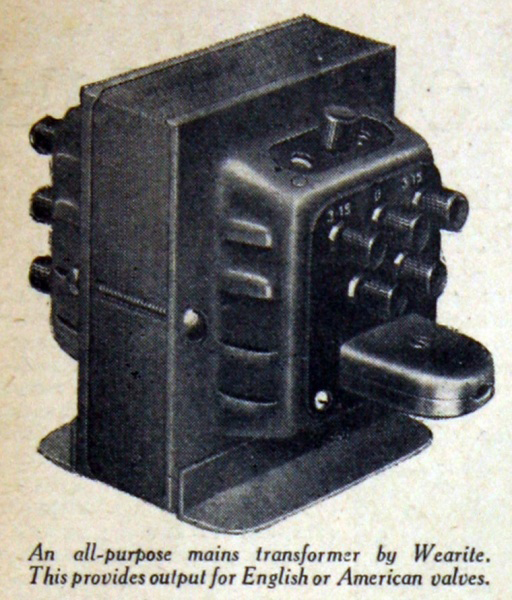
1933 Wright and Weaire began importing a new design of super-heterodyne coil for radio tuning systems from Gabriel Suchestow of Vienna. The demand from amateur radio enthusiasts for these products was such that a small factory was set up to manufacture them in the UK. Gabriel Suchestow sent over his nephew Theodor Kolb to take charge commercially and their chief engineer George Nissen to supervise the engineering and production of the product.
This enterprise was a great success and everyone concerned prospered from the venture. However, Theodor Kolb was recalled to Vienna and George Nissen left the UK when rumors of European unrest became rife.
1935 Merrick had achieved the position of Sales Manager.
1937 Electrical instrument manufacturers.
1939 See Aircraft Industry Suppliers
WWII. From 1940 to 1945, Wright and Weaire manufactured a range of plugs and sockets that went into the making of the "Williamson" Aircraft Cameras, in addition to a vast number of parts for war planes including the De Havilland Mosquito
Other items manufactured by the company were electrical devices for field radios. Most notable of these was the "Vibrator" powered from a DC battery, it chopped the current derived and fed it into a transformer to step it up as an AC voltage, for use by portable field radio equipment. This produced a high voltage AC, from a low voltage source.
Post-WWII. By the end of the war Joseph Wright and Thomas Weaire announced their decision to retire and offered the company to Richard Merrick, Ernest Niblett and Walter Berridge (the company secretary) on advantageous terms and they accepted this offer without hesitation.
1945 Started to transfer production from Tottenham to a bigger factory at South Shields; the move was complete within a year. The closure and sale of the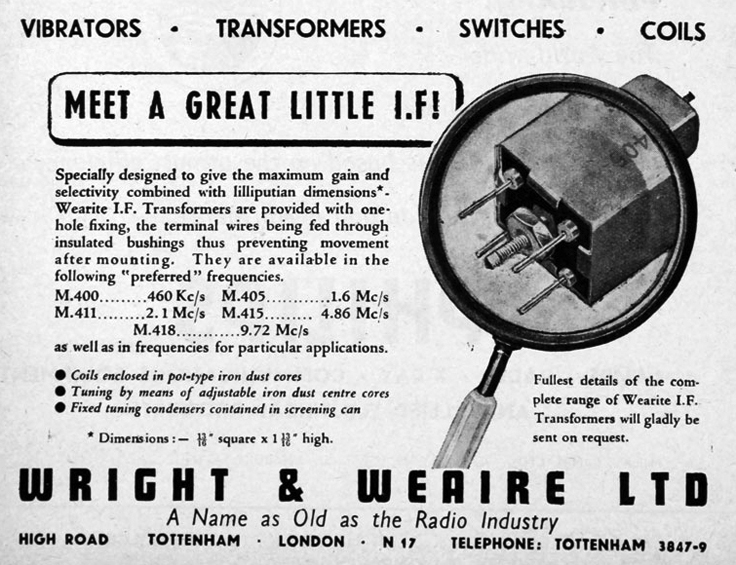 Tottenham factory produced a number of problems. None of the senior management from Tottenham wanted to move from London to the North East. As Wright and Weaire had always produced their own machine tools, this proved quite a problem. This set-back was overcome to some extent by setting up a small tool-making and component factory run by Wright and Weaire's two top designers Renard and Dare, who were made Managing directors and from whose names the company of "Rendar" was founded. Rendar manufactured high quality plugs and sockets for the electronics industry. Tottenham factory produced a number of problems. None of the senior management from Tottenham wanted to move from London to the North East. As Wright and Weaire had always produced their own machine tools, this proved quite a problem. This set-back was overcome to some extent by setting up a small tool-making and component factory run by Wright and Weaire's two top designers Renard and Dare, who were made Managing directors and from whose names the company of "Rendar" was founded. Rendar manufactured high quality plugs and sockets for the electronics industry.
The end of hostilities also put demands on many companies to find new markets, and put into use the advances in technology that often result from research done for military purposes. Miniaturization and tropicalisation were two of the things that WW had been involved in during the war, and which became standard practice in products from then on. The government of the day impressed on every manufacturer the need to produce goods for export to earn money that would enable Britain to be rebuilt after a costly war effort.
This resulted in Mr. Merrick paying a visit to Paris, where French manufacturers who had been in similar markets to Wright & Weaire, who were producing new products of advanced designs. One of these manufacturers was "Bobinages Renard" with whom the exchange of certain processes and designs were negotiated. An exchange of visits by English manufacturers to French counterparts and by the French to English factories resulted in exhibitions of their manufacture in both London and Paris.
1947 During one of these exhibitions Richard Merrick was introduced to an American named Louis Fishoff, who had the foresight to recognize the importance of tape recording as a new growth market, and finally succeeded in convincing Richard Merrick to investigate the possibility of producing a tape recorder.
Louis Fishoff's insistence was such that Richard Merrick passed his thoughts onto Ernest Niblett, who confessed that he had been interested in this technology for some time, so the decision was made then and there to pursue the matter immediately. The result, the Wearite Tape Deck. A factory was established at South Shields; a team of six technical engineers was engaged and, by the middle of 1948, the first Ferrograph recorder was produced.
British Ferrograph Recorder Company founded
1949 A separate private company for marketing tape recorders was established, the British Ferrograph Recorder Co Ltd, owned by the same shareholders as Wright and Weaire[1].
1950 Patent - Improvements in and relating to recording apparatus.
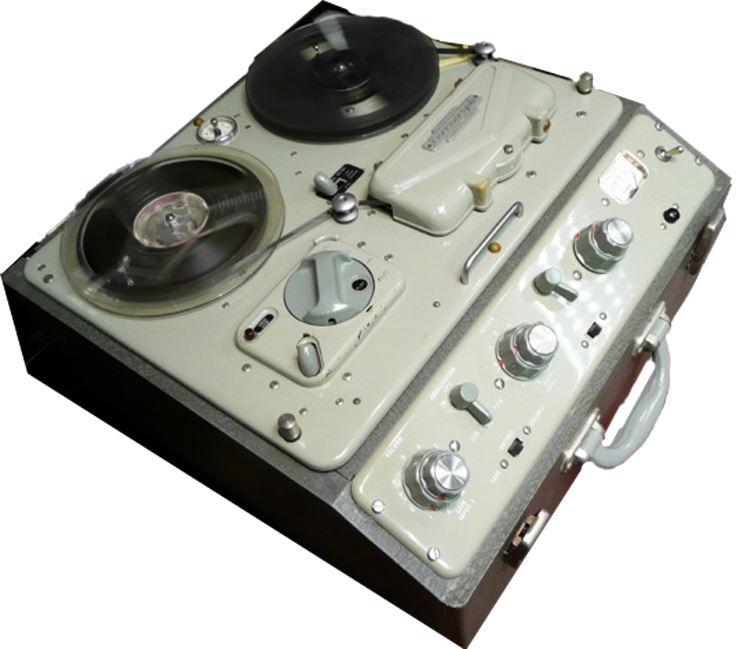 1955 Wright and Weaire was converted into a public company and acquired the share capital of Ferrograph. 1955 Wright and Weaire was converted into a public company and acquired the share capital of Ferrograph.
1957 Patent - Improvements relating to demagnetizing devices.
1958 The name of Wright and Weaire was changed to the Ferrograph Company; manufacturing activities transferred to a new subsidiary Wright and Weaire Ltd.
Production of the Ferrograph range continued unabated until the late 1960's.
1959 Ferrograph was absorbed by the Wilmot Breeden Group [4] and it was decided to add to their hi-fi range with higher powered amplifiers, radio tuners and monitor loudspeakers.
1977 Falling sales resulted in heavy financial losses for the company. In order to safeguard jobs the National Enterprise Board arranged a marriage between Ferrograph and North East Audio Ltd (NEAL). Wilmot Breeden sold the Ferrograph company for £500k.
NEAL took on the production of the whole product range except for the  ARA1 cathode ray tube response unit. ARA1 cathode ray tube response unit.
1981 The company passed into the hands of the Receiver.
NEAL is now part of the Canford Group
Ads from the Museum Archives
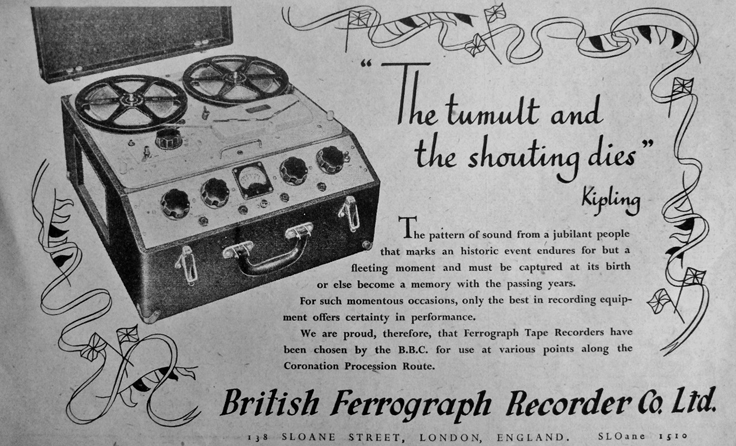  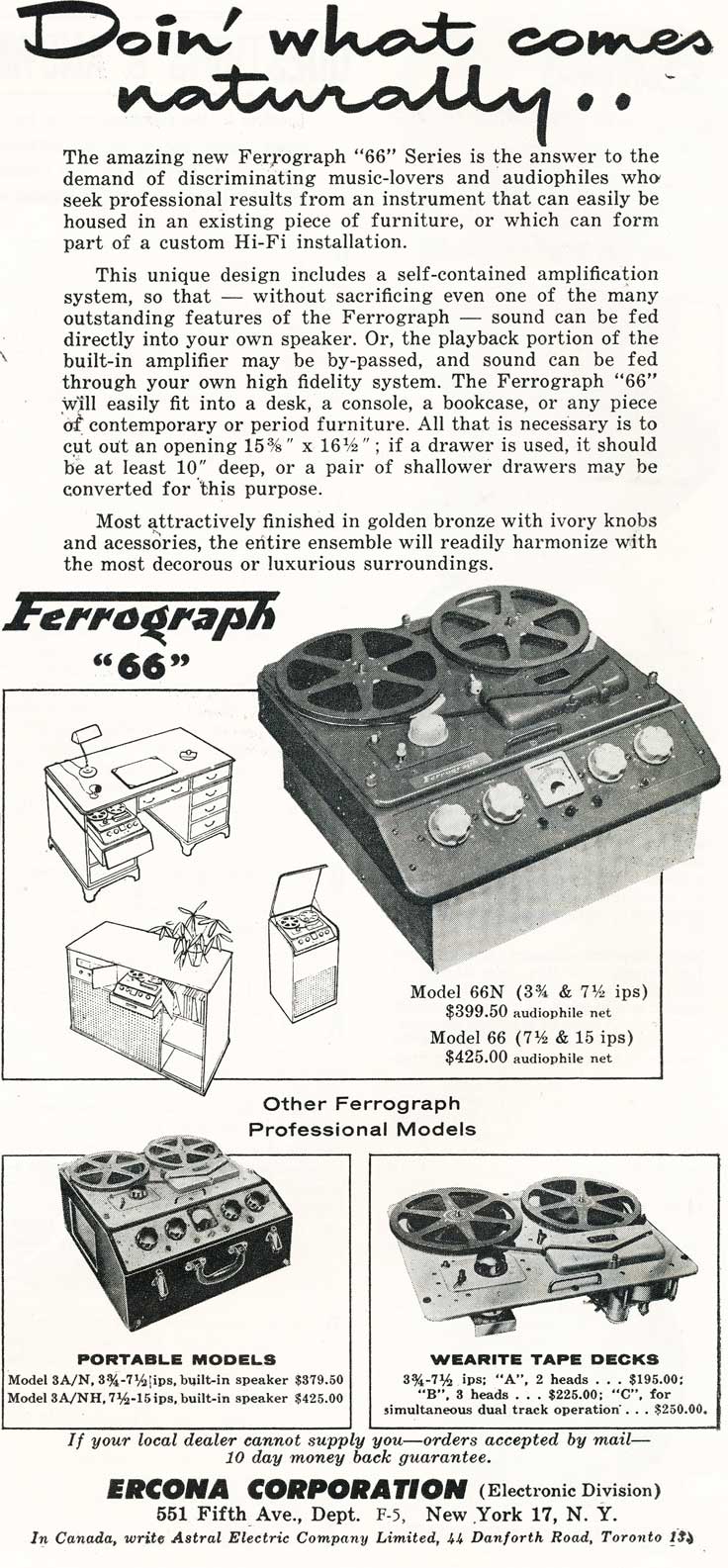 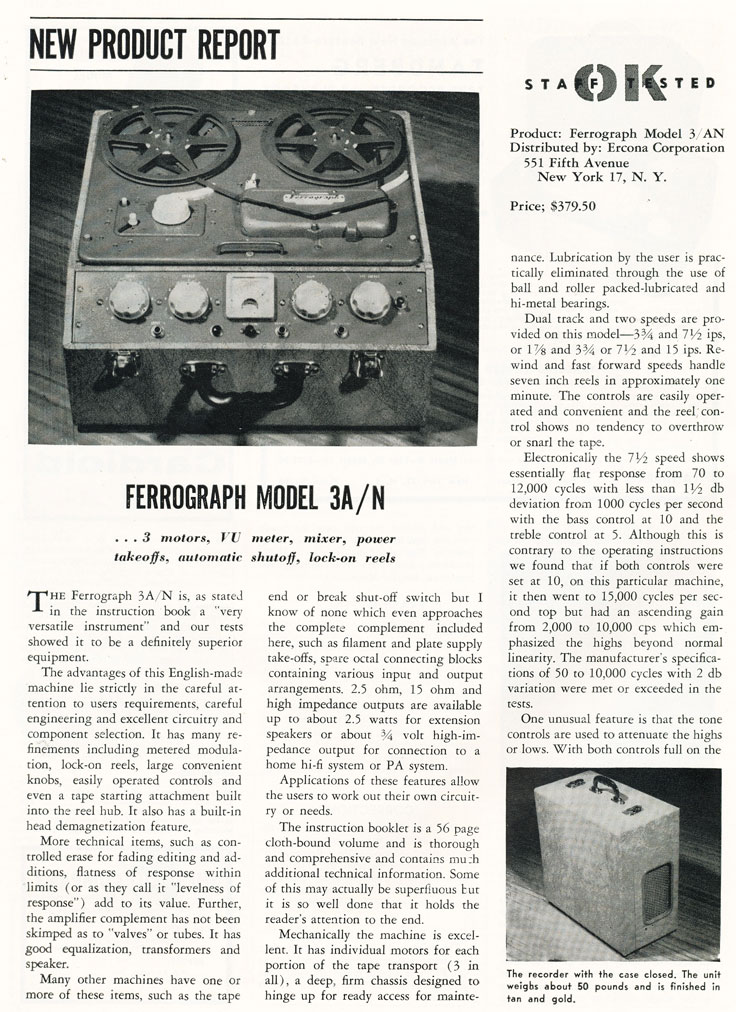  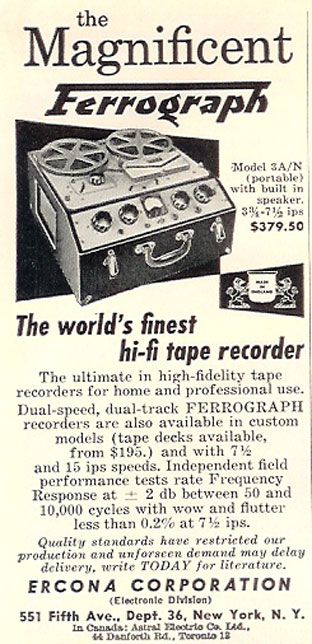  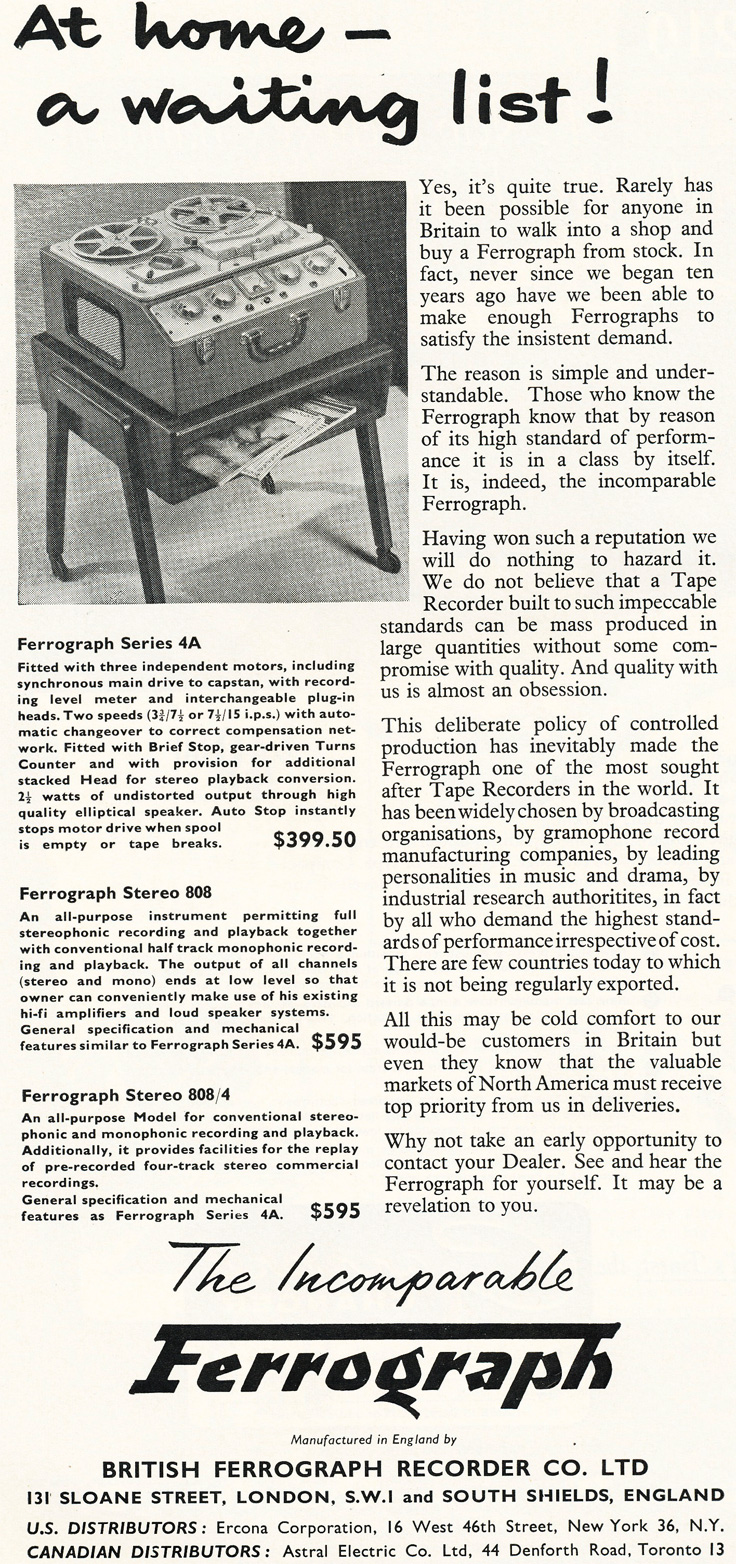   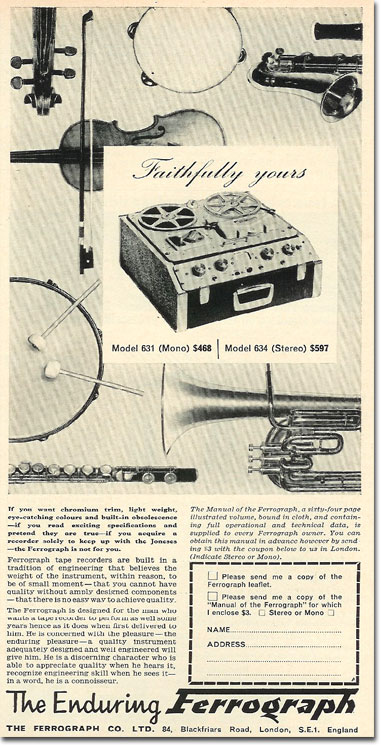 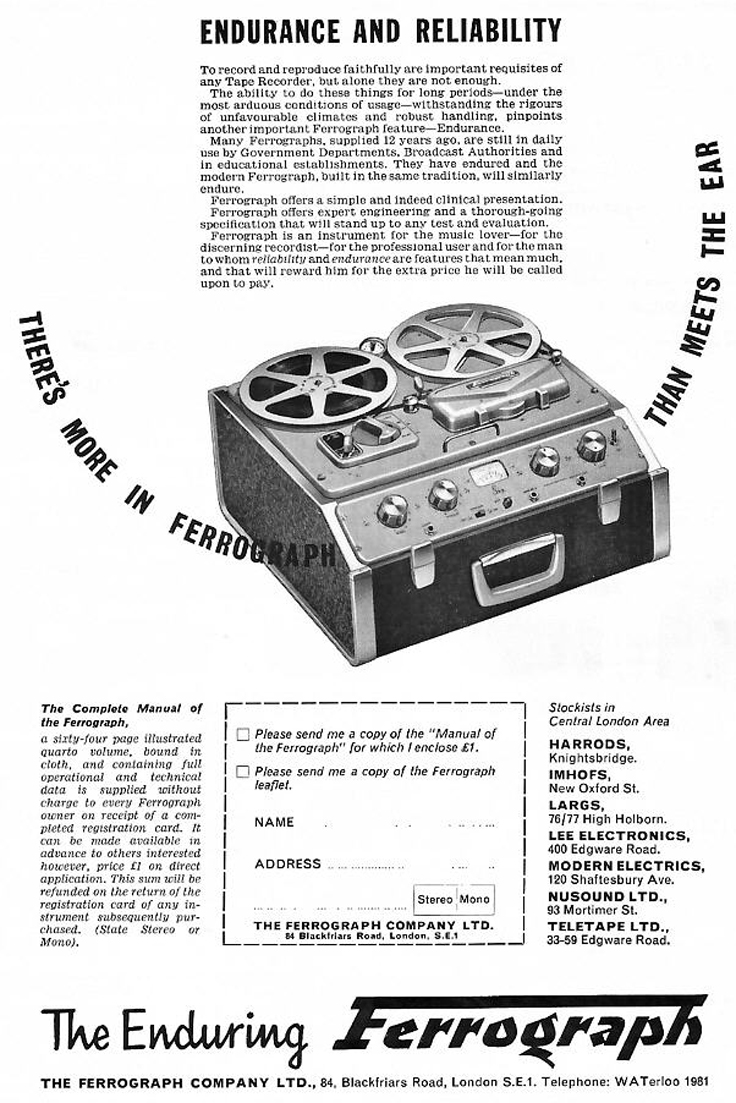   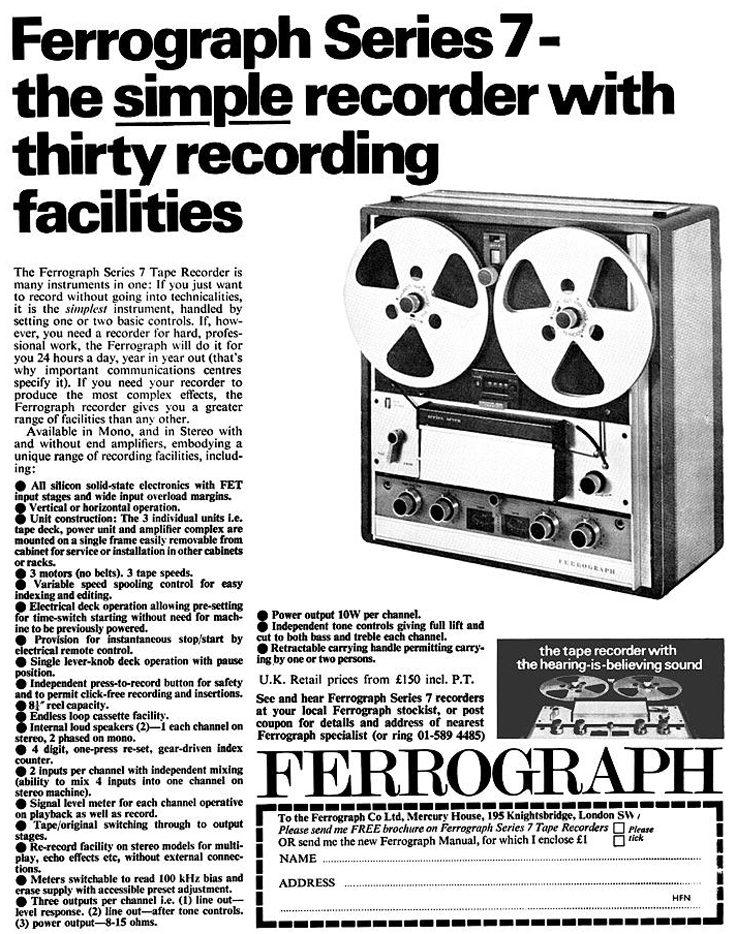 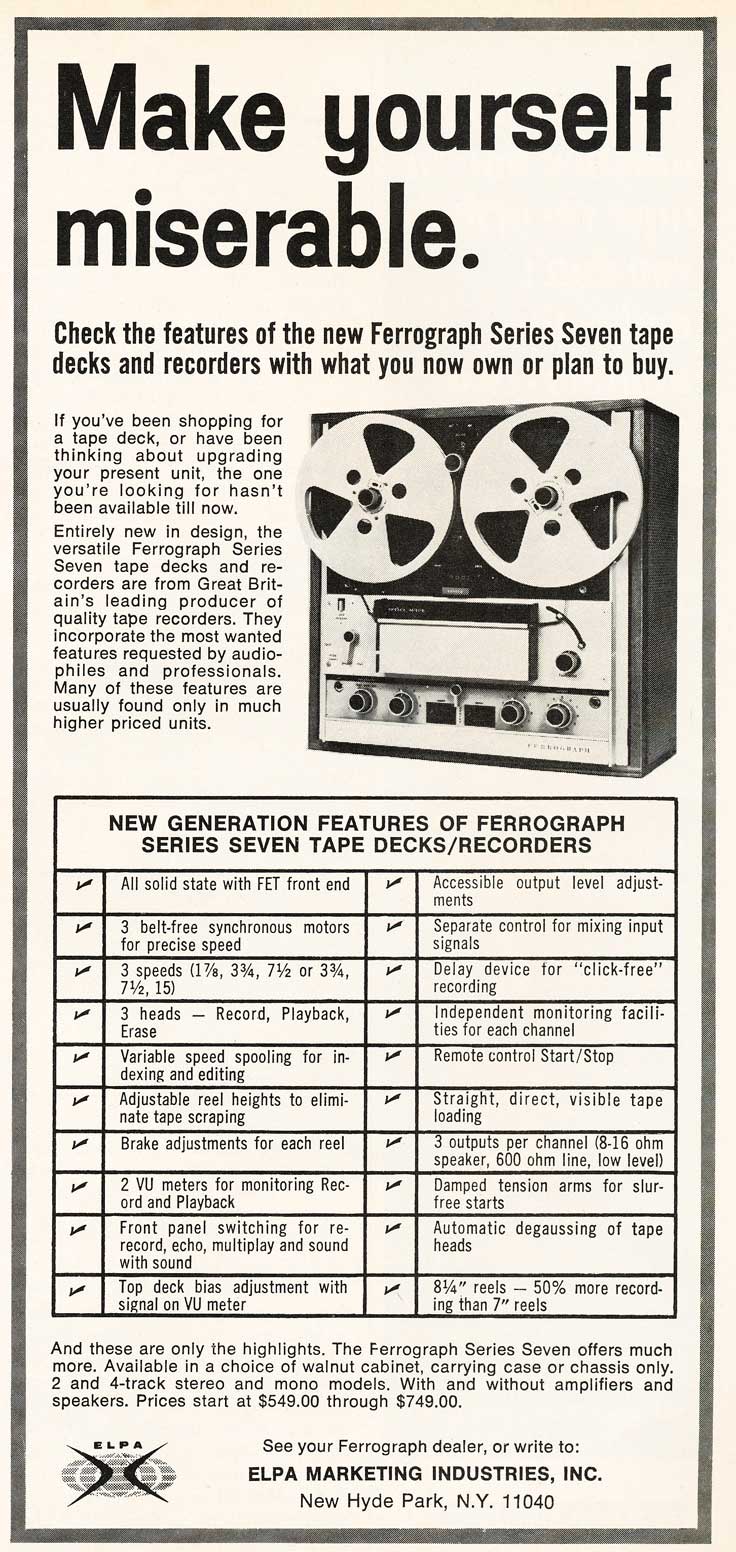   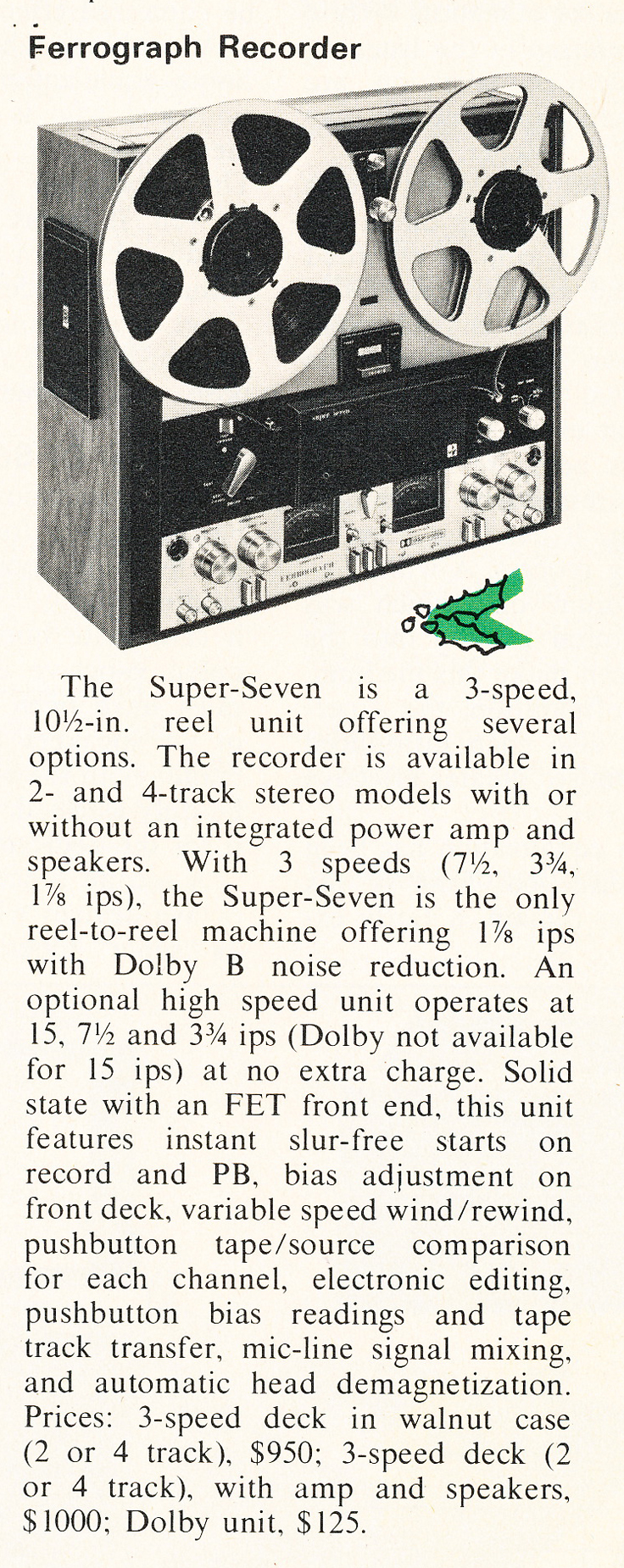 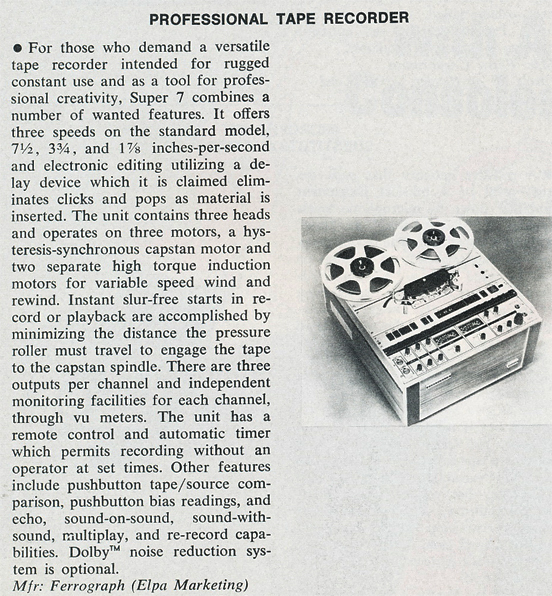
|
| |
Fostex
FOSTEX COMPANY, 3-2-35 Musashino, Akishima, Tokyo, Japan 196-0021
Foster Electric 1949 and Fostex 1973 - present
The Fostex Company was founded in July 1973 by Foster Electric Co.,Ltd. (founded 1949), one of the world's largest developers of OEM speaker and transducer products, employing over 20,000 people in nine countries/territories.
Fostex is the sole manufacturer of the iconic iPod earbuds marketed by Apple Inc. for their iPod and iPhone models
In 1981, joined by a new band of engineers, Fostex decided to enter the professional recording industry which was then on the verge of spurning the 'home recording' category.
The company started with three reel-to-reel recorders, the A-2, A-4 and by far the most innovative and popular, the A-8 which was the first machine to offer eight tracks on just 1/4" tape.
Along with the Model 350 mixer and Model 250 four-track cassette multitracker, Fostex were truly a home recording pioneer.
In 1983 the B-16 was born, this time being the first machine to provide for 16 tracks on just 1/2" tape and the first of its kind to offer Dolby C noise reduction.
The B-16 was so successful that Ampex complained that they couldn't produce tape fast enough in order to meet demand!
The B-16 was followed in later years by the E-16 (1986) and G-16S (1990) – the first reel-to-reel to have Dolby S noise reduction, a simplified version of the professional SR type standard.
The final model in this prestigious reign of analogue multitrack machines was the G-24S. Once again the format was squeezed to new levels of tolerance as Fostex succeeded in putting 24 tracks onto 1" tape.
This machine represented the pinnacle of what could be achieved including a removable front panel remote control and meter bridge; built-in SMTPE/Midi synchronization; and amazing levels of recording quality.
Often the machine would find its way from a producer's home studio to the commercial facility where they were mixing as it was felt the quality was high enough not to require a format transfer.
- FostexInternational.com
|
| |
Grundig AG
 Grundig AG was a formerly German manufacturer of consumer electronics for home entertainment which transferred to Turkish control in 2004-2007. Established in 1945 in Nuremberg by Max Grundig, the company changed hands several times before becoming part of the Turkish Koç Holding group. In 2007, after buying control of the Grundig brand, Koç Holding renamed its Beko Elektronik white goods and consumer electronics division Grundig Elektronik AG, which has decided to merge with Arçelik AG as declared on February 27, 2009. Grundig AG was a formerly German manufacturer of consumer electronics for home entertainment which transferred to Turkish control in 2004-2007. Established in 1945 in Nuremberg by Max Grundig, the company changed hands several times before becoming part of the Turkish Koç Holding group. In 2007, after buying control of the Grundig brand, Koç Holding renamed its Beko Elektronik white goods and consumer electronics division Grundig Elektronik AG, which has decided to merge with Arçelik AG as declared on February 27, 2009.
The company began in 1930 with the establishment of a store named Fuerth, Grundig & Wurzer (RVF), which sold radios. 1945: Immediately after the war,  Germany was in ruins. This was also true for many radios. Since new production was out of the question, the demand for repair work was very great. Radio dealer Max Grundig recognized the signs of the times and built the first two Grundig appliances: the Tubatest tube tester and the Novatest testing device, and in 1947 produced a Germany was in ruins. This was also true for many radios. Since new production was out of the question, the demand for repair work was very great. Radio dealer Max Grundig recognized the signs of the times and built the first two Grundig appliances: the Tubatest tube tester and the Novatest testing device, and in 1947 produced a 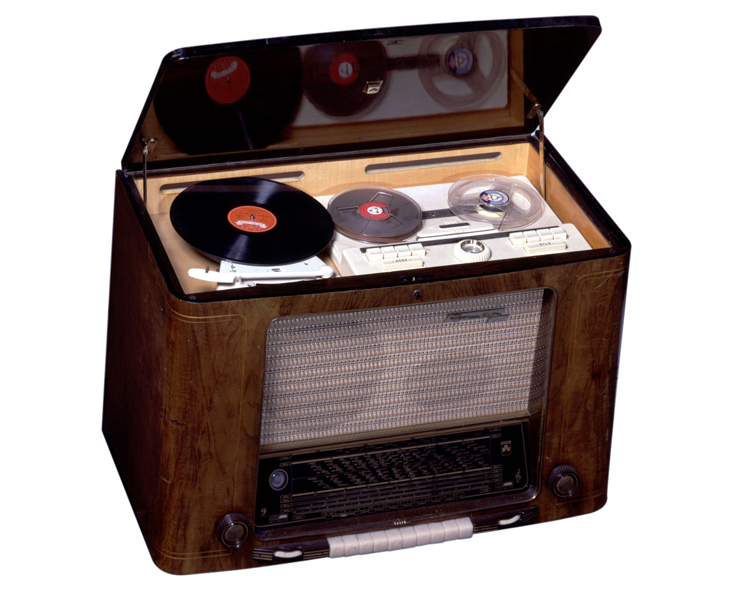 kit, while a factory and administration centre were built at Fürth. In1951 the first televisions were manufactured at the new facility. At the time Grundig was the largest radio manufacturer in Europe. Divisions in Nuremberg,Frankfurt and Karlsruhe were established. kit, while a factory and administration centre were built at Fürth. In1951 the first televisions were manufactured at the new facility. At the time Grundig was the largest radio manufacturer in Europe. Divisions in Nuremberg,Frankfurt and Karlsruhe were established.
A plant was opened in 1960 to manufacture tape recorders in Belfast, Northern Ireland, the first production by Grundig outside Germany. The managing director of the plant Thomas Niedermayer, was kidnapped and later killed by the Provisional IRA in December 1973. The factory was closed with the loss of around 1000 jobs in 1980.
 In 1972, Grundig GmbH became Grundig AG. After this Philips began to gradually accumulate shares in the company over the years, and assumed complete economic control in 1993. Philips sold Grundig to a Bavarian consortium in 1998 due to unsatisfactory performance. In 1972, Grundig GmbH became Grundig AG. After this Philips began to gradually accumulate shares in the company over the years, and assumed complete economic control in 1993. Philips sold Grundig to a Bavarian consortium in 1998 due to unsatisfactory performance.
At the end of June 2000 the company relocated its headquarters in Fürth and Nuremberg. Grundig lost €1,281 million the following year. In autumn 2002, Grundig's banks did not extend the company's lines of credit, leaving the company with an April 2003 deadline to announce insolvency. Grundig AG declared bankruptcy in 2003, selling its satellite equipment division to Thomson. In 2004 Britain's Alba plc and the Turkish Koc's Beko jointly took over Grundig Home InterMedia System, Grundig's consumer electronics division. In 2007 Alba sold its half of the business to Beko for US$50.3 million, although it retained the license to use the Grundig brand in the UK until 2010, and in Australasia until 2012.
In the United States, products marketed under the Grundig brand are manufactured by the Eton Corporation (formerly Lextronix), based in Palo Alto, California. Spain's Grupo Vitelcom is licensed to manufacture mobile telephones using the Grundig Mobile brand, and auto parts company Delphi manufactures car radios branded Grundig.
ADS

|
| |
Heath Kit
The Heath Company was originally founded as an aircraft company in 1912 by Edward Bayard Heath.
Heath died during a 1931 test flight.
In 1935 Howard Anthony purchased the then-bankrupt
Heath Company, and focused on selling accessories for small aircraft.
After World War II, Anthony decided that entering the electronics industry was a good idea, and bought a large stock of surplus wartime electronic parts with the intention of building kits with them.
In 1947, Heath introduced its first electronic kit, the O1 oscilloscope that sold for US $50.
After the death of Howard Anthony in 1954, Heath was bought by Daystrom Company.
Daystrom was absorbed by oil field service company Schlumberger Limited in 1962.
Zenith Radio Company bought Heath Company from Schlumberger in 1979.
When Zenith eventually sold ZDS to Groupe Bull in 1989, Heathkit was included in the deal.
On March 30, 1992, the end came. Heath announced that it was closing out its kits and leaving the business
after 45 years, an event important enough to a number of people that it was reported on the front page of the New York Times.
The company, then known as Heathkit Educational Systems, announced in 2011 that they were reentering the kit business after a 20 year hiatus.
The company filed for bankruptcy and ceased all operations in 2012
|
| |
KLH Research and Development Corporation
KLH is an audio company founded in 1957 as KLH Research and Development Corporation in Cambridge, Massachusetts, United States, by Henry Kloss, Malcolm S. Low, and J. Anton Hoffman originally to produce loudspeakers. KLH had sales of $17 million, employed over 500 people and sold over 30,000 speakers a year before it was sold to Singer Corp in 1964. Later it was bought by Electro Audio Dynamics Inc. and moved to California in 1980. Massachusetts, United States, by Henry Kloss, Malcolm S. Low, and J. Anton Hoffman originally to produce loudspeakers. KLH had sales of $17 million, employed over 500 people and sold over 30,000 speakers a year before it was sold to Singer Corp in 1964. Later it was bought by Electro Audio Dynamics Inc. and moved to California in 1980.
KLH was then acquired by Kyocera Ltd, a Japanese conglomerate, and production was shifted overseas.  Kyocera decided to stop manufacturing audio products in 1989, and sought a buyer for the KLH brand. The company is now known as KLH Audio Systems located in Santa Ynez, California. Formerly known as Wald Sound and Verit Industries. Kyocera decided to stop manufacturing audio products in 1989, and sought a buyer for the KLH brand. The company is now known as KLH Audio Systems located in Santa Ynez, California. Formerly known as Wald Sound and Verit Industries.
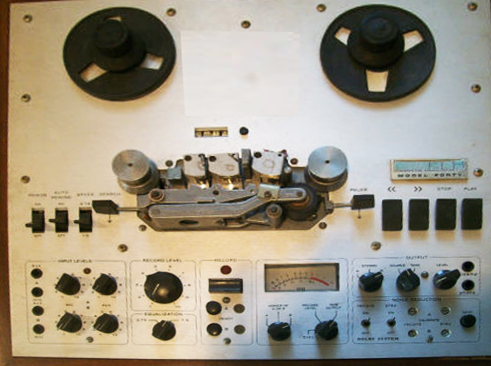 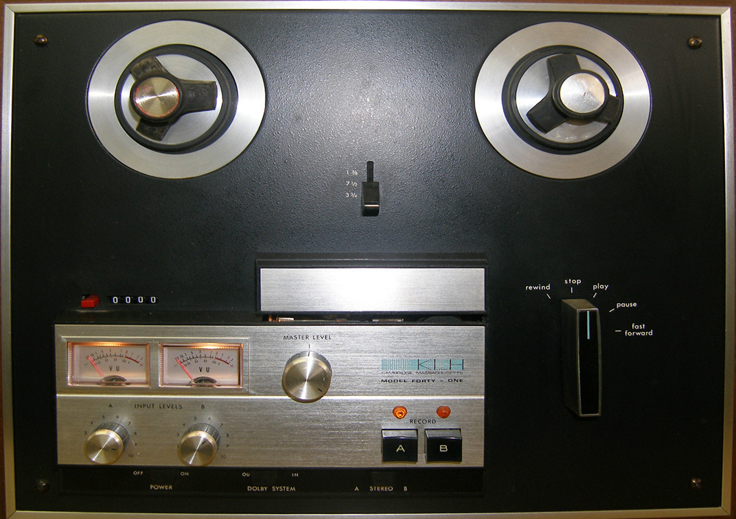
KLH model 40 and Model 41 tape recorders
|
| |
On September 29, 2012 I was saddened to receive word from Dave Boyers, that his Dad had passed away. Here is the message he sent out.
"Gentlemen,
The last remaining founder of Magnecord, Inc. has now passed into history. Dad has wanted to go be with my mother for some time now, suffering the ravages of Alzheimer's for several years. His wishes were finally granted.
To the degree he could understand it, it has been no small measure of pride that so many people have come to know and appreciate the work he did half a century ago to further the art and science of audio recording.
Similarly, the work all of you do to keep the memory of those early pioneers alive is not only worthwhile, but also gives others like Dad a sense that the efforts they made are not forgotten.
Best wishes to you all,
db"
 Magnecord Magnecord
Magnecord, Inc. was founded in Chicago, IL in 1946 by 5 men who worked for the Research Division of Illinois Institute of Technology.
Through Chris at Preservation Sound, we were able to connect with Dave Boyers the son of John Boyers (left in the 1940's) who is the only remaining founder of Magnecord. John Boyers is 96 (2012). Dave provided us with numerous items about his Dad's company and we are sharing much of that information here as well as in our 7 hour 3 DVD set about sound recording and our vintage recording collection.
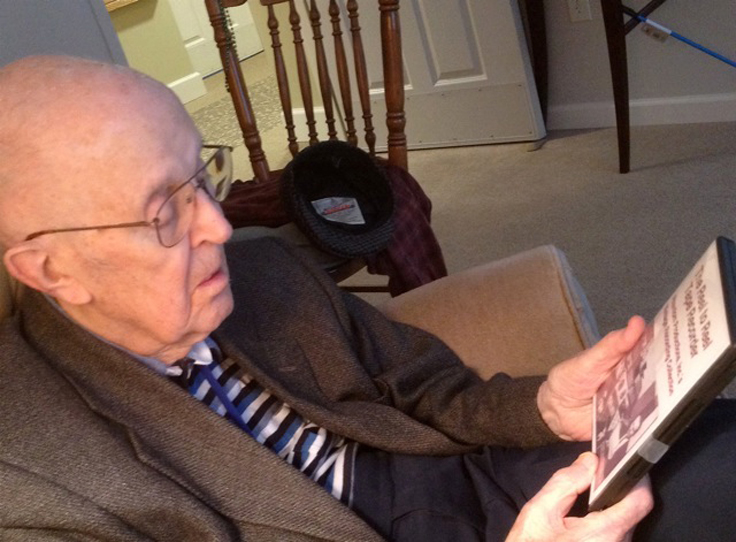 Here is a wonderful summary about Magnecord written by John Boyers (seen to the left in 2012 looking at Phantoms DVD set) - view pdf Here is a wonderful summary about Magnecord written by John Boyers (seen to the left in 2012 looking at Phantoms DVD set) - view pdf
Magnecord's first product was the professional 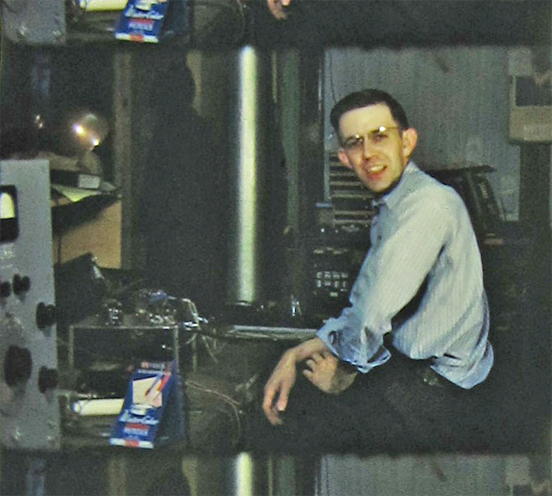 wire recorder SD-1(SD ="Super Duper") . However the company quickly moved to produce reel tape recorders beginning with the PT series seen in the 1949 ad above. View movie of Magnecord employees working on the SD-1 in 1947. wire recorder SD-1(SD ="Super Duper") . However the company quickly moved to produce reel tape recorders beginning with the PT series seen in the 1949 ad above. View movie of Magnecord employees working on the SD-1 in 1947.
In 1949 they had 90 employees and were doing $90,000 a month in business.
View copies of the Magnecord Newsletters Jan 1953 • Sept 1953 • Nov 1953 • May 1954 • July 1954
In 1956, Midwestern Instruments (later known as TELEX), a six-year-old Tulsa,
Oklahoma, company that made geophysical instrumentation, acquired Magnecord
Last reel tape recorder manufactured in the late 1960's
Telex acquired by Memorex in 1988 and went out of business in the mid-1990's
The following information (initially provided to Preservation Sound) came to us from Dave Boyers (2012)
“I wouldn’t be too surprised to learn there are some (PT-6s) still in use, probably in some third-world broadcasting station somewhere. My first PT-6 was an engineering sample put together prior to the start of manufacturing. I still have it, and it still works, (although I make that claim having not tried to fire it up for 30 years!)
Dad is still with us, although he is the last survivor of the original group, at age 95… One of Dad’s favorite stories… is the time he couldn’t make payroll, but the man at the bank gave him the funds he needed because of the trusting relationship he had built with the bank.
Dad’s interest was mostly engineering. He designed the heads, experimenting with various metals and ways to make the recording gap smaller and smaller. Back then, the heads were built one at a time, by hand. One of the handiest features of the “6″ was the ability to do instant playback head alignment with that little 4/40 screw and spring tensioner. …I don’t remember if that was a feature of the production machines or if it was just something they built into the sample I have.
Oh, here’s another story you might enjoy knowing about: Dad and one of the other guys in the shop had a brainstorm and decided to build a “binaural” (ed: Stereo) transport just for fun. They got it working and took it down to the Illinois Central train station and made a recording of a steam locomotive going by. I remember hearing the recording, with the locomotive coming in one channel and going out the other. The binaural recorder was the hit of the audio trade show in Chicago that year. According to Dad, the crowds around the little Magnecord booth were huge and the buzz of the show was all about the unbelievable train recording. I asked Dad why they didn’t get a patent on it and he says that it wasn’t patentable. It had been done before, although not commercially, and it didn’t meet the “new and novel” requirement of patent law. I’ve often wondered if they weren’t just working with the wrong patent attorney.”
The speaker “order” was round to rectangular. I happen to posses what is very likely the earliest known PT6, the engineering sample which Dad brought home for me to play with when I was about 10 years old. I have amp from the same exact time period, (also an engineering sample), and it has a round speaker cutout. At some time very shortly into the production of the pair, they went to a rectangular speaker cutout- Perhaps it can be dated by looking at photos in “Magnecord Ink”, the company newsletter.
I do have many original company service manuals, but they deal almost entirely with schematics, not mechanics. I’ll have a good look through them and see if there’s any “exploded” views for you.
Photos from the Magnecord factory provided by Dave Boyers (son of founder John Boyers) with referral from Chris at Preservation Sound.
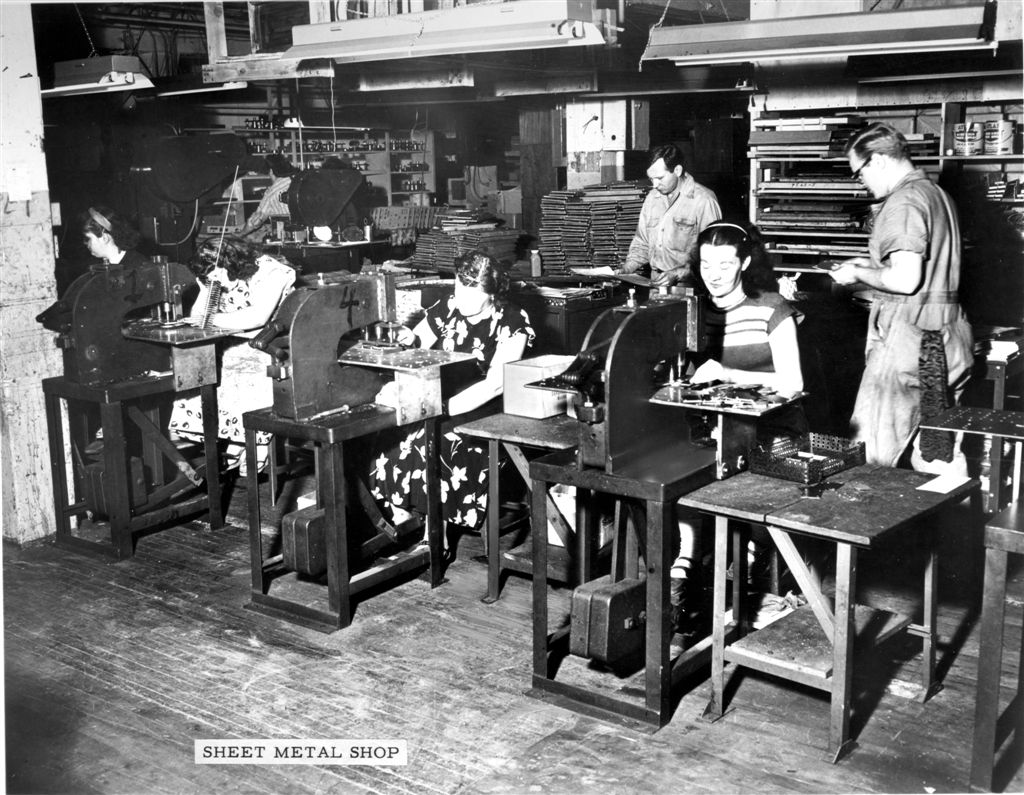  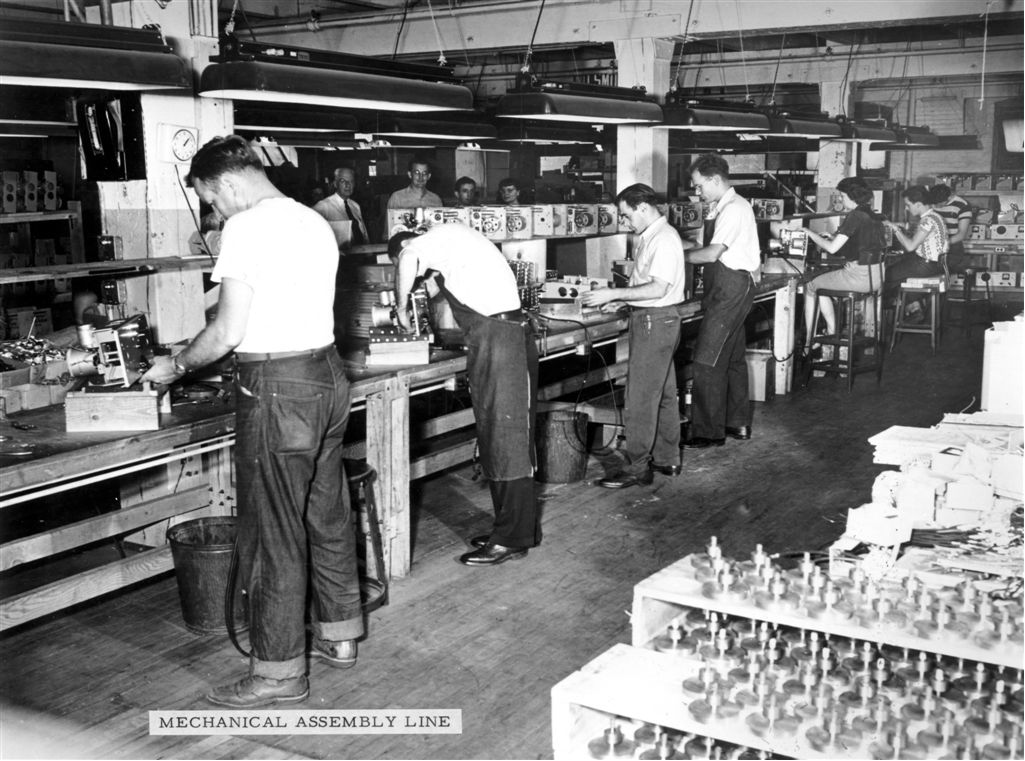
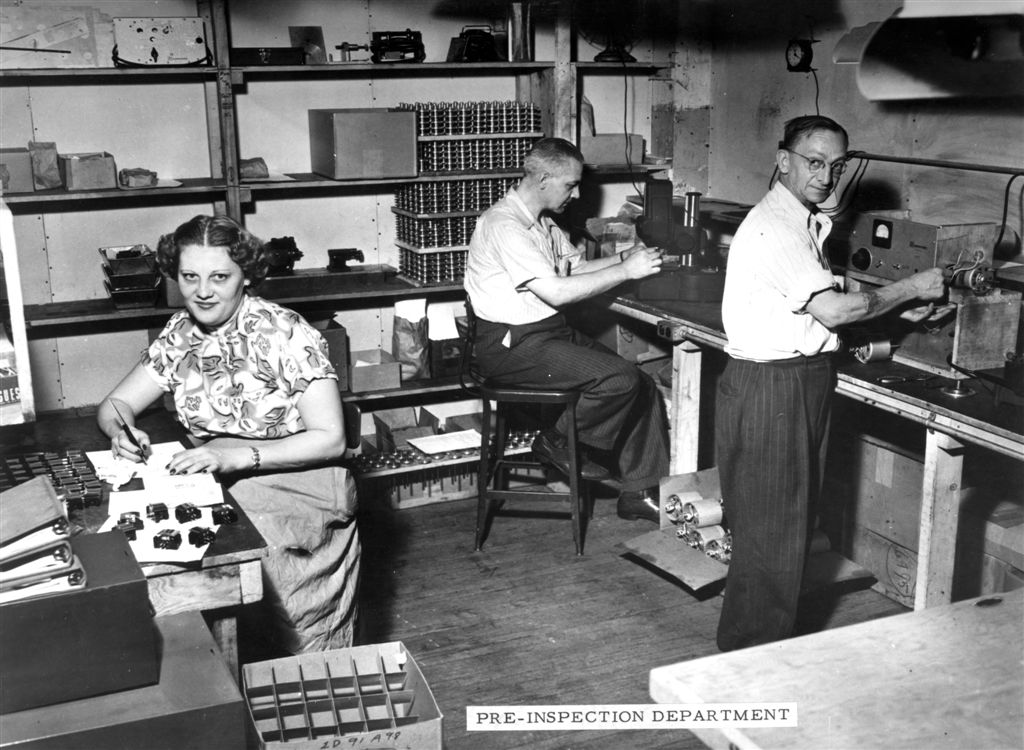 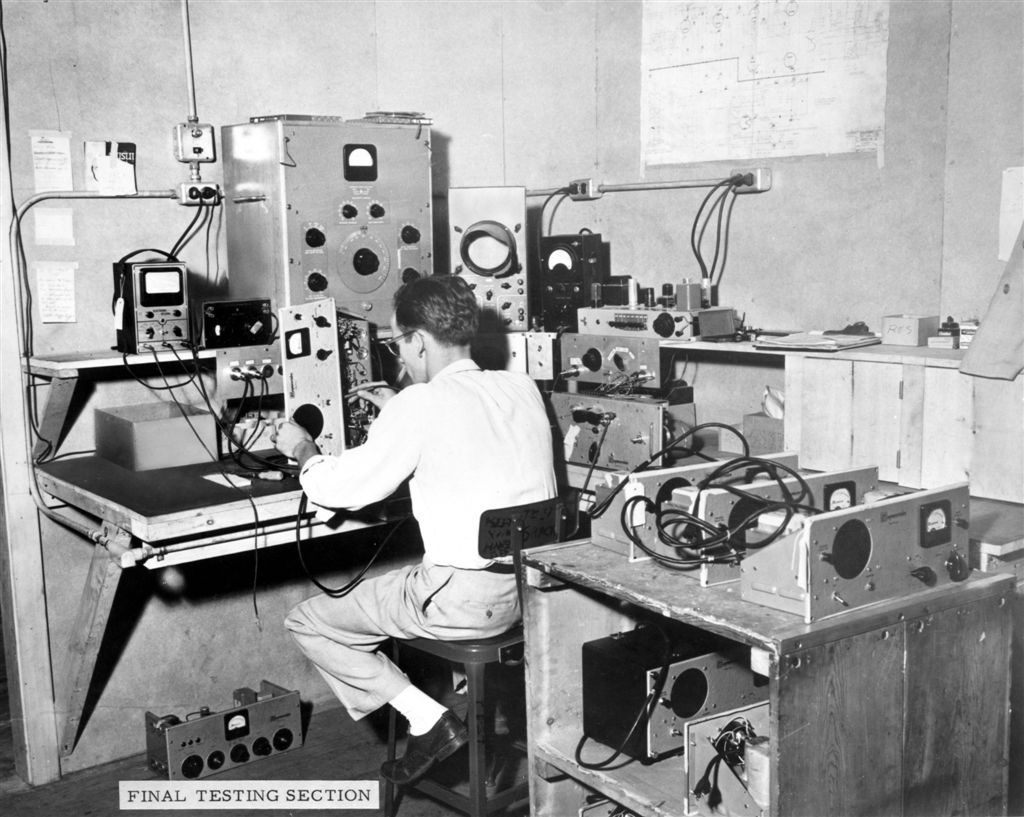 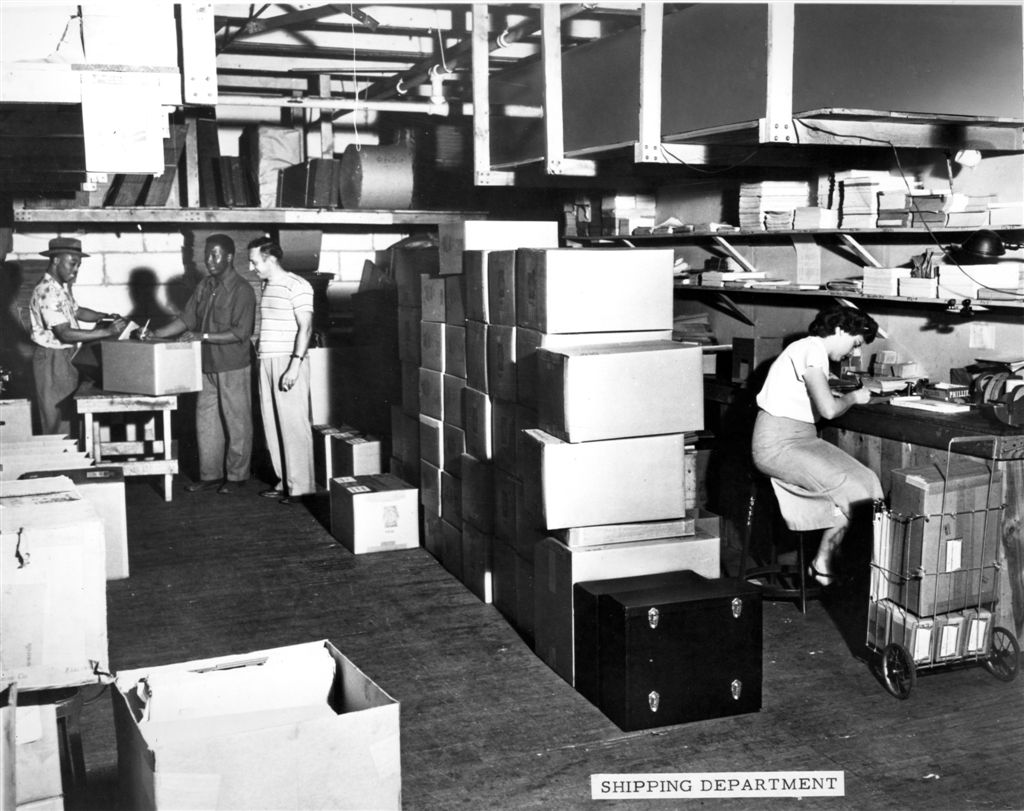
Here are some photos of perhaps one of the very first 5 Maggies ever made. This is my personal PT6, which was one of the early engineering samples (proof of concept) for the entire model run.
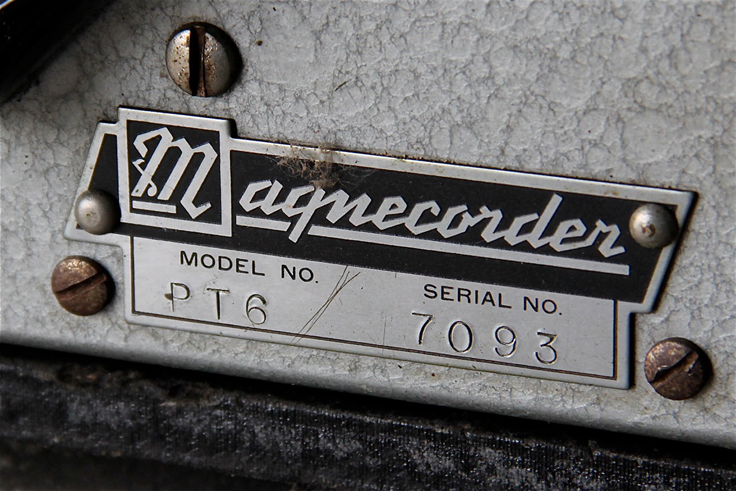 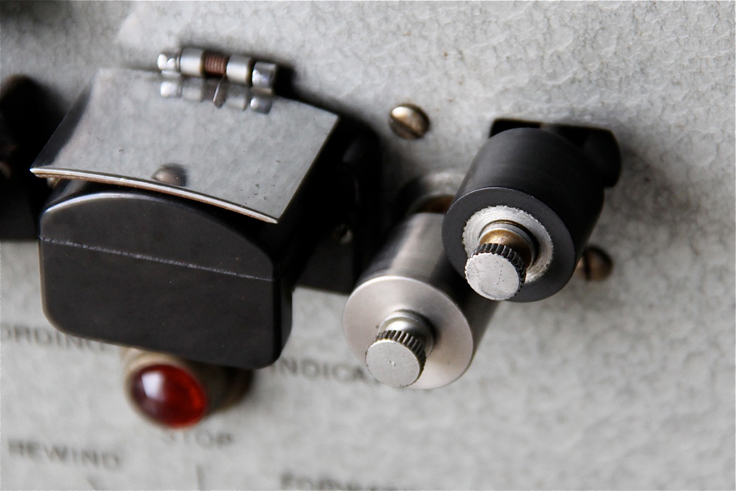 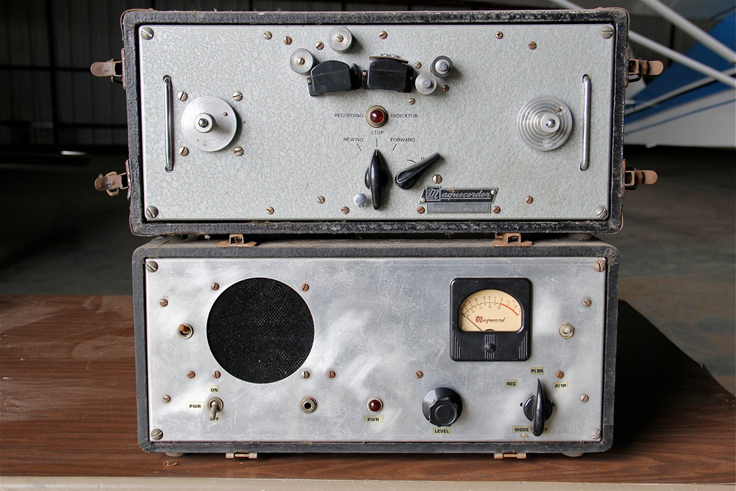 
Before doing that, I'll give you a little history. Dad brought the unit home (without a case) for me to play with. The faceplate was bare aluminum, no paint, and it still had layout die on it. My guess was he salvaged it from a trash can, but I can't verify that. He also brought an amp section, and it had a case. It also was an engineering sample.
Without the long story behind it, I'll confess that I dropped the transport. It bent things up badly enough that they had to put a modern faceplate on it, so the original one is long gone.
That happened in the early 50's. When I was in college, a friend who owned a recording studio sold me a case for the transport which he had in a junk closet. Dad identified it as one they had sold to a government agency, he thought perhaps the FBI.
The cases were made by a cabinet shop not far from the factory in Chicago.
When I started my production company, the PT6, which had a full track head on it, was the machine I used to record announce tracks from the booth. It served me well until I could afford a more modern machine.
You'll note that the amp is unpainted, as was the transport when I first got my young hands on it. The faceplate was probably salvaged from a machine that was junked, as it has a data plate with a long serial number.
I don't know the serial numbering scheme, so I have no idea what the number actually means. I only know it was on the replacement face when Dad got it repaired after my rather untimely accident.
When I first got the PT6, it didn't have the fast forward lever- that was installed with the new front. I had discovered, however, that placing the main control between stop and forward caused the take-up reel to go into fast forward as the capstan/pressure roller separated. In today's computer speak, I guess they'd call that an "undocumented feature".
Head and capstan/pressure roller, 15 IPS. I also have the 7.5 pair.
The amplifier was very original, no silk screening or paint. The original meter and speaker switches were push button style, as I recall.
Anyway, there's a little trip down memory lane. Interesting to note that after all those years of storage, the cases still smelled the same inside.
Dave Boyers 2012
Here is a Christmas card sent out by Magnecord (photos provided by Dave Boyers)
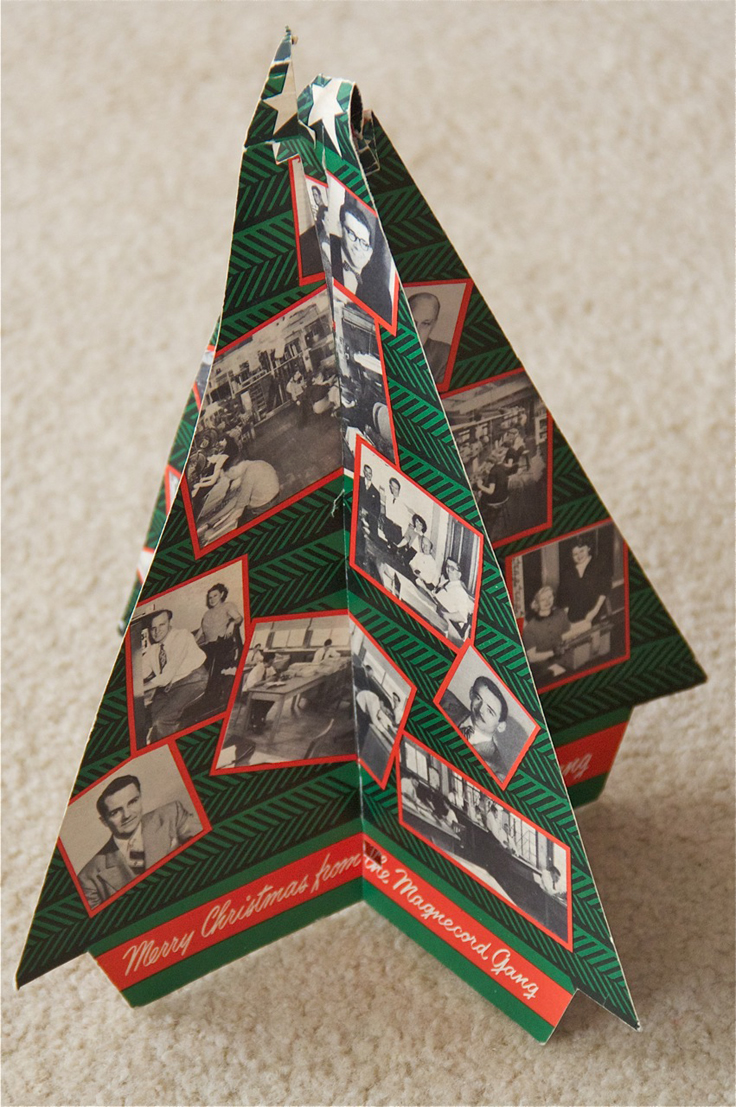 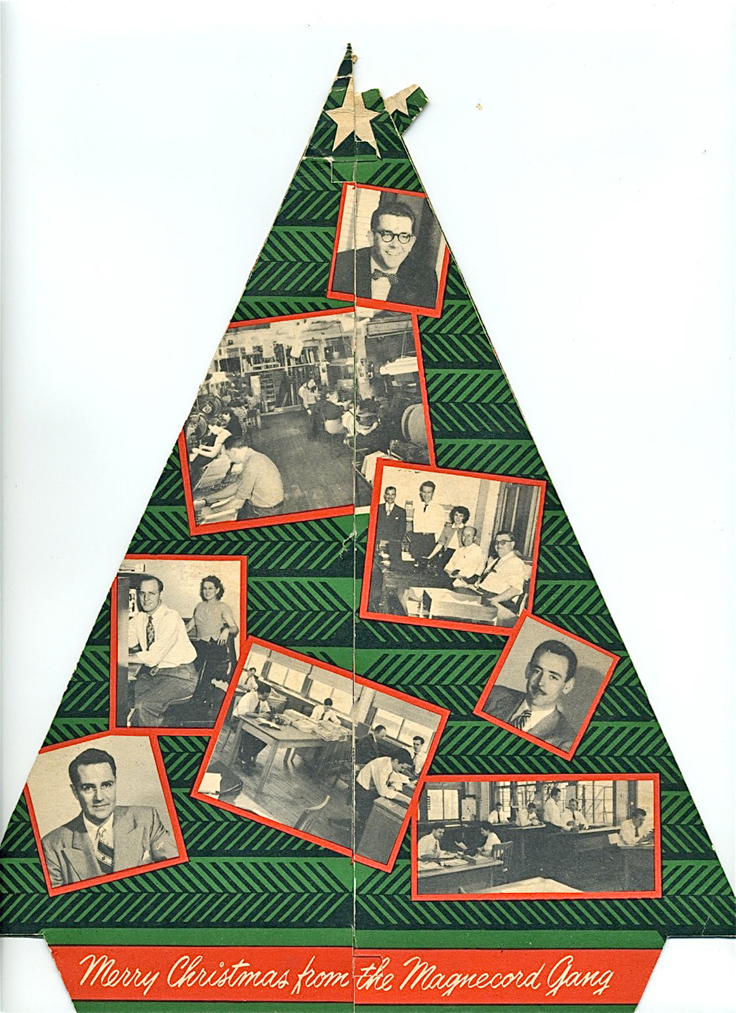 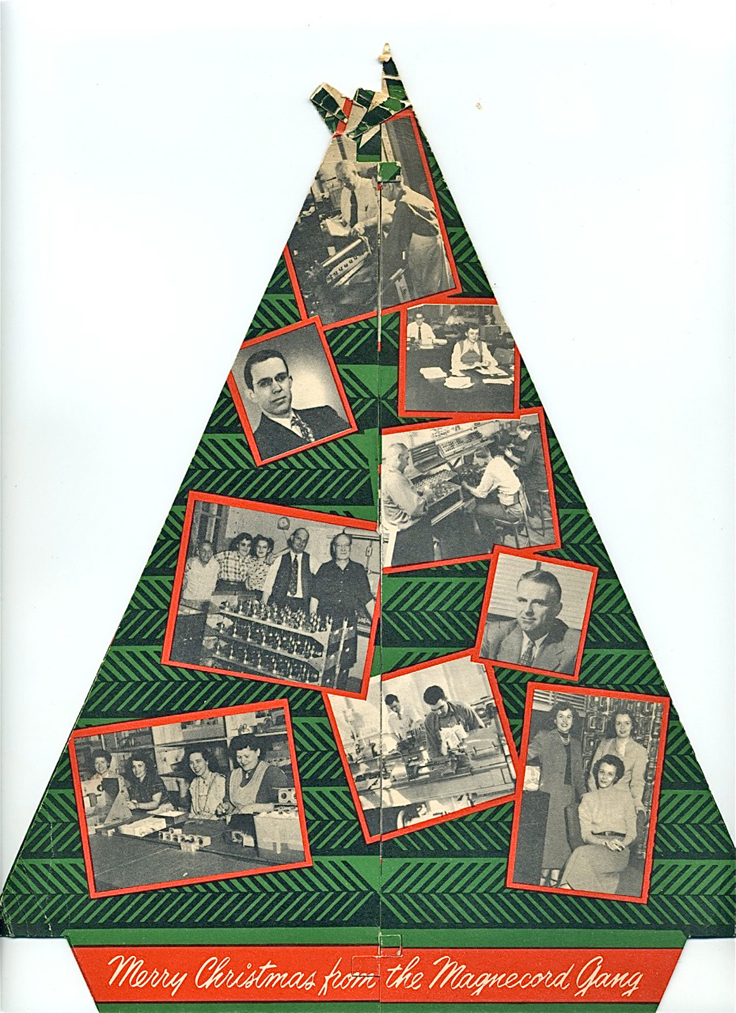  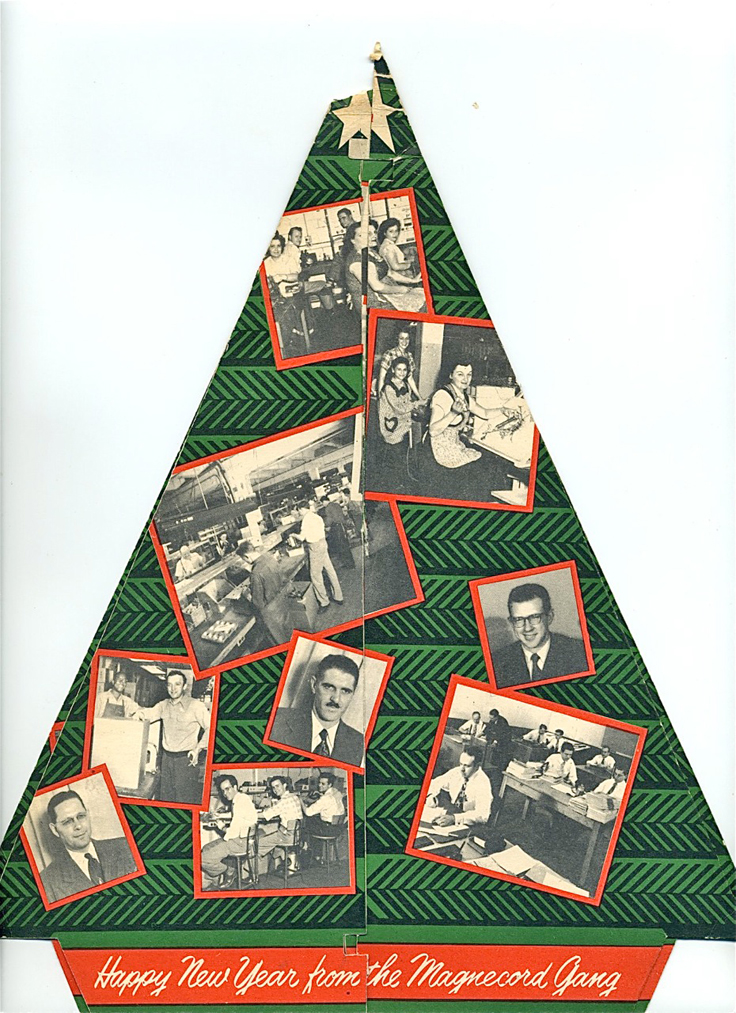
Magnecords at Radio Free Europe

|
| |
Marantz 
Marantz/Superscope Technologies
1508 Batavia Avenue,
Geneva, IL 60134
Saul B. Marantz was fascinated by electronics from his boyhood days in Brooklyn. His passion for music led to his first attempts at building audio components in the 1950's.
In 1964, Marantz was sold to Superscope Inc. and has since passed through several hands.
After the sale to Superscope, Marantz stayed as president until 1968 and then retired -- briefly.
In 1972, he co-founded the Dahlquist Company, a maker of high-quality loudspeakers, serving as president until his second retirement in 1978.
Superscope pursued a strategy of marketing Marantz as a premiere brand of quality consumer audio products, and Superscope consumer audio products as its budget line "made by Marantz."
By the 1980s, the company then changed its name from Superscope Inc. to the Marantz Company.
In 1987 the Marantz Company was purchased by Dynascan Corporation (today's Cobra Electronics Corp).
By 1990, Cobra had sold the Marantz brand to Philips Electronics.
In 1993, Superscope Technologies, Inc. was formed by acquiring rights to the Superscope brand and distribution rights for Marantz Professional audio products.
It looks as though Marantz was looking to enter the reel to reel market just as it was winding down.
Year 1978
$2500.00 (as reported in the
May 1979 Stereo Review)
 |
Dual-capstan transport Reel to Reel, Full logic, live switching from any mode to any other mode
Heads - 6, two 4-track record, two 4-track play, two 2-track erase
3 3/4, 7 1/2, and 15 ips
Reel switch Electronic, 7 or 10 inch settings |
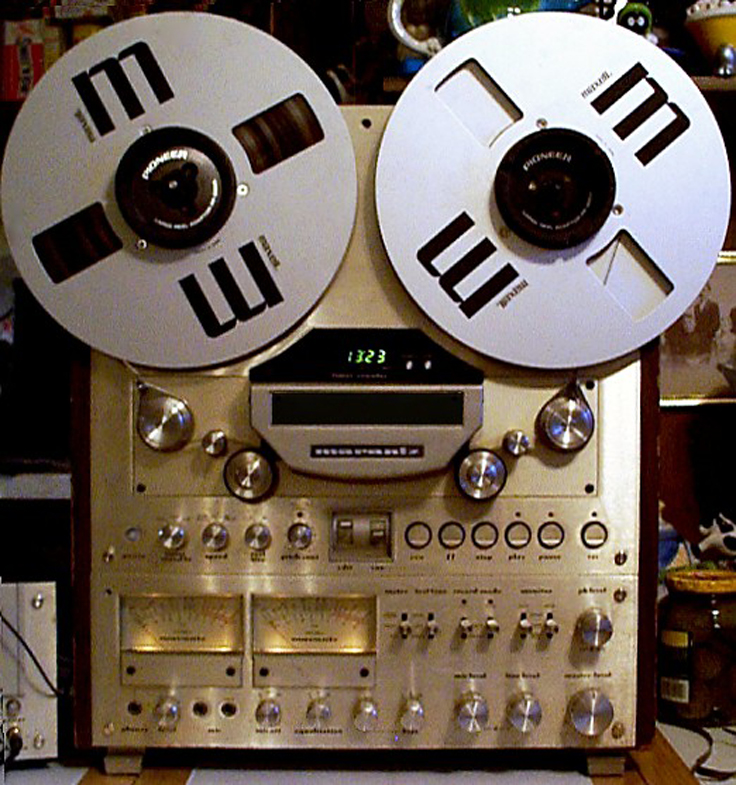
As this unit appears to be a a one-off production, a Marantz special project, we may never know what the specifications were supposed to be. |
The P at the end of the serial number probably means "Prototype". If I learn of any production units (or other prototypes), I will add that information here.
All I know for sure is, it sounds great, and it mates with my other gear perfectly both sonically and visually. The find of a lifetime!
Contributed by Ben
on February 7th, 2001
- ClassicAudio.com |
This is a couple of photos of the Marantz 7700 reel tape recorder built in 1978. It was reviewed in the April 1979 Stereo Review - "...with impressively smooth tape handling, three speeds, and a comprehensive array of controls for bias and equalization, servicing adjustments, and editing.".
|
| |
Nagra 
The Kudelski company was founded in 1951 by Mr. Stefan Kudelski. Born in Warsaw, Poland on February 27th 1929 where he completed
his primary schooling. In 1939 the declaration of war in Europe saw the Kudelski family flee to Hungary, then France and finally Switzerland in 1943.
In 1951, his prized invention, the “NAGRA” (meaning “will record” in Polish) takes a concrete form: a portable audio tape recorder with exceptional specifications, i.e. light, small, self-contained, portable and high quality.
In 1952 the first customers, Radio Lausanne and Radio Geneva placed official orders for the NAGRA I.
In May 1952, following the first international sound recording contest, some well-known reporters become interested in the NAGRA.
Stefan Kudelski then obtains a firm order for six NAGRA 1’s from Radio Luxembourg.
He leaves the EPUL where he was studying electrical engineering and devotes himself to the manufacture of his machines.
Assembly of such equipment meets many obstacles. Parts ordered elsewhere often arrive late, or do not meet the required specifications and the customers are always in a hurry. As a result, as many parts as possible for the new NAGRA II were to be made by the company.
Production of the NAGRA II began in 1953.
The NAGRA II is quite sophisticated, driven by a Grammophon spring from language laboratory equipment , and with excellent subjective and audio quality. The recorder is extremely sturdy; No advertising is needed, every day new reporters become acquainted with the machine and immediately try to buy one.
The manufacturing was done at a house in Prilly (West of Lausanne) where a small staff were employed by the Kudelski company, listed in the trade register of the city of Lausanne in 1953.
Improvements are in the making; towards the end of 1954 a printed circuit board is mounted in the NAGRA II and the microphone jacks are standardized. By the end of 1953 eleven employees work full-time.
By 1956 this number has risen to 17.
Although the NAGRA II has well served its purpose, it must be improved still further. A much better machine, with exceptional specifications in all respects has to be created; in 1957 this is done.
In 1958 the NAGRA III sees the light of day. It is a solid-state machine employing an electric motor with closed loop servo speed control. It is a fully transistorized machine with all the modules enclosed in metal cases. It is powered by conventional “D” type batteries. Moreover, it is equipped with a true peak meter called a “Modulometer” . Orders come flooding in and 240 NAGRA III machines are completed in 1958.
The NAGRA III was becoming a standard in many different industries. The system “PILOTTON” for lip synchronization of audio recordings with moving pictures, made good results possible, but a better system was needed.
Stefan Kudelski invented the “NEOPILOT” system, and the first NAGRA III machines equipped with the system were sold in 1962.
Commercial motion pictures were traditionally filmed using a dual system, that is picture on photographic film in the camera, and sound on a magnetic tape recorder. Neopilot was the standard synchronization system used to synchronize these separate elements until the late 1980s, when time code became the preferred standard. Nagra used a special, very narrow time code track in between the space of channel 1 and channel 2 on the stereo Nagra IV-S and T models.
Success of the NAGRA III was huge, and delivery times were between 6 and 8 months. Production has to be increased continually.
In 1964 office space and manufacturing space is rented in Renens, then in 1965 in Malley. At the end of the year a factory in Neuchâtel
is purchased. A vast piece of ground is purchased in Cheseaux-sur-Lausanne, for the construction of a dedicated factory. In 1967 the 10’000th NAGRA III is celebrated.
In early 1969 the NAGRA III is replaced by a more efficient machine: the NAGRA IV and 2510 machines are built in 1969.
In 1970 the NAGRA 4.2 was introduced to replace the NAGRA IV. It once again offered improvements on its predecessor with new features and better audio performance.
In the same year the IV-S was introduced. A Stereo machine destined towards the music industry, allowing musical performances to be captured in Stereo in a portable format.
The NAGRA SNS was also introduced in the same year. This half-track slow speed version of the SNN became a standard tool with law enforcement agencies around the globe.
In 1974 a new extra lightweight recorder, the IS, for broadcasters was introduced. The IS was followed in 1976 by the NAGRA-E which was a single microphone input, single speed recorder for reporters.
In 1977 the SNST a stereo version of the successful SNS machine for the security industry was also developed.
1977 also saw the introduction of the NAGRAFAX.
1978 saw the introduction of a sophisticated instrumentation recorder, the NAGRA TI
In 1979 the T-RVR (Remote Voice Recorder) was built. The capstan-less machine was designed as a logging recorder for radio broadcast transmission logging as well as telephone lines.
In 1983 the Kudelski company entered into a commercial joint venture with the AMPEX corporation of America, with the aim of building the worlds smallest, lightest professional portable C-format video recorder. The development and construction was entirely completed in Cheseaux. The resulting machine was baptised the AMPEX-NAGRA VPR-5. Using rotary head technology and the state-of-the art SMD (Surface Mount Devices), the project came to fruition and great leaps in technology were achieved.
AMPEX ordered 100 machines, which were to be used to cover the Mexico World Cup in 1986.
The JBR security recorder was introduced in 1984 with the aim of replacing the ageing SNST technology with a smaller, undetectable covert recorder for the security industry.
In 1984 the IV-S was adapted to accept the SMPTE / EBU time code system for motion picture synchronization previously only used in video recorders, and the IVS-TC was born. In 1985 the NAGRA T-AUDIO was also adapted to this new universal synchronization format. It became the most sophisticated transfer machine ever built and was to be found in post-production facilities all over the world.
1992 saw the return to the traditional location sound acquisition with the introduction of the company’s first digital audio recorder the NAGRA-D.
After those units Nagra went digital and tapeless.
|
| |
Otari 
Otari, Inc. International Division
4-29-18, Minami, Ogikubo, Suginami-ku, Tokyo, 167-0052 Japan
Not to be confused with retro video game maker Atari, Otari manufactures professional audio equipment. The company's products are used in the music recording, broadcasting, film production, and live music industries. Otari audio products include analog recorders, digital recorders, and mixing consoles. Its industrial products include cassette and CD duplication systems, digital archiving systems, and sample rate converters. Otari products are sold across Africa, Asia, Europe, and the Middle East. The company also has distributors in California, Australia, and New Zealand. Otari was founded in Tokyo in 1965
June 1 1974 Billboard - Masayuki Hosoda 39 (10 years as a Teac engineer) founded Otari Corp in 1964. He & Mitsuo Takekawa 48 created Otari Corp in the US which is the company's first foreign subsidiary. Takekawa will head the US subsidiary. Brian Trankle (Ampex 17 years) is marketing Manager. San Carlos, CA
Hosoda has seen his company in Japan grow from 4 employees to the present 200 in three factories and one HQ building. Sales of $5 million in 1974. Otari got its name from Hosodas father because it is a village in the so-called Japanese Alps where senior Hosoda lived.
We contacted Otari to obtain more information and received the following response.
From: T. Hora <hora@otari.co.jp>
Subject: Re: Otari History Resources
Date: March 22, 2012 7:55:03 PM CDT
Dear Sir,
We are proud as last producer of professional tape recorder.
And we still can manufacture MX-5050 according to the inquiries.
Now, regarding to our history, we will send it when finding it.
Best regards
T. Hora - "Otari History Resources" において、
We also contacted the US distributor who advised they had 5 units in stock @ $7900.00 each.
Otari is the only company still manufacturing reel tape recorders. The MX-5050 is available on request from this link http://www.otari.com/product/recorder/mx5050/index.html
|
| |
Pentron 
Pentron Corporation, 777 S. Tripp Ave., Chicago, IL
1948 -1961 No further information found about Pentron's history.
|
| |
Philips 
In 1891 Anton and Gerard Philips established Philips & Co. in Eindhoven, the Netherlands
The company begun manufacturing carbon-filament lamps
By 1910, with 2,000 employees, Philips was the largest single employer in The Netherlands
In 1918, Philips introduced a medical X-ray tube.
In 1925, Philips became involved in the first experiments in television and, in 1927, began producing radios. By 1932, Philips had sold one million of them
By 1939, when it launched the first Philips electric shaver, the company employed 45,000 people worldwide.
From the early 1940s, Philco was legally able to prevent Philips from using the name "Philips" on any products marketed in the USA, because the two names were judged to sound similar. As a result, Philips instead used the name Norelco, an acronym for "North American Philips [electrical] Company."
Philips continued to use that name for all their US products until 1974, when Philips purchased The Magnavox Company. Philips then relabeled their US consumer electronics products to the Magnavox name, but retained the Norelco name for their other US products.
When Philips bought Philco in 1981, Philips was able to freely use the Philips name for all of their US products, but they chose to retain the Norelco name for personal care appliances, and the Magnavox name for economy-priced consumer electronics.
Other milestones: In 1963, Philips introduced the Compact Audio Cassette.
In 1965, it produced its first integrated circuits.
In 1972, the company co-founded PolyGram (Philips 60% and Siemens 40%), the enormously successful music recording label.
In 1974, it acquired Magnavox and in 1975, Signetic,both in the United States.
In 1983 Philips came with a technological landmark: the launch of the Compact Disc.
There was no mention of the production of reel tape recorders in the on line Philips history summaries.
|
| |
Pioneer 
PIONEER CORPORATION, 1-1, Shin-ogura, Saiwai-ku, Kawasaki-shi, Kanagawa 212-0031, Japan
Nozomu Matsumoto founded Pioneer as an audio products manufacturer in 1938, making speakers in his garage.
Nozomu Matsumoto - 1905–1988) was a Japanese businessman who was the founder of the Pioneer Corporation. He was born in Kobe, Japan in 1905, the son of a Christian missionary.
In 1936, he founded the Fukuin Shokai Denki Seisakusho company in Osaka, whose name roughly translates to "Blessed Sound Electric Company" or "Gospel Electric Company", owing to Matsumoto's Christian faith and belief that his electronic products could help in missionary works.
In 1937 he created the A-8 speaker which he christened 'Pioneer'.
Matsumoto relocated to Tokyo in 1938 and started a small factory which repaired radios and speakers. After the war the company expanded rapidly and in 1961 the name was changed to Pioneer Electronic Corporation, and it was listed on the Tokyo Stock Exchange.
In 1966, Pioneer which was created 30 years ago, created Pioneer Electronics USA Corp at 350 Fifth Ave NY and will continue
marketing its car stereo players through Craig-Panorama
Pioneer opened its first office in the United States in the Empire State Building in 1972.
Matsumoto died in 1988 at the age of 83.
Today Pioneer is a world leader in electronics products for the car, home and business markets, respected for their role in introducing such innovations as consumer laser disc (1979), car CD player (1984), GPS car navigation (1990), DVD-Video player (1996), high definition plasma display (1997) and organic electroluminscent (OEL) display (1997).
To this day, Pioneer still develops and manufactures innovative and high-tech entertainment and electronic products.
|
| |

Not to be confused with National Presto, founded in1905 manufacturing pressure canners.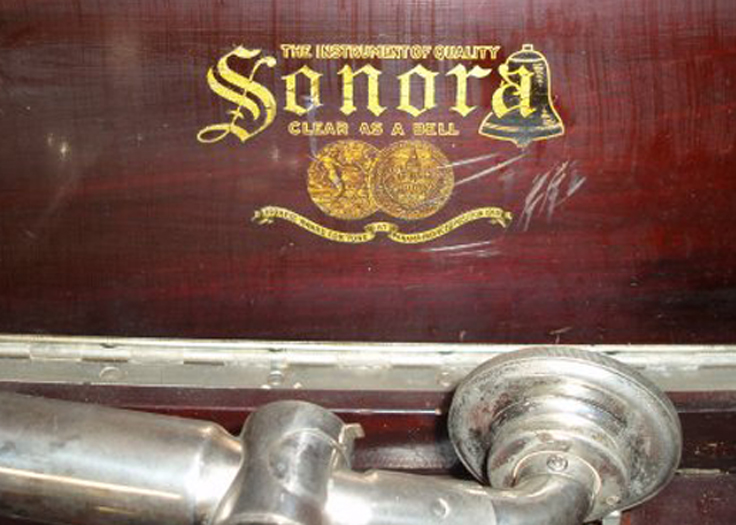
The Presto Products Company was founded in 1915 producing disc recorders and the Sonora phonograph.
Back around 1910, many companies were trying to get into the manufacturing and selling of one of the hottest items on the market, the phonograph. One of these companies was Sonora, which used "Clear as a Bell" as its slogan, touting the fidelity of its machine's sound reproduction.
The Sonora Chime Company was reincorporated in February of 1913 as the Sonora Phonograph Company by its founder George Brightson. It was located at 78 Reade St., New York City.
 An earlier attempt by the Sonora Phonograph Company in 1909 to sell horns and hornless machines made by a Swiss company named Paillard had run into legal problems and went nowhere. Paillard at that time was also a major manufacturer of music boxes. Sonora Phonograph factory Saginaw, MI (left photo from Antique Radio Forums). An earlier attempt by the Sonora Phonograph Company in 1909 to sell horns and hornless machines made by a Swiss company named Paillard had run into legal problems and went nowhere. Paillard at that time was also a major manufacturer of music boxes. Sonora Phonograph factory Saginaw, MI (left photo from Antique Radio Forums).
A company named Presto Products produced the Sonora phonographs. Sonora also bought thousands of its phonograph motors from a Swiss Company named Bawdy.
Sonora was one of the companies that were allowed to exist by the big three (Victor, Edison and Columbia) to avoid threats of a trust suit. Because Sonora had paid a lot of money in royalties on patents held by the big three on a per unit basis, it could only compete with them on their high-end machines.
In fact, Sonora ads say, "The Highest Class Talking Machine in the World." The prices ranged from $60 to $2,500. The hardware varied from unit to unit indicating that they were most likely made by various manufactures. The fancy cabinets were Sonora's best selling point, along with its "award-winning magnificent, pure, clear, rich mellow tone." In 1915, the Sonora Phonograph Company won the award for tone at the Panama Pacific Exposition.
Sometime in the middle of 1919, the Sonora Phonograph Company opened an assembly factory in Saginaw, Michigan, and the company headquarters was moved there in the summer of 1927. At that time, Michigan was the center of cabinet production, especially in the Grand Rapids area. Sonora at this time also had a branch in Oakland, California, that later became Magnavox. Sonora went out of business in 1932, and emerged later as the Duall Company in 1932, and became Presto Recording Corp. in 1933. The company was incorporated in New York in 1934 by Morris Gruber, George Saliba, Aaron Benjamin, and Mr. Sholes (Mr. Benjamin's son-in-law).
Here's a bit more from Alan C Graves.
PRESTO's most important contribution to the world of Broadcasting and Recording was the lacquer coated instantaneous recording disc. PRESTO was one of three companies to have developed versions of this disc - the others were in France and England - and the PRESTO version was introduced to the US in the fall of 1934, after several years of experimentation.
The disc consisted of an aluminum plate coated with a cellulose nitrate based lacquer (not "acetate"), and offered dramatic improvement over embossing uncoated aluminum and pre-grooved plastic discs formerly used for instantaneous recording. While those systems had been patented, cutting a groove in a soft material was now in the Public Domain. It was a common industrial practice to coat aluminum with various substances. Thus the US Patent Office deemed that making and cutting lacquer blanks was nothing new, and thus unpatenable. This resulted in several companies making similar blanks soon after PRESTO introduced their disc.
The "PRESTO DISC" quickly became the industry standard, and by 1936 PRESTO recording equipment was being installed in stations nationwide. The PRESTO system was the foundation of NBC's Radio Recording Division, which began operation in the spring of 1935, and was also adopted by CBS when that network began its recording service in 1938.
While there have been refinements over the decades, the basic coated lacquer disc remained the industry standard for instantaneous recording, and is used to this day in the preparation of master discs for analog phono records. The development of the coated disc is a vital accomplishment in the technology of recorded sound, and PRESTO got the credit.
One of the earliest documented use of PRESTO recorders for delayed broadcast was of the Hindenburg disaster in May of 1937. Reporter Herb Morrision and engineer Charlie Nehlsen had been invited to record interviews of passengers embarking from the voyage. History tells of a different story. THE PRESTO HISTORY PAGE
Presto Recording Corporation was sold July 2, 1956 to Unitronics Corporation of Long Island City,NY.Six months earlier Unitronics had purchased the David Bogen Co. Presto was merged with the David Bogen Co., and became  the Bogen-Presto division (note the 1959 & 1960 ads below). Bogan manufactured 16 inch transcription turntables in the early 1930's and was one of the few competitors of Western Electric. Bogan and Presto had an earlier relationship importing and distributing phonographs from Europe. the Bogen-Presto division (note the 1959 & 1960 ads below). Bogan manufactured 16 inch transcription turntables in the early 1930's and was one of the few competitors of Western Electric. Bogan and Presto had an earlier relationship importing and distributing phonographs from Europe.
Presto Recording Corporation sold disk and reel to reel tape recorders to the radio and broadcast industry. Here are a few ads for their recorders.
1937
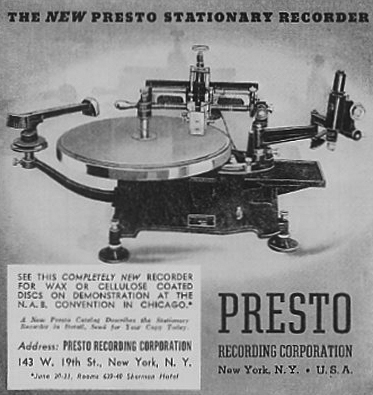
|
1938

|
1939
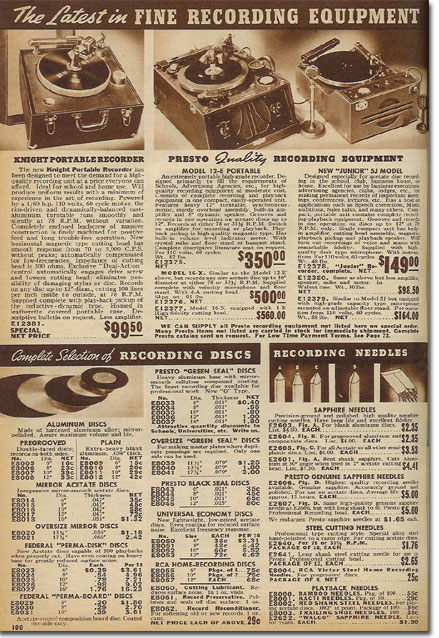 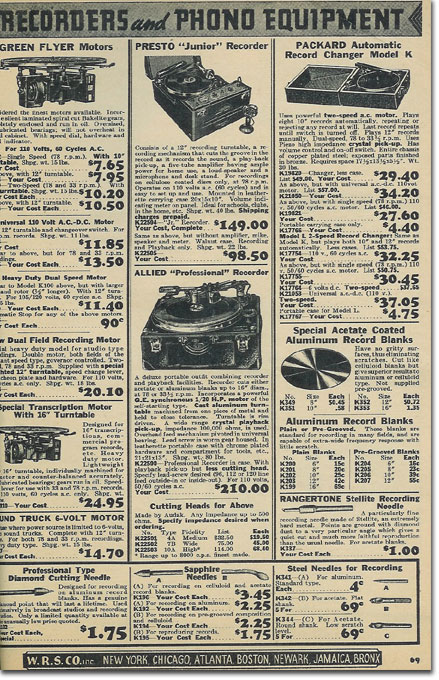
|
1940
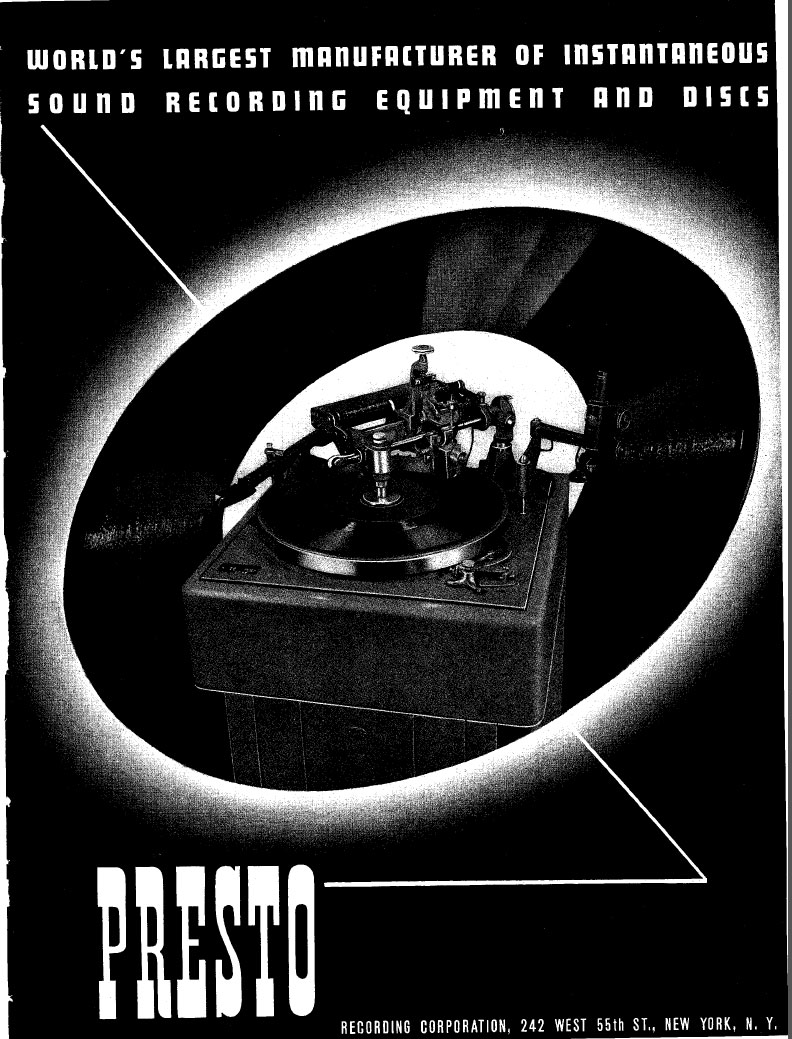 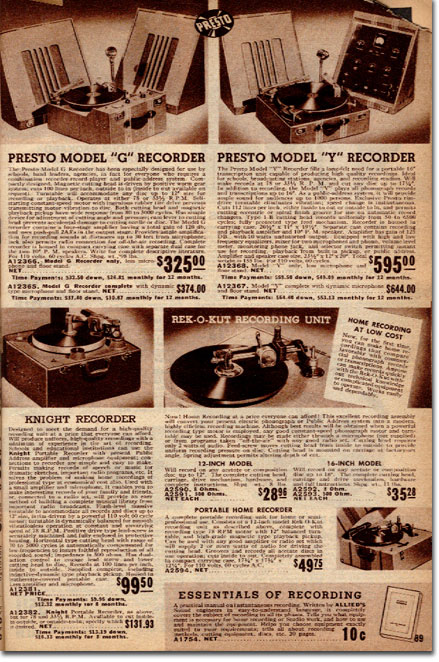
|
1942
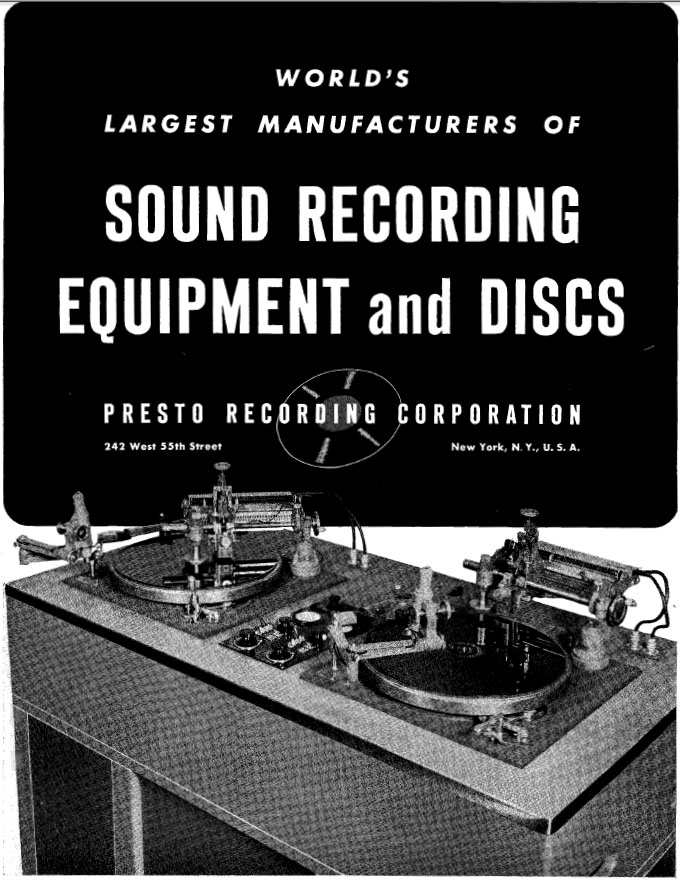
|
1946
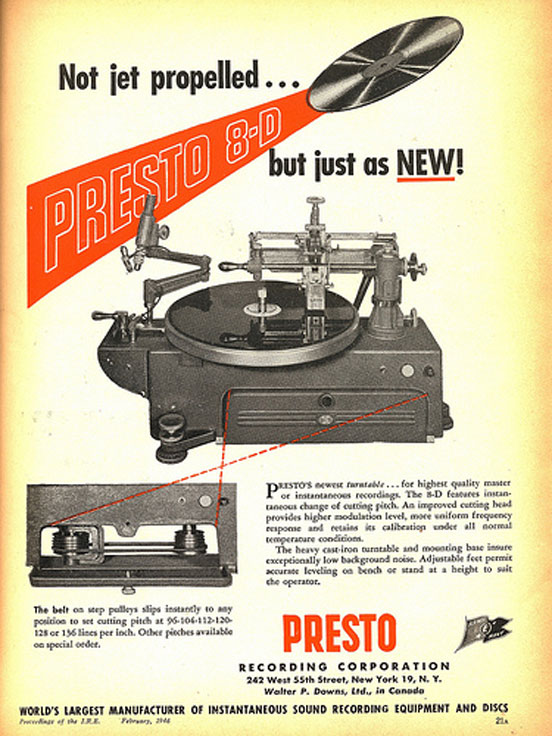
|
1947
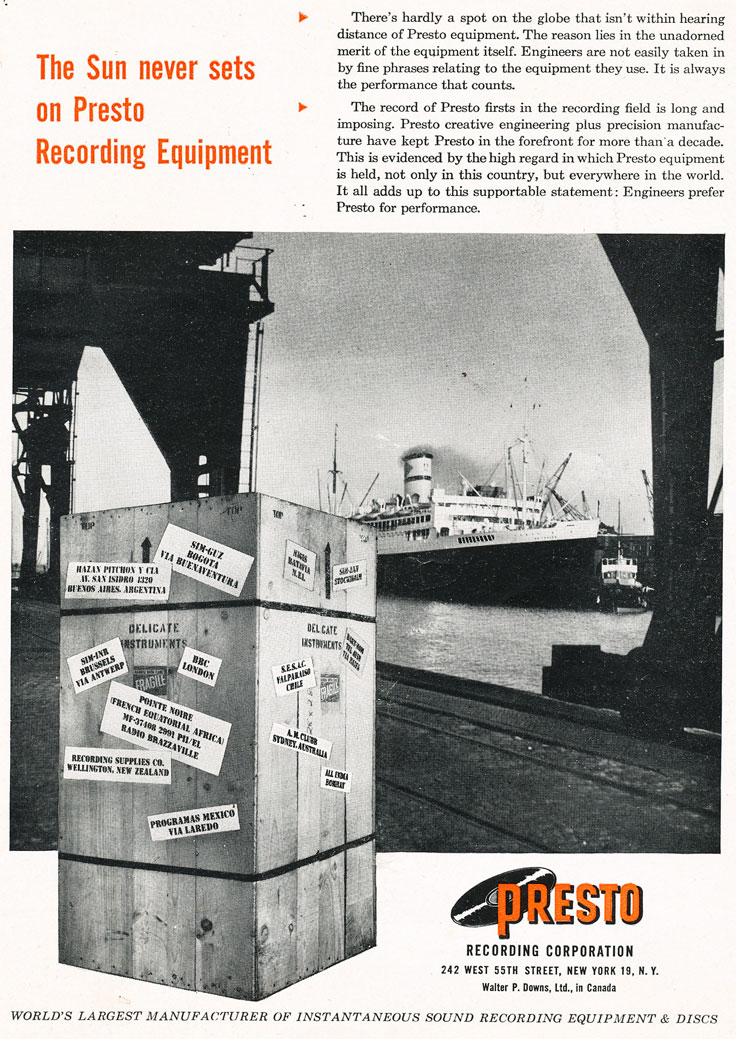
|
|
1948
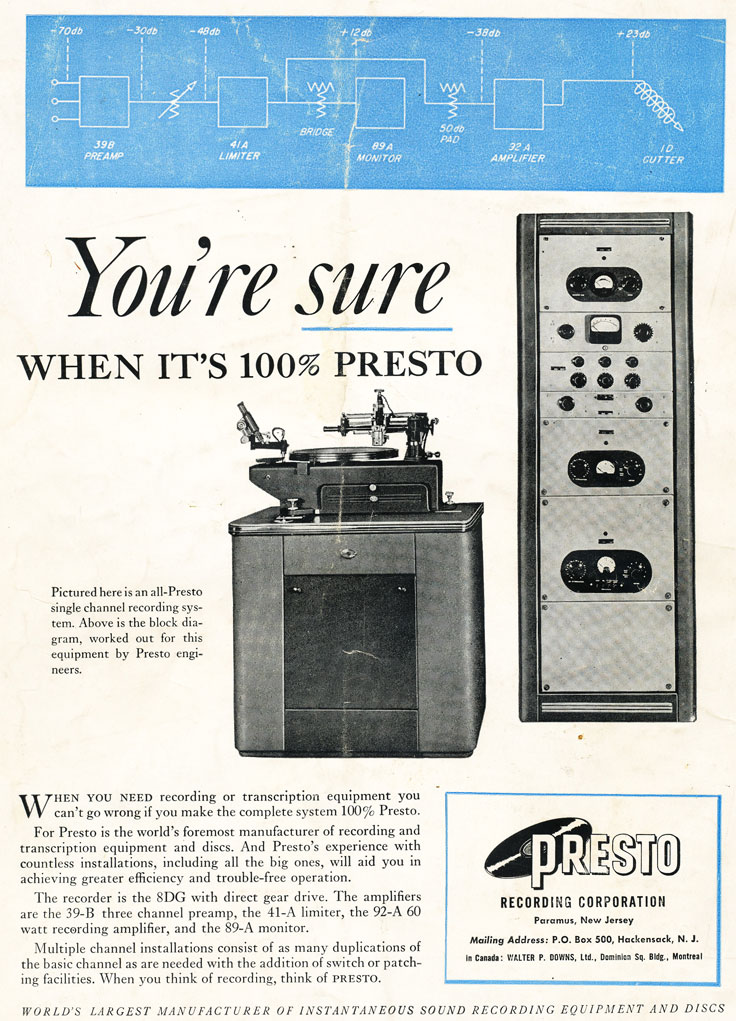 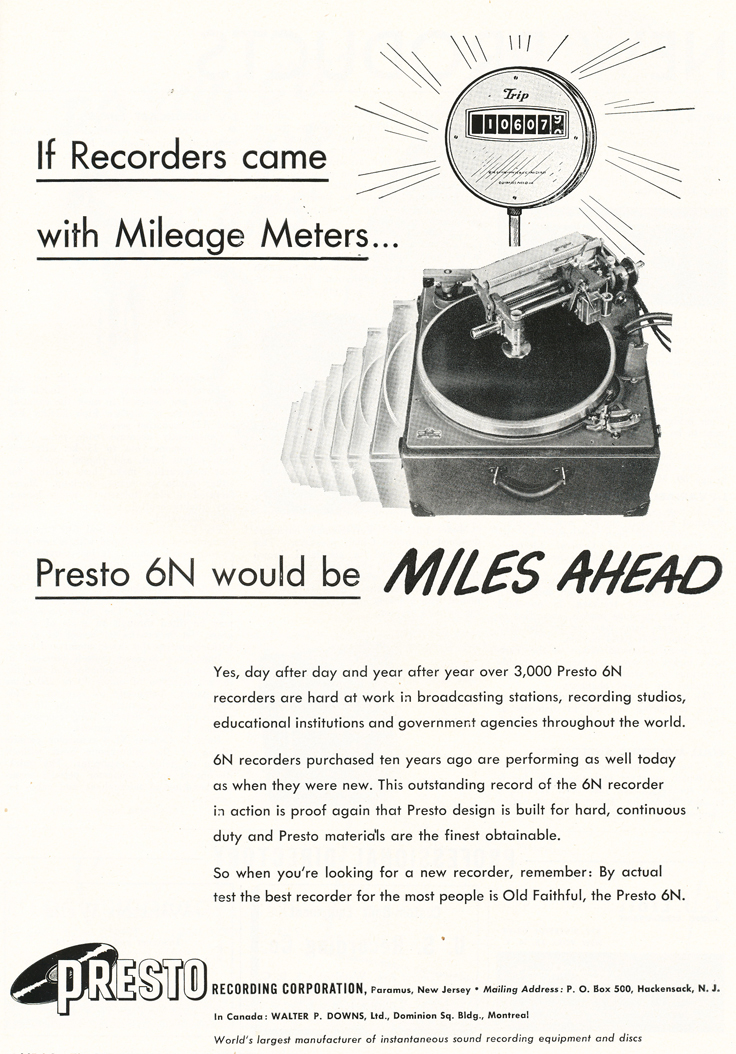 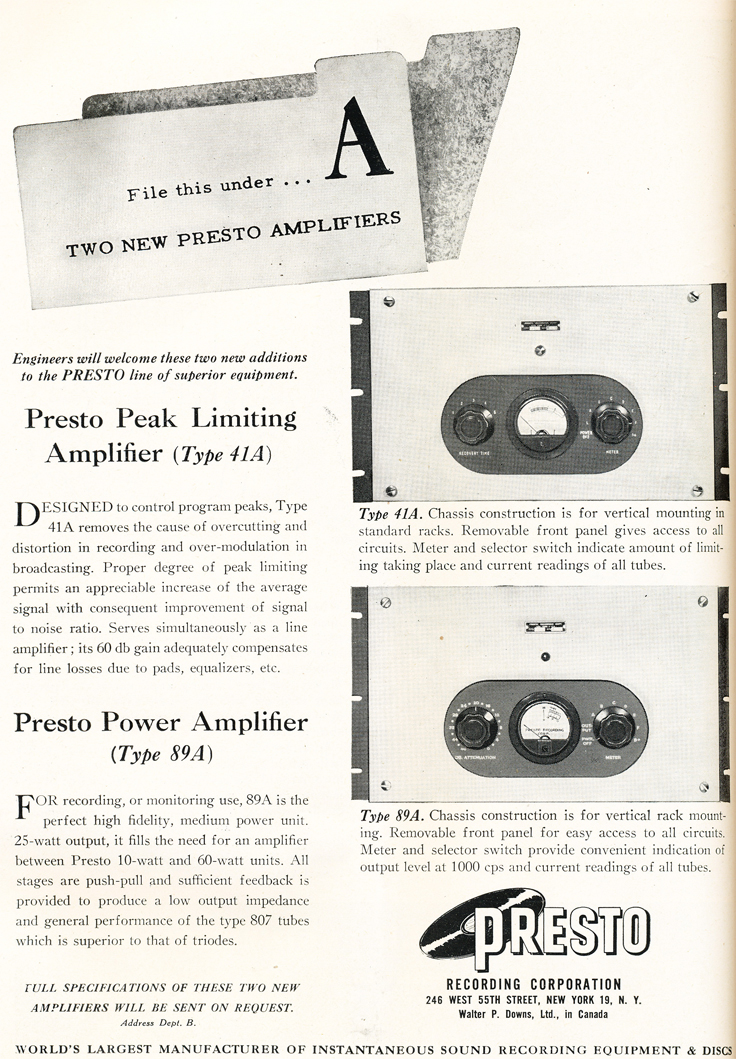 
1949
 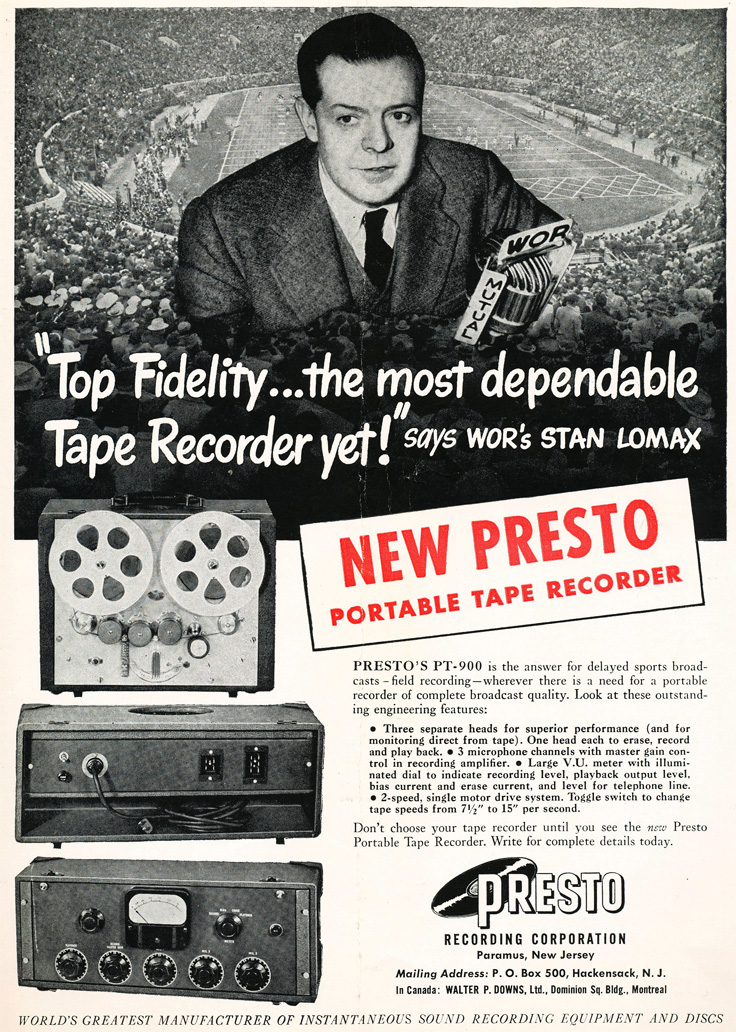  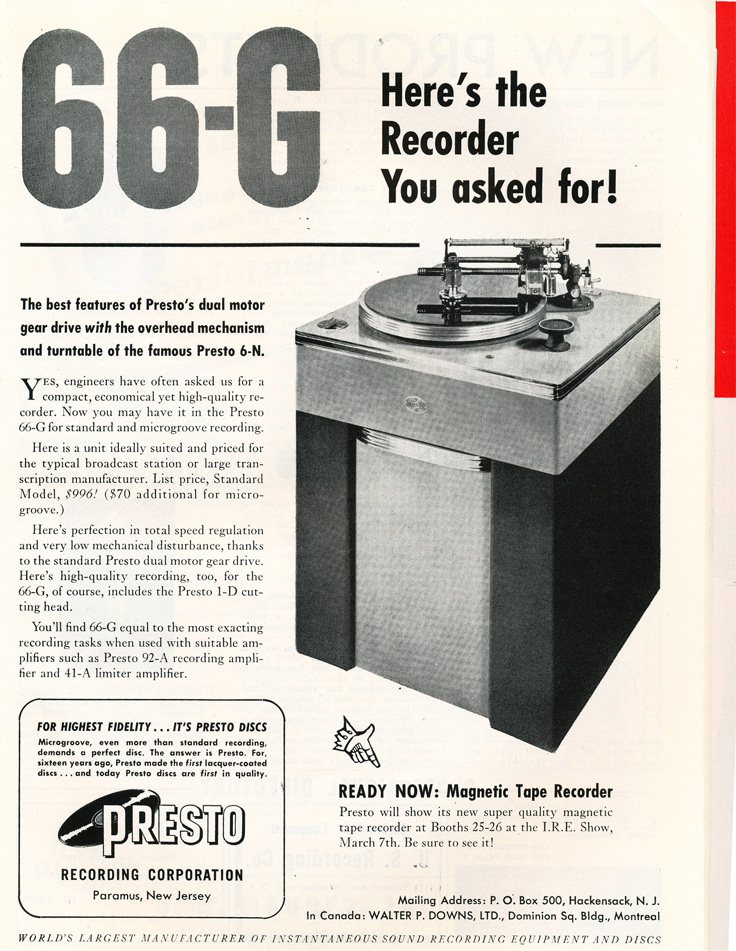
1950
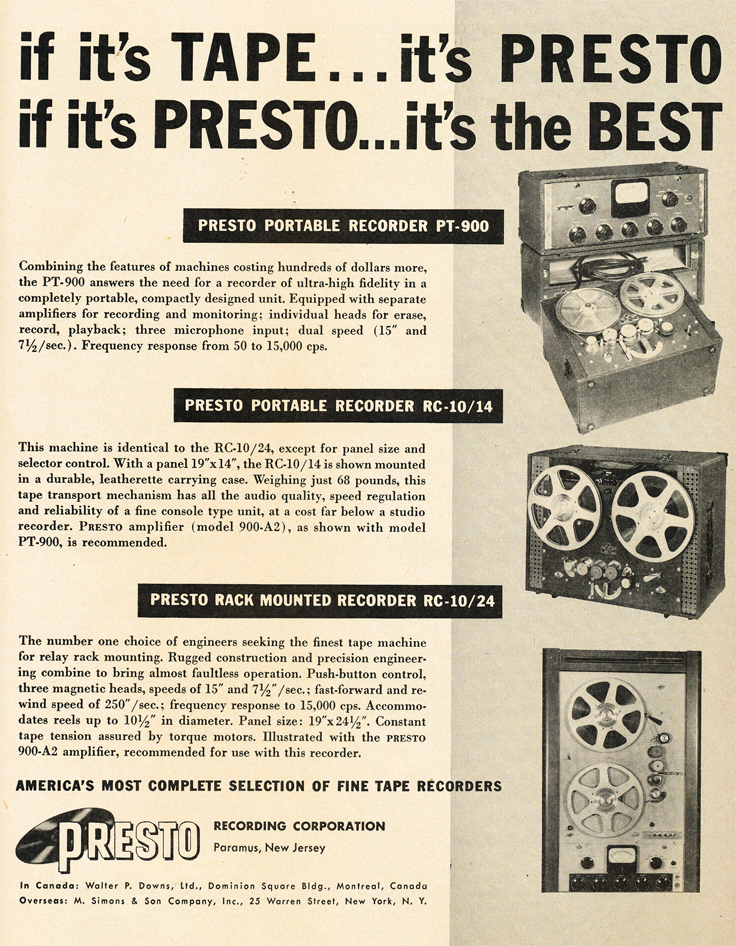  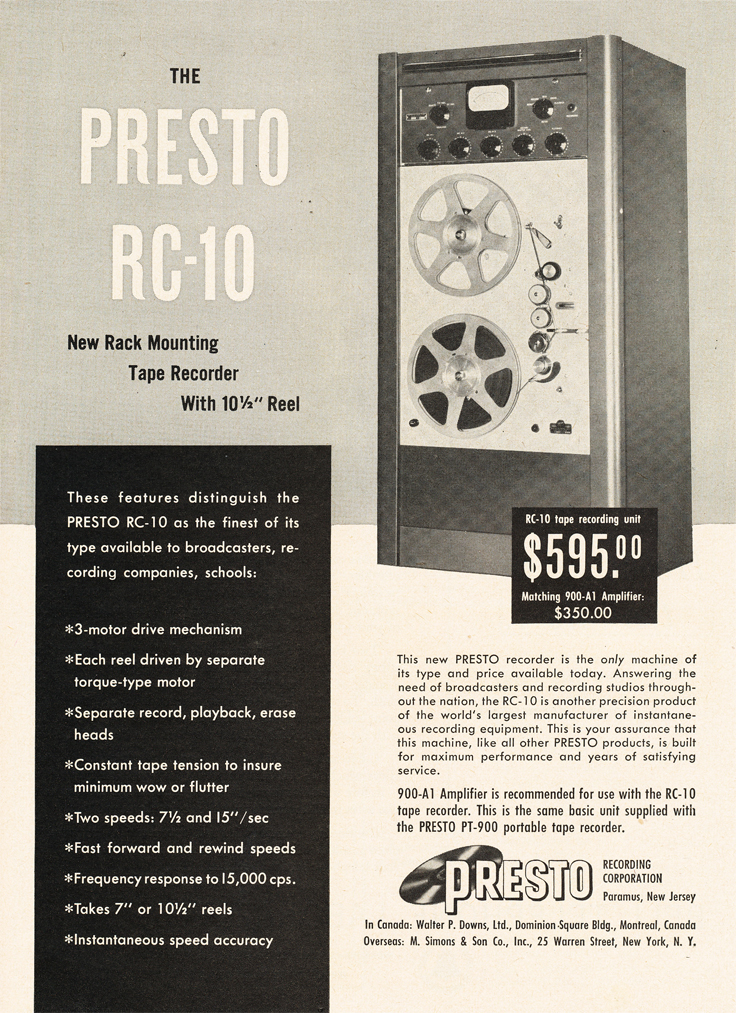 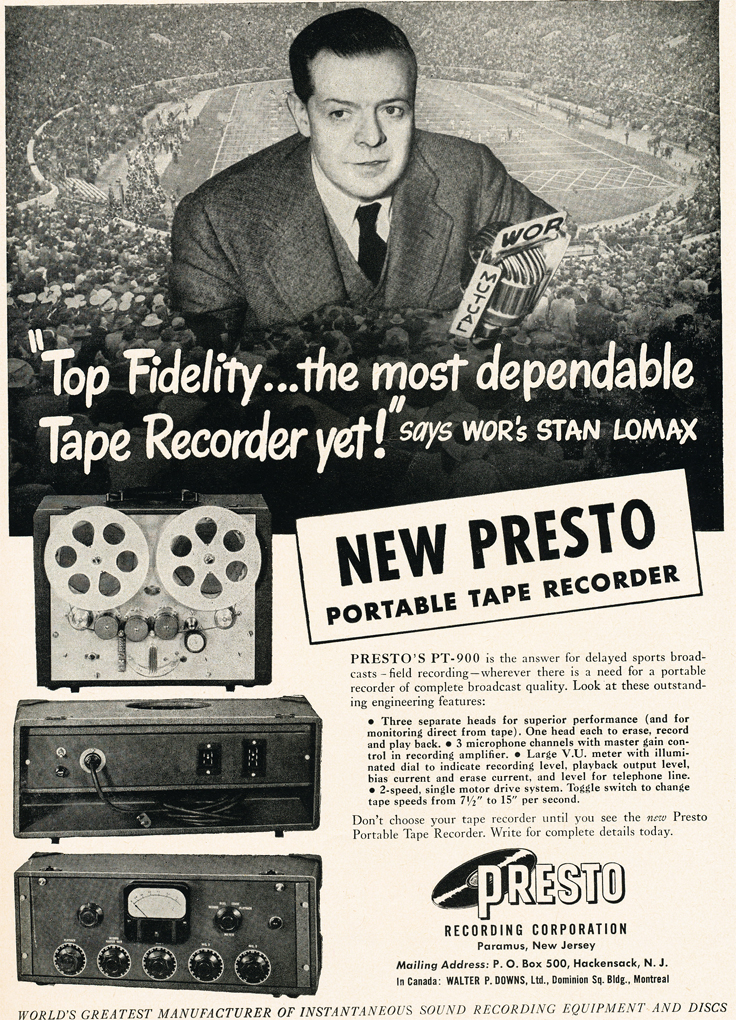  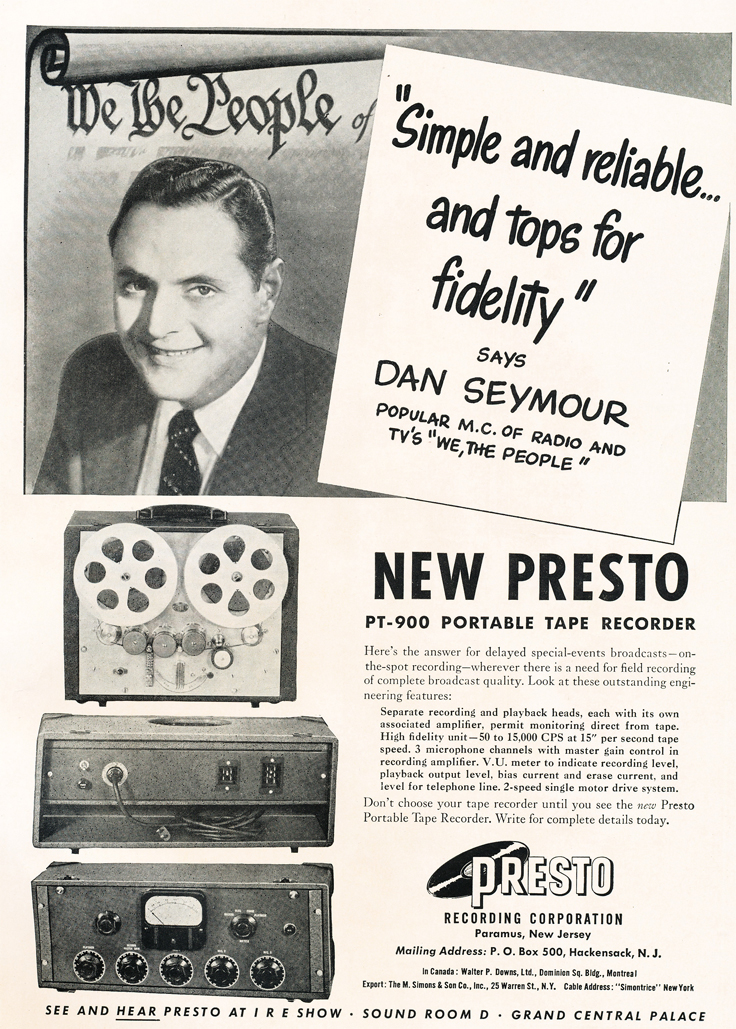
1951
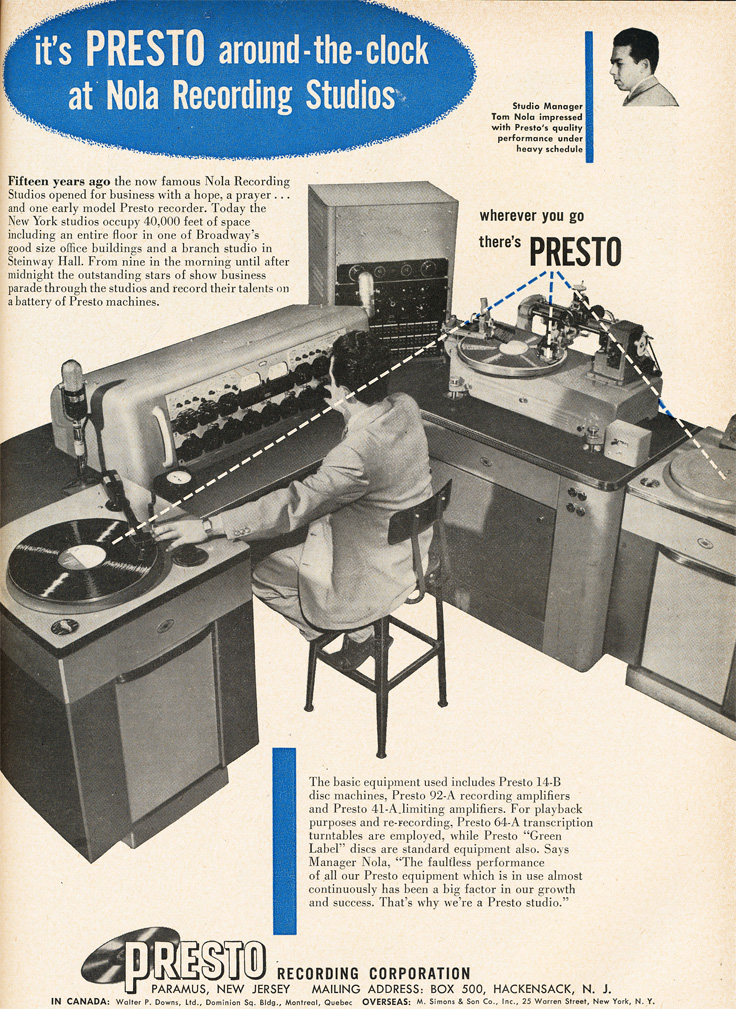 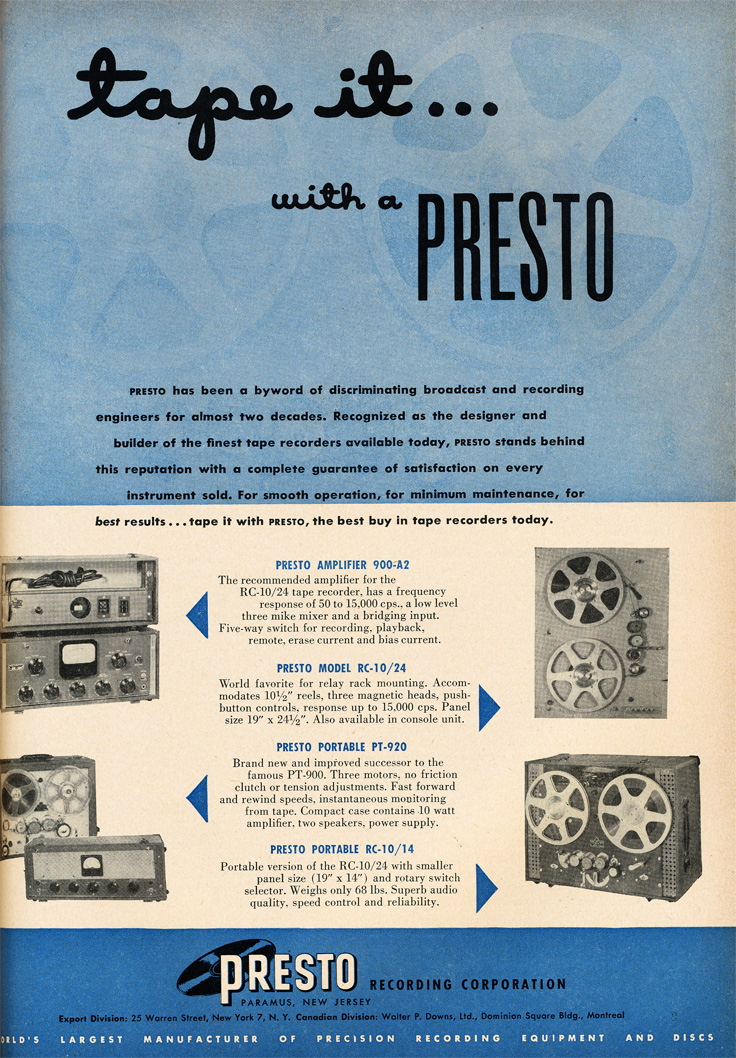  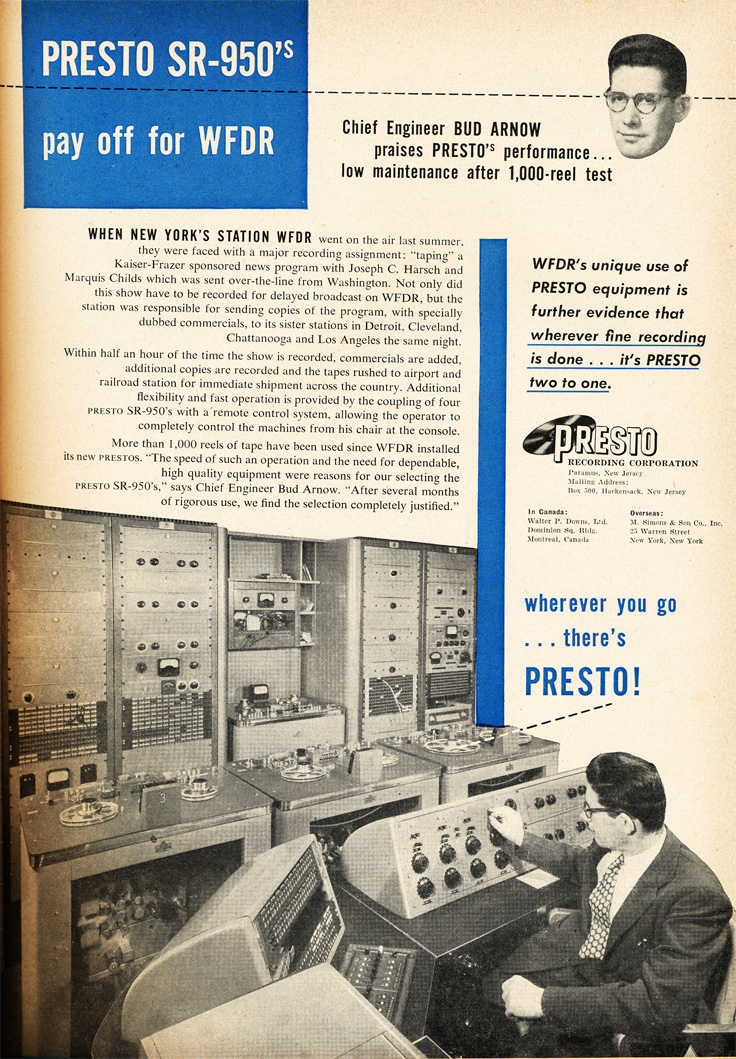 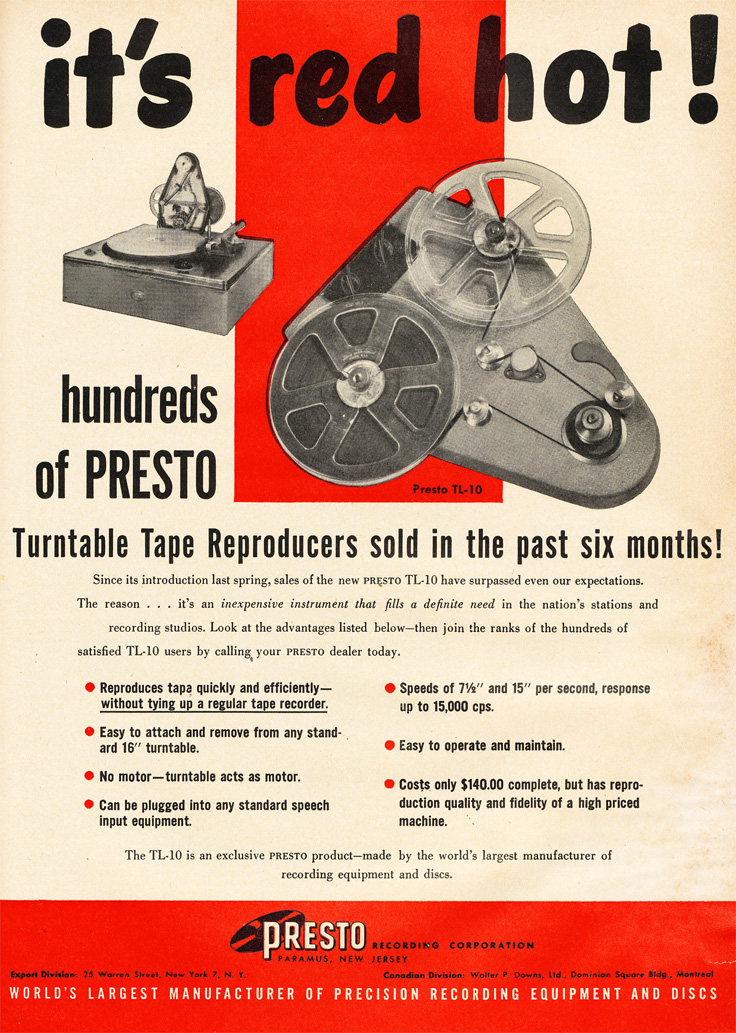
1952
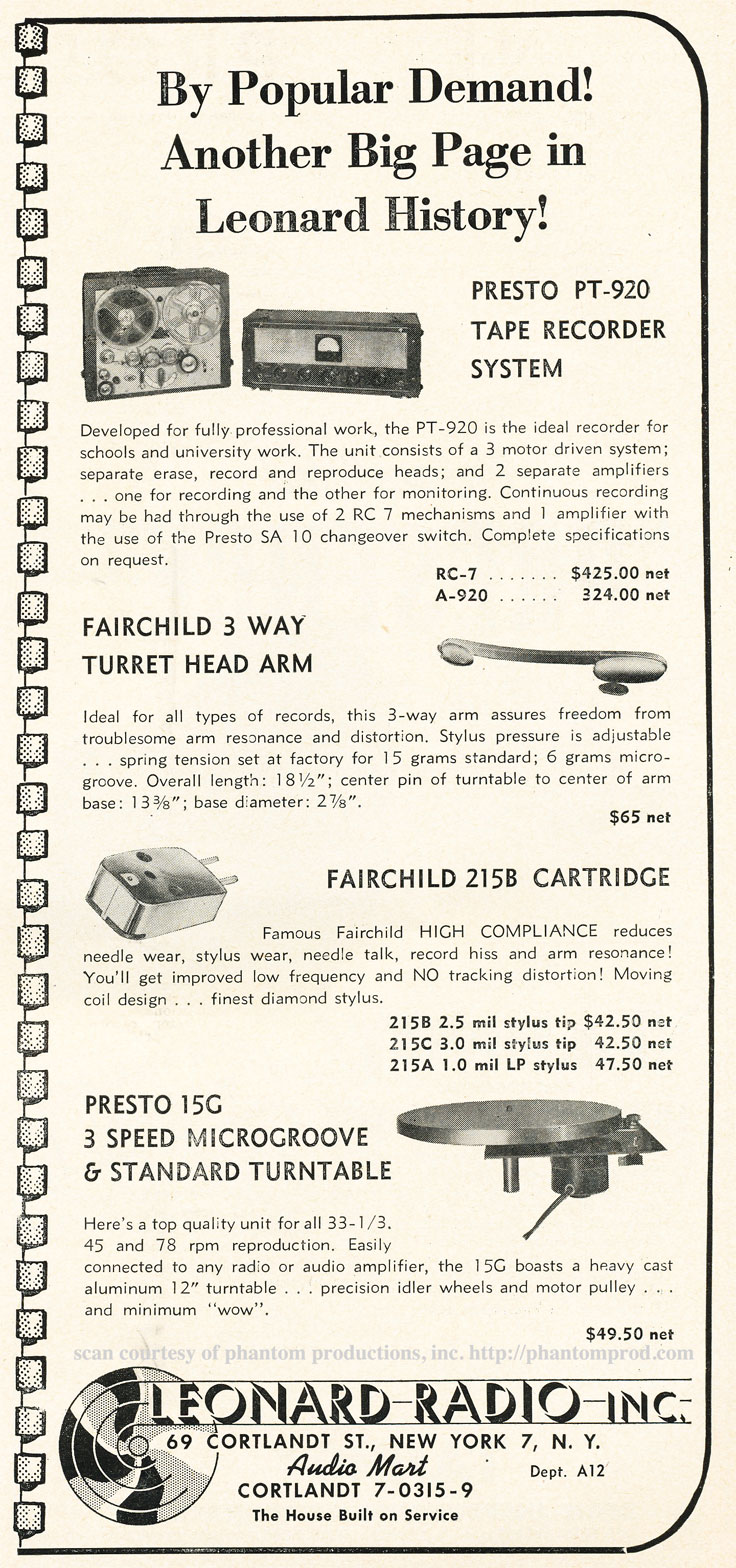 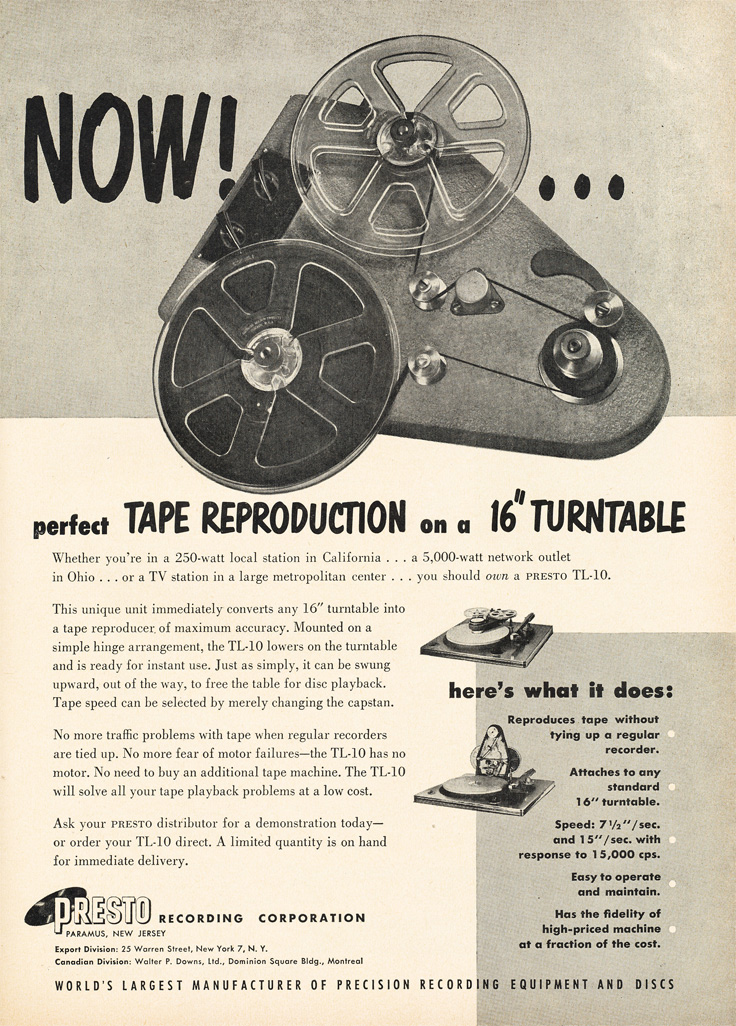  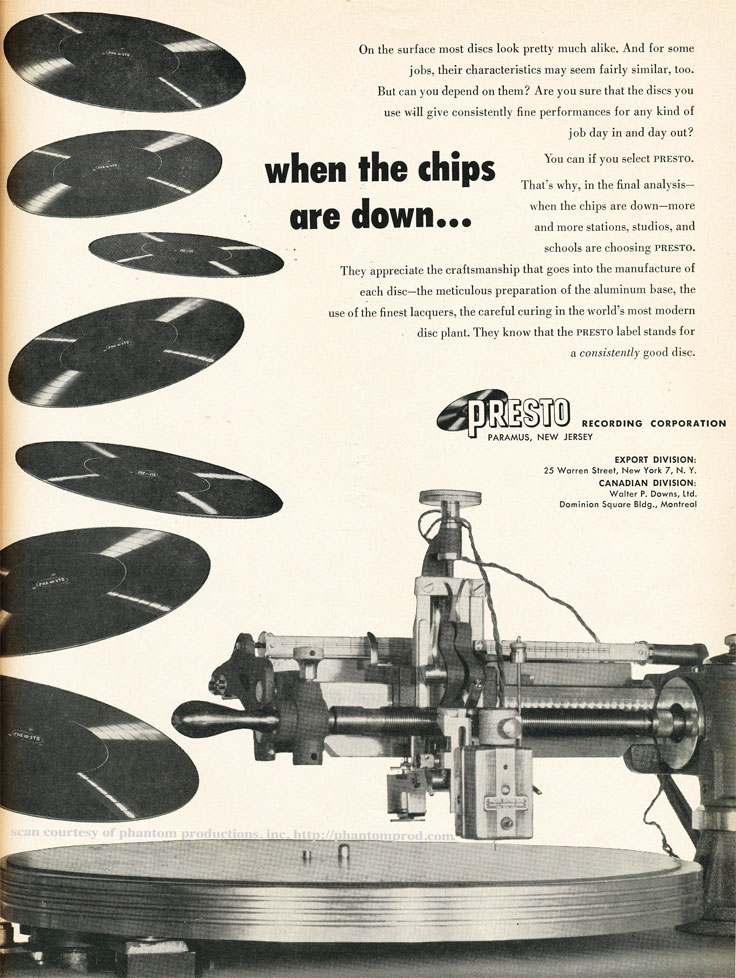
1953
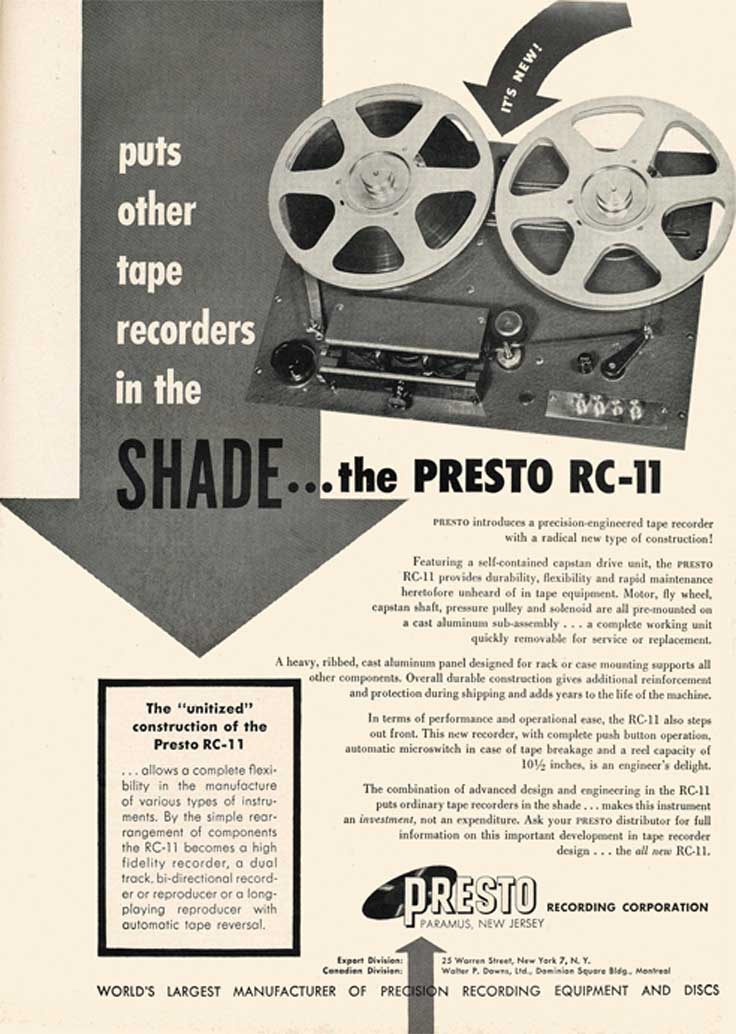 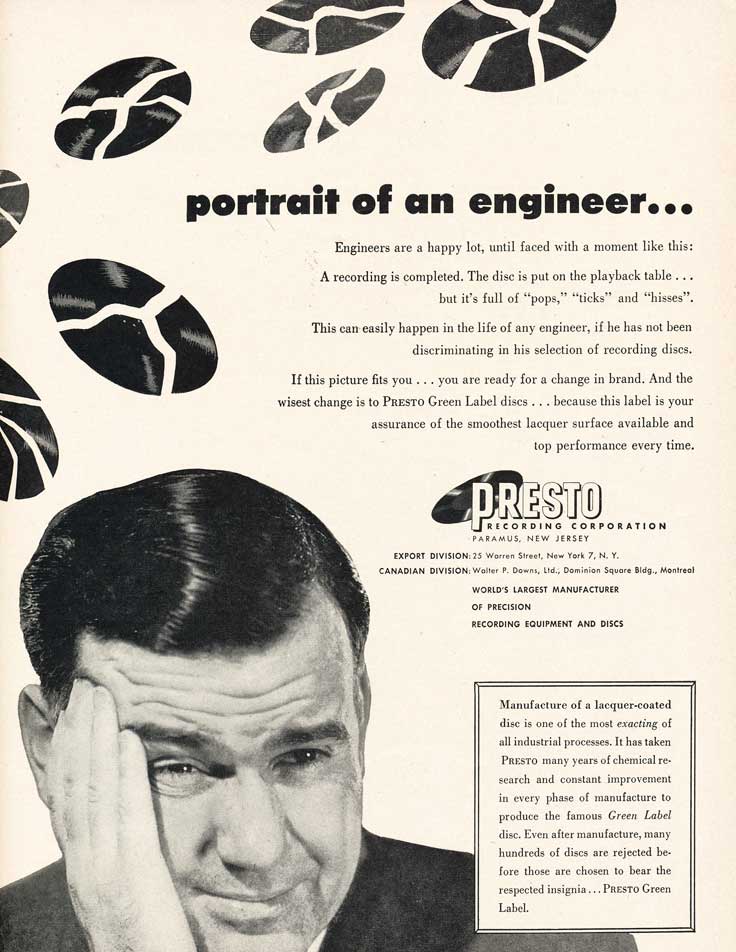 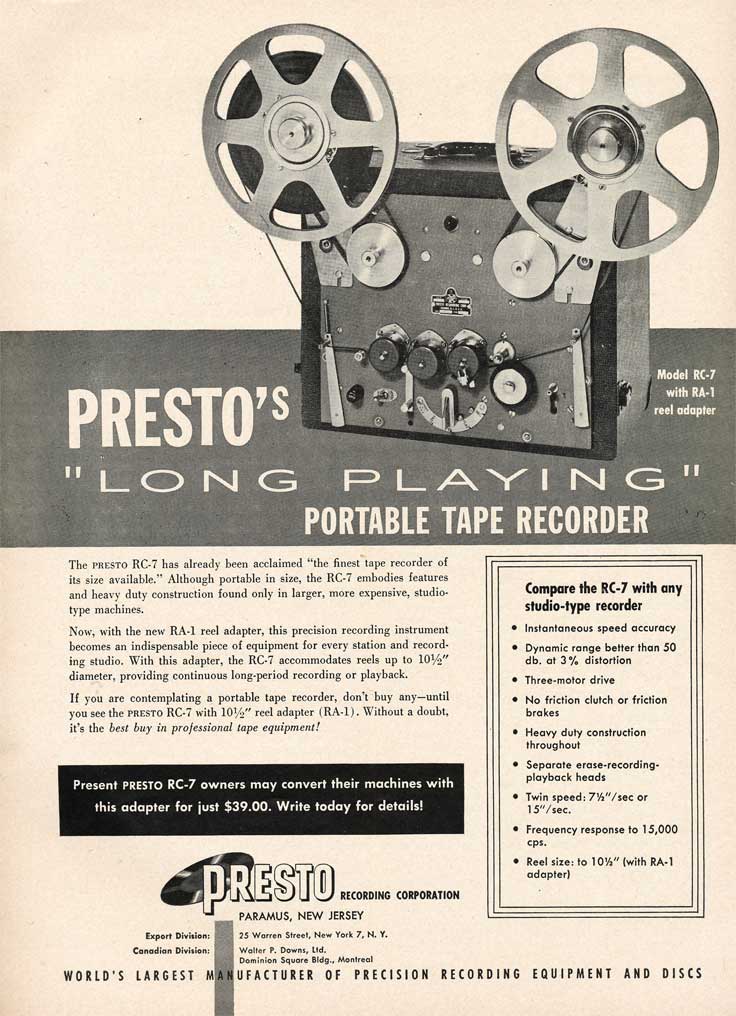 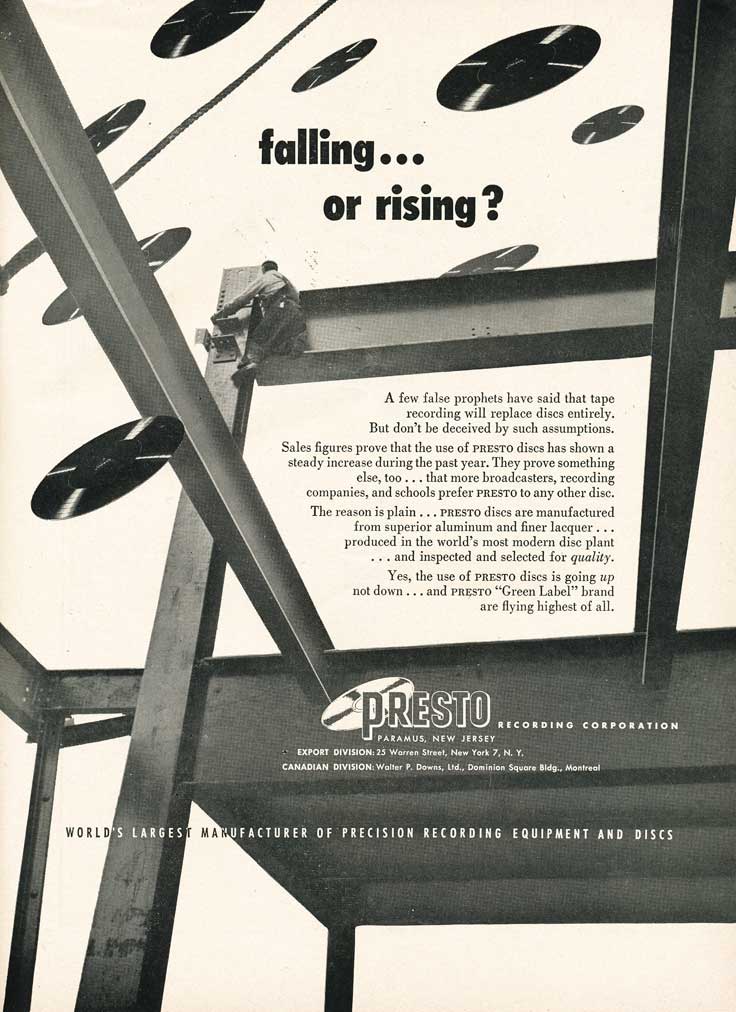 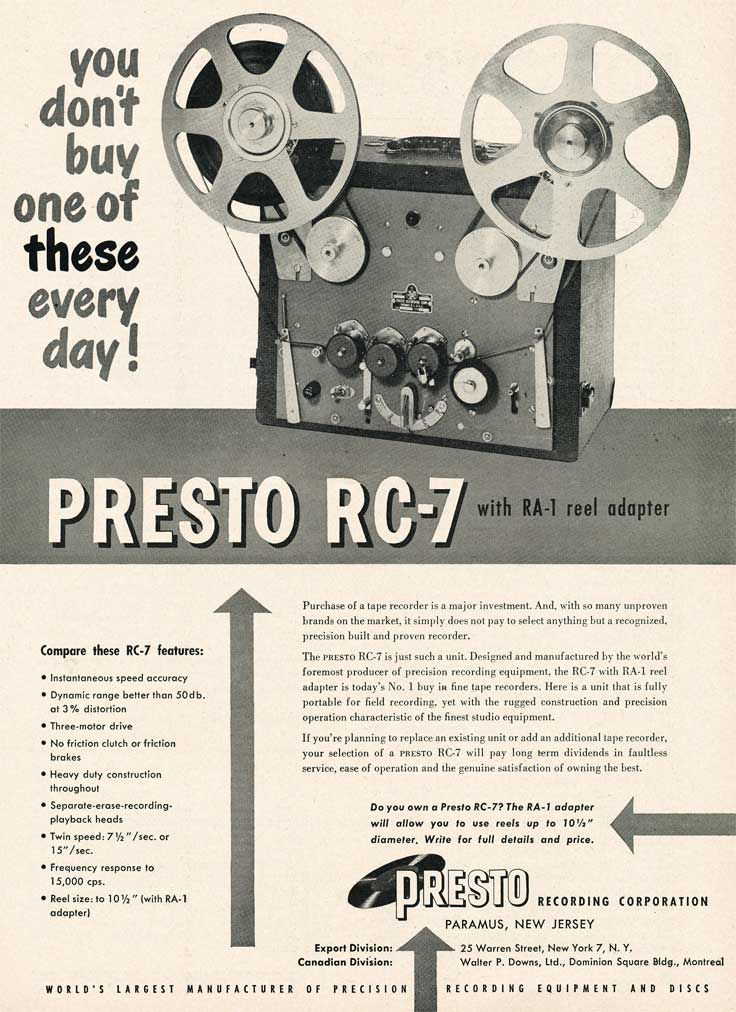 
1954
 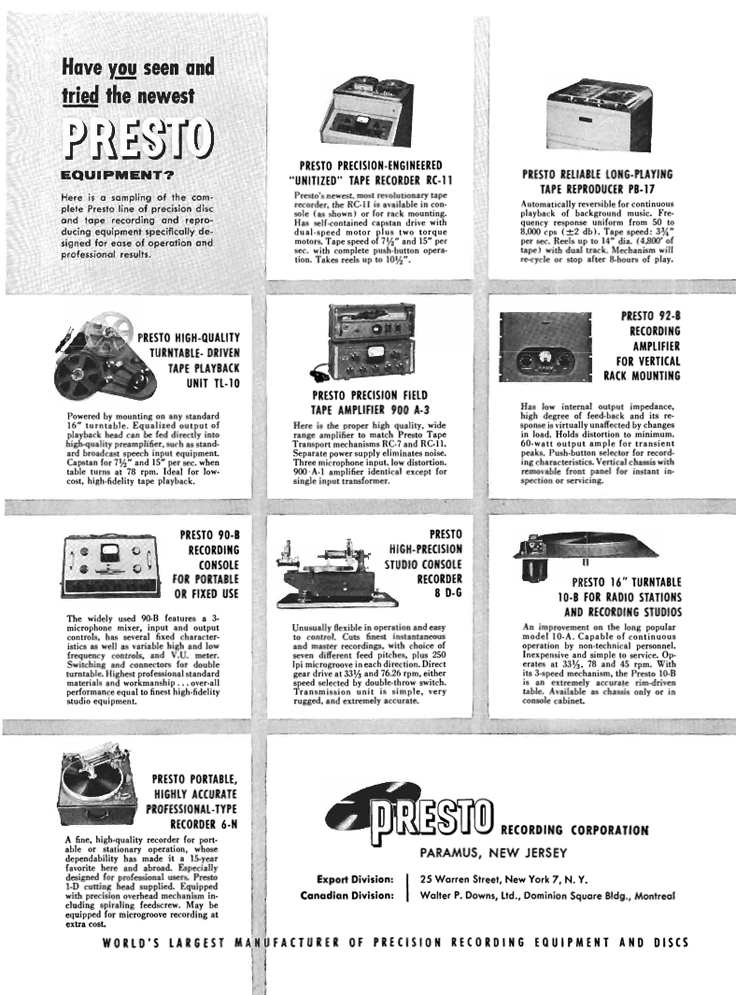  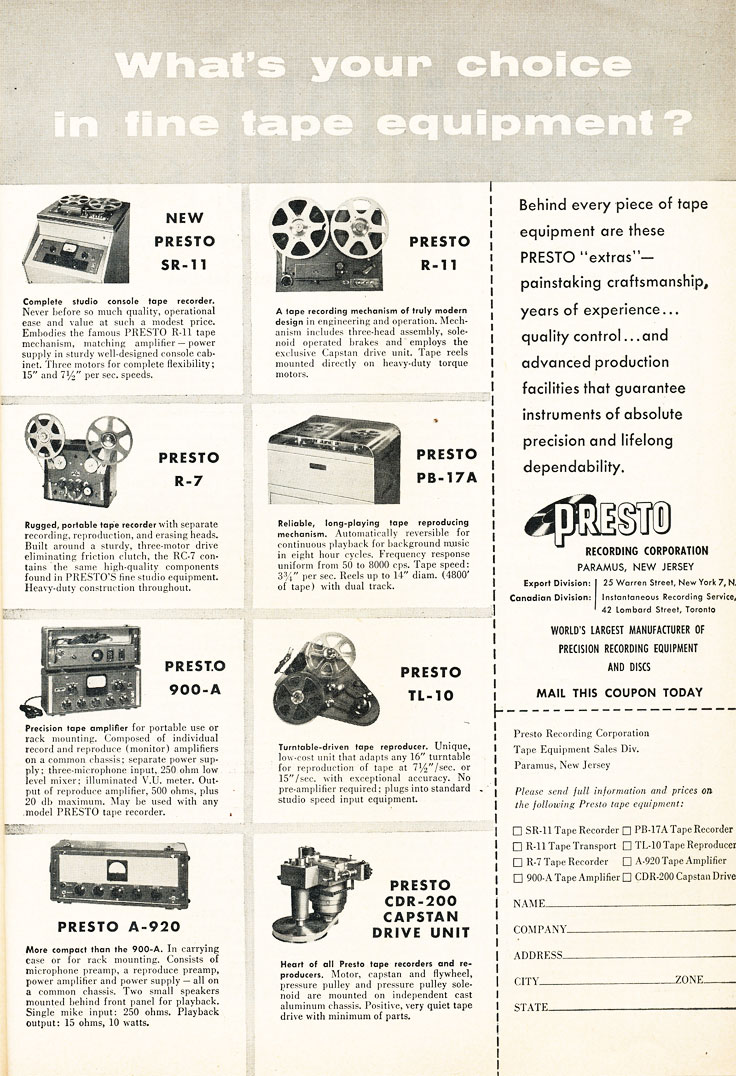 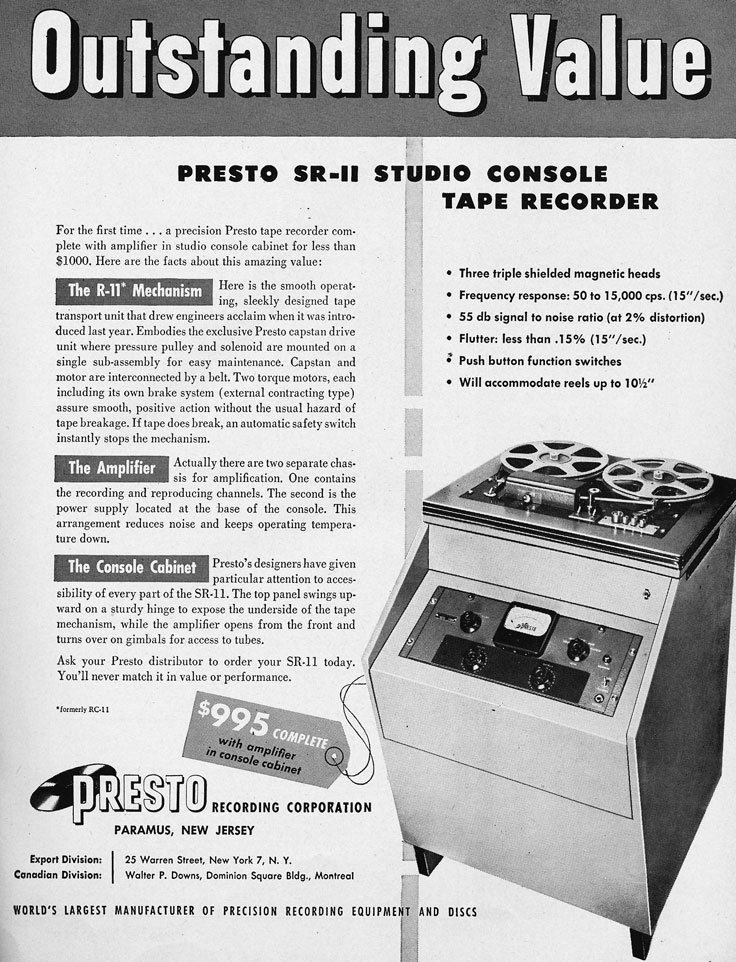
1955
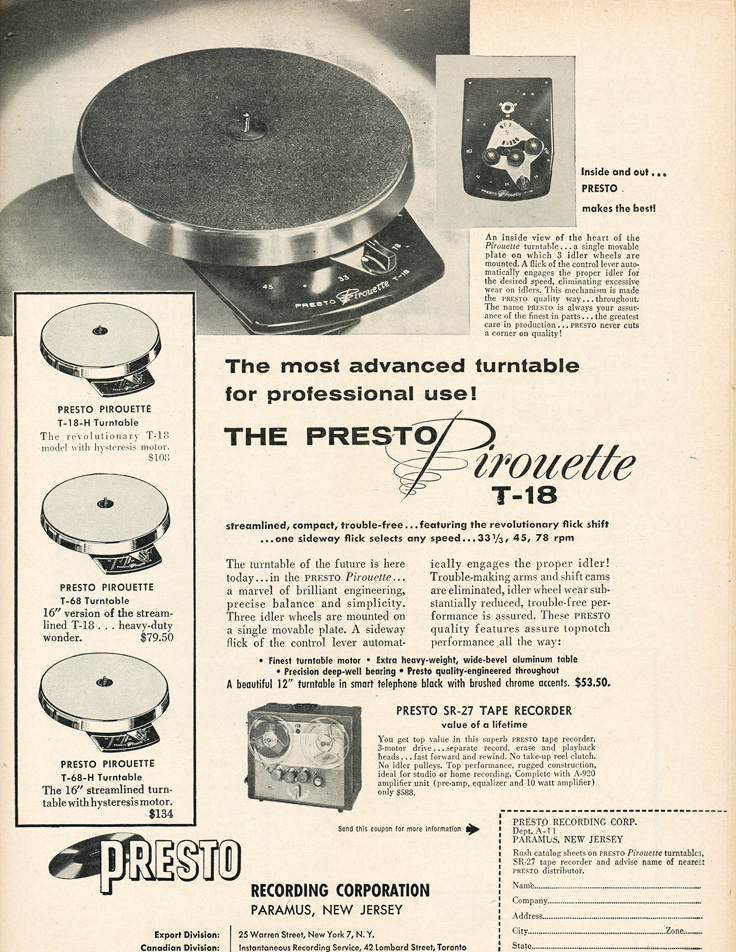 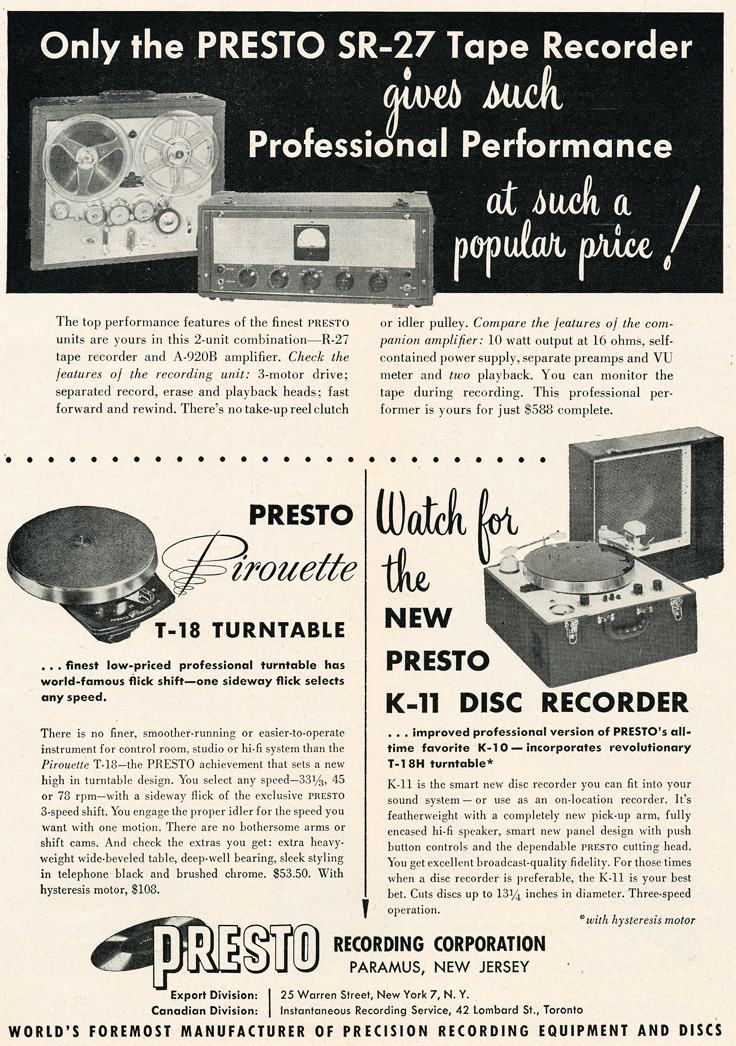 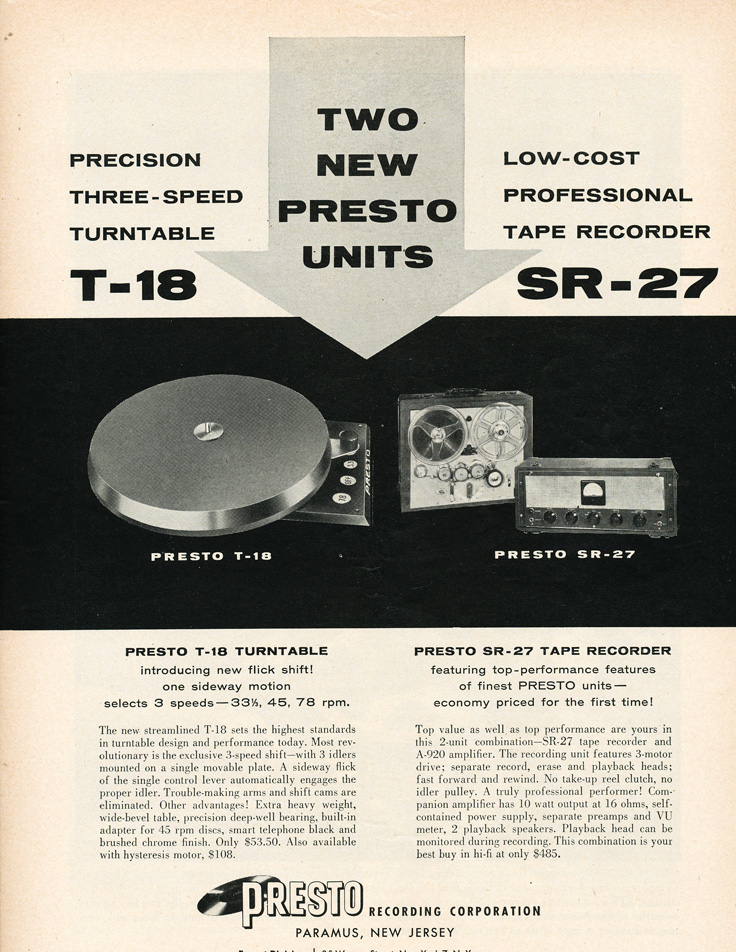 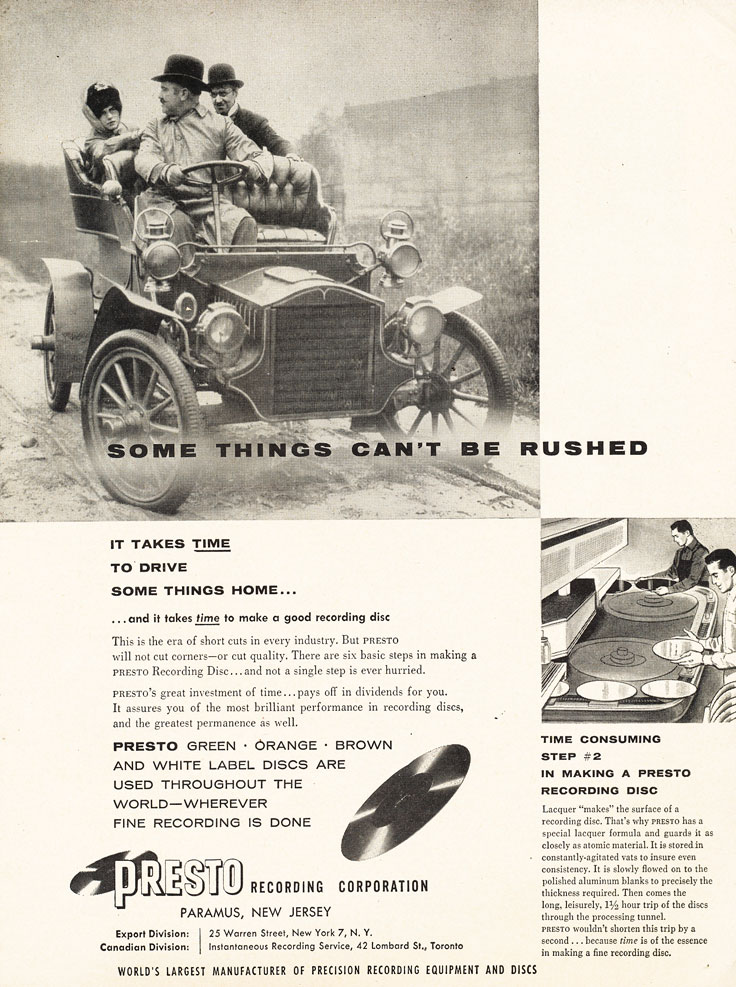
1957
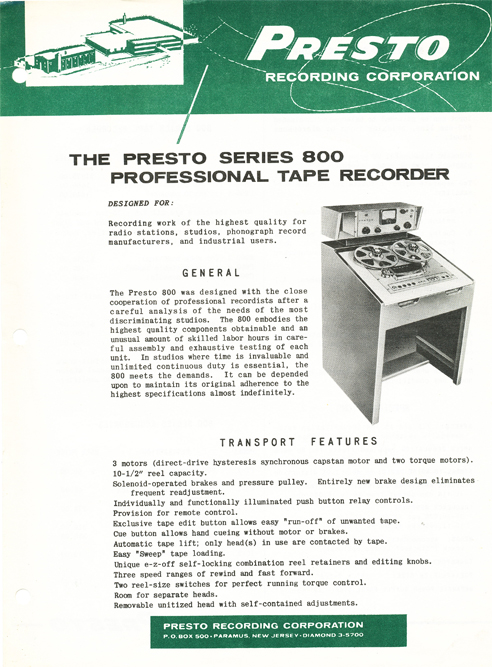 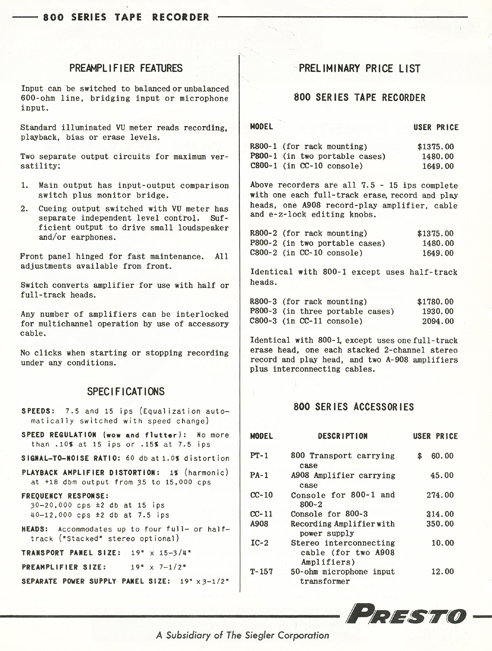
1959
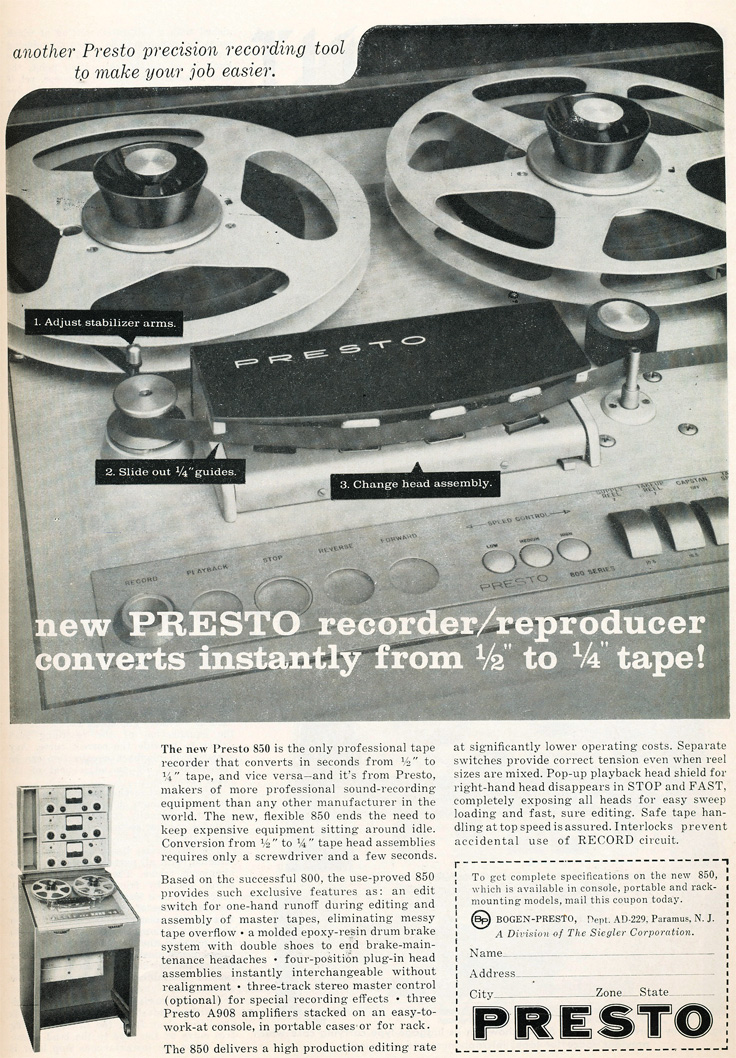
1960
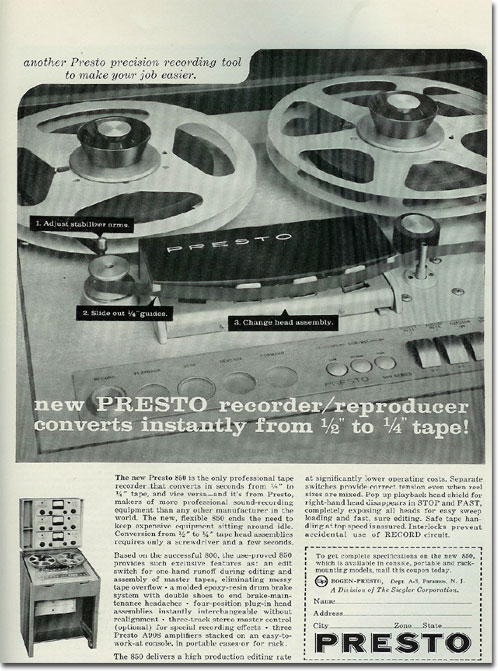 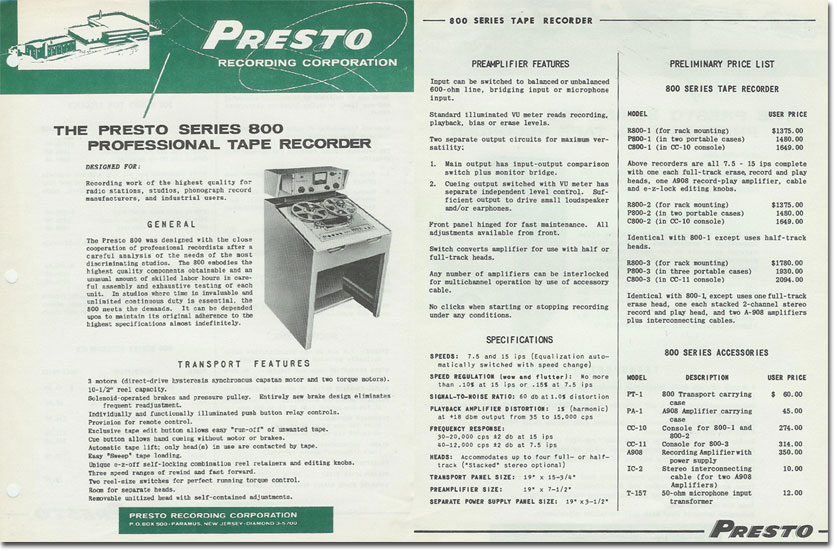
|
| |
Rangertone
 Richard Howland Ranger (13 June 1889 – 10 January 1962) was an American electrical engineer, music engineer and inventor. He was born in Indianapolis, Indiana, the son of John Hilliard and Emily Anthen Gillet Ranger, He served in the U.S. Army Signal Corps during World War I, earning the rank of Major. After the war, he attended the Massachusetts Institute of Technology (MIT) from 1919 to 1923. Richard Howland Ranger (13 June 1889 – 10 January 1962) was an American electrical engineer, music engineer and inventor. He was born in Indianapolis, Indiana, the son of John Hilliard and Emily Anthen Gillet Ranger, He served in the U.S. Army Signal Corps during World War I, earning the rank of Major. After the war, he attended the Massachusetts Institute of Technology (MIT) from 1919 to 1923.
As a designer for the Radio Corporation of America (RCA), in 1924, Richard Ranger invented the wireless photoradiogram, or transoceanic radio facsimile, the forerunner of today’s fax machines. A photograph of President Calvin Coolidge sent from New York to London in November 1924 became the first photo picture 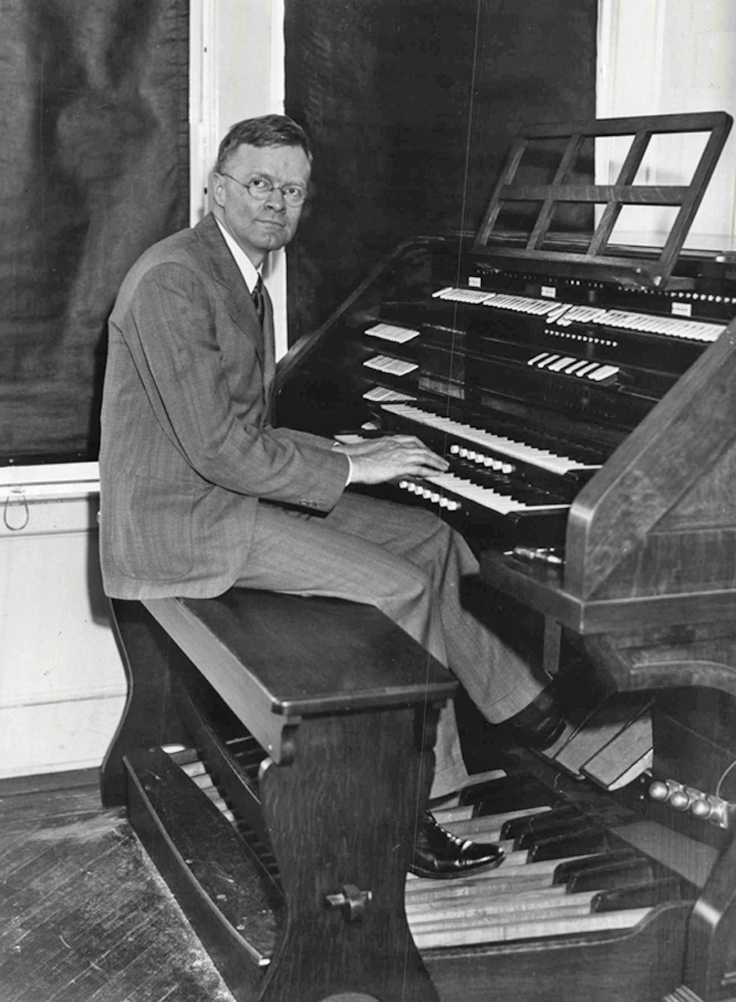 reproduced by transoceanic radio facsimile. Commercial use of Ranger’s product began two years later. reproduced by transoceanic radio facsimile. Commercial use of Ranger’s product began two years later.
In 1930, he formed a company, Rangertone, Inc., in Newark, New Jersey. The company, which marketed the electronic 'Rangertone Organ', was sold after his death, and remains privately owned as Rangertone Research, Inc.
In 1932, he invented the NBC chime machine, an automatic device to reproduce the familiar hand-struck NBC chimes used by the National Broadcasting Company 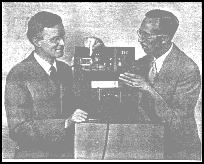 (NBC) radio network. By connecting his electrically operated chimes with outdoor loudspeakers, he was later able to create the effect of church bells. He also did other work relating to electronic organs. (Photo right) Capt. Richard H. Ranger (left), the inventor of the pipe-less organ, the bell-less carillon and RCA's facsimile transmission, explains his latest invention to O.B. Hanson, manager of Technical Operations and Engineering of (NBC) radio network. By connecting his electrically operated chimes with outdoor loudspeakers, he was later able to create the effect of church bells. He also did other work relating to electronic organs. (Photo right) Capt. Richard H. Ranger (left), the inventor of the pipe-less organ, the bell-less carillon and RCA's facsimile transmission, explains his latest invention to O.B. Hanson, manager of Technical Operations and Engineering of 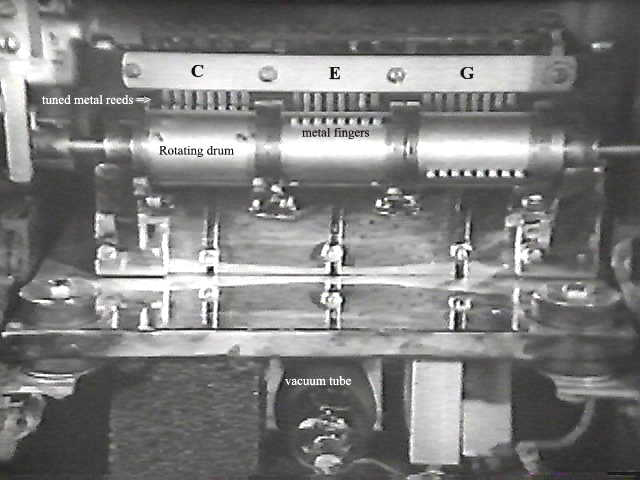 the National Broadcasting Company. The new automatic device now supplants the familiar three-note NBC chimes. (photo left) In this close-up view, the rotating drum with the metal 'fingers' that pluck the tuned reeds, as in a music box, can be seen. The notes G and E have just been sounded and the tuned reeds for the C note are being struck. At the end of the shaft on the left side of the rotating drum is what appears to be a cam that opens a set of contacts to stop the drum after one complete rotation. At the bottom center of the picture can be seen the top of a vacuum tube mounted in a horizontal position. the National Broadcasting Company. The new automatic device now supplants the familiar three-note NBC chimes. (photo left) In this close-up view, the rotating drum with the metal 'fingers' that pluck the tuned reeds, as in a music box, can be seen. The notes G and E have just been sounded and the tuned reeds for the C note are being struck. At the end of the shaft on the left side of the rotating drum is what appears to be a cam that opens a set of contacts to stop the drum after one complete rotation. At the bottom center of the picture can be seen the top of a vacuum tube mounted in a horizontal position.
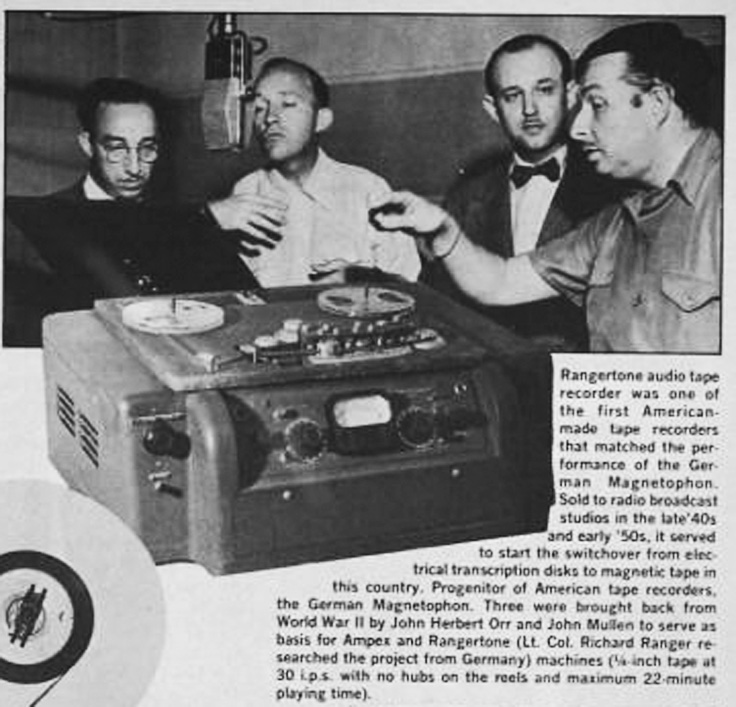 During World War II, he returned to the U.S. Army Signal Corps as a Colonel and was put in charge of radar and communications at the Radio and Radar Test Labs in Orlando, Florida. He later went to Europe as part of Field information Agency, Technical, an investigative team between 1944 and 1946 to examine German advances in electronics and wrote a series of technical reports on electrical components, communications During World War II, he returned to the U.S. Army Signal Corps as a Colonel and was put in charge of radar and communications at the Radio and Radar Test Labs in Orlando, Florida. He later went to Europe as part of Field information Agency, Technical, an investigative team between 1944 and 1946 to examine German advances in electronics and wrote a series of technical reports on electrical components, communications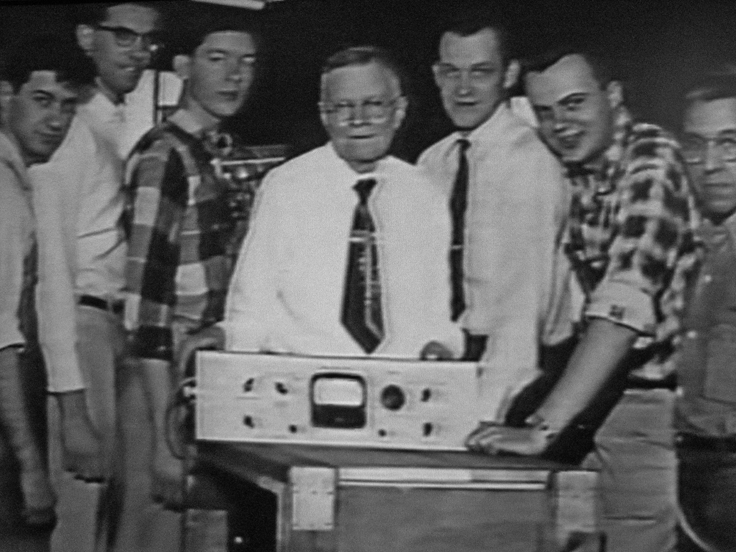 , television, and (most significantly) magnetic tape recording. , television, and (most significantly) magnetic tape recording.
After the war, Ranger's work led to further development of magnetic tape recorders. He developed a product using the German technology, and demonstrated it to potential users, including the members of the Institute of Radio Engineers, the National Broadcasting Company, the Radio Corporation of America, the American Institute of Electrical Engineers, and individuals like singer Bing Crosby.
His subsequent refinements led to improved synchronization of sound and visual portions of films. The Academy of Motion Picture Arts and Sciences presented Ranger with an Oscar in 1956 for his development of the tape recorder and synchronization of film and sound.
Richard H. Ranger was inducted into the New Jersey Inventors Hall of Fame in 1997. Wikipedia
Ads from 1948 and 1949
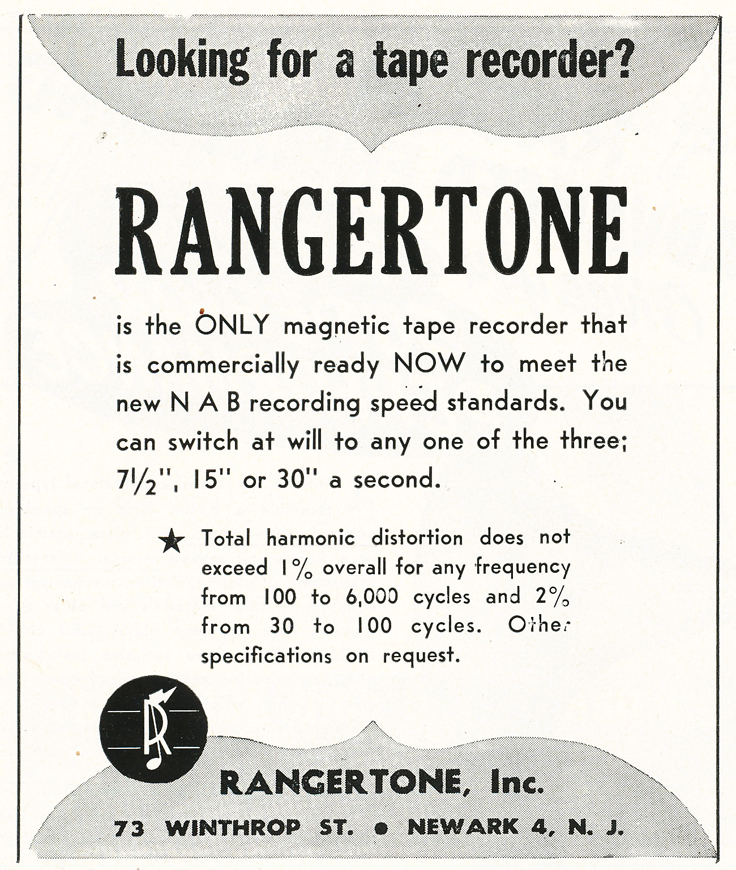 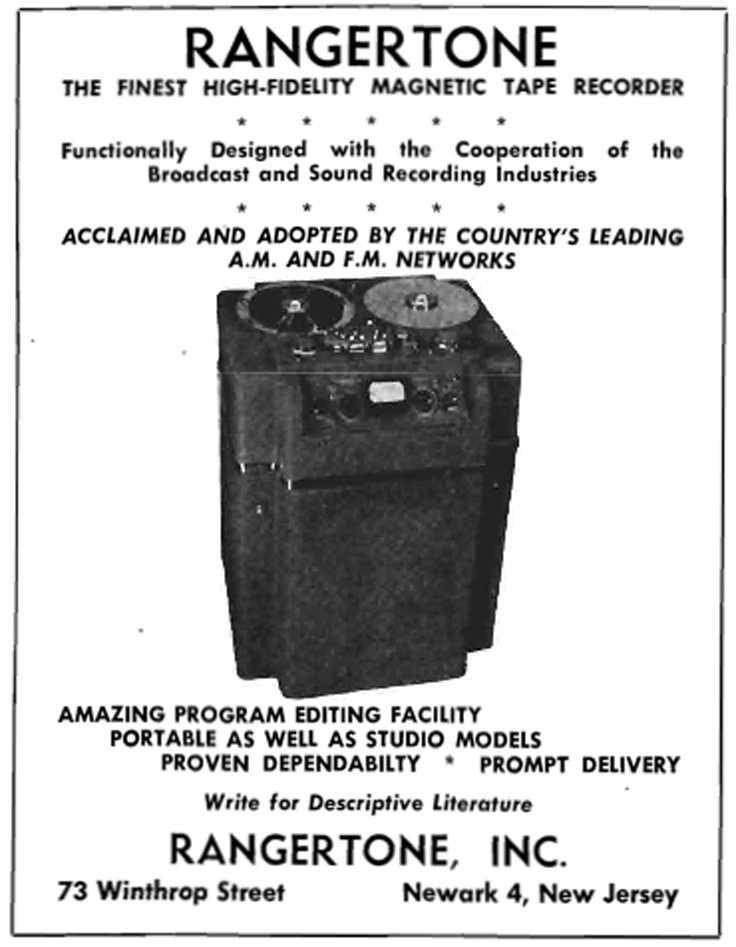
Additional photos:
  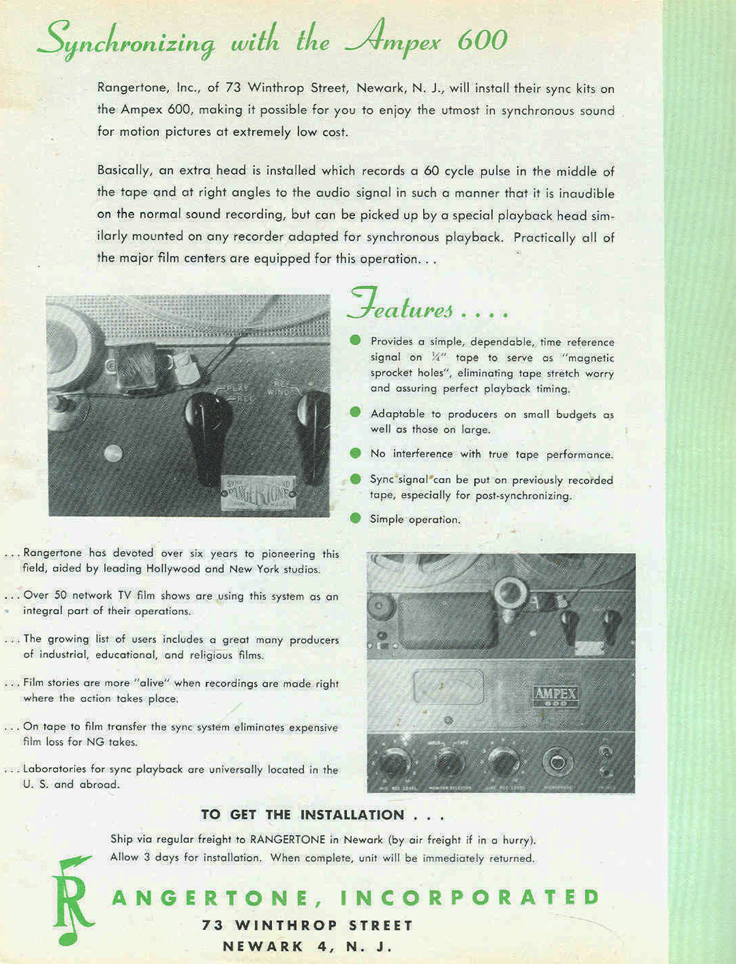
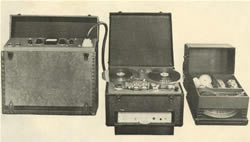 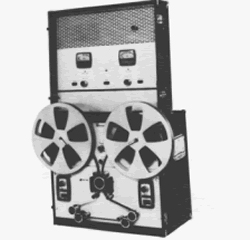 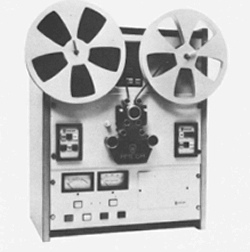
Richard Ranger (left in photo below) designed a speaker system for JBL
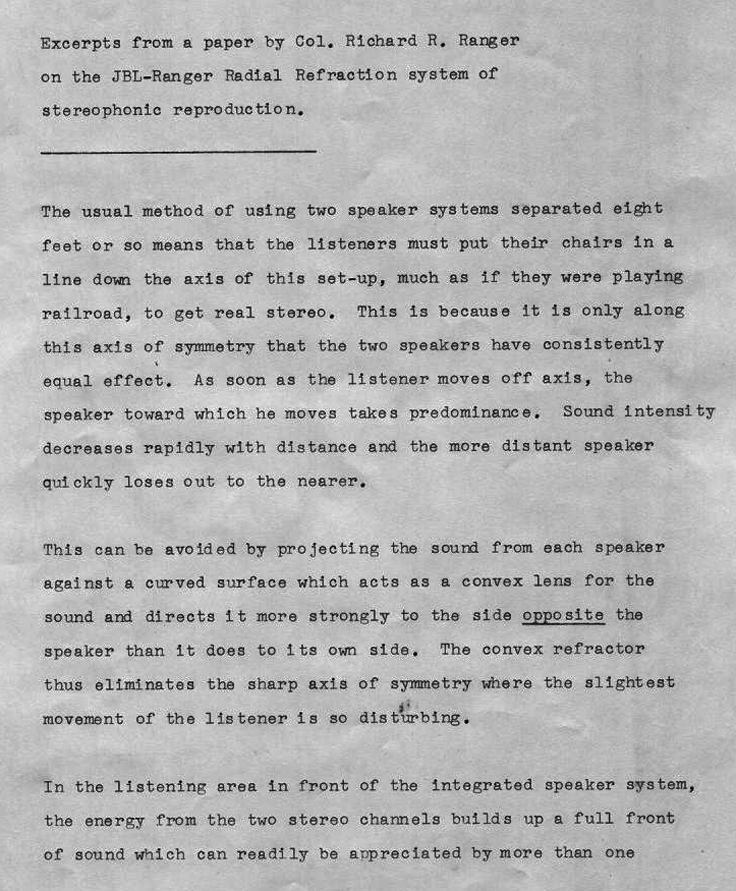  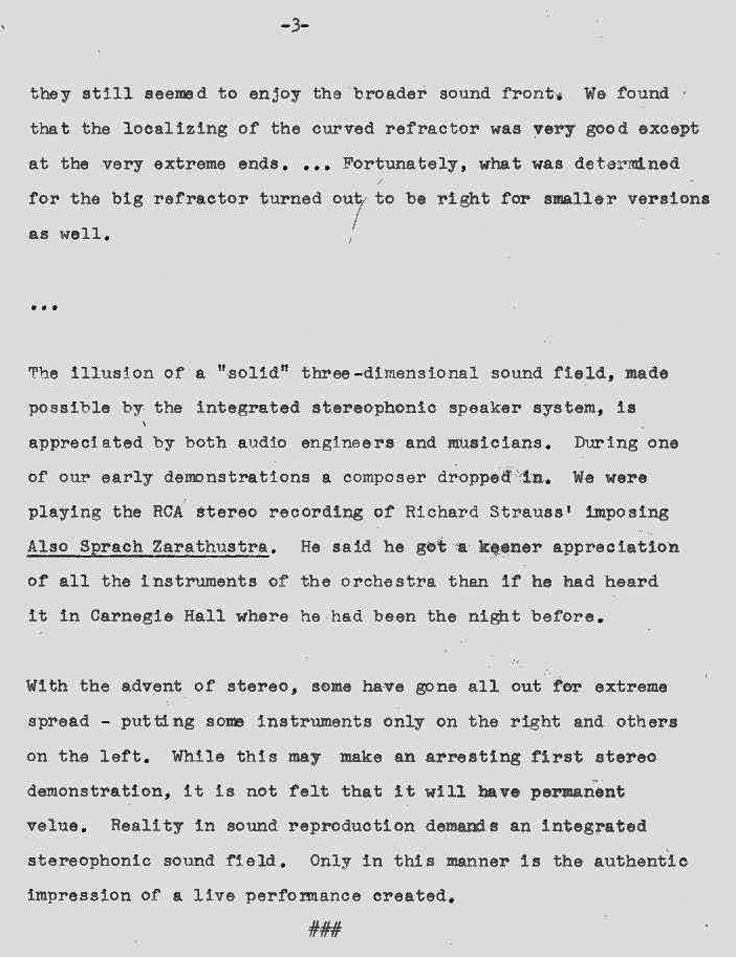 
|
| |
Roberts
Robert G. Metzner - Califone & Roberts Recorders
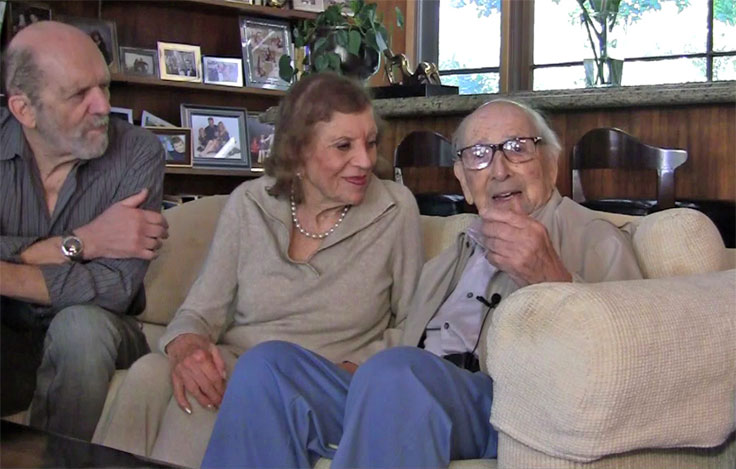 On December 11, 2012, Chris & Martin Theophilus, Directors for the Museum of Magnetic Sound Recording, interviewed 95 year old Robert G. Metzner in his On December 11, 2012, Chris & Martin Theophilus, Directors for the Museum of Magnetic Sound Recording, interviewed 95 year old Robert G. Metzner in his 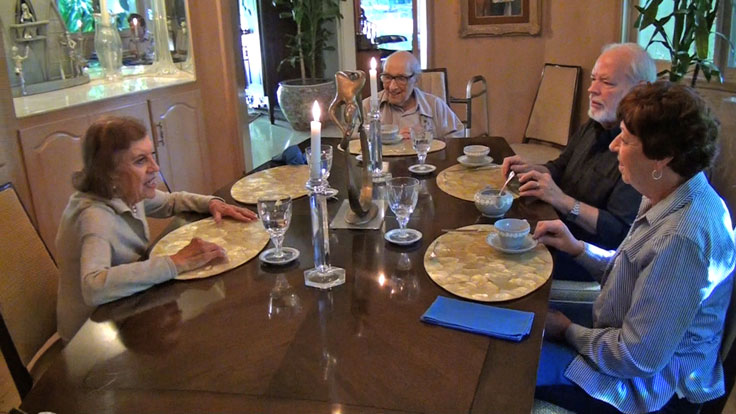 home in Beverly Hills, California. His son, Dr. Richard Metzner facilitated the interview and Robert Metzner's wife of 72 years, Esther Metzner joined in the interview and hosted lunch. home in Beverly Hills, California. His son, Dr. Richard Metzner facilitated the interview and Robert Metzner's wife of 72 years, Esther Metzner joined in the interview and hosted lunch.
In the over 2 hour interview we heard about the founding of Roberts Recorders, Califone (a major A/V equipment manufacturer still in business to this day) and the numerous patents Mr. Metzner created. We have segments of the interview available on this web site.
Mr. Metzner shared a wealth of stories about working with Akai (he learned Japanese and made 12 trips to Japan). He said he had supplied an Ampex recorder to Akai and that resulted in the early design similarities. He is as sharp as ever and as we began the interview, we asked he test the audio with 1,2,3. He immediately said 3, 2,1, smiling. We knew we were in for a good interview.
The interview centers around Mr. Metzner's contributions to magnetic sound recording through Califone, Inc. and Roberts Recorders, Inc. There are brief video clips on this page from the interview. The entire video will be available from the Museum of Magnetic Sound Recording in the future.
Robert G. Metzner built his first crystal radio set at age 9. He got his ham radio license and later he acquired his First Class Radio Telephone license at age 16. VIDEO
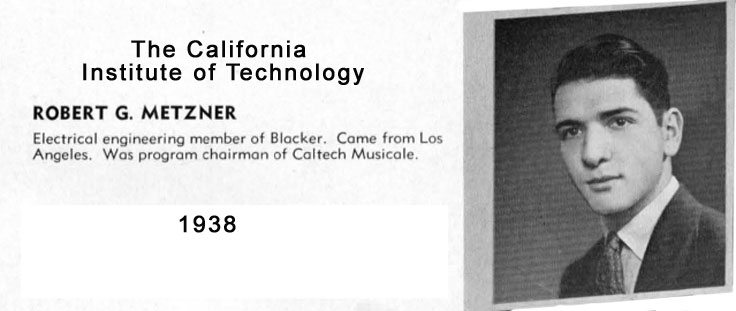 Robert G. Metzner (pictured in Caltech's 1938 annual) majored in electrical engineering at Caltech. He worked his way through university going to class in the morning and then working for the Hadley Transformer Company in the afternoons. He then was hired by Allied Phonograph and Records. Robert G. Metzner (pictured in Caltech's 1938 annual) majored in electrical engineering at Caltech. He worked his way through university going to class in the morning and then working for the Hadley Transformer Company in the afternoons. He then was hired by Allied Phonograph and Records.
He founded Pacific Sound Equipment Company and provided portable 16 inch transcription turntable players to salesmen who marketed their 16 inch discs to the film industry. When WW II began his company provided transcription turntables and other A/V products to the US military during WW II. The company ceased to exist when the war ended. VIDEO

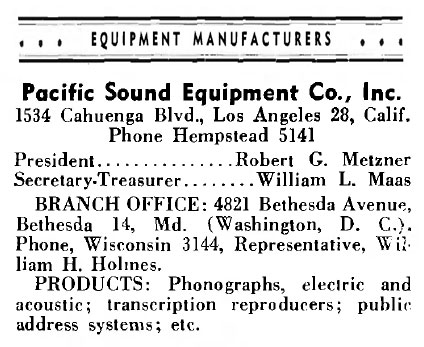 
After the war, Pacific Sound Equipment Company held such a large inventory of military style turntables that the company had to go into receivership.
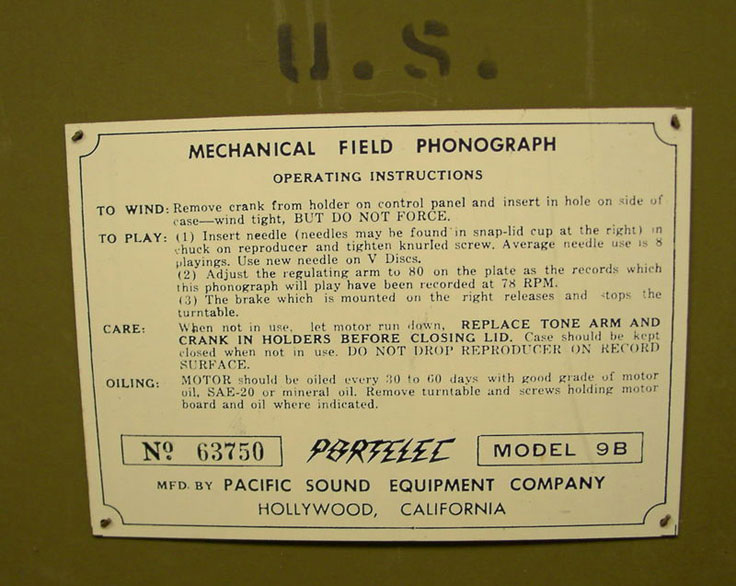  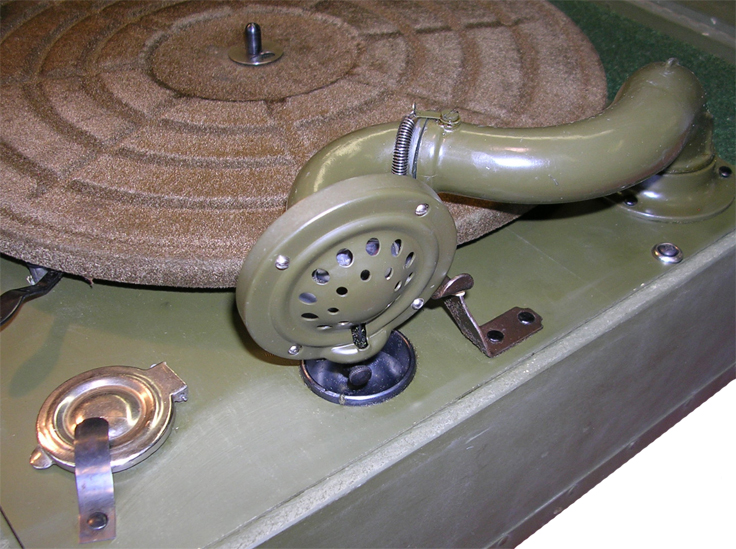
 Metzner Founds Califone Metzner Founds Califone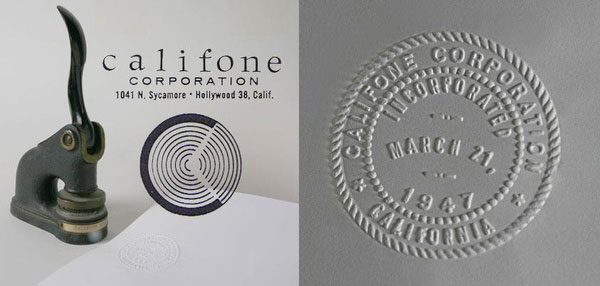
On March 21, 1947 with backing from his mother and a friend, Bill Maas, Robert Metzner (pictured left in the 1940's) founded Califone Corporation which later became the educational products division of Roberts Recorders. VIDEO
Califone is still in business today and manufactures state-of-the-art consumer audio components and, was the first U.S. company to offer a reel-to-reel tape recorder and solid state radio tuners to the general public. Metzner's Califone company provided transcription turntables. VIDEO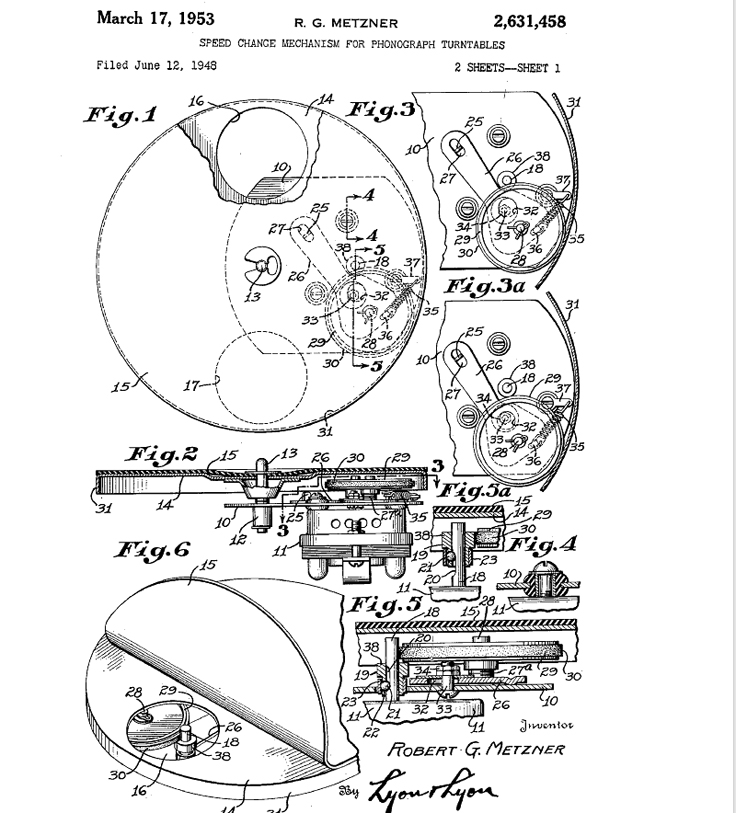 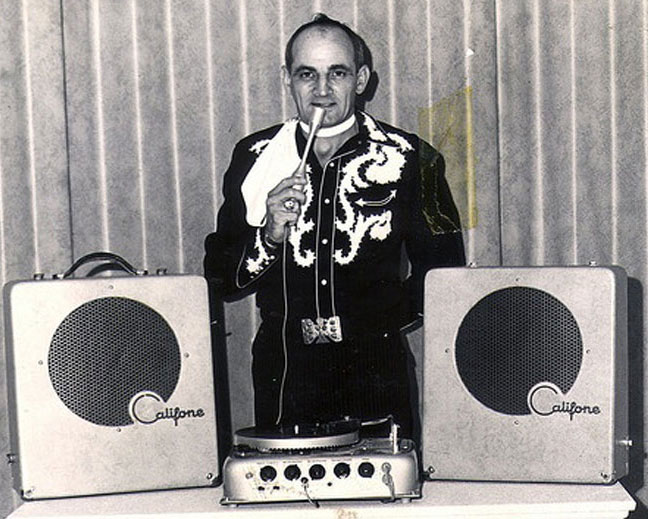
To help Square Dancing groups popular at the time, Robert G. Metzner in 1953 invented and patented (right) a variable speed control for the turntables. VIDEO
Here are some photos from the early Califone factory from Califone International.
 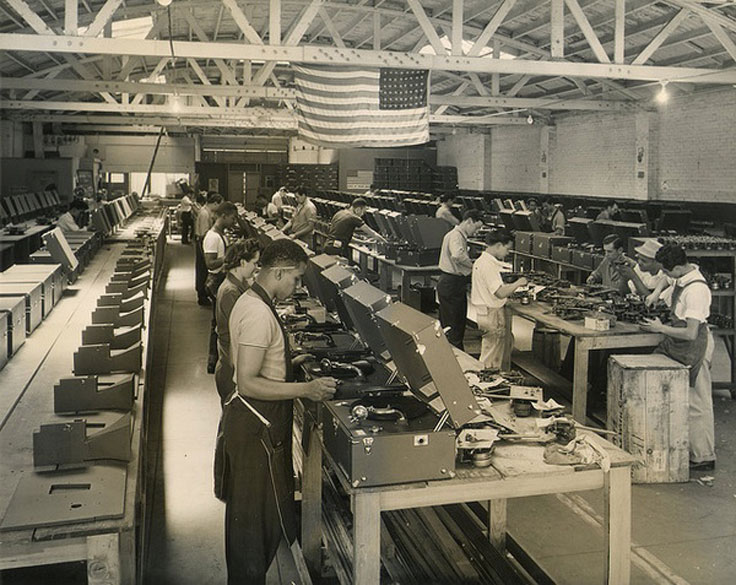 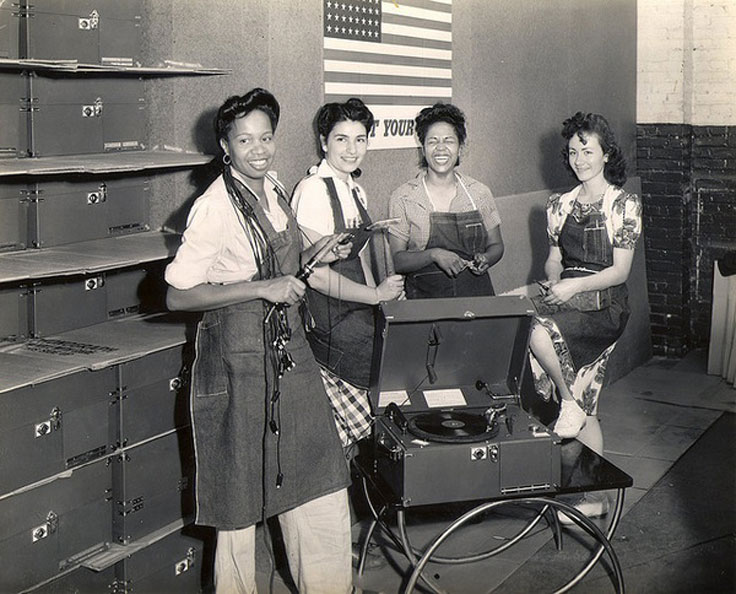   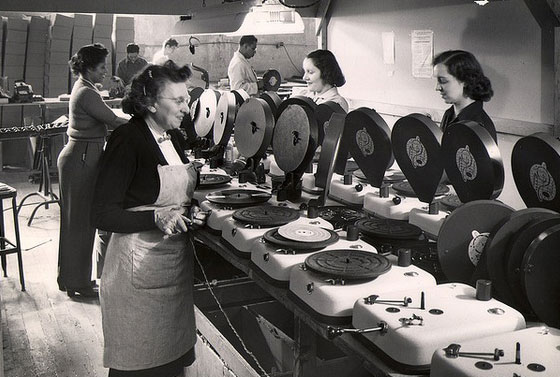 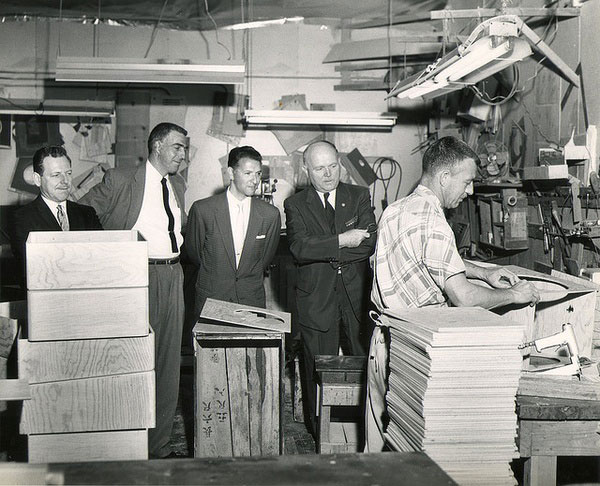
photos - Califone International
  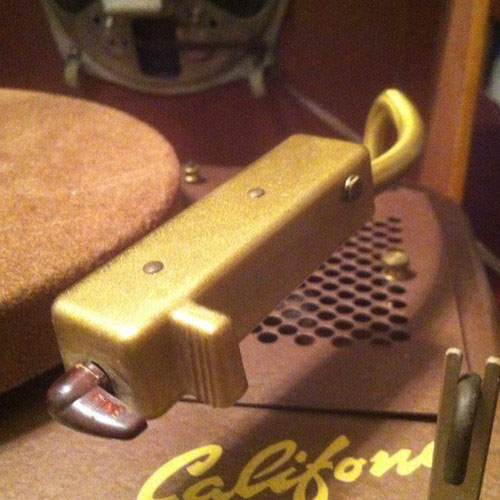 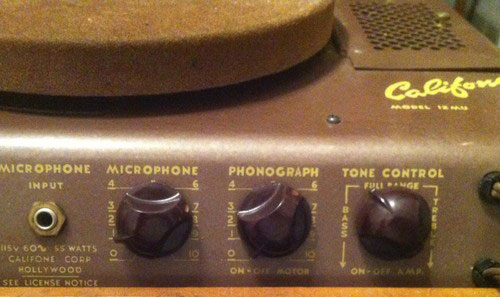
Califone products in use VIDEO
Roberts Electronics, Inc.
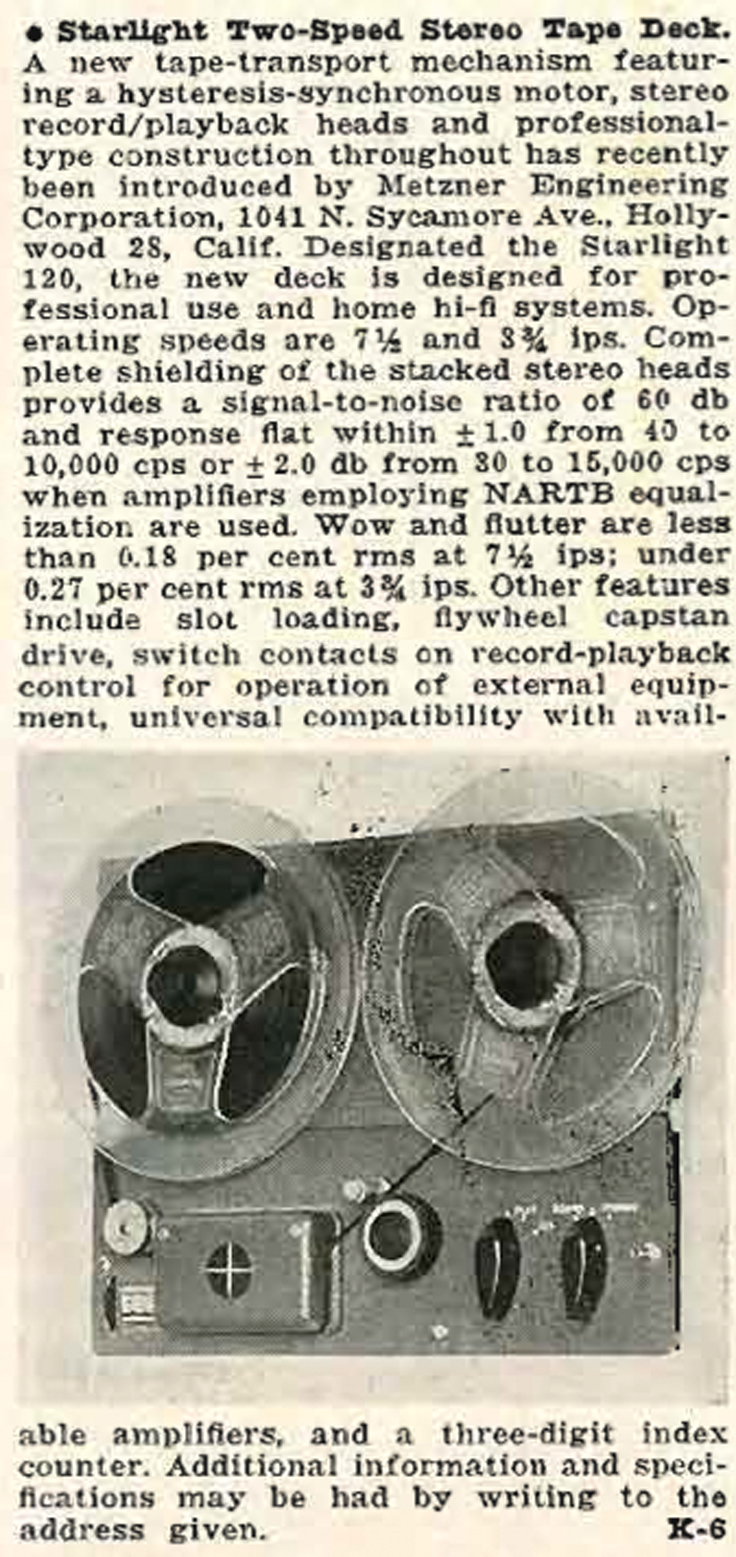
This 1958 announcement in the Audio Engineering magazine (left) was the first tape transport produced by Robert Metzner. It was called the "Starlight" and a turntable by the same name was also released by Metzner Electronics. The summary states the tape deck was manufactured by the Metzner Electronics Corporation, 1041 Sycamore Ave., Hollywood, CA., which was prior to the use of the "Roberts" name (created by and combining the names of Robert Metzner and Robert Craig).
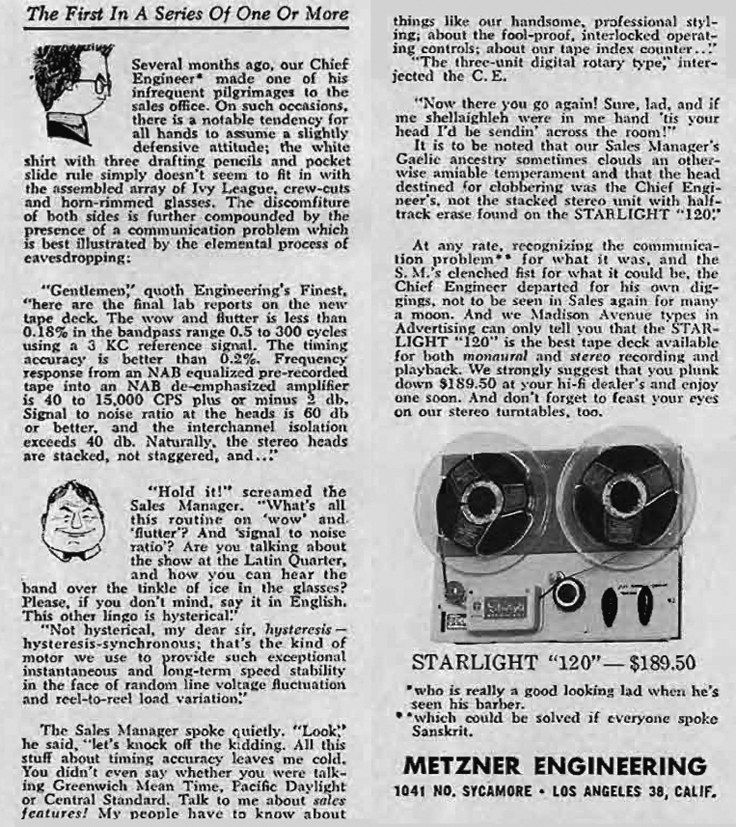 

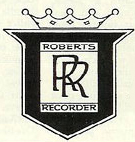 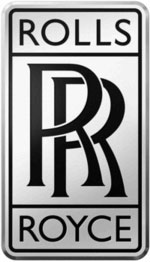 Robert G. Metzner and Robert Craig founded Roberts Electronics, Inc. Robert Craig's farther Talton Craig was Robert G. Metzner's Califone distributer. Talton Craig enabled Robert Metzner to acquire a wide distribution network for Califone & Roberts. VIDEO When Robert G. Metzner and Robert Craig began building Roberts Recorders, their first logo was double "Rs" and British solicitors/attorneys contacted them due to the similarity to the Rolls Royce logo. (1958 Roberts Electronics ad - right) VIDEO Robert G. Metzner and Robert Craig founded Roberts Electronics, Inc. Robert Craig's farther Talton Craig was Robert G. Metzner's Califone distributer. Talton Craig enabled Robert Metzner to acquire a wide distribution network for Califone & Roberts. VIDEO When Robert G. Metzner and Robert Craig began building Roberts Recorders, their first logo was double "Rs" and British solicitors/attorneys contacted them due to the similarity to the Rolls Royce logo. (1958 Roberts Electronics ad - right) VIDEO
 Robert Metzner's relationship with Akai first started around 1953 with a turntable that was brought in for repair to Califone. Robert's brother-in-law, who was working for him at the time said there was a very unusual motor in the player. Robert Metzner noted the numbers of the motor and found they were registered to Saburo Akai. Mr. Metzner contacted Akai and said he would like to know if they were making these motors and if not, could he have the tooling to make them. If they were making them, could he get their distributorship. Akai sent Robert Metzner a brochure about the motors they were manufacturing. A relationship developed and Akai provided motors for some of the Califone products. Robert Metzner's relationship with Akai first started around 1953 with a turntable that was brought in for repair to Califone. Robert's brother-in-law, who was working for him at the time said there was a very unusual motor in the player. Robert Metzner noted the numbers of the motor and found they were registered to Saburo Akai. Mr. Metzner contacted Akai and said he would like to know if they were making these motors and if not, could he have the tooling to make them. If they were making them, could he get their distributorship. Akai sent Robert Metzner a brochure about the motors they were manufacturing. A relationship developed and Akai provided motors for some of the Califone products.
When Akai first sent tape recorder demos to Roberts Electronics, Metzner said they were of very poor quality and he recommended they aspire for the quality of Ampex. He sent an Ampex 600 to Akai and they actually copied the basic design. The early Akai and Roberts Recorders had the similar look, however not the electronics and mechanics of Ampex. VIDEO
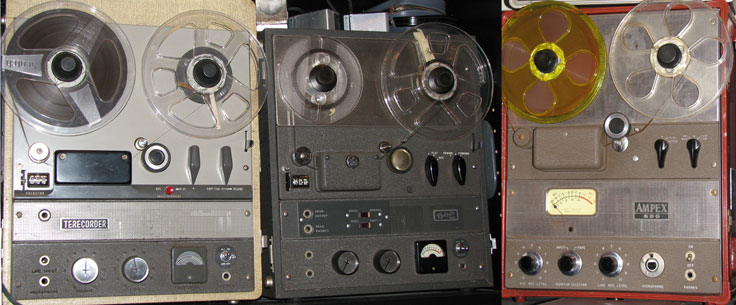
Roberts Electronics, Inc. negotiated an arrangement with Akai wherein Akai would build the machines to Roberts specs, they would be shipped from Japan to the US where Roberts would inspect every unit before it went out to sales. Further, Robert Metzner negotiated a contract that enabled Roberts Electronics to be the sole North American distributor for the recorders. Akai sold the same, or similar models to the rest of the world under the Akai name and paid royalties to Metzner. This lasted until 1972 when Akai entered the US market. Robert Metzner learned the Japanese language and made 12 trips to Japan beginning in 1958, forming a strong relationship with Saburo Akai (who founded Akai in 1929) until Saburo Akai's death in 1973. VIDEO 1 VIDEO 2

Roberts celebrity endorsements
In the 1960's Roberts Recorder ads displayed a high number of significant celebrities endorsing the brand. Robert Metzner said that as they were based in Hollywood, it would be good to profile their recorders with known stars. His first indorsement came from Rudy Vallee. VIDEO
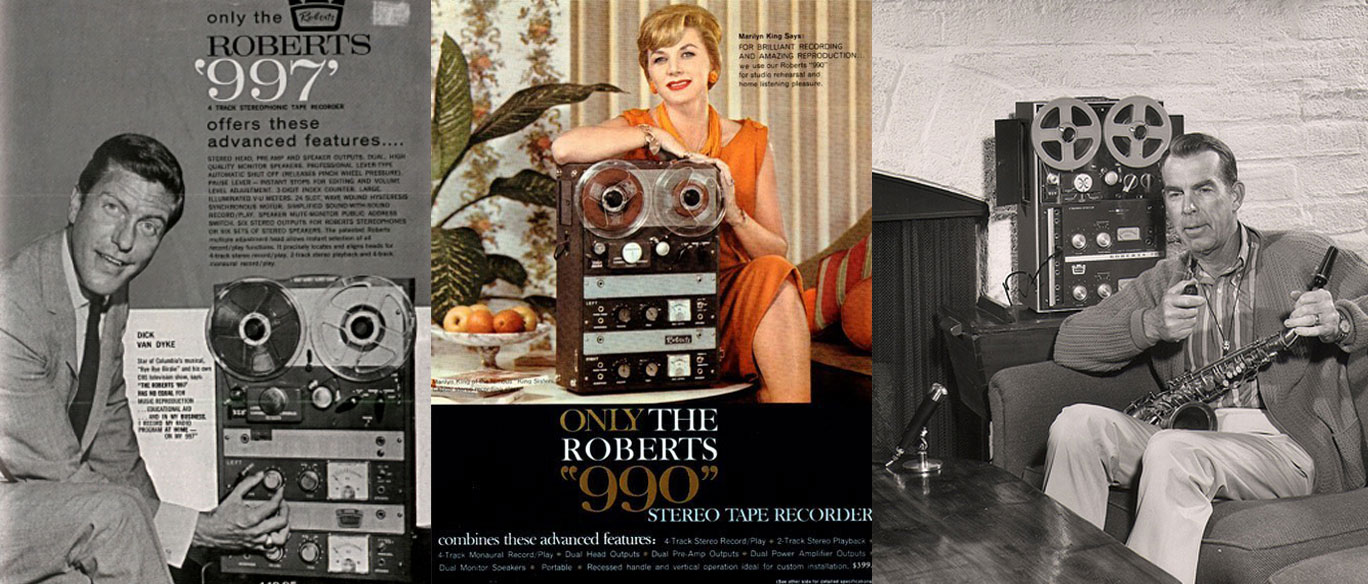 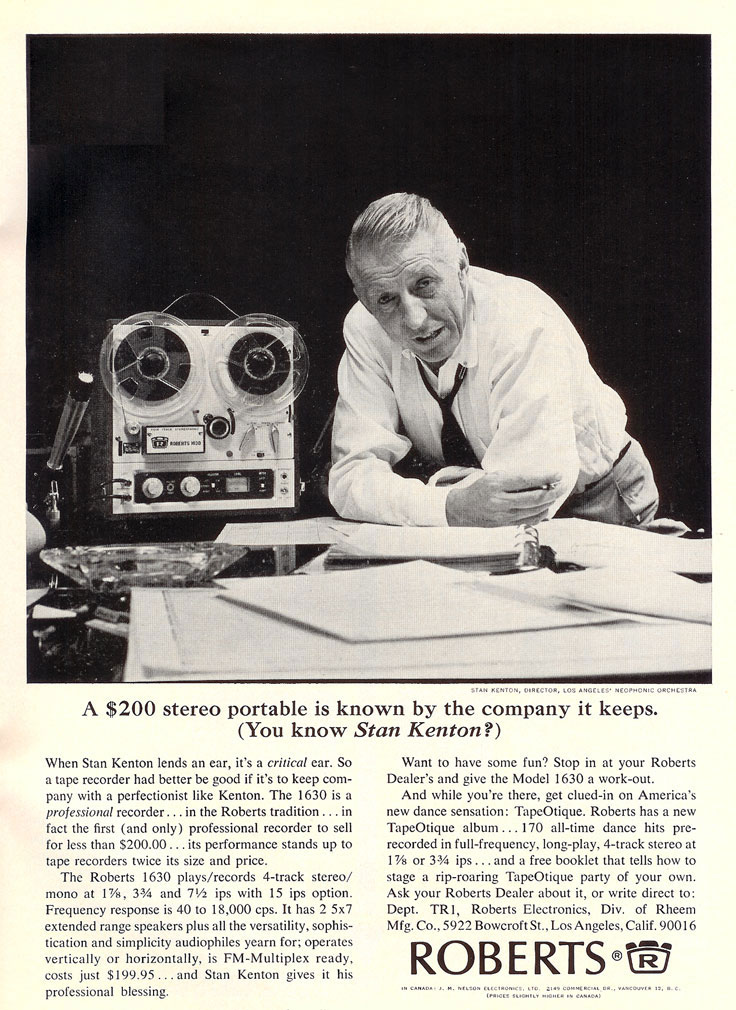 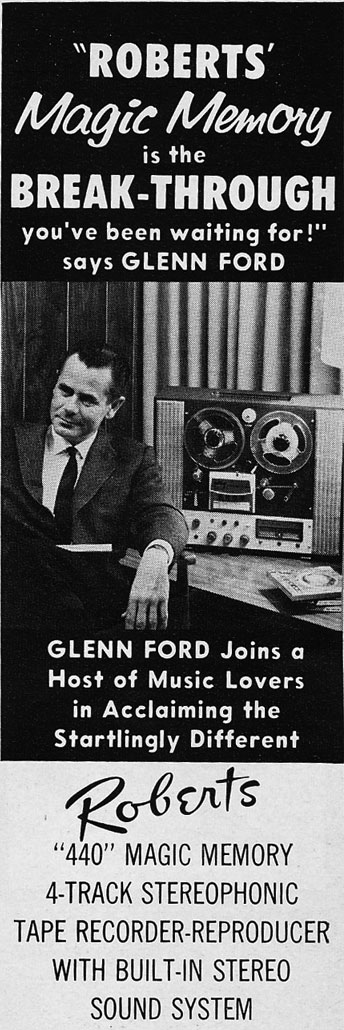 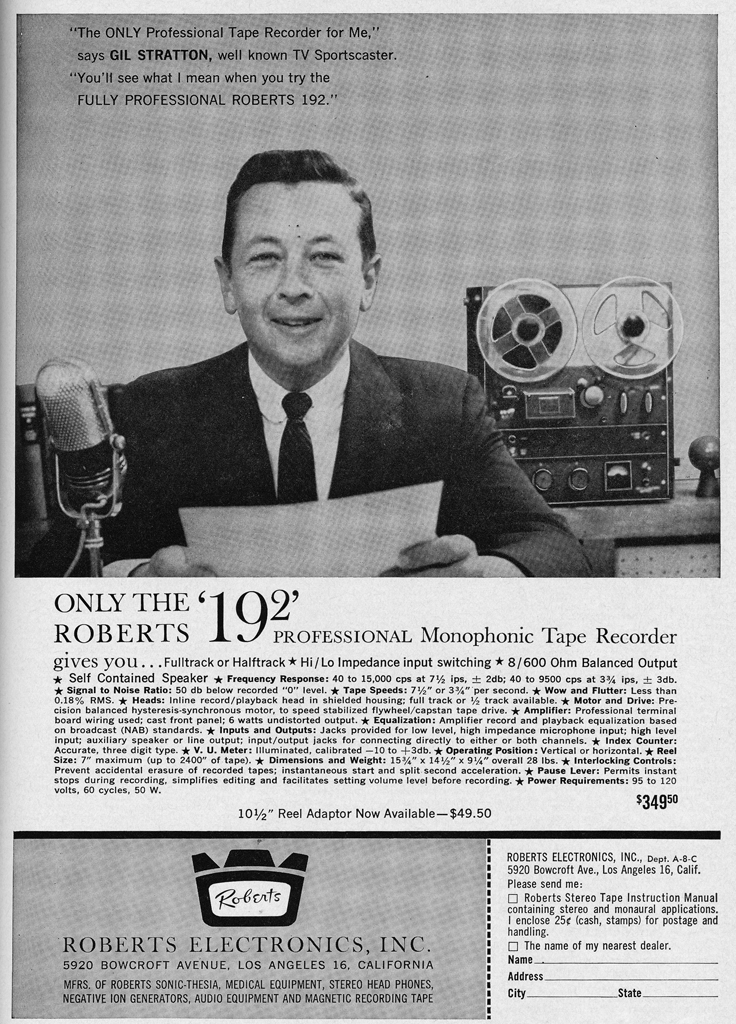  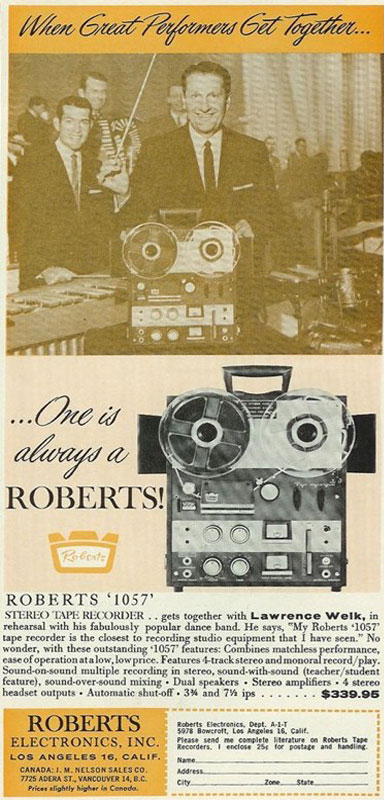 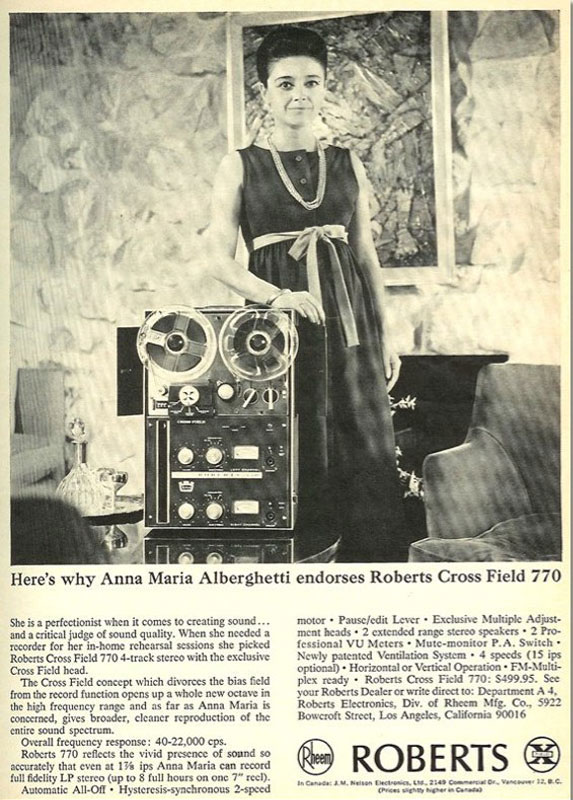      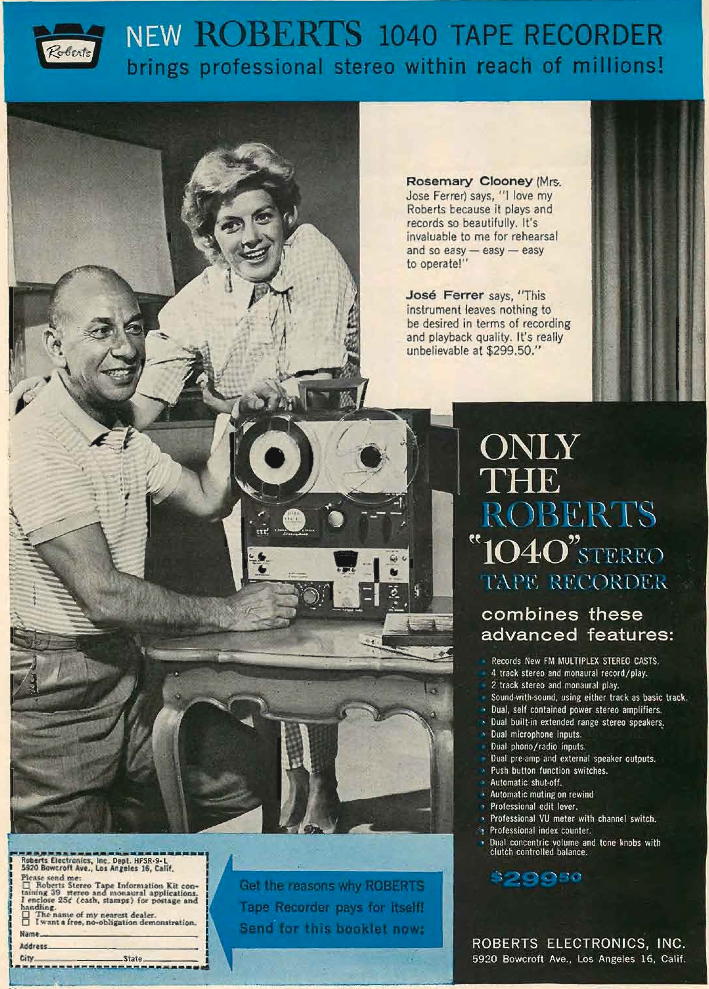 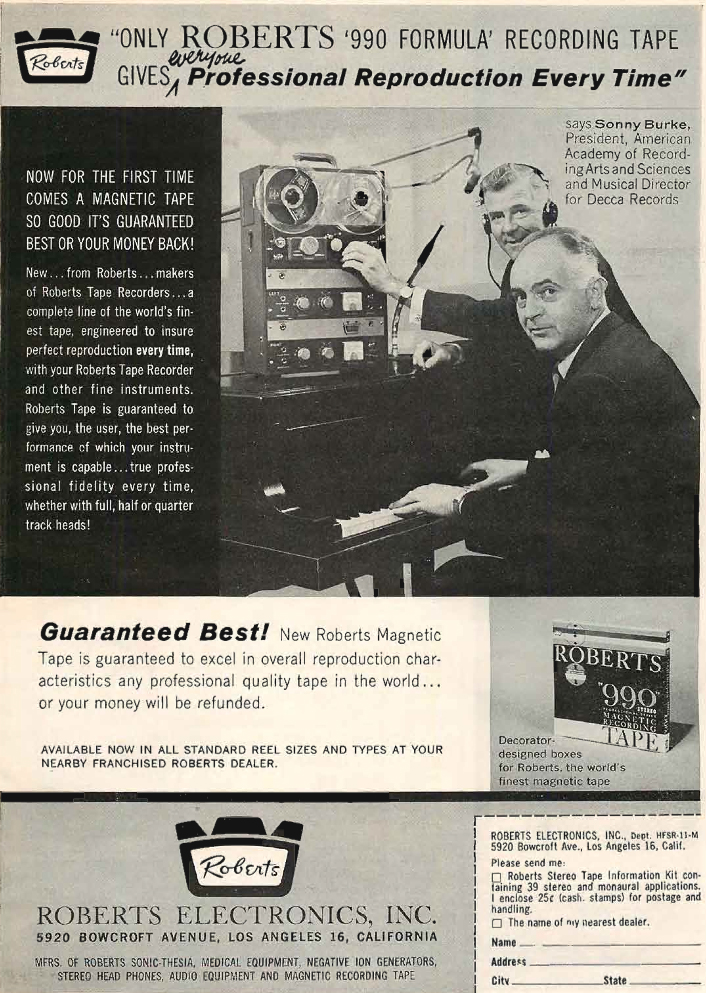 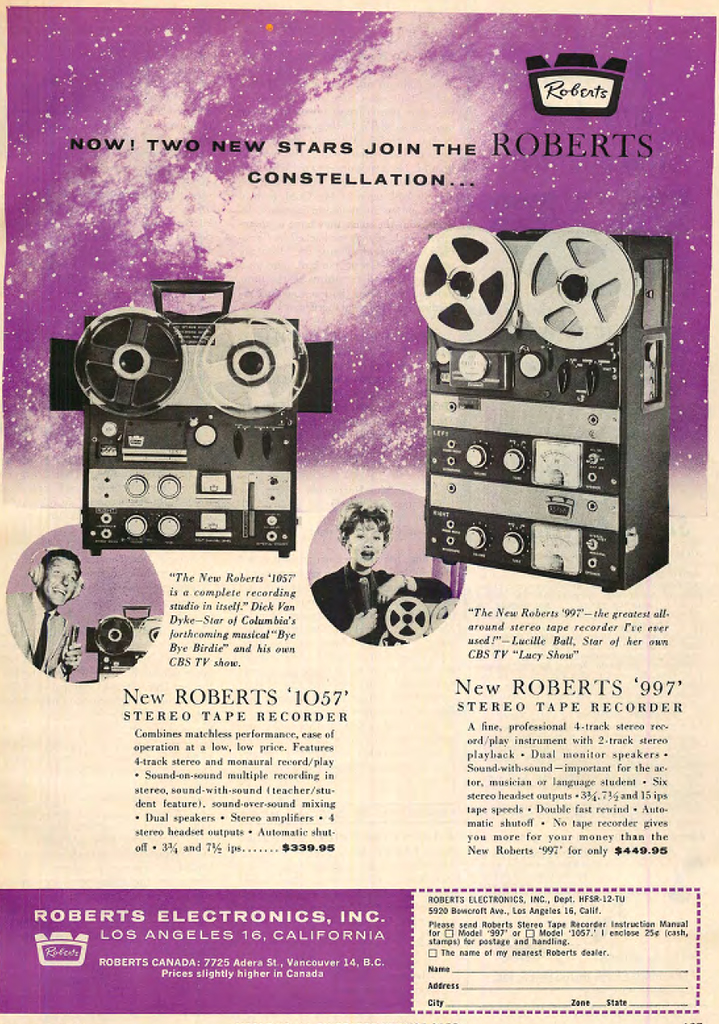  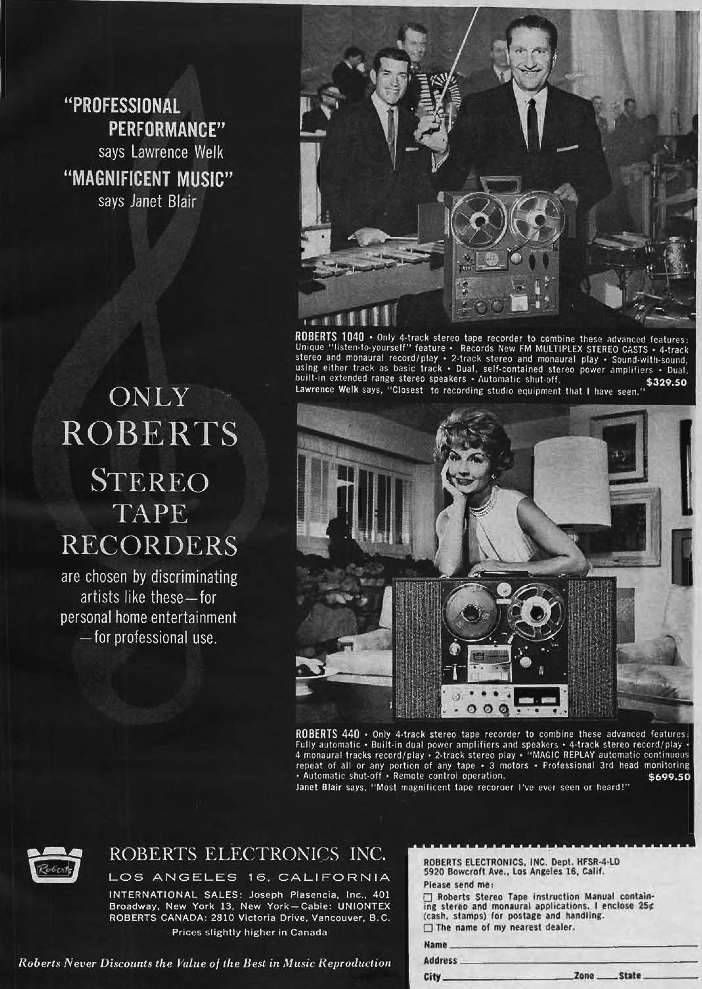 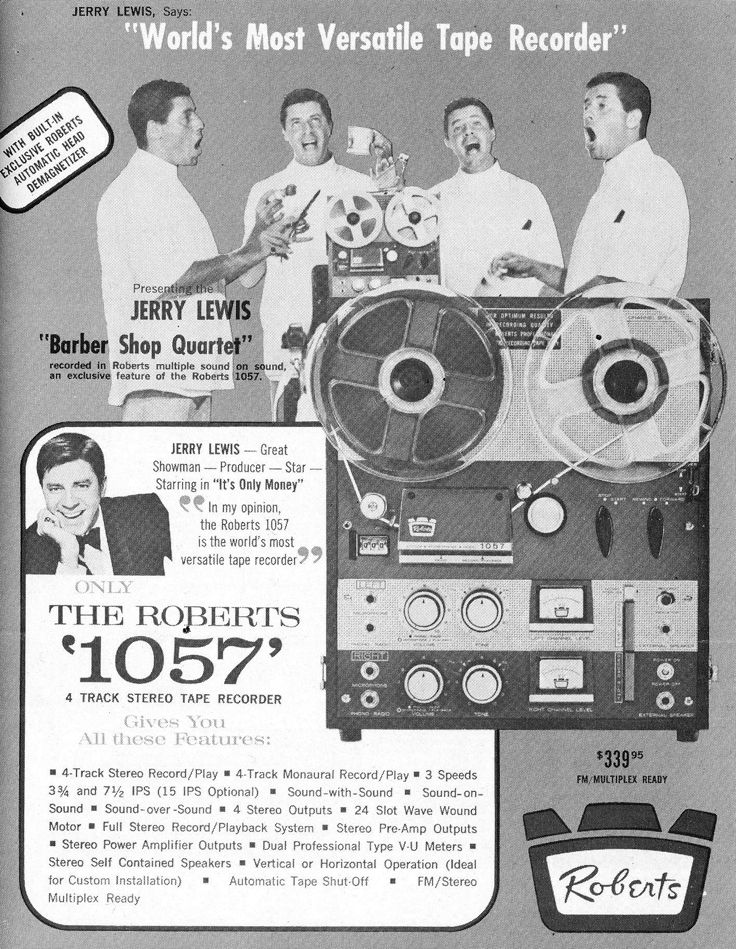    
 In the late 1950's Congress allocated 4 billion dollars for educational resources in the US. Rheem Manufacturing Company (started in 1927 by In the late 1950's Congress allocated 4 billion dollars for educational resources in the US. Rheem Manufacturing Company (started in 1927 by  brothers Richard and Donald Rheem as a supplier of packaging to the petroleum industry and now manufacture of air conditioning, heating and water cooling products). Rheem wanted to participate in supplying educational products and receive a portion of the funds. In 1959, Jack Davis approached Robert Metzner about Rheem acquiring interest in Califone. Rheem acquired a substantial majority interest in Califone Corp., in 1959, and a minority interest in Roberts Electronics, Inc., in 1961, and formed the Rheem Califone-Roberts Division, selling tape recorders, teaching machines, sound systems and other related equipment for the home, schools and industry. Robert G. Metzner was retained as a consultant and continued with Rheem/Califone/Roberts. Robert Craig left and founded Craig Electronics. VIDEO brothers Richard and Donald Rheem as a supplier of packaging to the petroleum industry and now manufacture of air conditioning, heating and water cooling products). Rheem wanted to participate in supplying educational products and receive a portion of the funds. In 1959, Jack Davis approached Robert Metzner about Rheem acquiring interest in Califone. Rheem acquired a substantial majority interest in Califone Corp., in 1959, and a minority interest in Roberts Electronics, Inc., in 1961, and formed the Rheem Califone-Roberts Division, selling tape recorders, teaching machines, sound systems and other related equipment for the home, schools and industry. Robert G. Metzner was retained as a consultant and continued with Rheem/Califone/Roberts. Robert Craig left and founded Craig Electronics. VIDEO
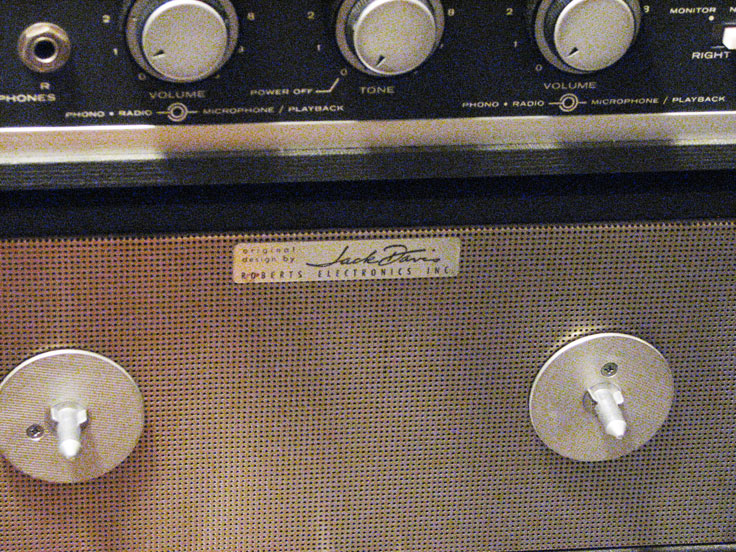 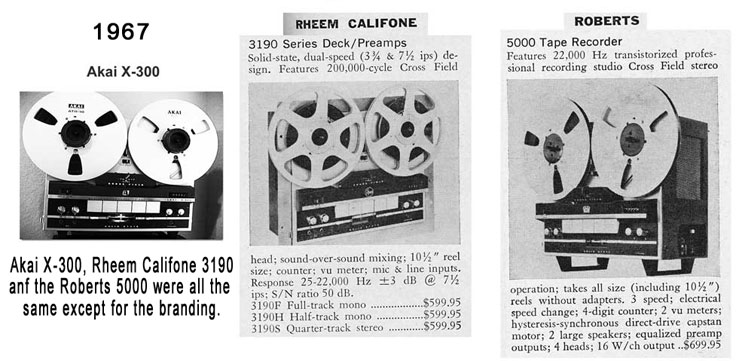
Jack Davis' signature (above left) appeared on a plaque on several of the Rheem Roberts tape recorders. Comparison of the same reel tape recorder branded by the three companies; Akai, Rheem Califone and Roberts
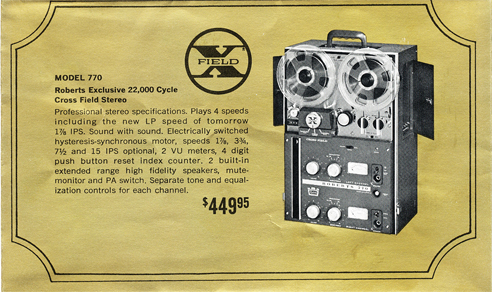
Roberts tape recorders were also known for the Crossfield head indicated by the "X" on the various tape recorders. VIDEO
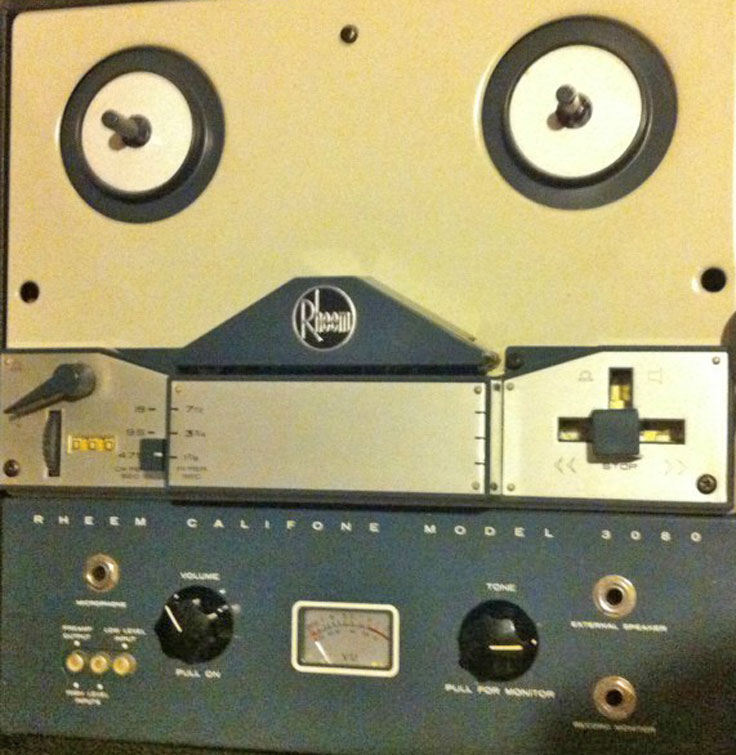 
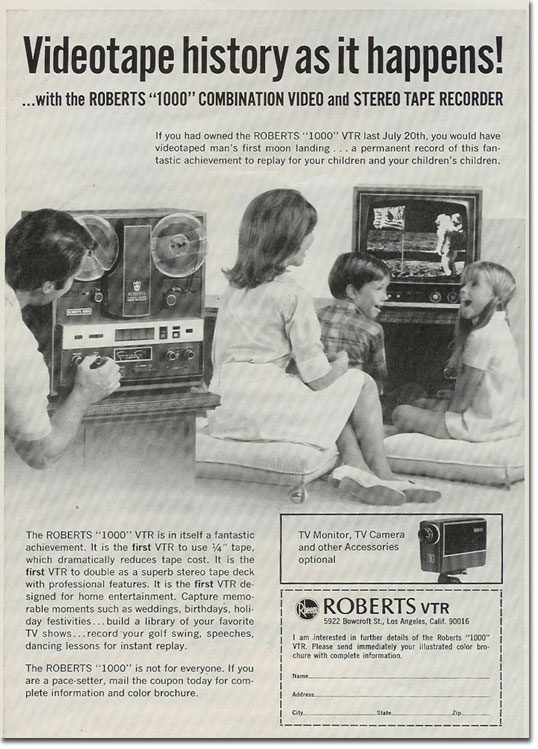  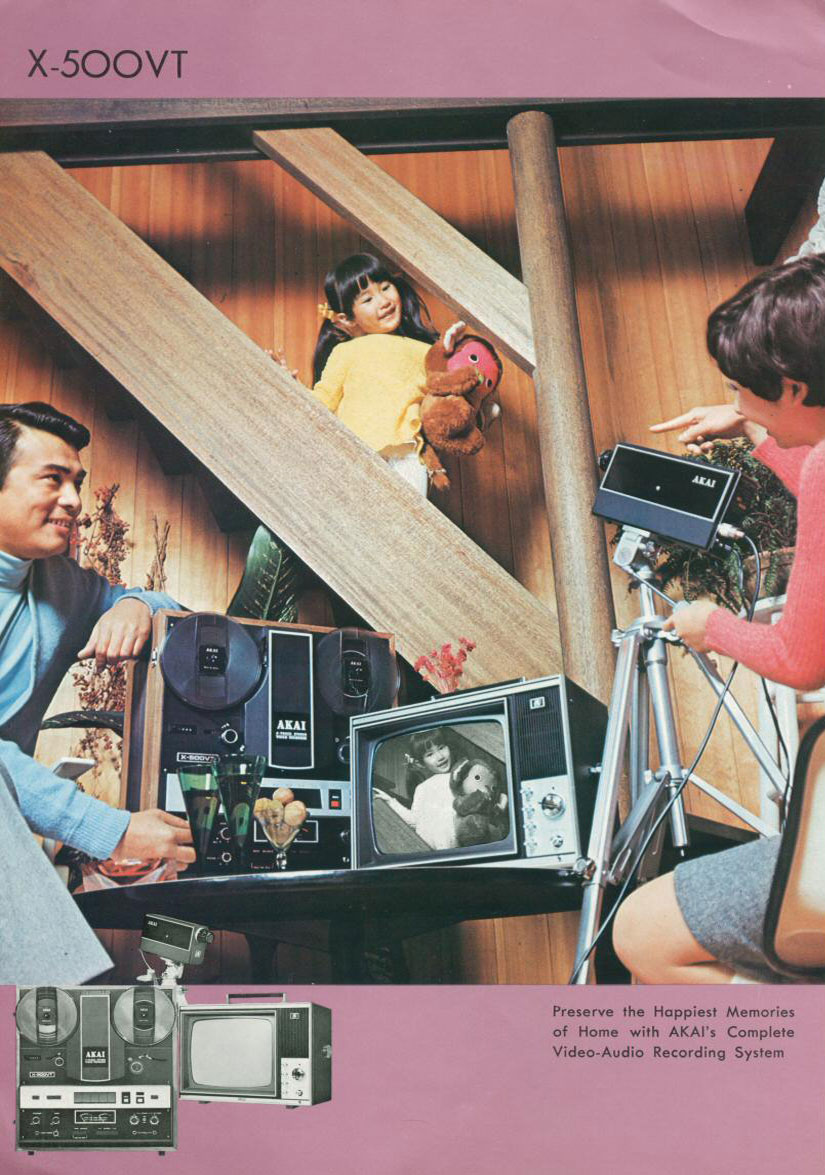 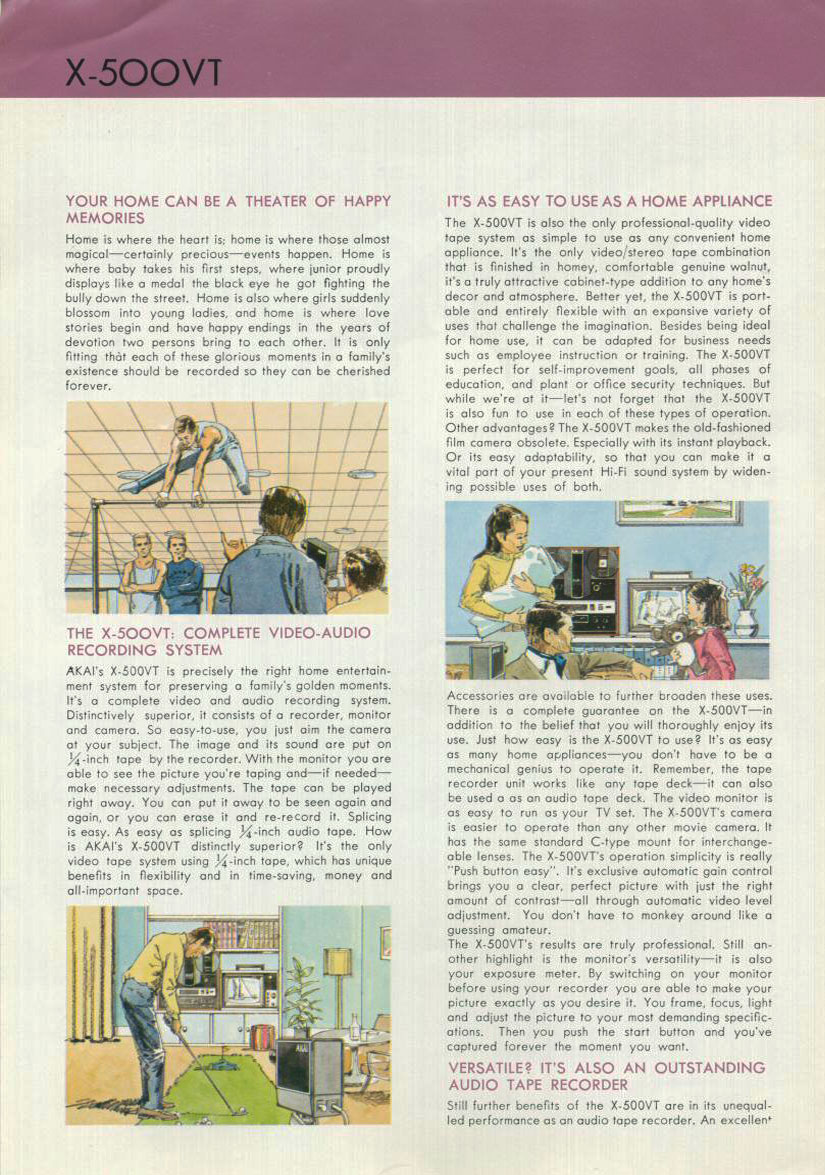 
Rheem Roberts and Akai also released the Rheem Roberts 1000 which was a 1/4 track stereo auto-reversing audio reel to reel tape recorder with a built in black & white video tape recorder. It used the same 1/4" tape and when the tape was re-threaded would record and playback B&W video. Built by Akai, it was released under the Akai brand as the X-500VT

Robert G. Metzner Tape Mechanism Patents
Robert G. Metzner holds a total of 12 patents. Included are the reverse dial mechanism on the Roberts 400X (right). He also patented and licensed to Akai the Roberts 333X technology that combined reel to reel, cassette and 8-Track into one tape recorder (left) VIDEO
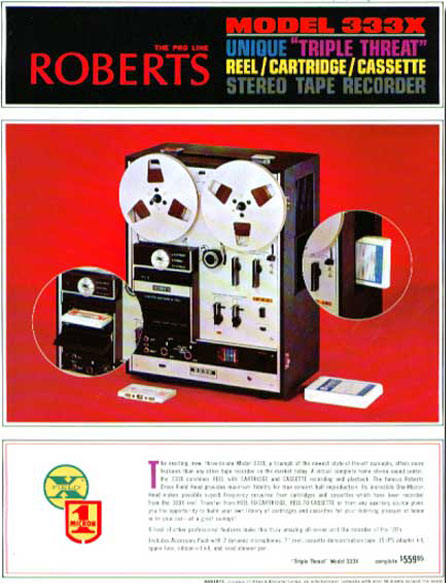 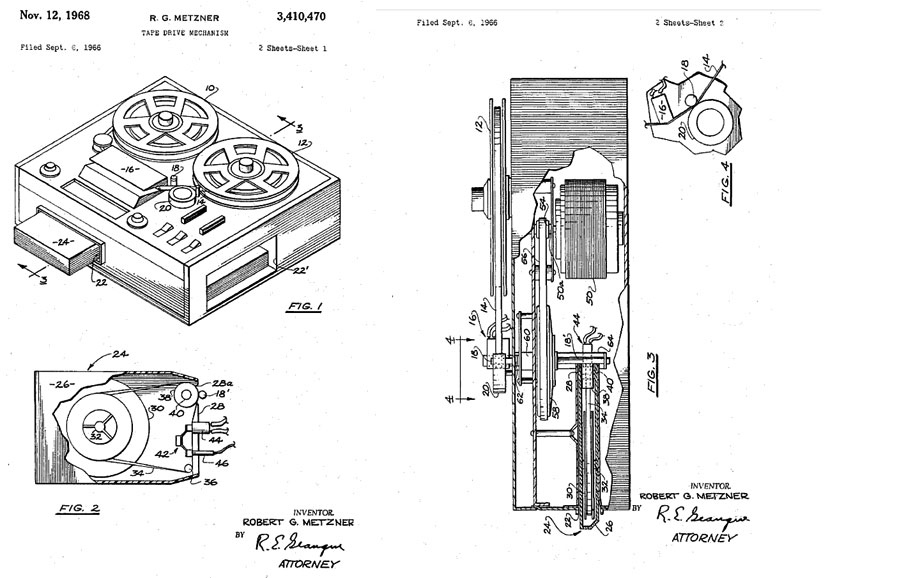 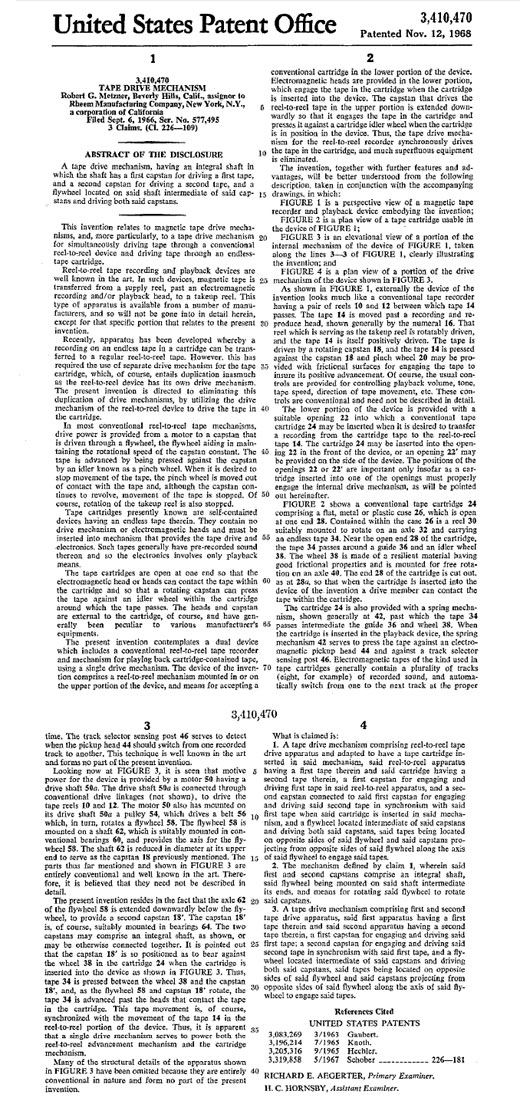
Akai Begins US Sales
Billboard July 3, 1971 - "Akai America will introduce a full line of tape players Sunday (27) at the Consumer Electronics Show, The Califone-Roberts division of Rheem Manufacturing Co. has entered into an agreement with Akai Electric Co., Ltd. of Japan that will allow certain tape products to be sold in the U.S. under both the Roberts and Akai brand names.
Under terms of the agreement, Roberts will continue to market the major part of the Akai made products under the Roberts label on an exclusive basis. 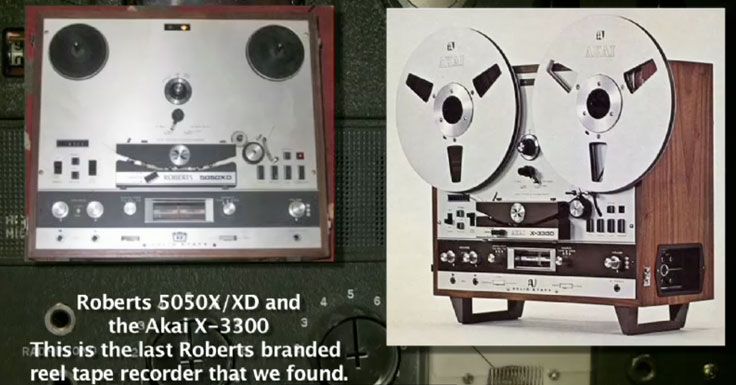
"The benefits to both parties this new agreement are numerous and mutually desired,." said Roberts president C.R.Phillips. From 1974 to 1985, Mr. Phillips was Executive Vice President and Director of Akai America, Ltd.,
The last Roberts reel tape recorder we found was sold in 1973. It was the Roberts 5050X/XD.
Other Patents
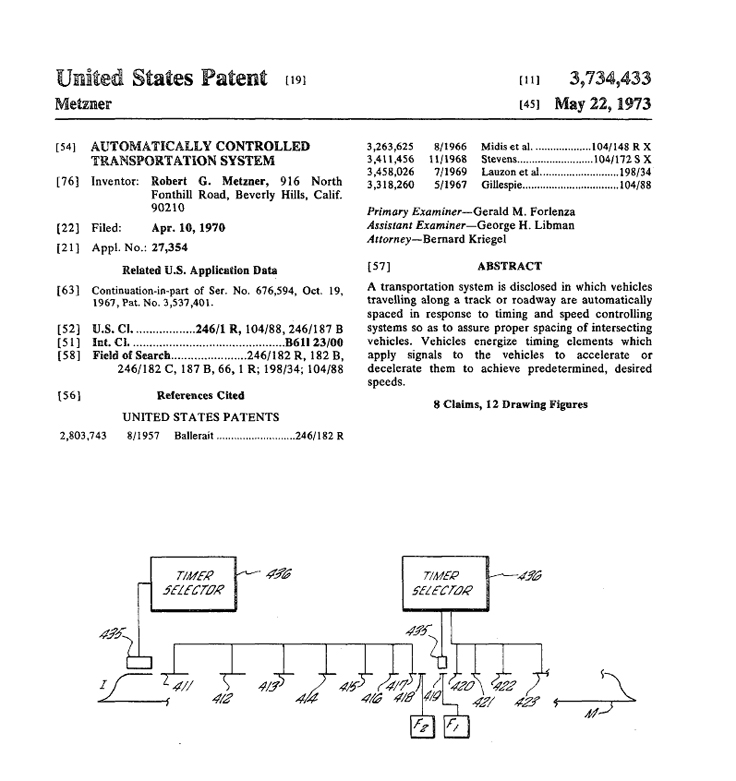 That same year (1973) Robert Metzner patented an automobile speed and timing spacing transportation system. (Photo to left). Work on this began back in 1949 with his young son (Dr. Richard Metzner) with the plan to embed steel rods under streets that would interact with magnetic technology in the car to direct the car to a destination without a driver participating. That same year (1973) Robert Metzner patented an automobile speed and timing spacing transportation system. (Photo to left). Work on this began back in 1949 with his young son (Dr. Richard Metzner) with the plan to embed steel rods under streets that would interact with magnetic technology in the car to direct the car to a destination without a driver participating.
He is known as the inventor of the Metzner Starlight turntable (below). This work on turntables was influenced by Metzners interest in the Japanese Akai motors. VIDEO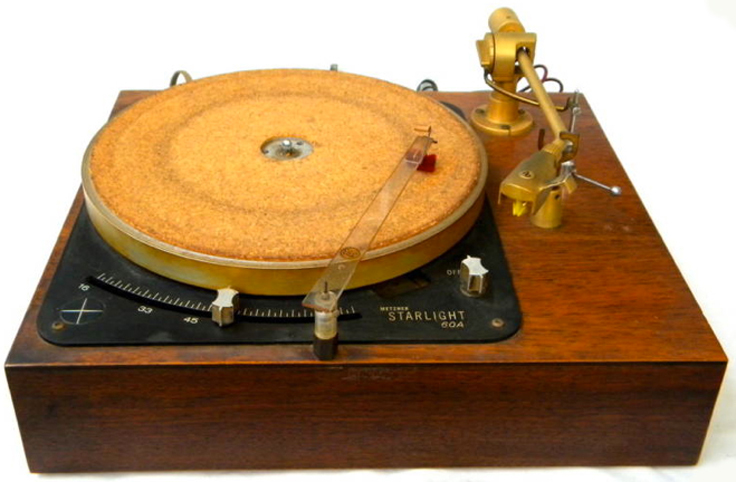
Robert G. Metzner's Hybrid Automobile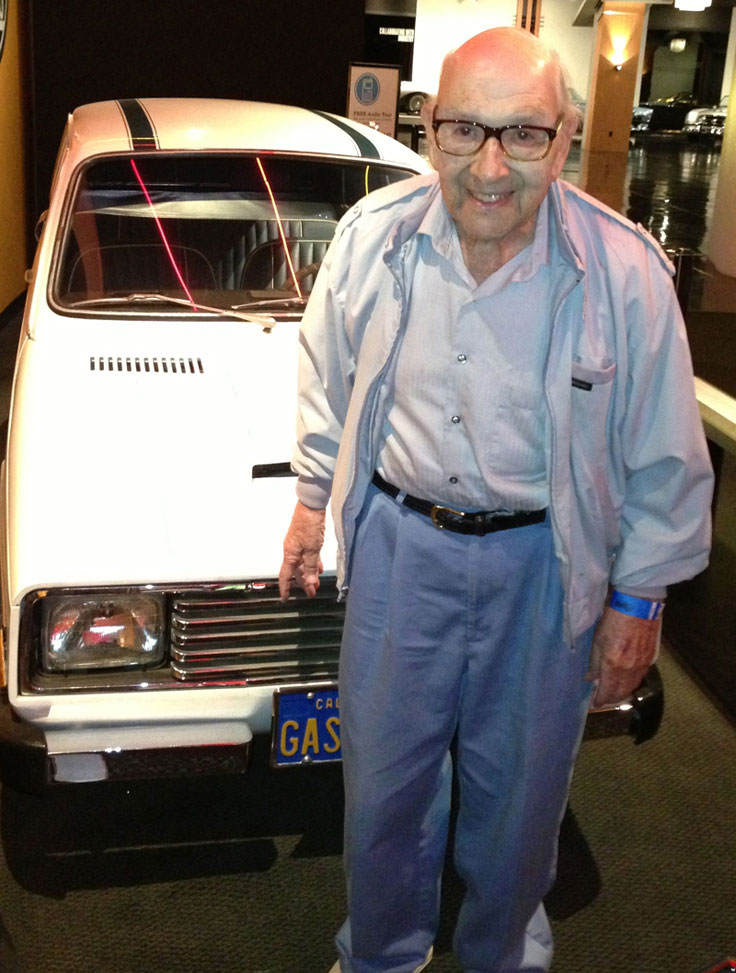 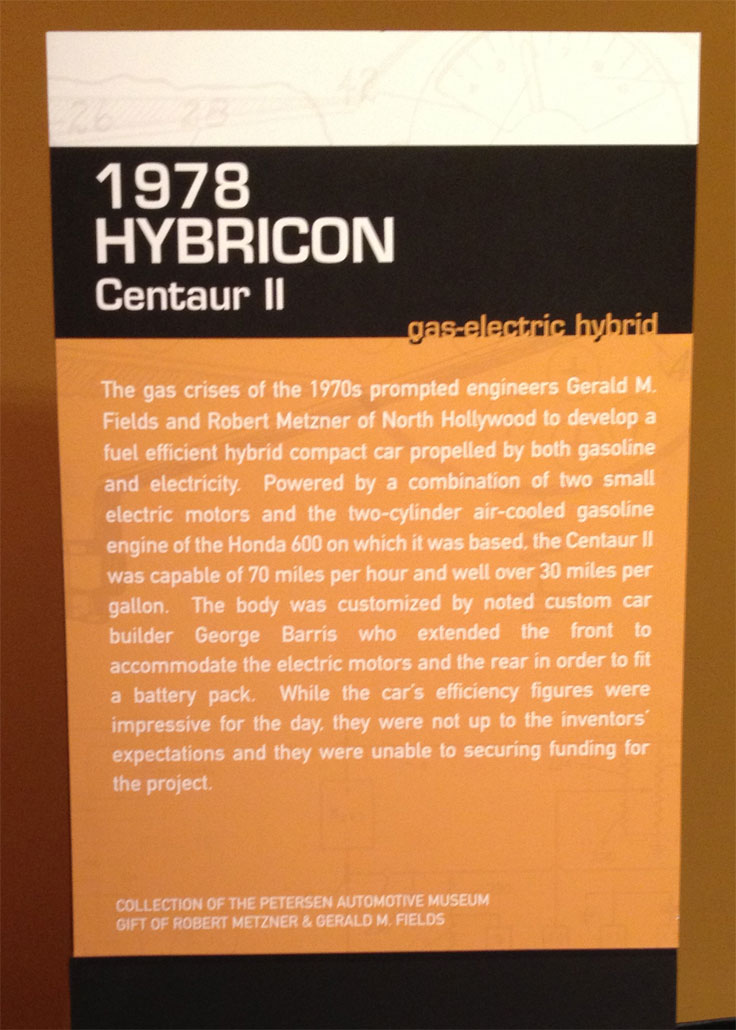
Hybrid Hybricon Centaur II
After selling part and then all of Califone and Roberts Recorders to Rheem, Robert G. Metzner continued with the company and contributed many more innovative electronic designs. He was creating in a number of other areas as well. He built a hybrid car with Gerald M. Fields. The car technology was patented as the Hybrid Hybricon Centaur II in 1978. This was an electric/gas automobile which functioned like the Toyota Prius. In 1978 Metzner drove the car to Detroit and spent several days demonstrating it to the big three auto manufacturers. They all turned it down as impractical given the low price for gas back then. Mr. Metzner told us that the year after his patent expired, Toyota began their work on the Prius.
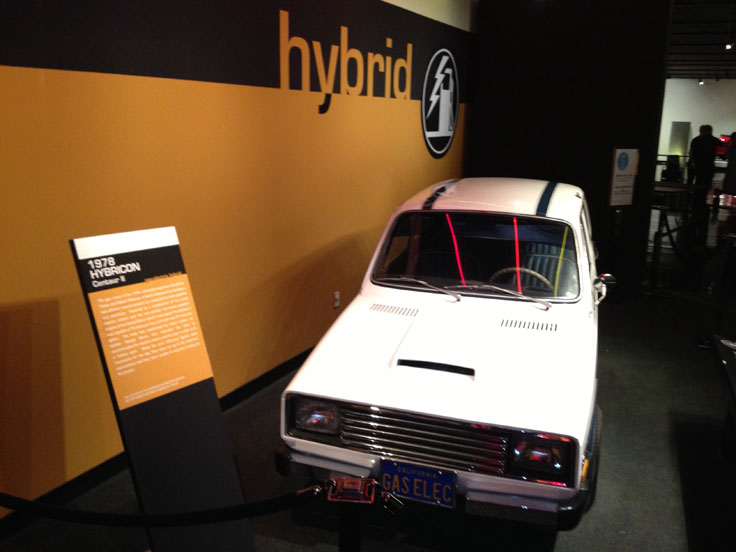 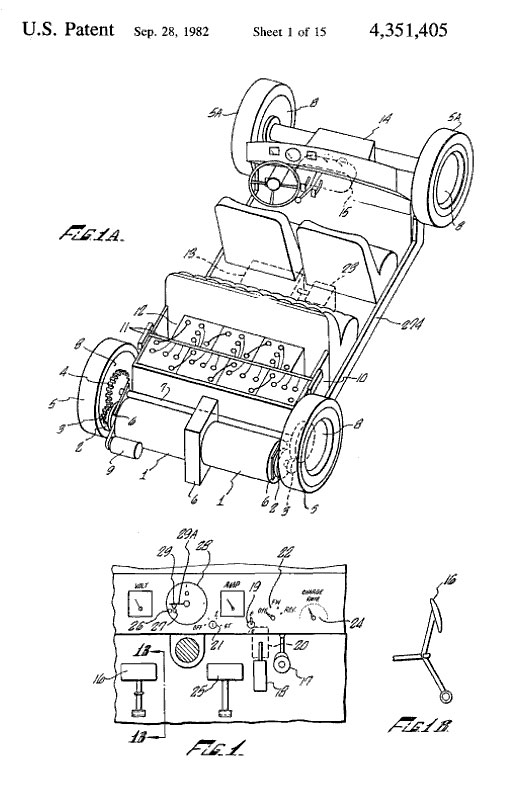 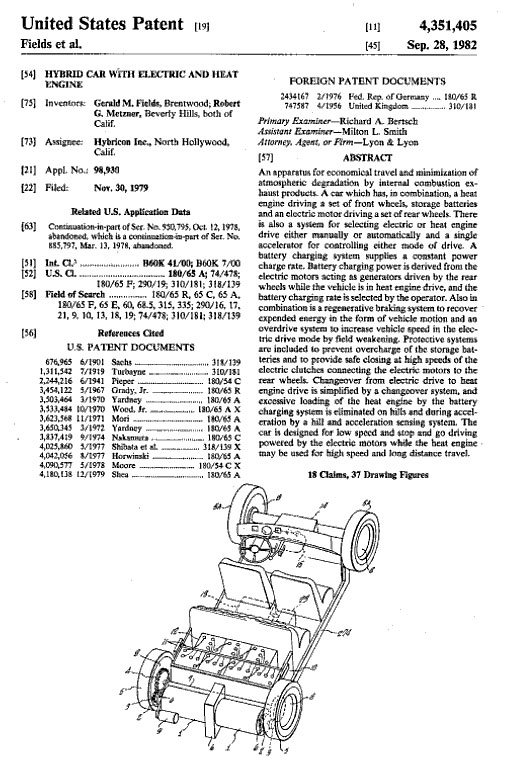 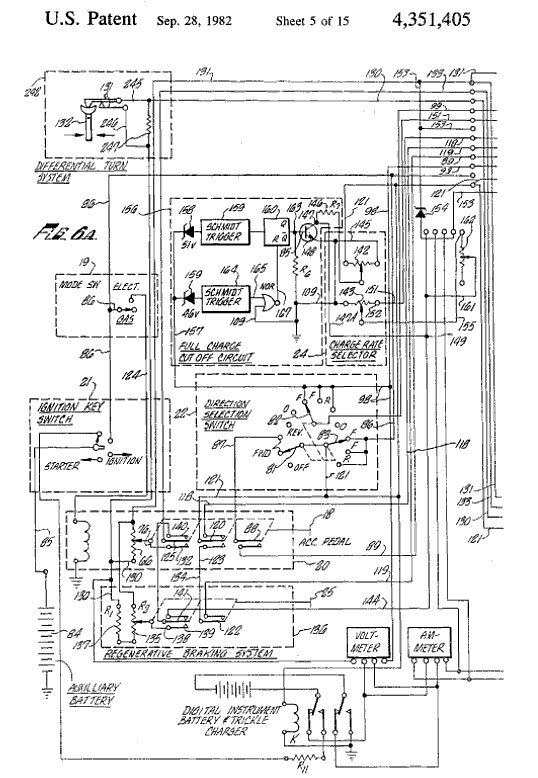 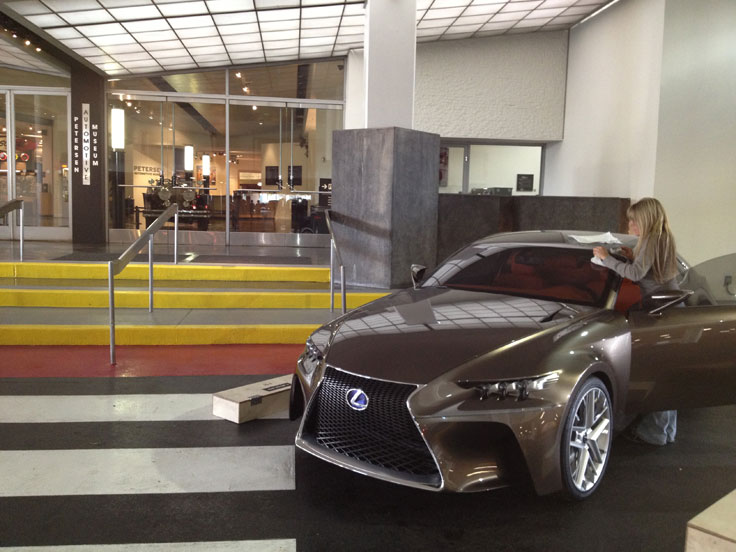
Chris & Martin Theophilus visited the Peterson Automotive Museum in LA where Metzner donated the hybrid car. VIDEO
Robert G. Metzner's wife Esther took a sculpture class and the process greatly interested Robert. Over the years he built numerous beautiful sculptures some of which are on permanent display at Caltech and UCLA. Many more intricate sculptures are displayed around their home.
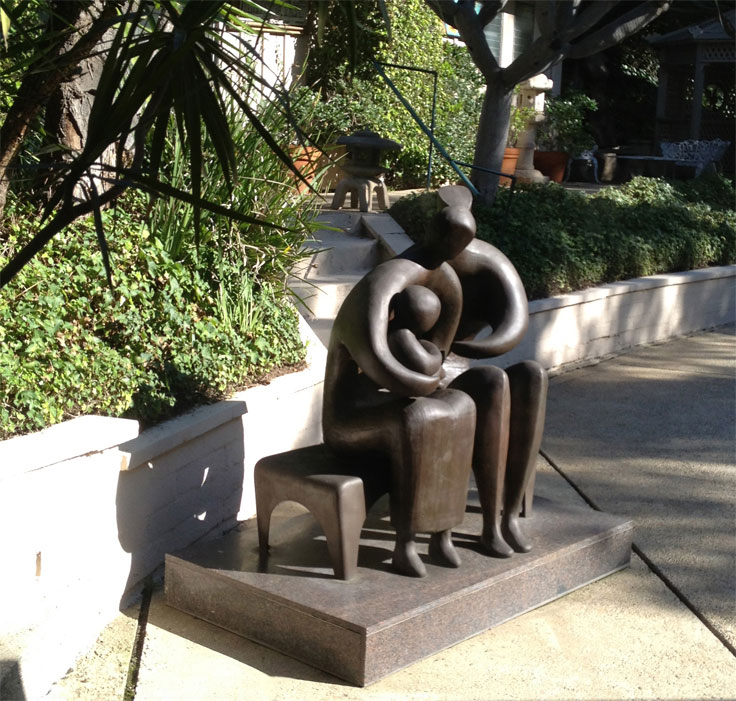  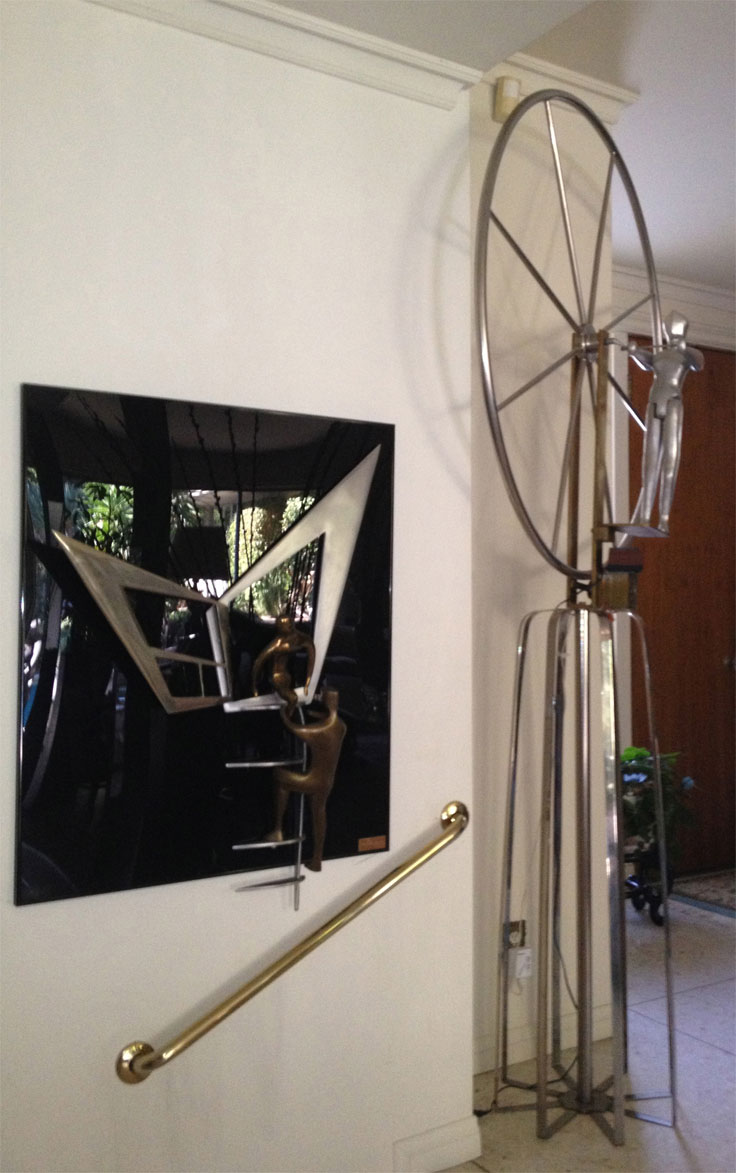 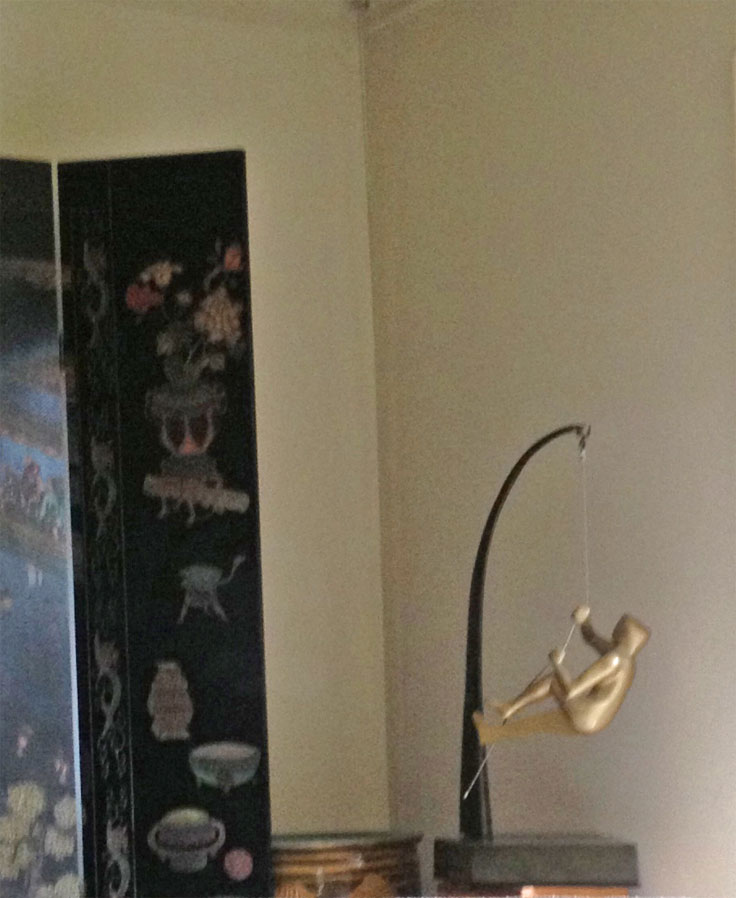 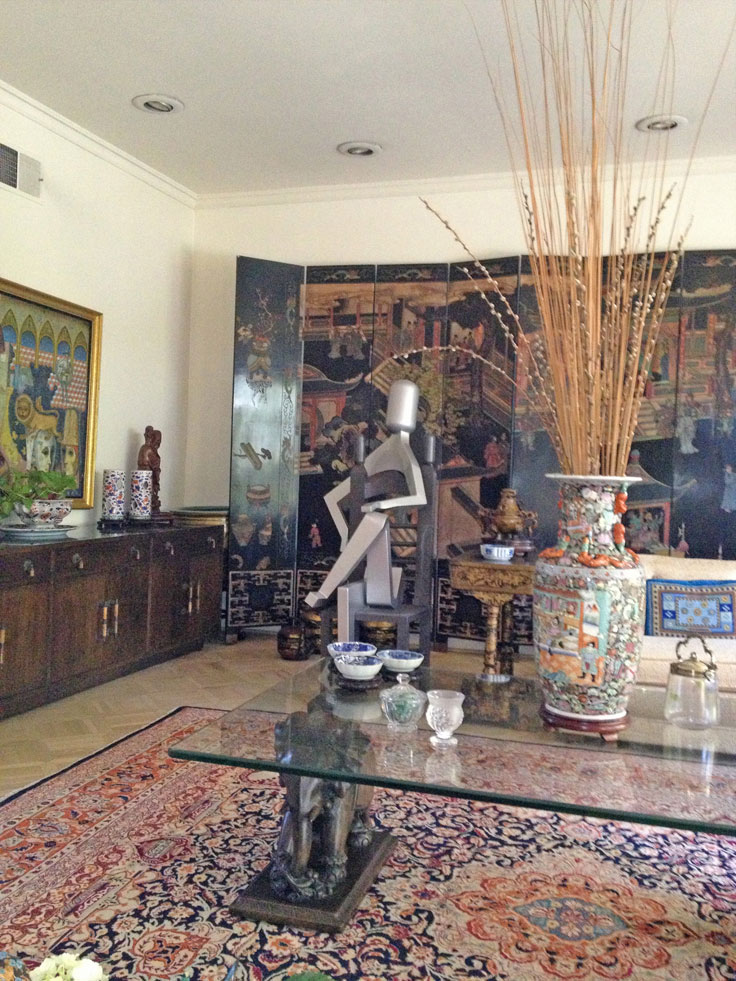 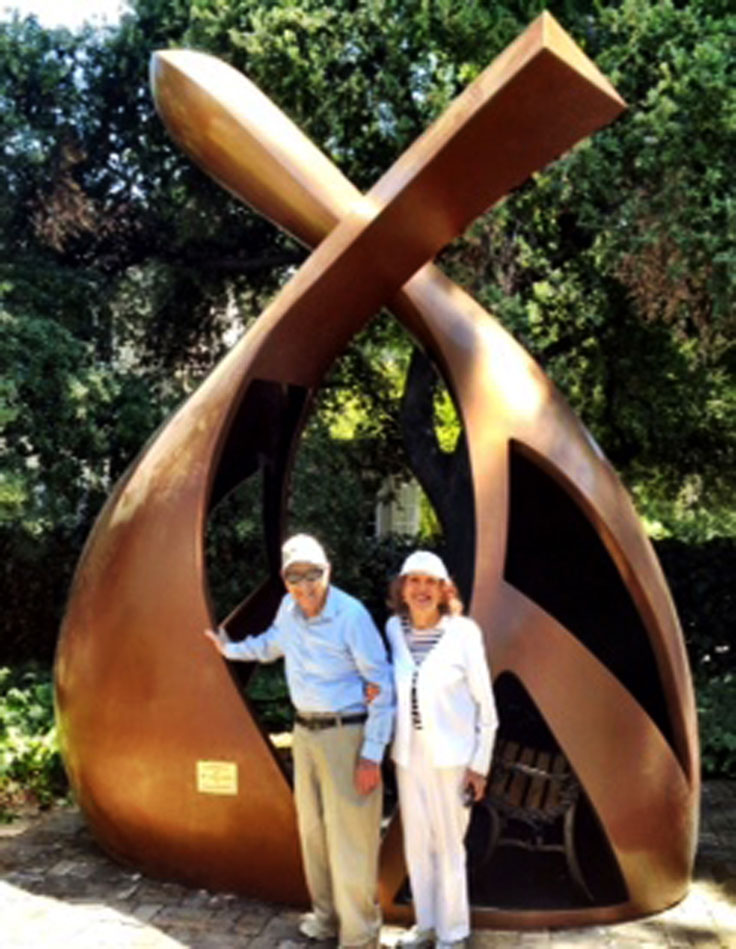 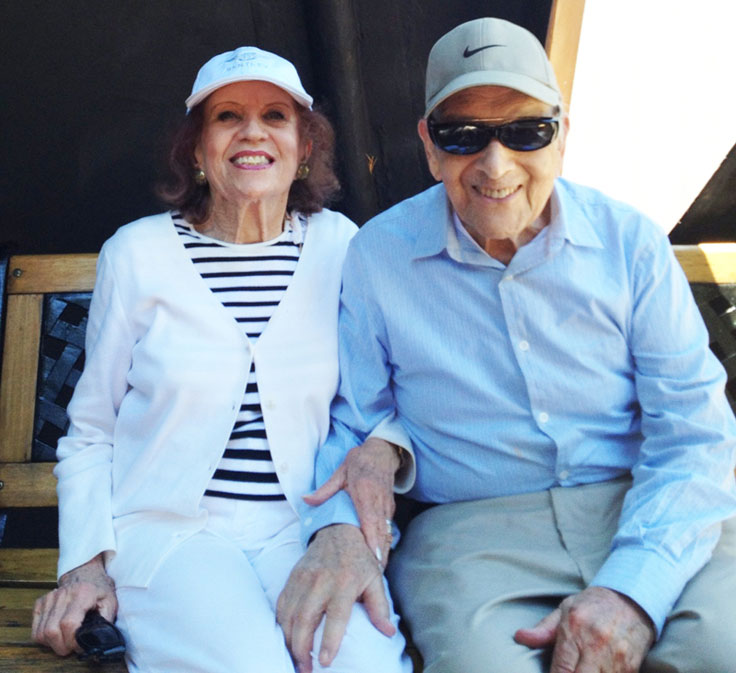
Esther and Robert Metzner with Robert's sculpture "Convergence" VIDEO
More about the Roberts Akai connection:
(from the Akai prepared history summary) By 1948, Akai had started producing and selling phonograph motors. At this time recording technology was changing rapidly and there was demand for higher precision record players. Akai responded to this demand by continually upgrading the technology of their phono motors.
By 1951, they had developed the C-5 Variable Speed Motor, which produced minimal noise and vibration and proved extremely popular with audio enthusiasts of the period.
The C-5 aroused considerable interest in the US as well and this led Saburo to change his market perspective.
In 1953-4 Akai was one of the few medium sized companies to export goods without going through a wholesaler. Saburo had advertised in the American technical journal "Electronics." The headline "Why not buy Akai technology?" generated inquiries from 5 interested companies. (story differs a bit, however Akai may have thought the inquiry came from the article instead of Metzner's direct motor inquiry)
One of these companies was a producer of audiovisual equipment for education, Roberts Electronics founded by Robert G. Metzner.
The company presented Saburo with overwhelming demand for anything Akai was producing and business expanded rapidly for both as Roberts Electronics began using Akai products.
Then in answer to a query from Akai about how their products were being used, Roberts sent back a tape recorder.
Technicians at Akai looked over the model, made one of their own and quickly sent this back to their US client. Roberts replied in no time.
Roberts asked Akai to manufacture the completed tape recorders and said that they would take charge of sales.
In 1954 Akai made its first foray into the tape recorder field by bringing out the AT-1 model, a tape recorder kit. This was followed in 1956 by their first independently developed tape recorder, the 900.
The model was well received and orders started coming in fast.
Saburo decided to take a trip to the U.S. to further study the market. He was completely taken aback by the immense market he found there, and returned to Japan with the realization that if you had a good product, you could be sure of selling it in America.
From then on the firm focused on expanding their facilities and gearing their production towards improving quality.
In 1957 Akai unveiled a deluxe version of its high grade tape recorder. With the deluxe stereo model which was brought out the following year, Akai had acquired a firm position in the domestic market. In the same year, Saburo took over from his father as president.
Although well established in terms of capital and selling power by 1960, the firm had concentrated on investing the market with low-price tape recorders through its volume production system. Akai was now at a turning point. The company would no longer view the tape recorder as simply a machine for the production of sound; the tape recorder was to be refined as a device for the pursuit of sound quality.
Throughout the early '60's Akai produced models that made their reputation as a premier producer of audio tape recorders.
In the US, OEM-supplied Akai products were being marketed under the Roberts brand name. Despite the wide range of tape recorders available from US manufacturers, Akai sales were exceptionally high. On the strength of this success, Akai decided to expand its sales network into other countries, first moving into Southeast Asia and then the Middle East and Europe.
Akai debuted the M-7 model tape recorder in 1962 and its successor the M-8 in 1964. Equipped with the then new X'Field magnetic recording system (licensed to Akai by Tandberg), these two models gave superior frequency response which resulted in a vast improvement in tape economy.
Together the M-7 and M-8 (Roberts 770X) recorded sales of over 160,000 units in four years and thus established Akai in an unshakable position in the tape recorder field. The X'Field Head development brought Akai sudden world renown, and the company went on to produce many top selling models.
Akai halted production of open reel decks in 1985 after the release of the GX-747, thirty one years after Akai had begun sales of its AT-1 tape recorder kit. To take the place of open-reel deck production, Akai poured all of its energies into the development of cassette decks.
|
| |
Sansui Electric Co., Ltd.
A Japanese manufacturer of audio and video equipment. Headquartered in Tokyo, Japan, it is part of Grande Holdings, a Chinese Hong Kong-based conglomerate, which also owns Japanese brands Akai and Nakamichi.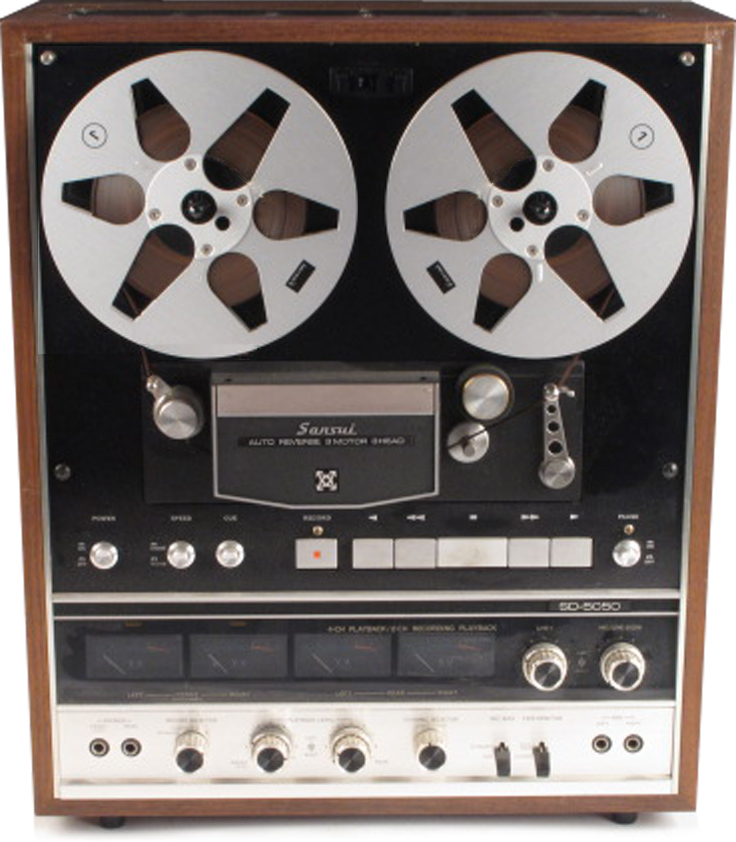
Founded in Tokyo in 1947, Sansui initially manufactured transformers, but by the 1960s had developed a reputation for making serious audio components. They were sold in foreign markets through that and the next decade. Sansui's amplifiers and tuners from the 1960s and 1970s remain in demand by audio enthusiasts.
In the UK around 1982, the Sansui AU-D101 amplifier and its more powerful sibling the AU-D33, were highly acclaimed by audiophiles and were so well matched to a pair of KEF Coda III speakers that they could be bought as a set from some outlets. These amplifiers used a complex feed-forward servo system which resulted in very low 2nd order harmonic distortion. Despite this success, Sansui completely failed to follow up with further mass market audiophile components.
As the mid 1980s arrived, sales were lost to competitors (Sony, Pioneer, Matsushita's Technics).[citation needed] Sansui began to lose visibility in the United States around 1988, and then focused on manufacturing high-end components in Japan. The company began to manufacture high-end television sets and other video equipment, but ceased exportation. In the late 1990s, the company's brand was used on video equipment manufactured by other companies. The current manufacturer of the rebranded sets as Orion Electric, based in Osaka and Fukui, Japan. Its U.S. subsidiary markets products under the Sansui brand, among others. Sansui is thus a mere umbrella brand at present. This radical change in Sansui's corporate identity has resulted in a notable change in its product quality as consumers now tend to consider Sansui a mass-market brand rather than a maker of high-end electronics.
|
| |
Scully 
Scully Recording Instruments founded by John J. Scully & his son Larry Scully - 1919 to the mid 1980's
Phantom Productions, Inc. does not not have a Scully recorder in the collection. However we are including this segment to profile the US built recorder's significance in the market.
The following excerpts are from "A Brief History of the Scully Tape Recorders," comments by their Sales Manager Ham Brosious and other sources listed in the credits.
Scully Recording Instruments was a major manufacturer of professional audio tape recorders and other equipment based in Bridgeport, Connecticut from 1919 to approximately 1974.
The Scully Lathe was designed by John J. Scully (who originally was from Ireland) and his son Lawrence Scully. John J. Scully worked for Columbia Records from 1915 to 1919. In 1919 in his machine shop he produced a recording lathe.
Larry Scully founded Scully Recording Instruments in Bridgeport Connecticut as a builder of disc cutting lathes. He was a gifted machinist and designer.
Business went well and Scully dominated the marketplace for lathes from the 1930's to the 1960's. Almost all major lacquer masters were cut on a Scully Lathe.
When Neumann lathes arrived in the US, it became clear that Scully had a problem and the decision was made to enter the tape recorder market. John Mosley enabled Scully to move to tape recorders.
Scully Raised $300,000 & bought parts for 500 recorders at a cost of $270,000. The first recorder was named the 270 (based on the $270,000) by their Sales Manager Ham Brosious.
The Scully 270 was a long play machine with 14" reel capacity and auto reverse. It was used for logging, background music and automated radio stations.
Scully had overbought parts for the machine. The machine sold, but not nearly fast enough to use up the huge parts investment in a reasonable amount of time, so the decision was made to design and build machines for the music and broadcast industries.
Dan Cronin, chief engineer at Bell Sound was contracted to design the Scully 280 with a mandate to use up the Scully 270 parts. Cronin had already designed the playback amp which had been used in the Scully 270. He used that playback amp and whatever he could from the Scully parts inventory to come up with the Scully 280 in 1965.
Arthur Gruber, son of one of the founders of Presto Recording Corporation, worked in the 1950’s designing the tape transport system of the Presto 800 recorders. Presto was absorbed in corporate mergers and eventually closed down. So, Gruber and several other engineers went to Scully to design the Scully tape recorders. Arthur was chief engineer and vice president of Scully from 1961 to 1968.
Scully's newly developed transports had several innovative features. Instead of Ampex' gate cover / tape lifter, Scully's had a handle that actuated the tape lifter and retracted the playback head shield. The shield could also be locked in the retracted position. People who edited tape immediately took to Scullys.
In 1966 many recording studios were looking to upgrade to 1" 8-track. Although Ampex had invented Sel-Sync and built the first 1" 8-track (Les Paul's "Octopus") and several others (Tom Dowd at Atlantic) as special orders they still didn't "get" the idea of 1" 8-track music production.
Scully positioned themselves to gain this market and entered it aggressively in June of 1966.
Scully 1" machines used the 284 transport, a beefed up version of the 280 with 12" reel capacity (compared to 10" max on AG300), automatic tape lifters and motion sensing (not offered on AG300).
Electronics for an 8-track 280 (Scully 284-8) with sync repro took up 16U of rack space. Those for an AG300-8 took up 28U.
Scully offered the Sync Master remote control, designed by chief engineer John Curtis, which allowed switching of channel safe/sync/repro and transport control at the engineer position. Ampex offered no such device until the introduction of the MM1000 in 1968.
The company was sold in the late 1960s and after staying on for five years both the Grandson Jerry and his dad joined forces to create LJ Scully. They stayed in business together until 1988.
The founder John J. Scully passed away in 1989. Larry & Jerry produced play-back machines as well as their own lathe in later years.
Scully was purchased by Dictaphone in 1967 but apparently operations continued as before. By the end of that year, Scully was a major player in the studio market when it introduced 1" 12-track (284 transport) and later, 2" 16-track machines (288 transport).
From 1967 to 1969, 1/4" 2-track and 1" 8-track machines were Scully's best sellers.
3M sent all multitrack recorder manufacturers scurrying in 1969 when it introduced the M56 16-track machine.
Scully chose to compete with price. In 1970, a 16-track machine cost around $15,000. The Scully 100 was introduced in 1971 utilizing the same transport as the 16-track 288 with new central 16-track electronics designed by William Dilley of Spectrasonics. By eliminating the repro head and using one high quality narrow gap head for both record and repro, the expense of repro / sync switching circuits was eliminated. The Scully 100 list price was under $11,000.
Scully's share in the disc lathe market continued to be challenged by Neumann's integrated systems. At this point, Dictaphone decided to move manufacturing of the tape recorders to Mountain View California. A machine that had been built in Bridgeport Connecticut began to be referred to as a "Bridgeport Scully".
Scully backed out of the multitrack market before 2" 24-track caught on and concentrated on the broadcast market developing an updated 1 to 8-track machine, the 280B.
Though an excellent machine that built on the reliability of the 280 transport with new low noise electronics, the 280B entered a market that now had MCI JH110, Ampex AG440, 3M M79, Studer B67 and early entries from Tascam and Otari.
Sales never took off, and after several years of mismanagement, Dictaphone eventually sold it to Ampro who apparently closed down thereafter.
Presumably, when Larry Scully's non-compete with Dictaphone ran out, he made a brief return to the market in the mid '80's with the very sophisticated Scully LJ-10 and LJ-12. But, they never had a chance competing in a market that now had Sony owning MCI.
|
| |
Sony/Superscope 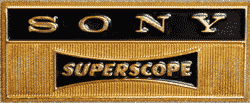
Sony
1-7-1 Konan, Minato-ku, Tokyo 108-0075, Japan
Founded May 7, 1946
Superscope Technologies, 1508 Batavia Avenue, Geneva, IL 60134, founded 1954
 Akio Morita (right) - Sony founder , Born January 26, 1921, Nagoya, Aichi – Died October 3, 1999, Tokyo Akio Morita (right) - Sony founder , Born January 26, 1921, Nagoya, Aichi – Died October 3, 1999, Tokyo
Sony found its beginning in the wake of World War II. In 1946, Masaru Ibuka started an electronics shop in a bomb-damaged department store building in Tokyo. The company had $530 in capital and a total of eight employees. ] The next year, he was joined by his colleague, Akio Morita, and they founded a company called Tokyo Tsushin Kogyo (Tokyo Telecommunications Engineering Corporation). The company built Japan's first tape recorder, called the Type-G. In 1958 the company name was changed to Sony
Sony remains one of the world’s largest media conglomerates, with over 158,000 employees worldwide and revenues in excess of US $63 billion.
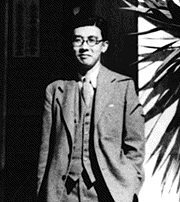 Masaru Ibuka (left), the co-founder of Sony Masaru Ibuka (left), the co-founder of Sony
Sony was founded May 7, 1946 as Tokyo Tsushin Kogyo, Ltd. with capital of only $500 US. The name "Sony" was chosen for the brand as a mix of two words. One was the Latin word "Sonus", which is the root of sonic and sound, and the other was "Sonny", a familiar term used in 1950s America to call a boy. The first Sony-branded product, the TR-55 transistor radio, appeared in 1955 but the company name did not change to Sony until January 1958.
Initial developments included an electric rice heater and an electric heating pad.
The Sony founders obtained a military wire recorder, as well as a Webster Chicago wire recorder from the US and began experimenting with recording.
However when they were able to see a demonstration of a WilcoxGay tape recorder used by the occupying forces, it was decided this was their future.
Sony tape and tape recorder products
In 1949 they concentrated on making tape and were successful after several experiments. Once they reviewed how a tape recorder worked at NHK, they created a prototype recorder in just one week
First Sony Tape Prototype called Soni-Tape - 1949. First Sony Tape Recorder Prototype1950
 In 1950, Tokyo Telecommunications Engineering Corporation (the predecessor to Sony) launched Japan's first tape recorder, the "G type." Called "G" type because it was sold mostly to the government In 1950, Tokyo Telecommunications Engineering Corporation (the predecessor to Sony) launched Japan's first tape recorder, the "G type." Called "G" type because it was sold mostly to the government
Spring wound "M" Type for professional broadcast work - 1950
In marketing the G-type tape recorder, Totsuko registered it under the trademark name of " Tapecorder" (Later Sony used "Sterecorder") This machine featured a tape speed of 19cm (7.5 inches) per second & 10 inch reels.
TC-301 was the first small tape recorder designed for the consumer market and was sold for 49,000 yen - $600 (the G type tape recorder launched 4 years before was sold at 160,000 yen -$2,600). It was this less-than 50,000 yen model that started the mass production of what until then were expensive products. Sony Corp.
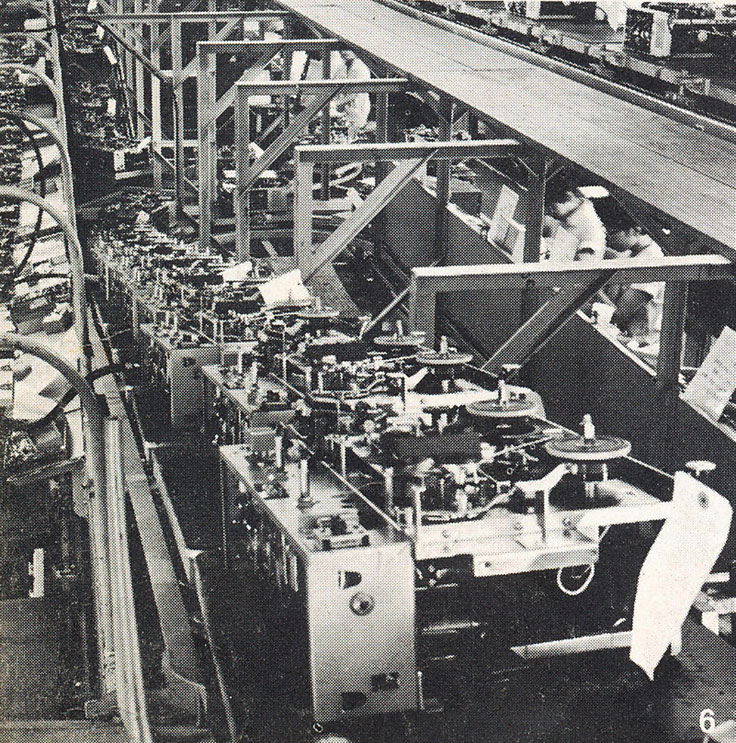 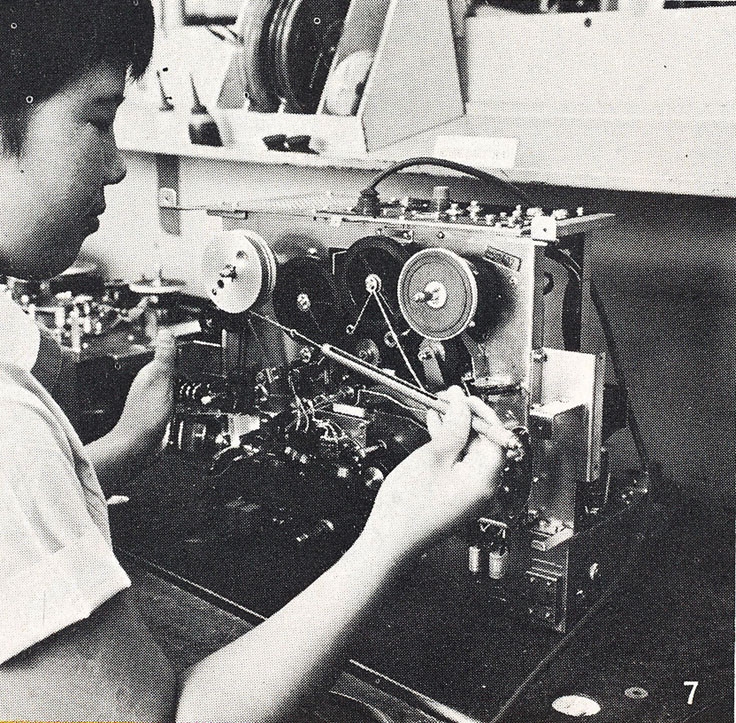 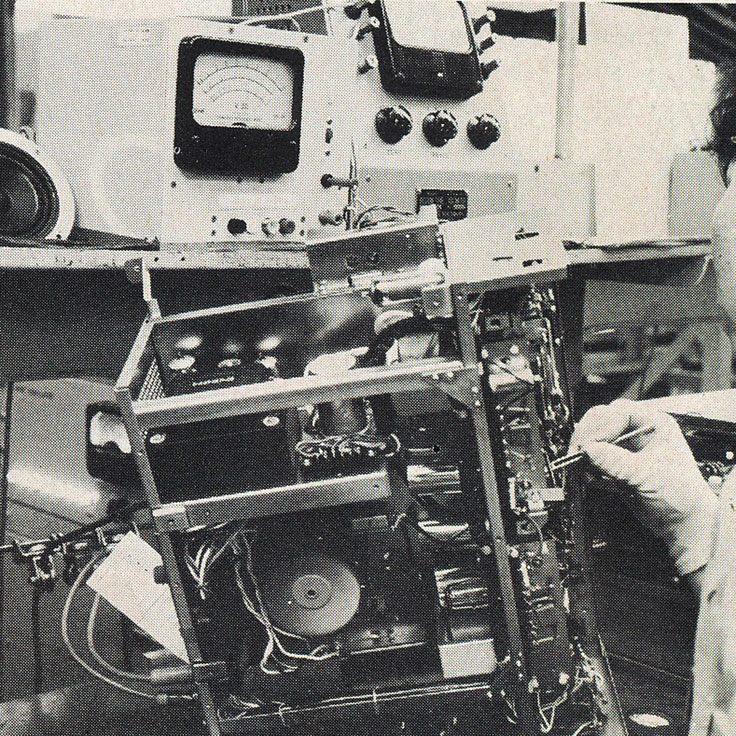 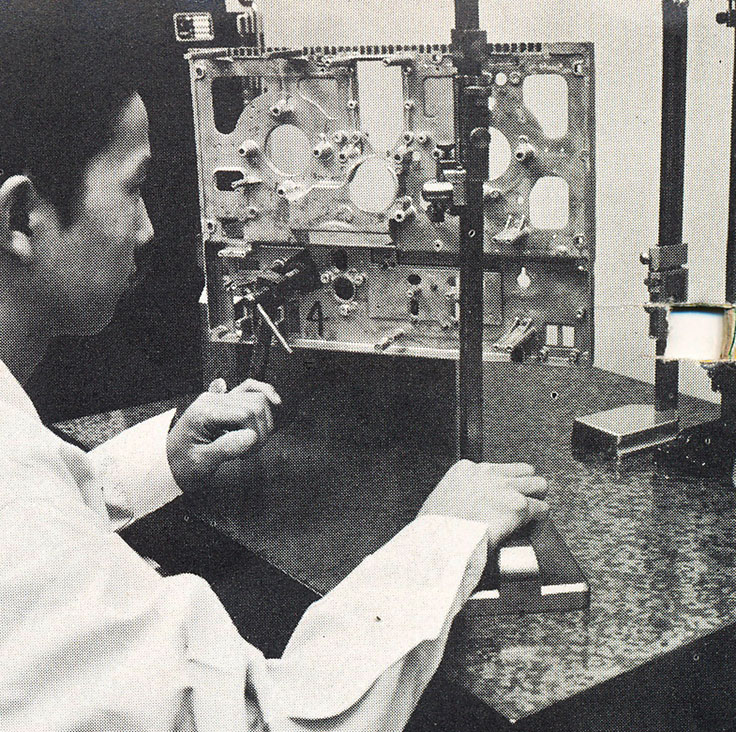 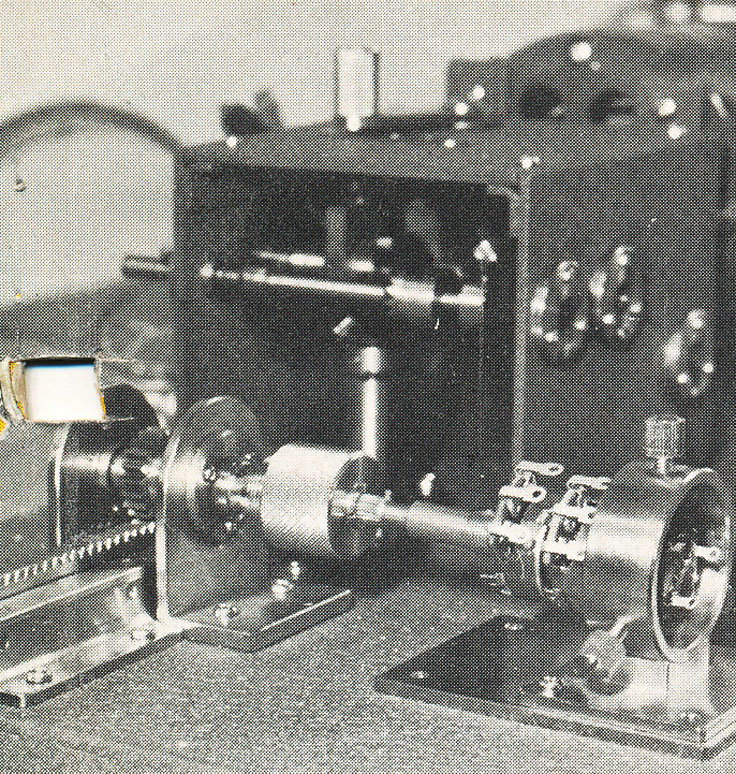
 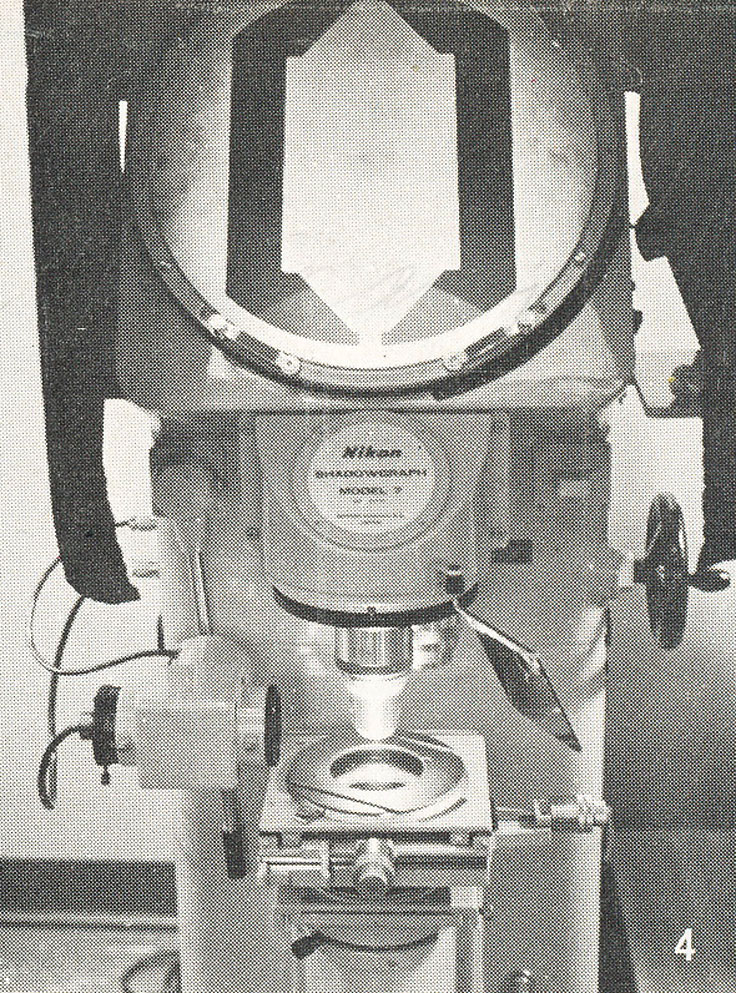 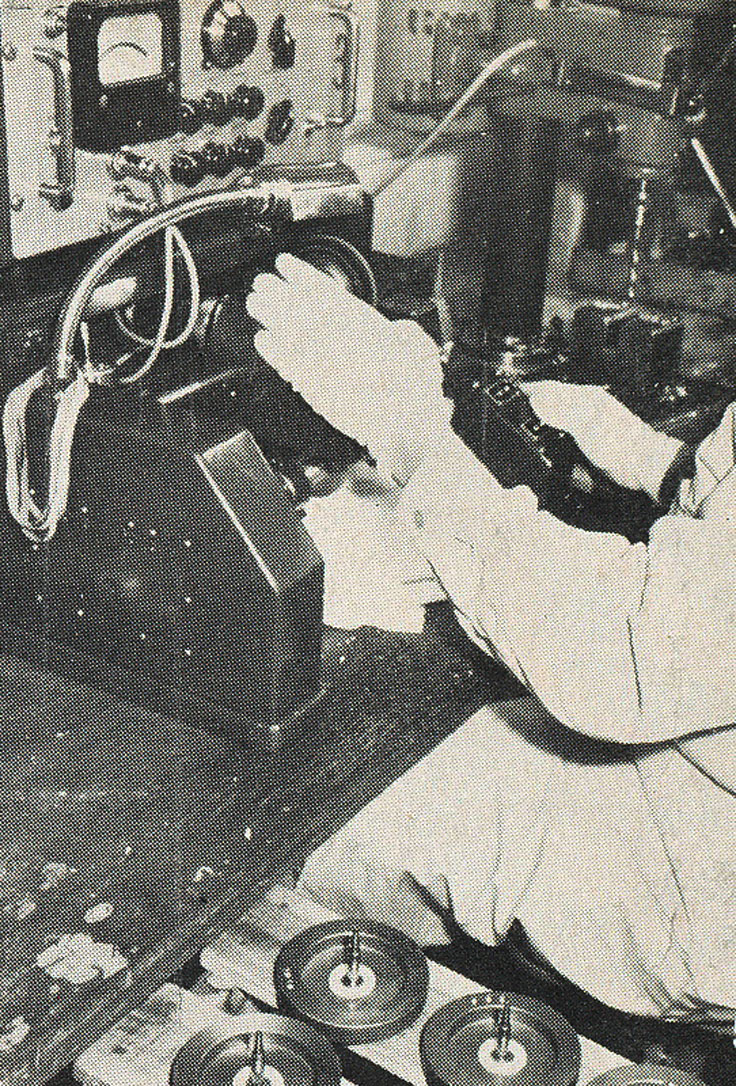 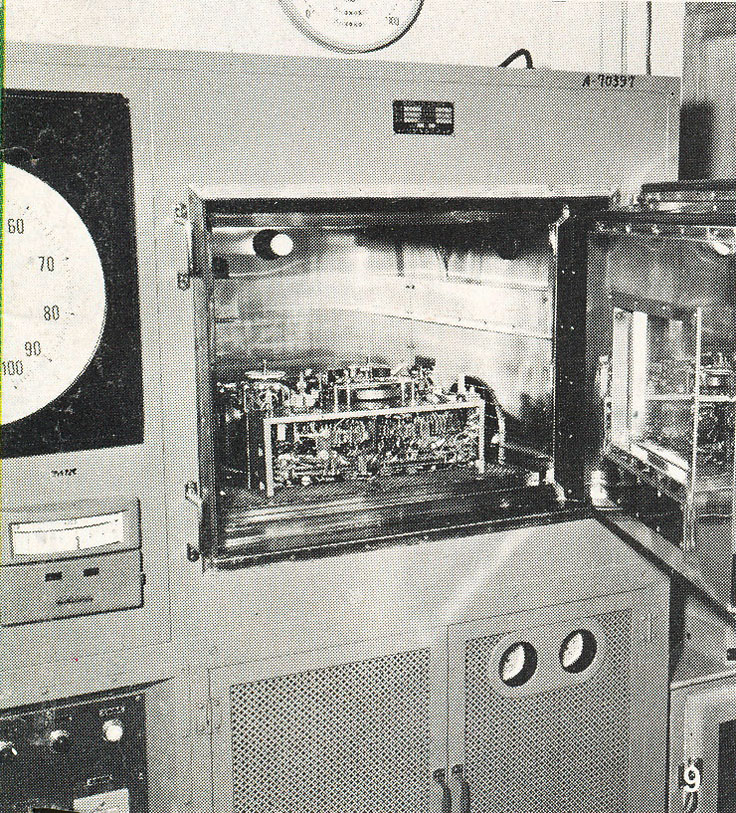 
In the early 1950s, Ibuka traveled in the United States and heard about Bell Labs' invention of the transistor. He convinced Bell to license the transistor technology to his  Japanese company, for use in communications. Ibuka's company made the first commercially successful transistor radios. Japanese company, for use in communications. Ibuka's company made the first commercially successful transistor radios.
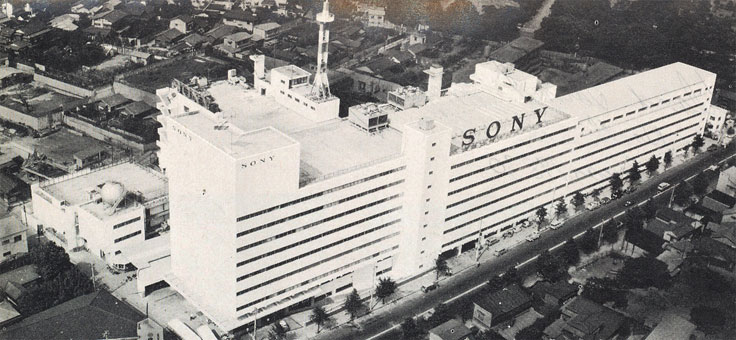 In 1957 the company's name was changed to Sony. One of the first Sony reel to reel recorders available in the US was the 553 shown here (right) and is also in the Museum of Magnetic Sound Recording collection. In 1957 the company's name was changed to Sony. One of the first Sony reel to reel recorders available in the US was the 553 shown here (right) and is also in the Museum of Magnetic Sound Recording collection.
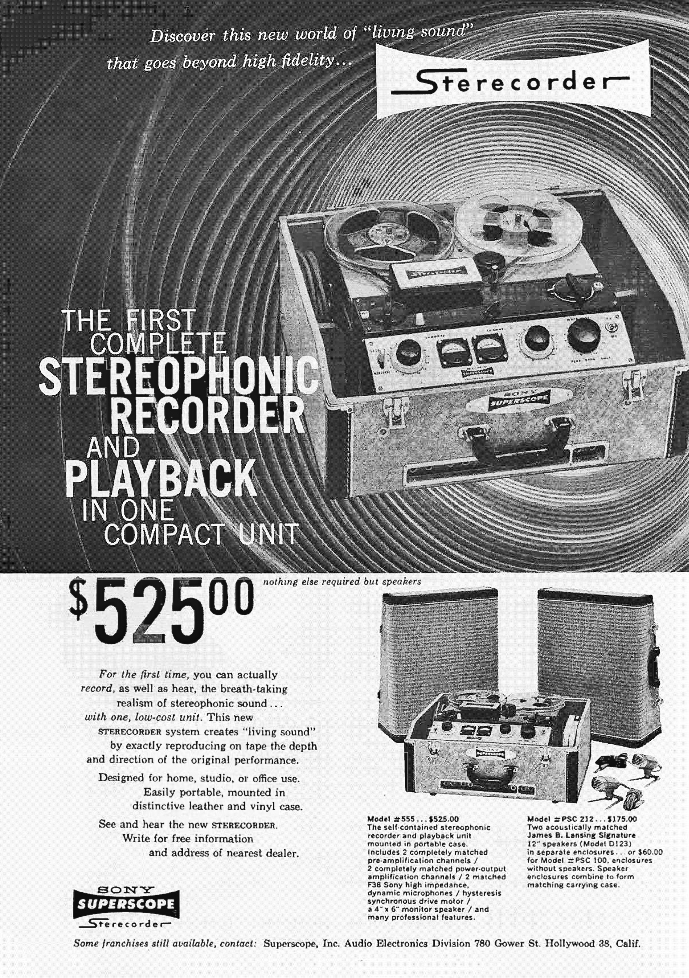
First US Sony Tape recorder ad we found was in the 1957 High Fidelity magazine for the Sony 555 (right)
Sony co-founder Akio Morita founded Sony Corporation of America in 1960.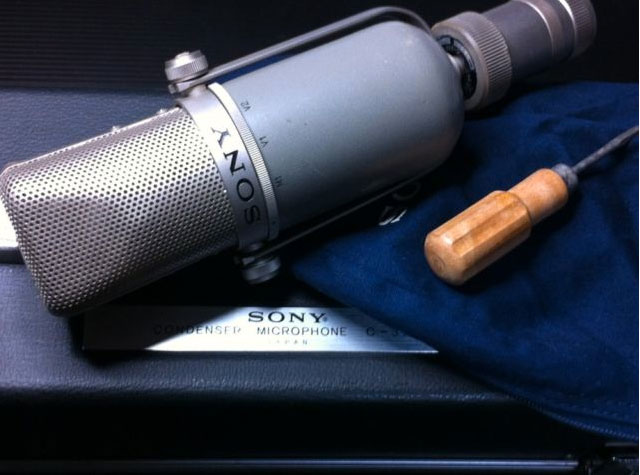
In 1961, the Sony Corporation of America became the first Japanese company to ever be listed on the New York Stock Exchange.
One of the most sought after Sony microphones is the Sony C37 shown at right.
In 1971, Masaru Ibuka handed the position of president over to his co-founder Akio Morita.
Sony launched the Betamax videocassette recording format in 1975
Sony Elcaset 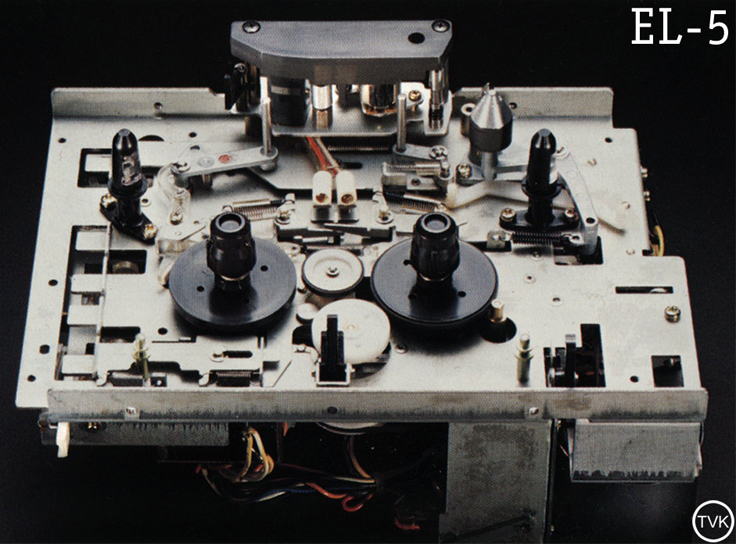
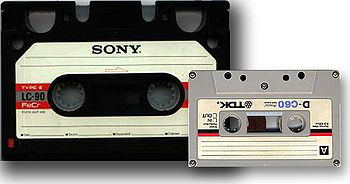 Elcaset was a short-lived audio format created by Sony in 1976, building on an idea introduced 20 years earlier in the RCA tape cartridge. Elcaset was a short-lived audio format created by Sony in 1976, building on an idea introduced 20 years earlier in the RCA tape cartridge.
In 1976, it was widely felt that the compact cassette was never likely to be capable of the same levels of performance that was available from reel-to-reel systems, yet clearly the cassette had advantages in terms of convenience. The Elcaset system was intended to marry the performance of reel to reel with cassette convenience. The name "Elcaset" may simply mean L-cassette, or large cassette, since the 1/4" tape inside  was double the 1/8" width found in standard cassettes. They were divided into six tracks. was double the 1/8" width found in standard cassettes. They were divided into six tracks.
The cassette itself looked very similar to a standard cassette, only larger—about twice the size. Like the earlier RCA tape cartridge it contained 6 mm (0.25  in) tape running at 9.5 cm/s (3.75 in/s), twice the width and twice the speed of a standard cassette, providing greater frequency response and dynamic range with lower high-frequency noise than the compact cassette. Another notable difference from compact cassettes was that the tape was withdrawn from the cassette when run through the transport mechanism so that the manufacturing tolerances of the cassette shell did not affect sound quality. The Elcaset also had all the features of deluxe open reel decks, such as separate heads for erase, recording, and playback, remote control, and heavy duty transports for low wow & flutter. in) tape running at 9.5 cm/s (3.75 in/s), twice the width and twice the speed of a standard cassette, providing greater frequency response and dynamic range with lower high-frequency noise than the compact cassette. Another notable difference from compact cassettes was that the tape was withdrawn from the cassette when run through the transport mechanism so that the manufacturing tolerances of the cassette shell did not affect sound quality. The Elcaset also had all the features of deluxe open reel decks, such as separate heads for erase, recording, and playback, remote control, and heavy duty transports for low wow & flutter.
 The system was technically sound, but a complete failure in the marketplace, with a very low take up by a few audiophiles only. Apart from the problem of the bulky cassettes, the performance of standard cassettes had improved dramatically with the use of new materials such as chromium dioxide, Dolby B noise reduction, and better manufacturing quality. For most people, the quality of standard cassettes was adequate, and the benefits of the expensive Elcaset system limited. Audiophiles turned away from Elcaset and towards high-end cassette decks from companies like Nakamichi, which began making very high-quality tape decks using the regular audio cassette in late 1973. The tapes they made could be played on any standard cassette machine. Also, the machines were expensive. Elcaset began a fast fade-out in 1978. The system was technically sound, but a complete failure in the marketplace, with a very low take up by a few audiophiles only. Apart from the problem of the bulky cassettes, the performance of standard cassettes had improved dramatically with the use of new materials such as chromium dioxide, Dolby B noise reduction, and better manufacturing quality. For most people, the quality of standard cassettes was adequate, and the benefits of the expensive Elcaset system limited. Audiophiles turned away from Elcaset and towards high-end cassette decks from companies like Nakamichi, which began making very high-quality tape decks using the regular audio cassette in late 1973. The tapes they made could be played on any standard cassette machine. Also, the machines were expensive. Elcaset began a fast fade-out in 1978.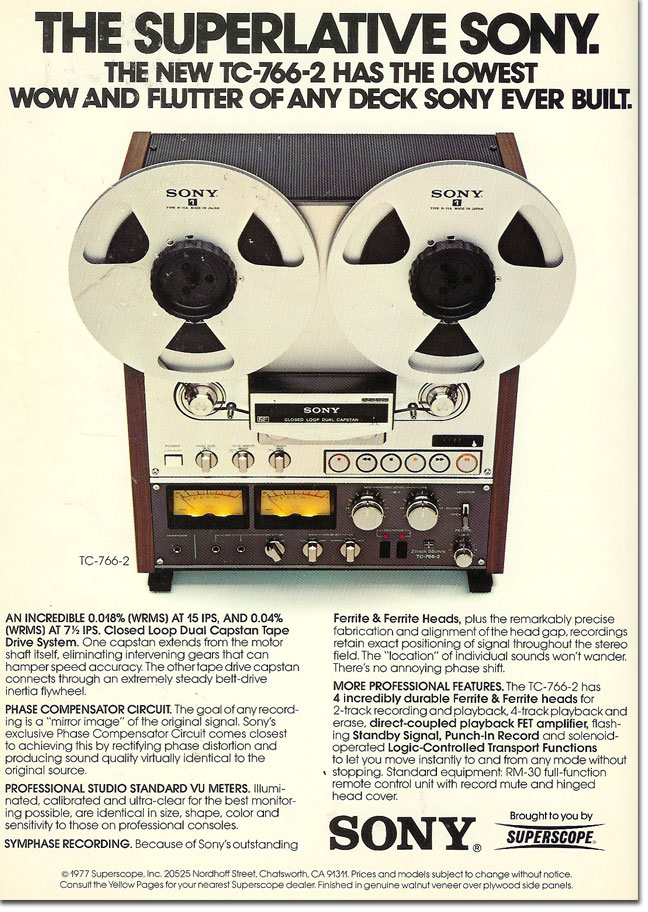 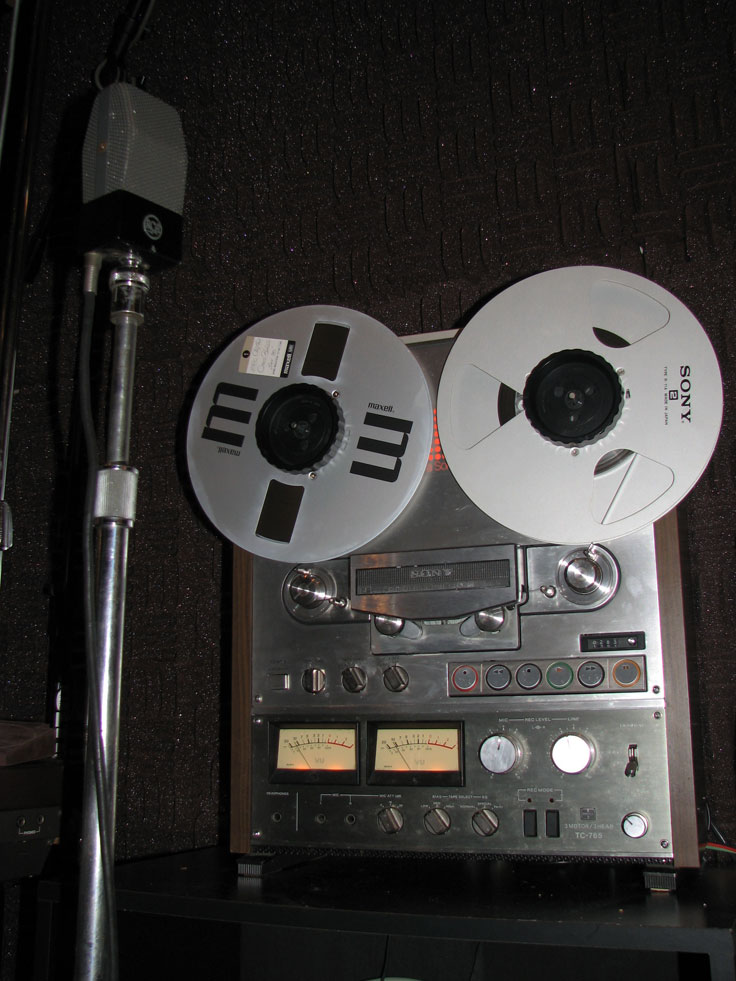
The system was abandoned in 1980, when all the remaining systems were sold off in Finland.
1977/78 The last Sony reel to reel tape recorder
The last Sony reel to reel tape recorder produced was the Sony TC-765. The TC-765 shown to the right is in the Museum of Magnetic Sound recording.
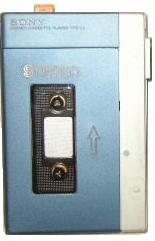
Sony produced the world's first portable music player, the Walkman in 1979.
Superscope
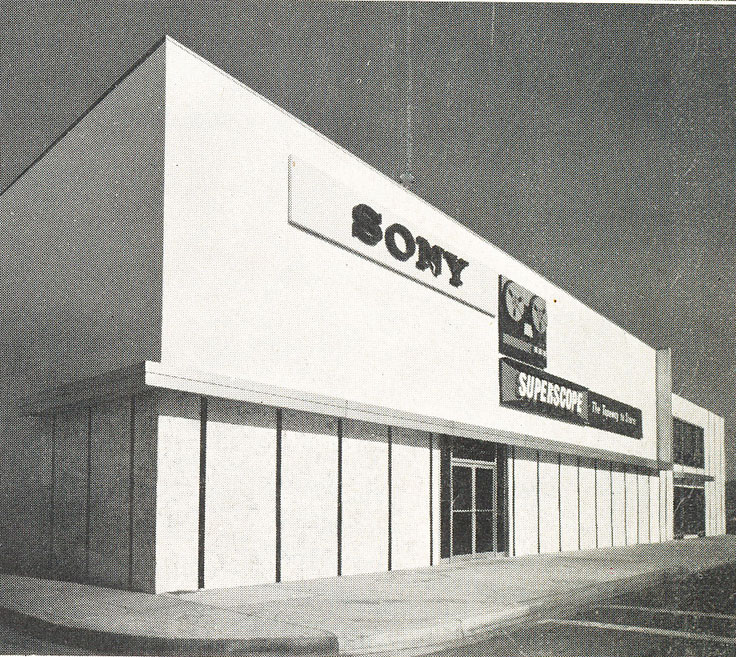 Conceived and designed by the Tushinsky brothers, the "Superscope" wide screen process had its brief heyday from 1954, when Superscope Inc. was incorporated, to 1957. Conceived and designed by the Tushinsky brothers, the "Superscope" wide screen process had its brief heyday from 1954, when Superscope Inc. was incorporated, to 1957.
It was first used on the film Vera Cruz starring Gary Cooper and Burt Lancaster. Howard Hughes' RKO Pictures used the Superscope process on a total of nine films, including Invasion of the Bodysnatchers. Disney successfully reissued Fantasia in Superscope in the mid-fifties.
In 1957, Superscope's founders, Joseph, Irving, Nathan, and Fred Tushinsky were visiting Japan when they met with the executives of a Japanese electronics company named Sony.
The Tushinsky's discovered that Sony had the world's first stereo tape recorders, with built-in amplifiers.
Realizing the potential for the tape recorders for the U.S. market, the Tushinsky's contracted for exclusive rights to distribute them in the United States.
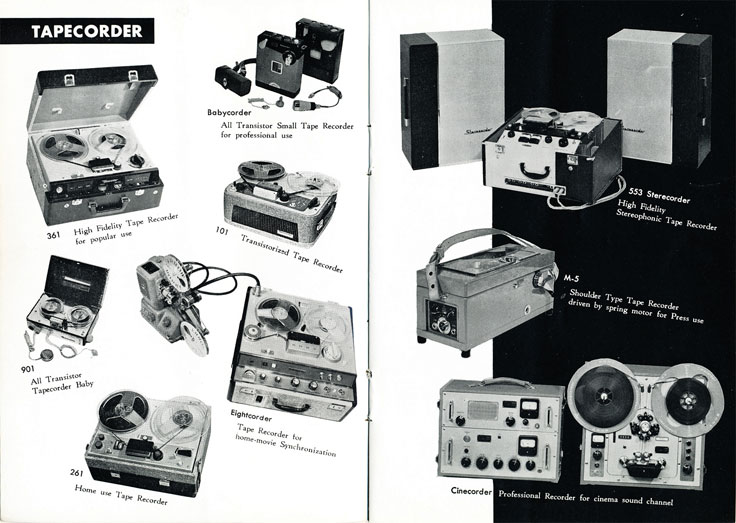 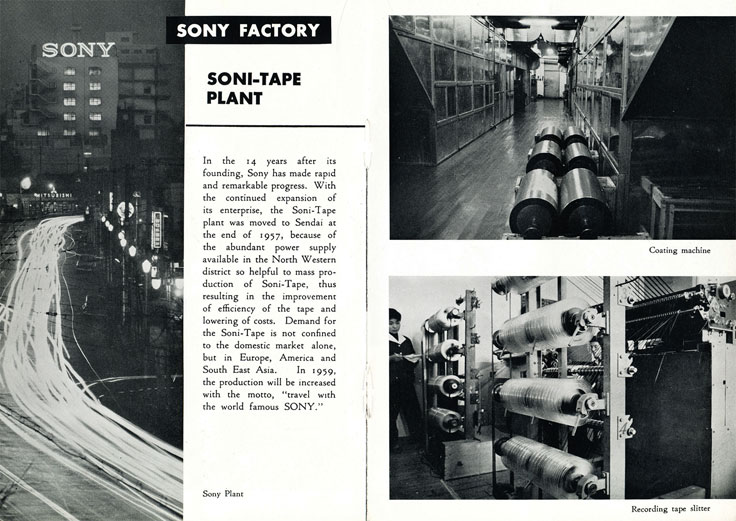 
During the 1960's Sony released a variety of Sony/Superscope branded reel-to-reel and cassette tape recorders.
In 1964, Superscope Inc. acquired a small but prestigious hi-fi company from Saul Marantz.
By 1973 Superscope was producing its own line of professional portable cassette recorders.
Superscope continued to market and distribute Sony tape recorders exclusively in the United States until January 1, 1975, when Sony acquired back distribution rights to its line of tape recorders from Superscope.
In the 1980s the company sold off many of its assets and changed the name to the Marantz Company.
In 1987 the Marantz Company was purchased by Dynascan Corporation (today's Cobra Electronics).
By 1990, Cobra had sold the Marantz brand to Philips Electronics which negotiated an agreement so that Cobra continued to market Marantz Professional products in the Americas.
In 1993 Superscope Technologies Inc. acquired rights to the Superscope brand and distribution rights to Marantz Professional Products.
It is presently located in Geneva, IL.
History of Sony video
Sony tape and tape recorder products
First Sony Tape Prototype called Soni-Tape - 1949
First Sony Tape Recorder Prototype1950
Spring wound "M" Type for professional broadcast work - 1950
In marketing the G-type tape recorder, Totsuko registered it under the trademark name of " Tapecorder" (Later Sony used "Sterecorder")
Called "G" type because it was sold mostly to the government
This machine featured a tape speed of 19cm (7.5 inches) per second & 10 inch reels
TC-301. It was the first small tape recorder designed for the consumer market and was sold for 49,000 yen - $600 (the G type tape recorder launched 4 years before was sold at 160,000 yen -$2,600). It was this less-than 50,000 yen model that started the mass production of what until then were expensive products. Sony Corp.
|
| |
Studer - ReVox
Willi Studer - 1912 to 1996
The company "Willi Studer" founded on January 5th, 1948, develops and builds oscilloscopes for high voltage labs.
The first tape recorders that are imported to Europe from the USA are not marketable without modifications, so the importer approached Studer to modify these devices by replacing capstan-shafts, friction pulleys and rollers. Slowly the idea of developing and constructing a better tape recorder emerges.
With the purchase of 500 recorders from the importers, development on the first Studer-designed tape recorder 'Dynavox' begins.
The Dynavox, or ReVox T26 (which we have in the Phantom Productions' collection) had only one speed, 7 1/2 i.p.s.(19cm/sec.), and operated in the full track mode to ensure optimum dynamic range and the lowest possible background noise from the rather poor tape available at that time. Appreciating this need for long, uninterrupted playing times, the machine was designed to accommodate 25 cm. spools from the start.
In 1951 ELA AG was founded by Willi Studer and Hans Winzeler. The Dynavox tape recorder was renamed into Revox T26 and the prestigious recording of the "International Music Festival Lucerne" was made with a prototype of the first professional tape recorder Studer 27. Dynavox became Revox and the T26 continued virtually unchanged until cessation of production in 1955.
In 1952 mass production of the Studer 27 begins, Willi Studer has 32 employees.
In 1956 production of the Type 36 series commenced with the A36 machine. It was the aim of the manufacturer to virtually, eliminate mechanical wear and at the same time produce a transport mechanism of the highest performance, utterly dependable and a joy to use. Thus the three-motor principle, already acknowledged as the ultimate in the professional field, was employed. So successful was the original system that it remains today, with only minor improvements.
Although the A36 series had separate record and reply amplifiers. it was not until the introduction of the B36 machine in 1957 (ad to the right) that separate heads were fitted. The B36 series thereby became the first tape recorder designed for the amateur but with the performance of a professional machine.
The facilities demanded by the buyer continued to grow and in 1958 the C36 was introduced. Several minor changes, improvements and extra facilities were brought about to make the machine as versatile as possible. This was the last of the mono machines with the exception of the CD36 which is a high-speed machine for full track operation in the professional field.
The first Revox Stereo Recorder, the D36, appeared in.1960. The mechanics were retained from the previous series and allied to these were new electronics to permit complete stereo recording and playback to cathode follower level with the additional provision of a monitor amplifier
Tape recording techniques continued to advance rapidly and the E36 was engineered to provide the mixing facilities, echo and multiple recording possibilities that enthusiasts were seeking. This was the first Revox to be introduced to the British Market in any quantity, appearing early in 1962. Since Continental standards differ from those in the U.K., a revised edition of the E36 is now provided to satisfy the requirements, of international use as far as possible.
In the F36 more features are included, making the machine easily the most versatile available. In addition to employing the latest recording characteristic the machine is also the first to use the graduated twin beam magic eye with its incredibly short rise time, giving an accurate register of transients. Production starts in 1962
The famous G36 was a mono/stereo machine with stacked erase heads, separate recording heads separate replay heads, six audio pre-amplifiers. and a push/pull power amplifier. Tape speeds of 3 3/4 and 7 1/2 .i. p. s. are obtained by pole-changing the synchronous Papst capstan motor. Twin-track and four-track models are available, both fully stereo phonic, recording to the latest C.C.I.R. (DIN 45113) characteristic. Tape spools 27 cm.
One of the company's most successful models was the Studer-Revox A77 recorder, which was introduced in 1967. It sold over 400,000 units.
In 1955 Willi Studer introduces the Studer A37 and Studer B37and in '56 the first tape recorder of the famous Revox A36, is released. Several thousand tape recorders are built by Studer and the company set up an international sales network. Introduction of the first portable tape recorder Studer B30. The next version of the A36 series goes into production under the name of B36. This machine has separate heads.
In 1960 the Studer C37 and the Revox D36 became the first Revox stereo tape recorder of the 36 series.
The Studer J37 4-track tape recorder goes into production in 1964 and in '65 Studer introduces the first fully transistorized professional tape recorder Studer A62. A total of 50,000 Revox tape recorders have been build so far.
In 1967 the "Beatles" choose the Studer J37 4-track for their album "Sergeant Pepper's Lonely Hearts Club Band". Introduction of the famous Revox A77 and its counterparts (amplifier A50 and FM-tuner A76).
By 1968 560 employees work for Studer
In 1973 the B67 was released in various configurations; console, portable or rack-mounting; one or two tracks and low-speed (3.75 – 7.5 – 15 ips) or high-speed (7.5 – 15 – 30 ips) versions. Frequency response was 60Hz – 15kHz (±1dB at 15 ips) and signal to noise ratio was 62dB, NAB weighted
By 1975 1,495 people are employed and Studer bought and built several production and distribution facilities worldwide.
1978 microprocessor controlled multitrack tape recorder Studer A800 is released in 1978.
1982 Revox PR99
1985 Studer A820 analog multitrack recorder
1986 Studer Revox group employs 1882 people, including all subsidiaries worldwide.
1989 Studer Editech was formed following the buy-out of the American company Integrated Media Systems. Introduction of the 48-track DASH tape recorder D820. Willi Studer wants to retire, several international companies are interested to buy the Studer Revox Group.
1990 Willi Studer sells the Studer Revox Group to Motor-Columbus AG, including all subsidiary companies.
1991 Acquisition of the French audio manufacturer Digitec S.A., the new products (CAB, digital routing) supplement the Studer range. Motor-Columbus splits the Studer Revox Group into Studer (Pro), Revox (HiFi) and a Manufacturing-division. MC sells several subsidiaries and plants.
1993 Introduction of the all new DASH recorder Studer D827. The first digital mixing console Studer D940 is sold to the WDR Cologne.
1994 The extensive reorganization culminates in the sale of the Studer Group to Harman International Inc. It is operationally controlled by its UK-based sister company Soundcraft. The Revox Group was excluded and sold to a financial company, or private group of investors.
1996 Willi Studer passed away on March 1, 1996.
In July 2009, the Soundcraft management announced that the Swiss production facilities were to be moved to Soundcraft's own former production facilities. The decision was challenged by the Swiss workforce and negotiations with the Harman management are ongoing as of October 2009.
A follow-up to the Harmon Studer story seems to indicate the Swiss employees were let go and all the Studer equipment was moved to Soundcraft facilities in the UK.
|
| |
Tandberg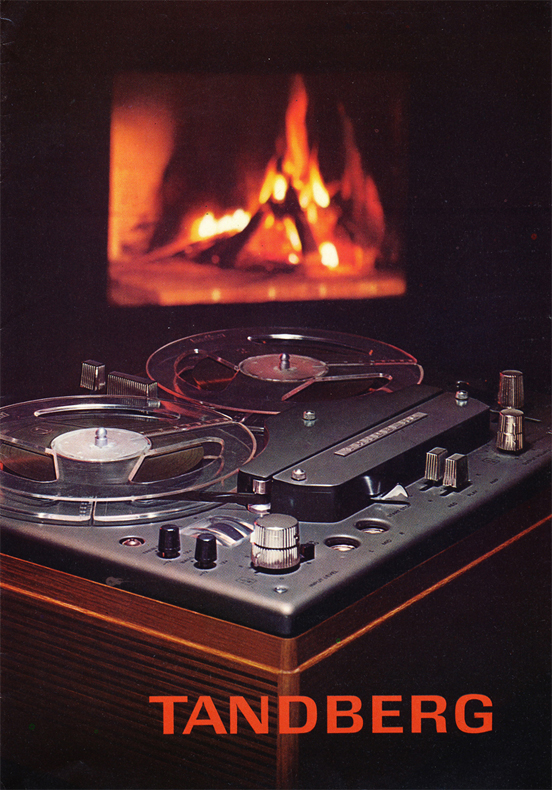
Tandberg, Lysaker, Norway
Founded in 1933 by Vebjorn Tandberg as Tandbergs Radiofabrikk (Tandberg's radio factory) in Oslo
Vebjørn Tandberg (16 September 1904 – 30 August 1978) was a Norwegian electronics engineer. An alumnus of the Norwegian
Institute of Technology, founded Tandbergs Radiofabrikk of Oslo in 1933, and made it a great success.
In addition to his technical and commercial achievements, Tandberg was a pioneer in providing good conditions for his workforce.
He instituted a 42 hour week and 3 weeks yearly vacation for all in 1937, and a free pension and health insurance scheme for all from 1938. A four week vacation for all employees over 40 years of age was introduced in 1947, while the working week was reduced to 39 hours in 1948. There was a five day work week during the summer months from 1955, over the full year from 1969.
The company's first radio was named "Tommeliten", and used only earphones. This was followed by the "Corona" with a loudspeaker. In 1934 the first "Huldra" radio was launched, followed in 1936 by the "Sølvsuper". During the early years, radios, loudspeakers and microphones were the main output from the factory. The Sølvsuper and the Huldra radios became the foundation for Tandberg's success.
In the early 1950s, Tandberg opened a branch plant in Kjelsas (in Oslo) to produce reel-to-reel tape recorders. Their first model was the TB 1, introduced to the market in 1952.
Over the next decade, Tandberg quickly incorporated a number of leading-edge concepts; the TB 2 Hi Fi of 1956 had three tape transport speeds, allowing improved high-frequency response.
The TB 3 Stereo from 1957 was Tandberg's first stereo system. In the 1960s Tandberg introduced the cross-field recording technique in the TB-6X model, allowing their recorders to handle higher frequencies than competing models.
Tandberg licensed the concept to Akai, who used it widely in the 1970s and 80s in their Akai and Roberts recorders.
Tandberg tape recorders dominated the Norwegian market, and had a reputation for advanced technology and high quality at reasonable prices.
It was on Tandberg reel-to-reel machines that President John F. Kennedy recorded many meetings in the Cabinet Room of the White House, including those associated with the Cuban Missile Crisis.
The Kjelsas factory also started producing TV sets in 1960, and in 1966 a second TV plant was opened in Kjeller in Skedsmo. Color TV's were added to their lineup in 1969.
In 1972, Tandberg purchased Radionette, another large Norwegian electronics firm now focussing on televisions.
By 1976, TV's were Tandberg's major product and their factories employed 3,500.
However, that same year a major economic downturn seriously disrupted the company, and by 1978 it was insolvent. A shareholder revolt removed Vebjorn Tandberg from control of the company, and he committed suicide in August.
In December the company declared bankruptcy. In the aftermath of the bankruptcy, the original Tandberg was split into three parts.
The television manufacturing portions became Tandberg Television, Tandberg Data took over the tape recording side of the company and moved it purely into the computer storage field, and the remaining portions lost the "Radiofabrikk" to become, simply, Tandberg.
Cisco Systems acquired Tandberg on 19 April 2010.
Tandberg Factory
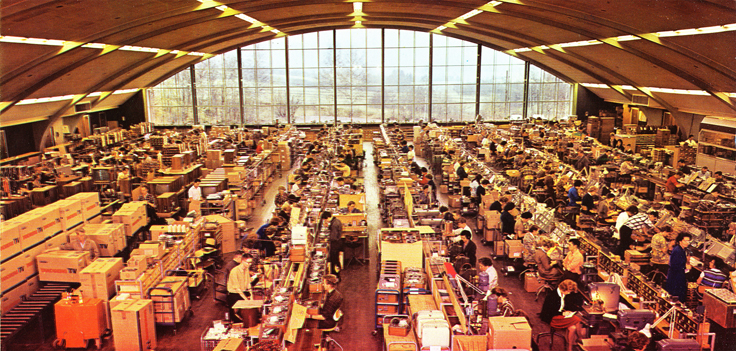 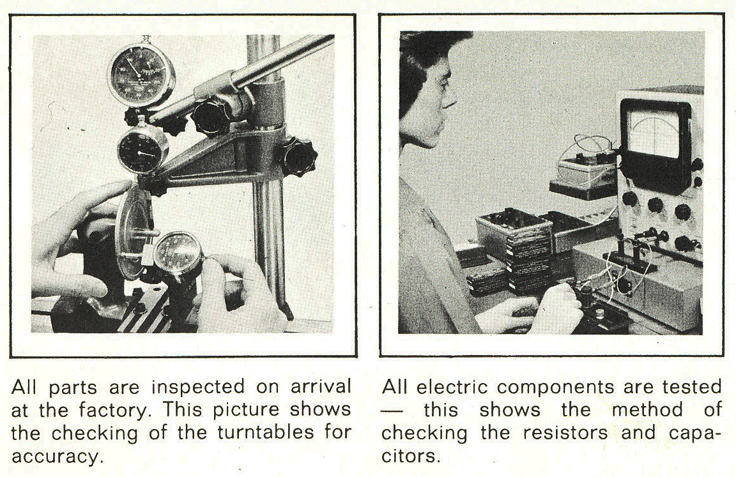 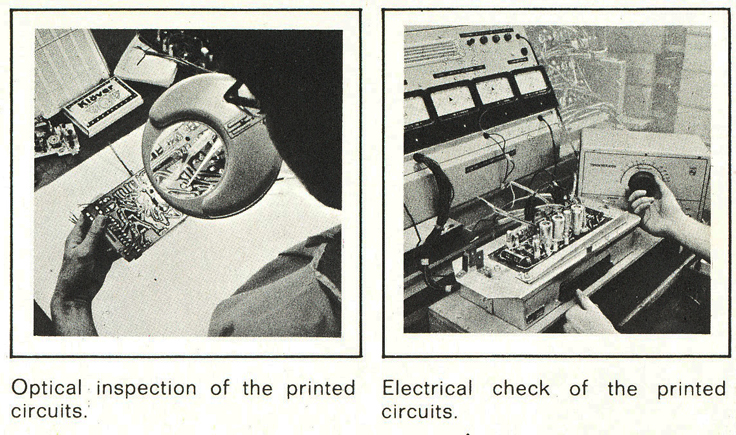 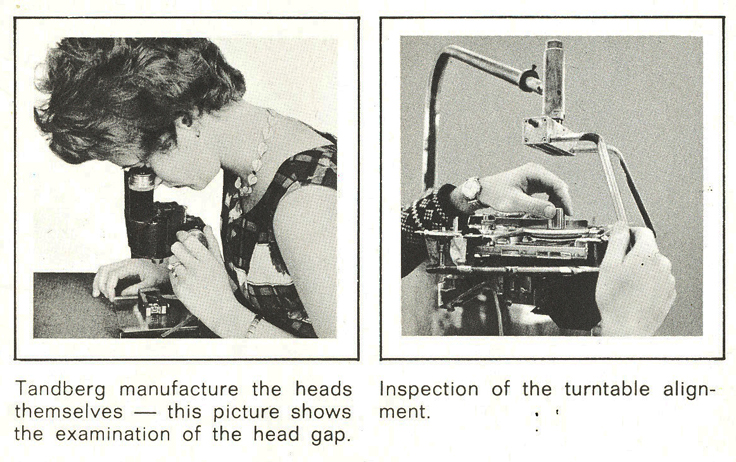 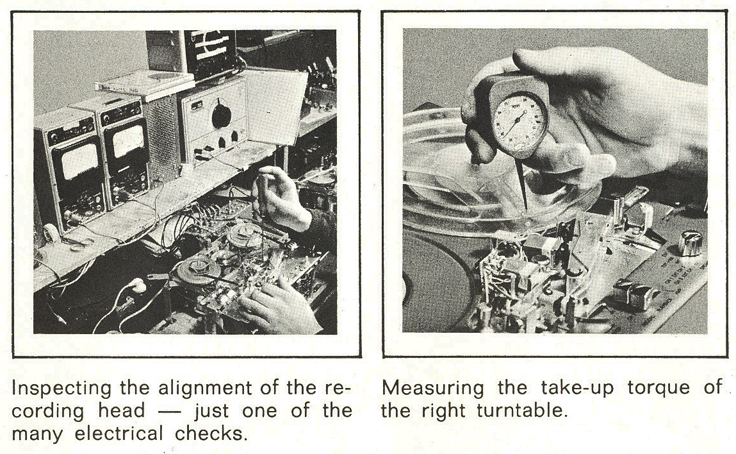 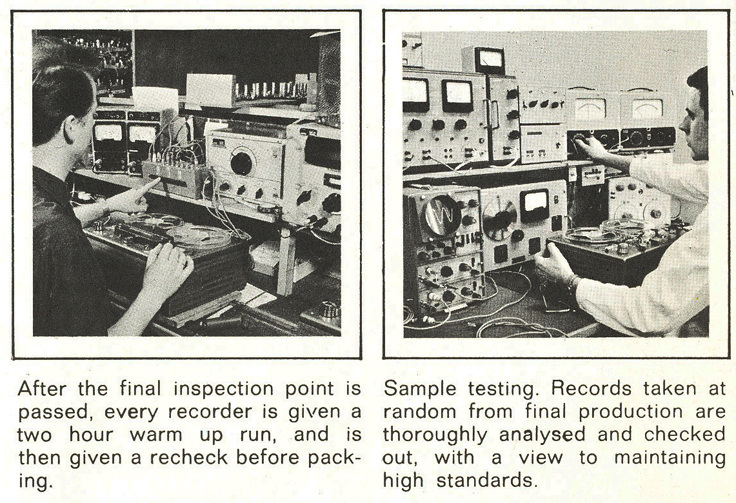 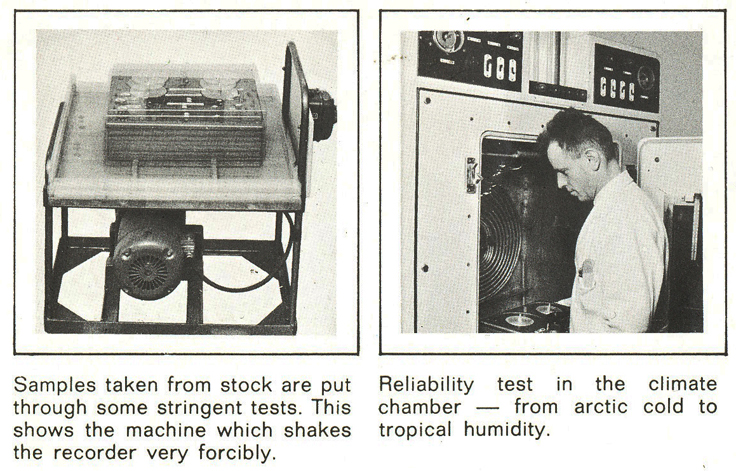 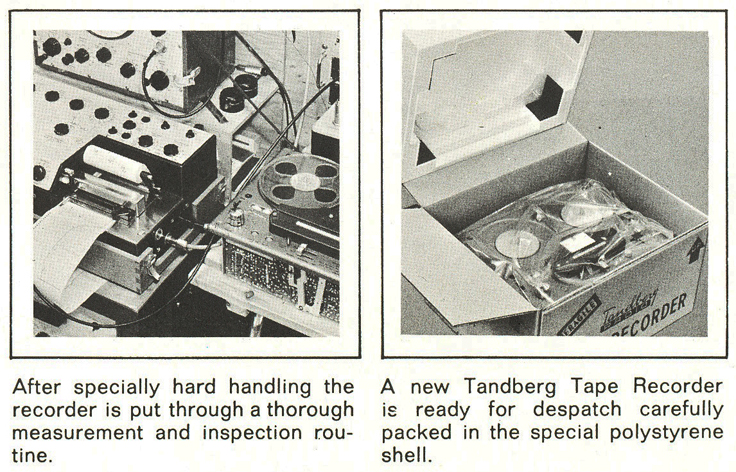 
1967 Tandberg Ads
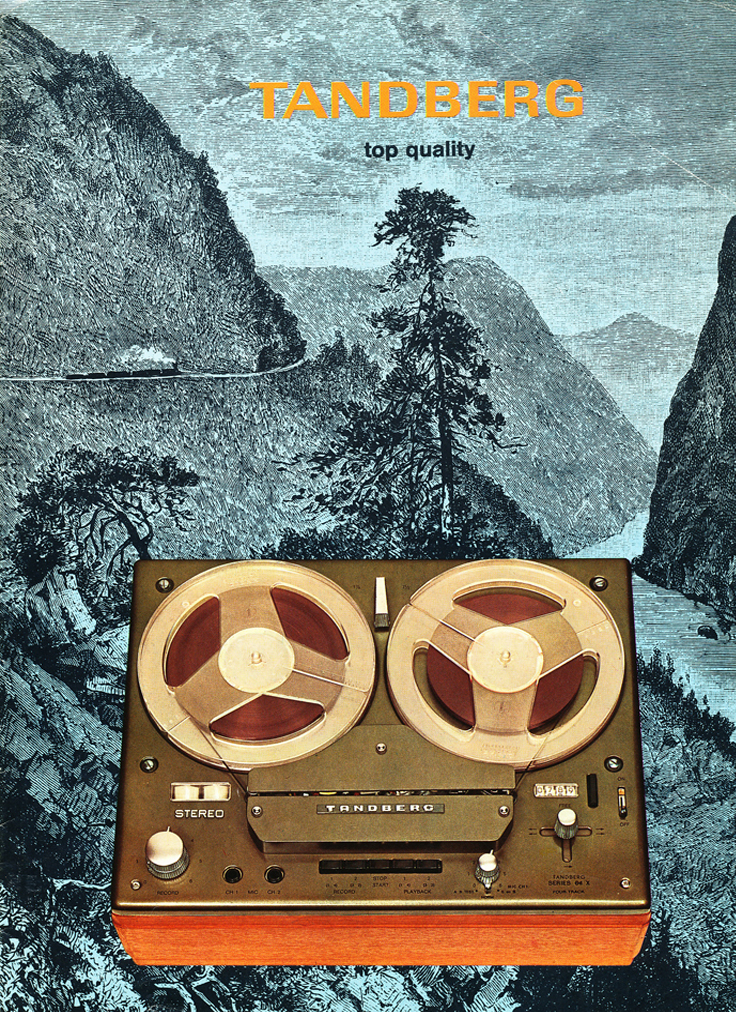 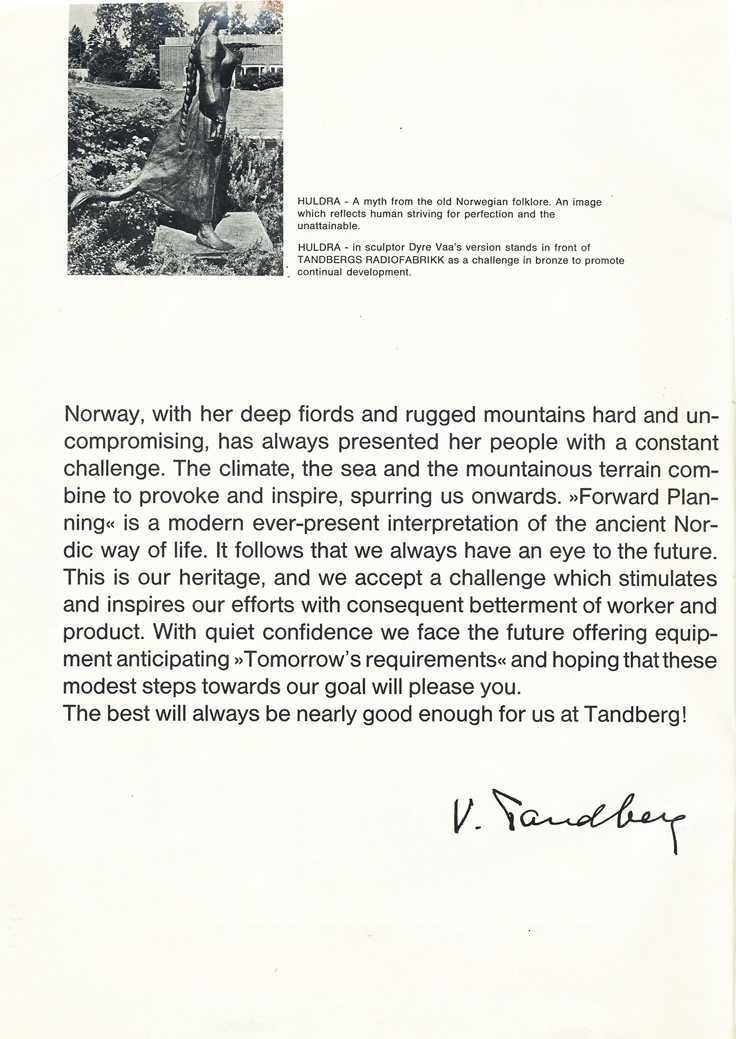 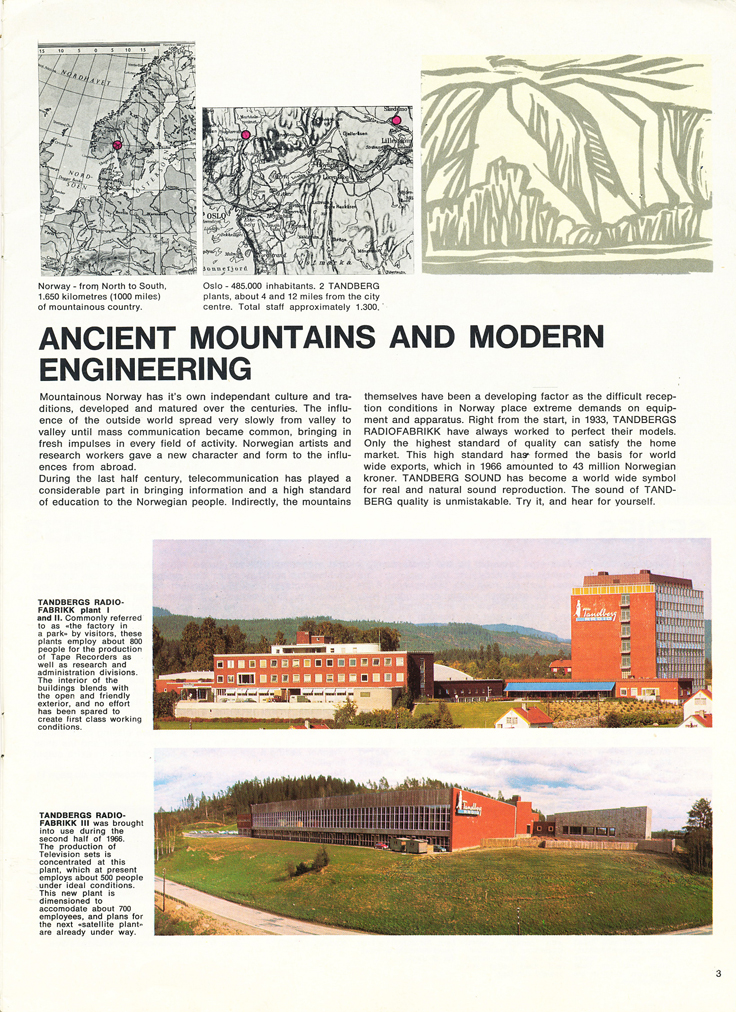 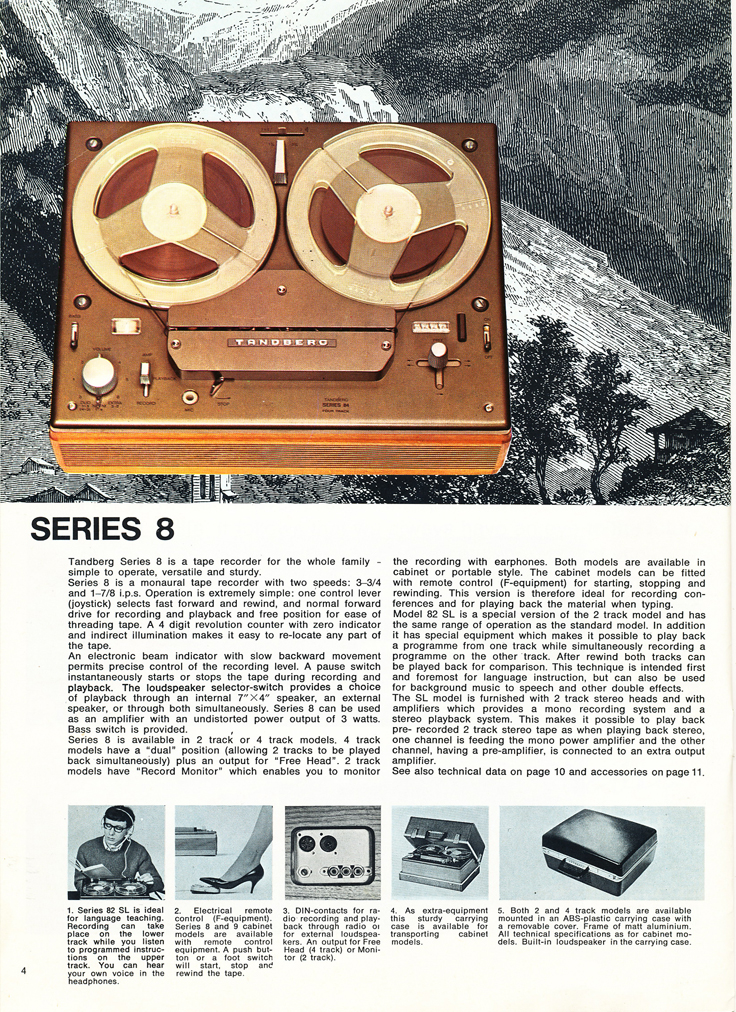  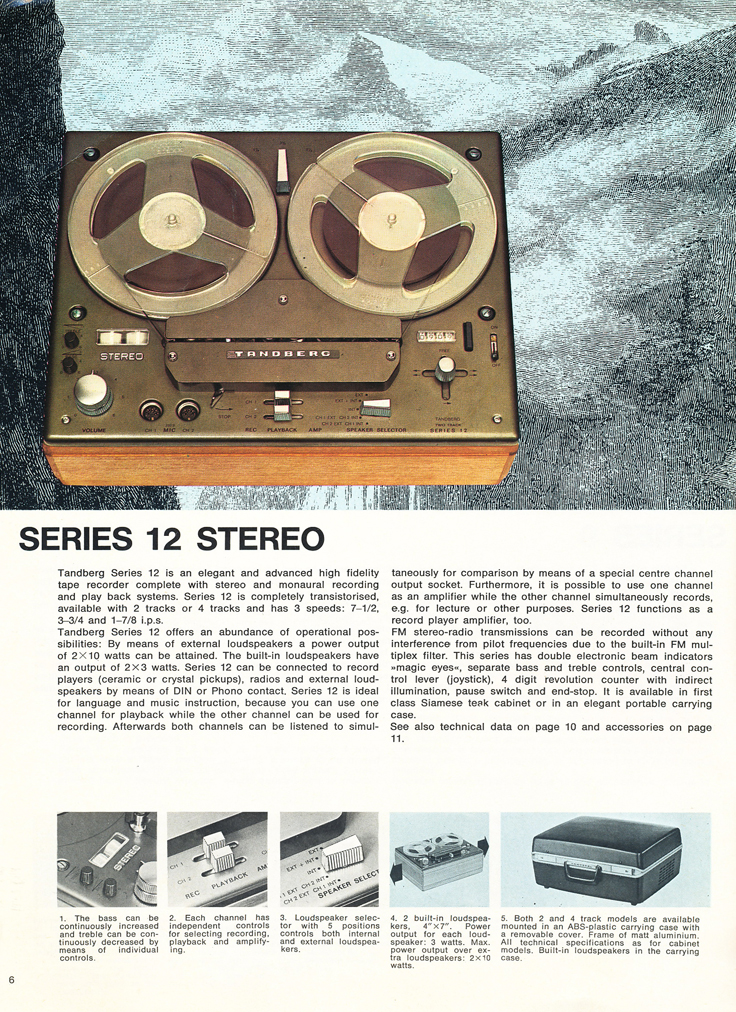 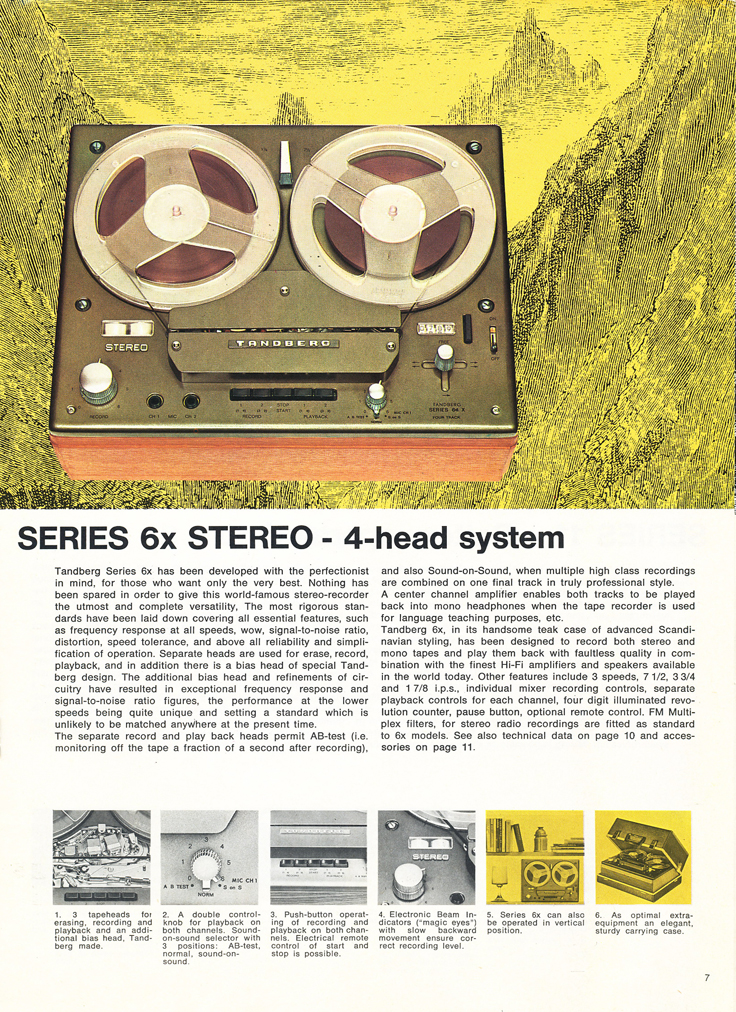  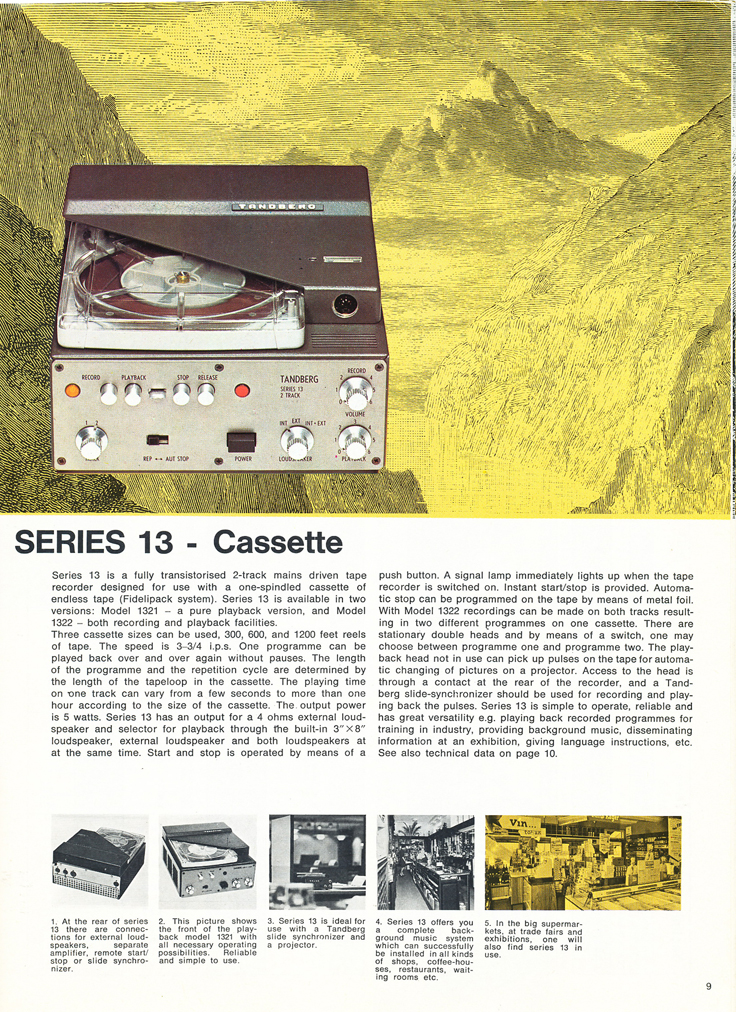 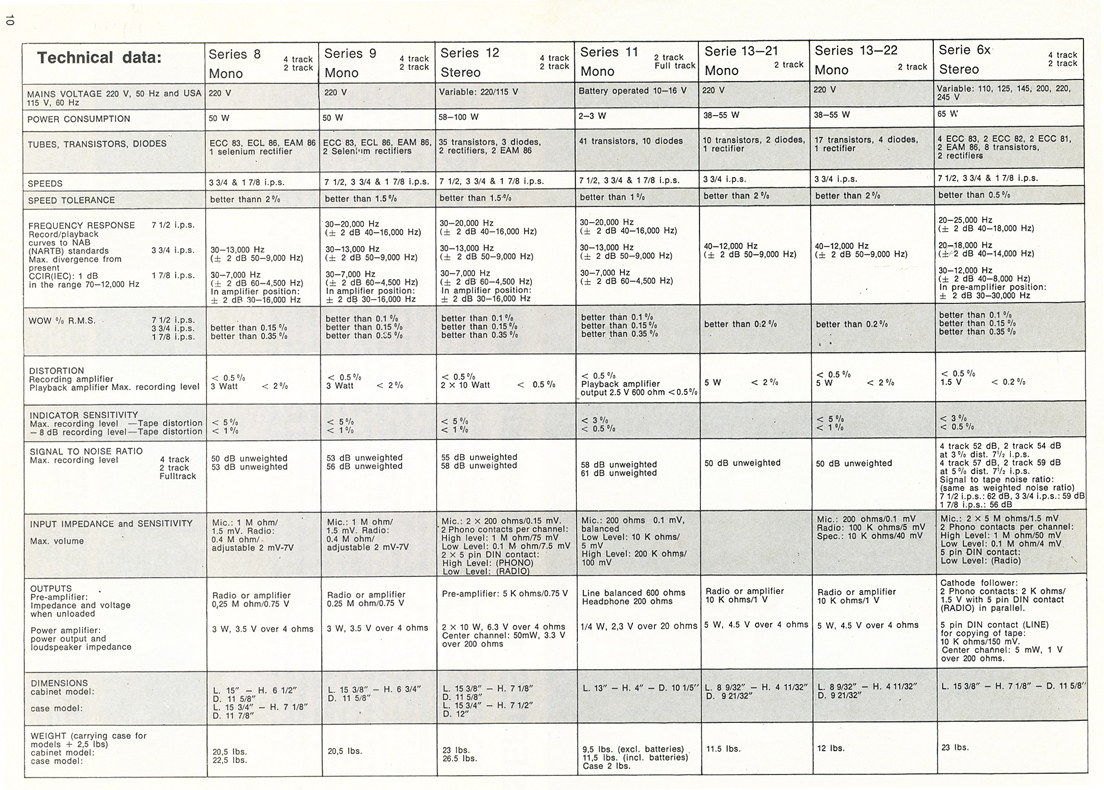 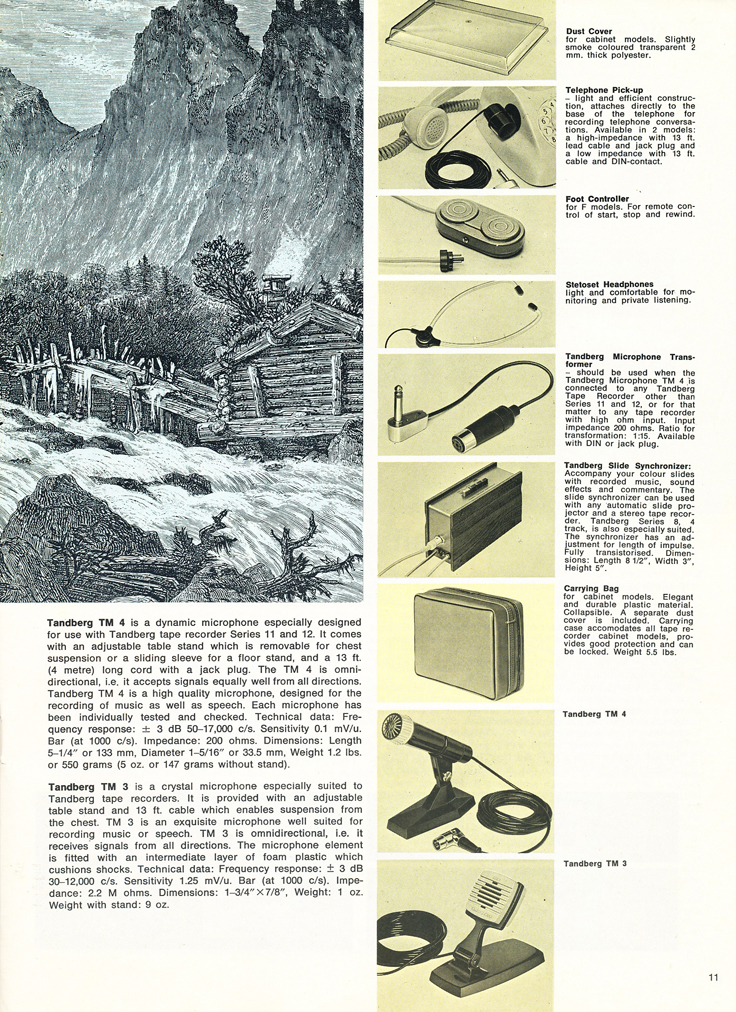 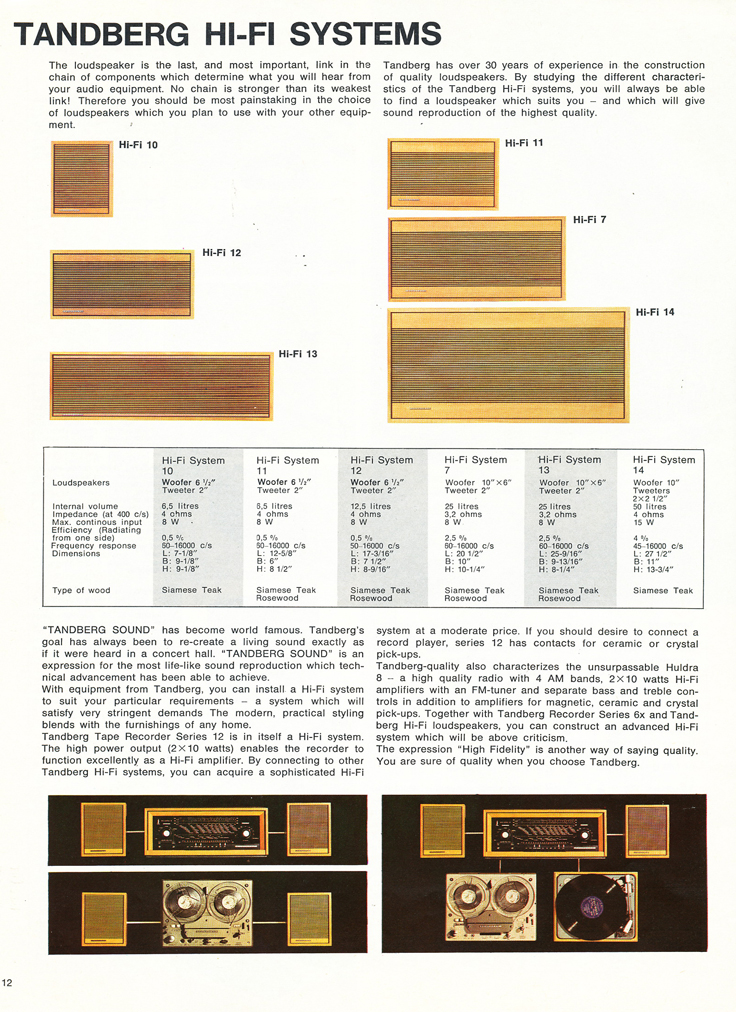 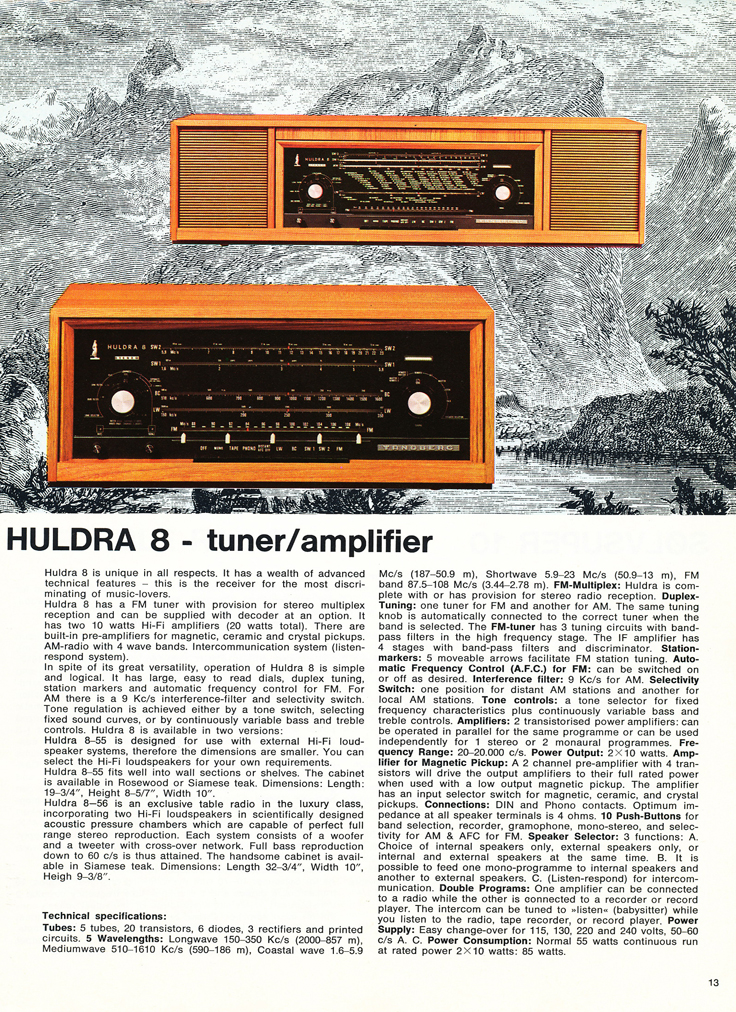 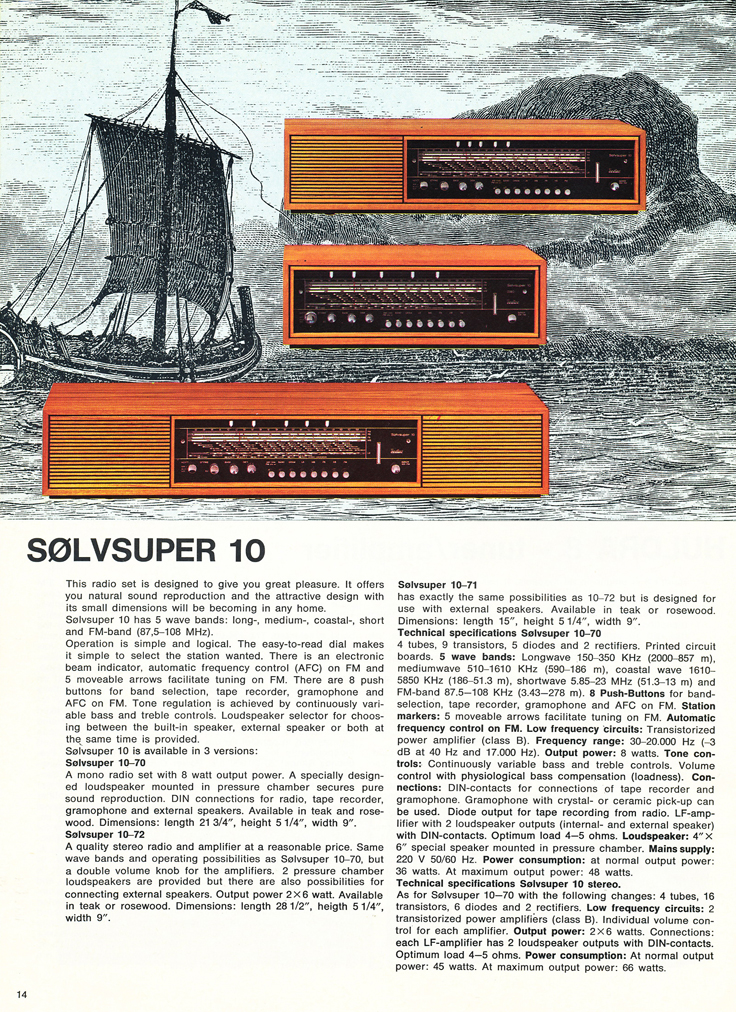 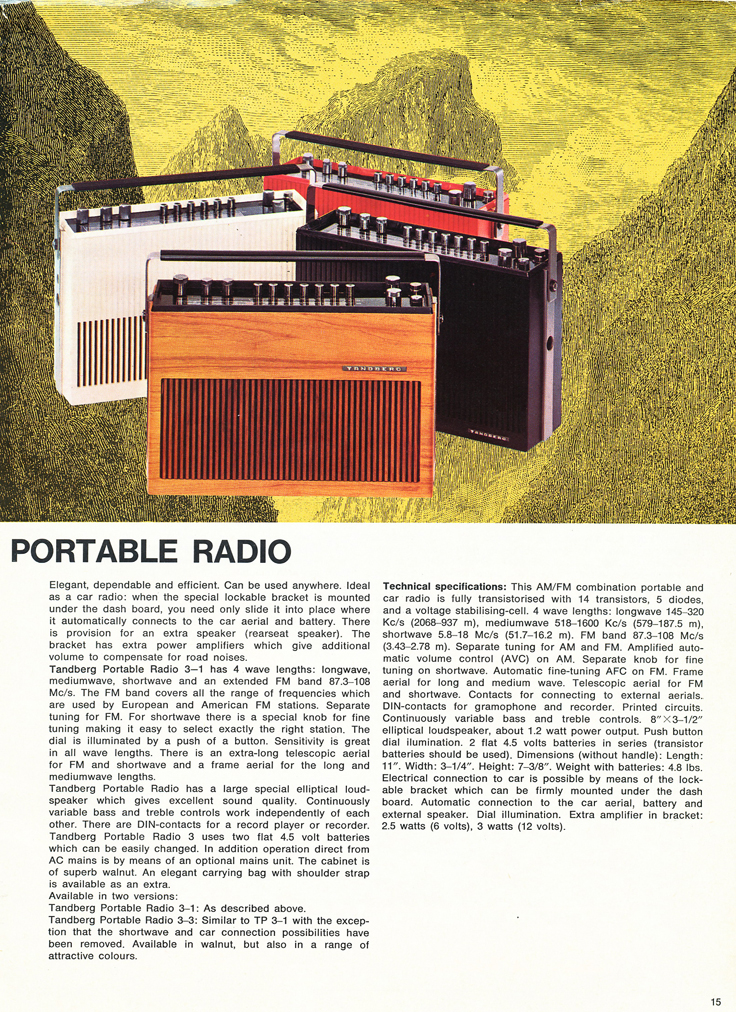 
|
| |
Tapesonic - Premier Electronic Labs
Premier Electronic Labs.; 382 Lafayette St.; New York 3; N. Y
Sam Miller ? to 1980 and Harry Kolbeand were founders
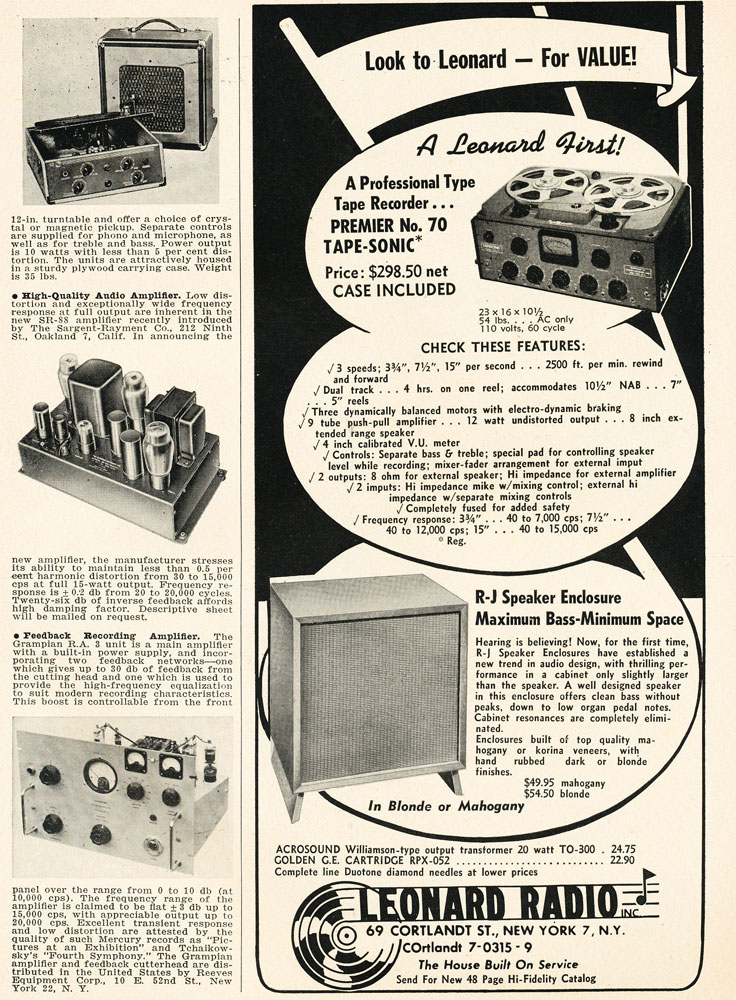 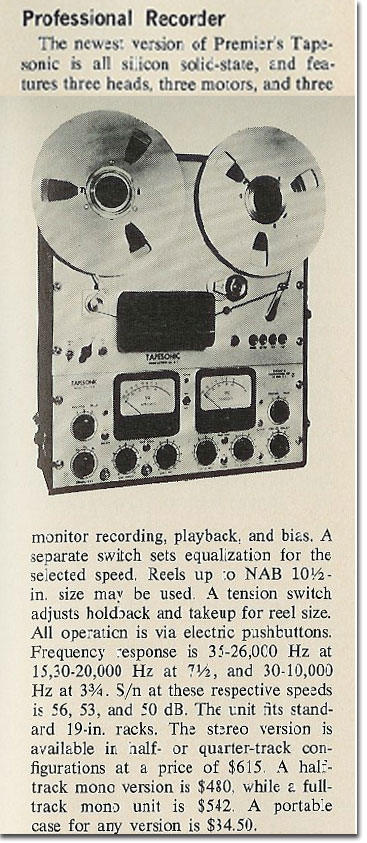  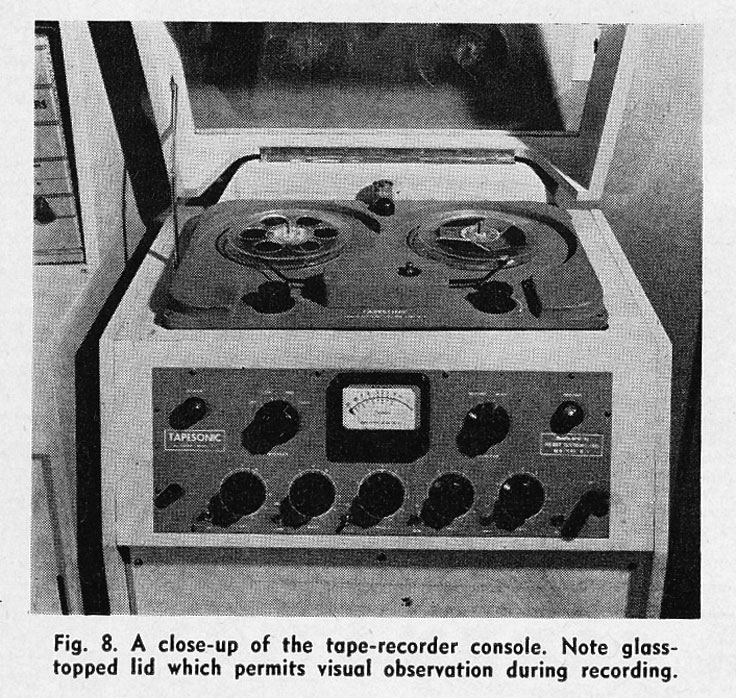
Ads below were provided by Ken deGruchy
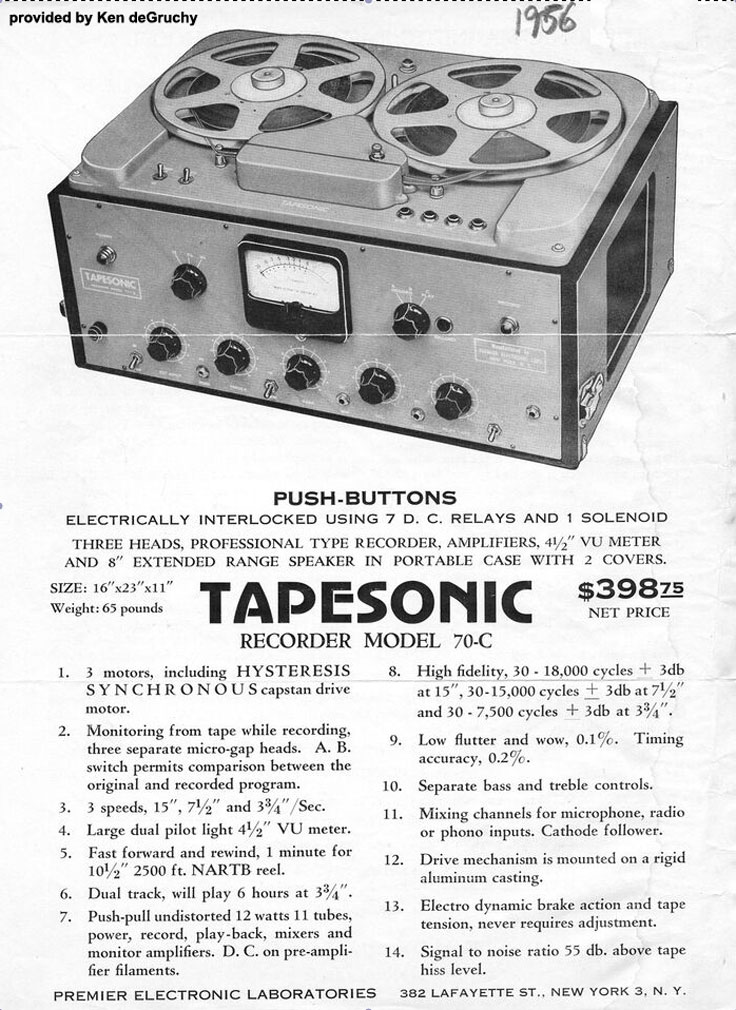 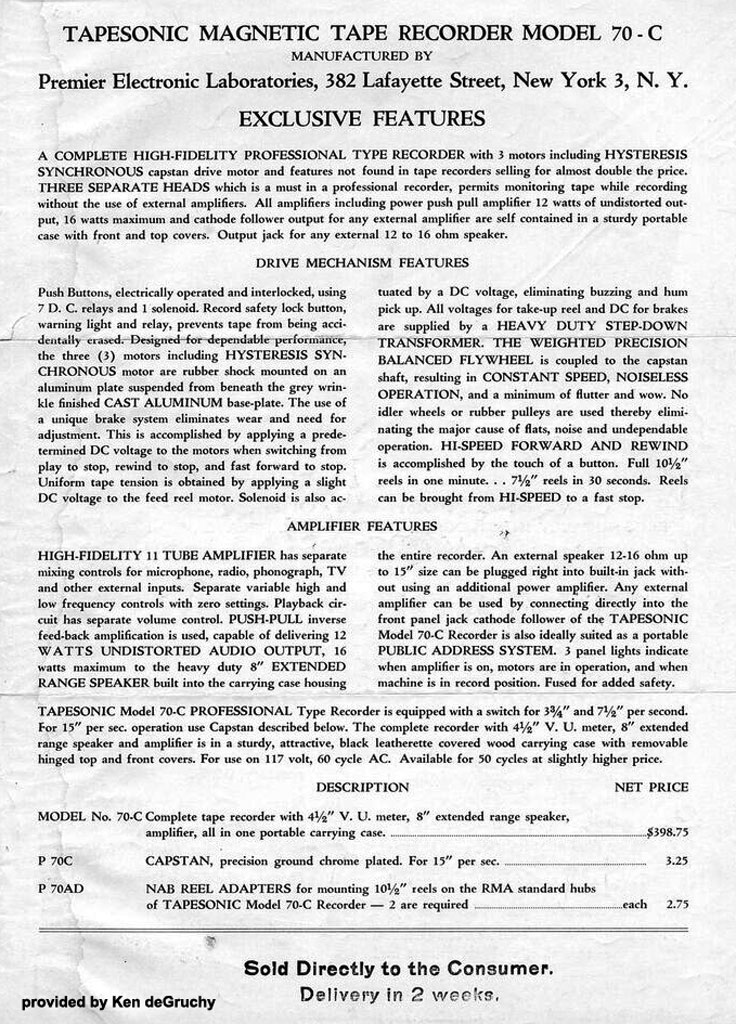 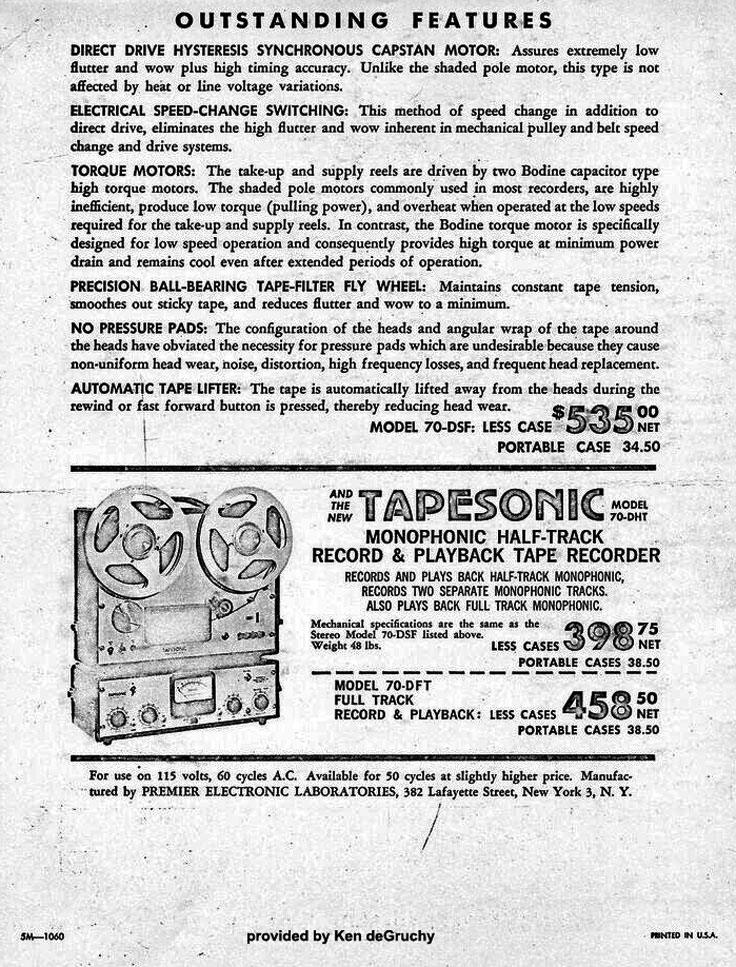 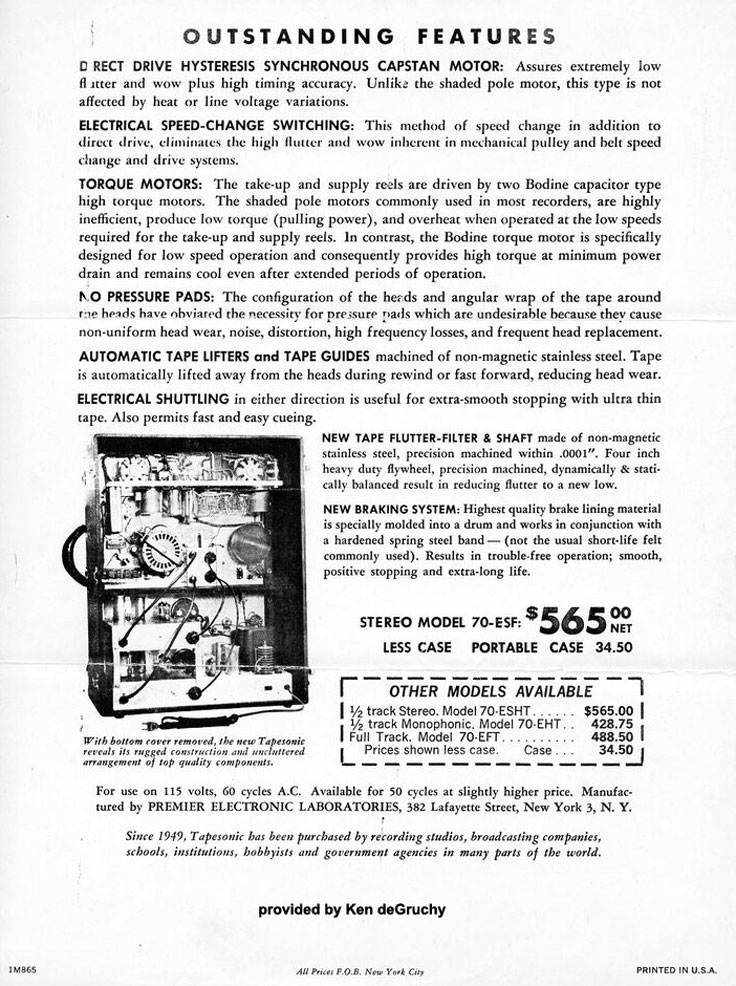
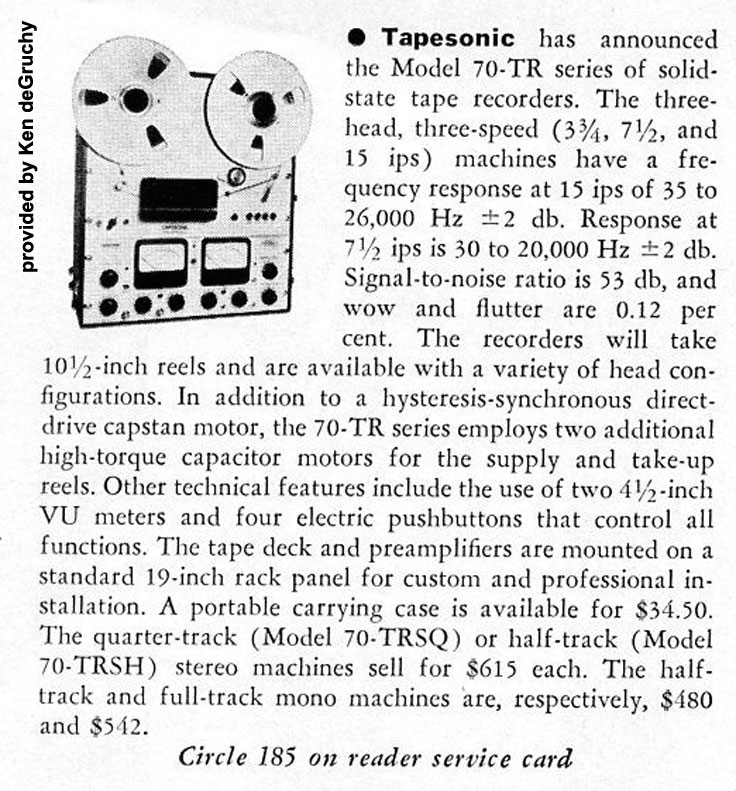 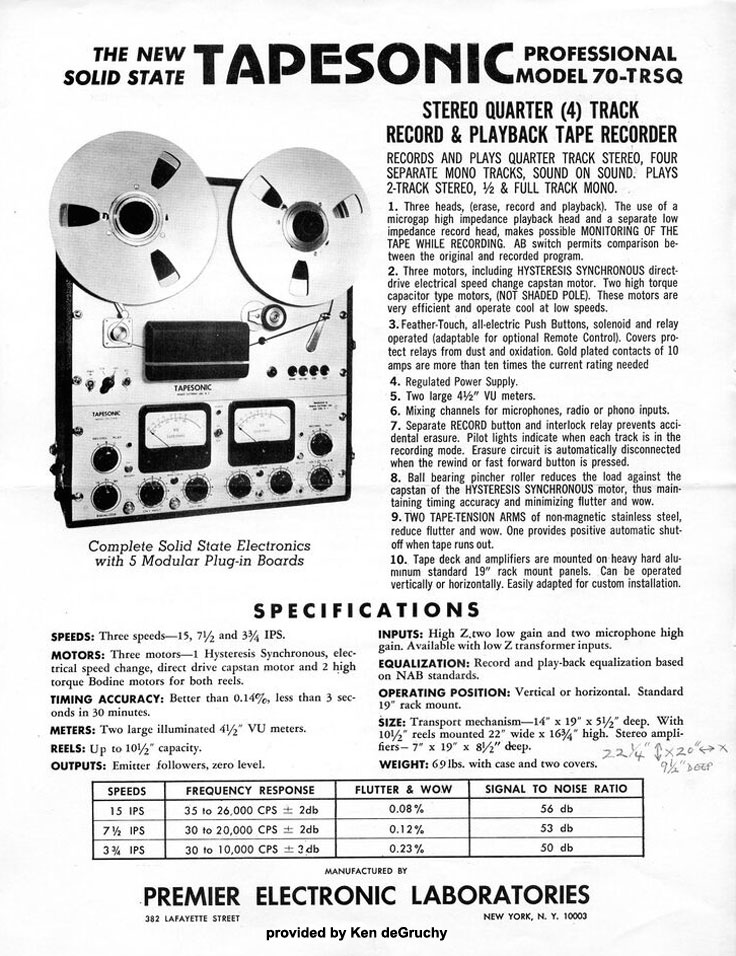 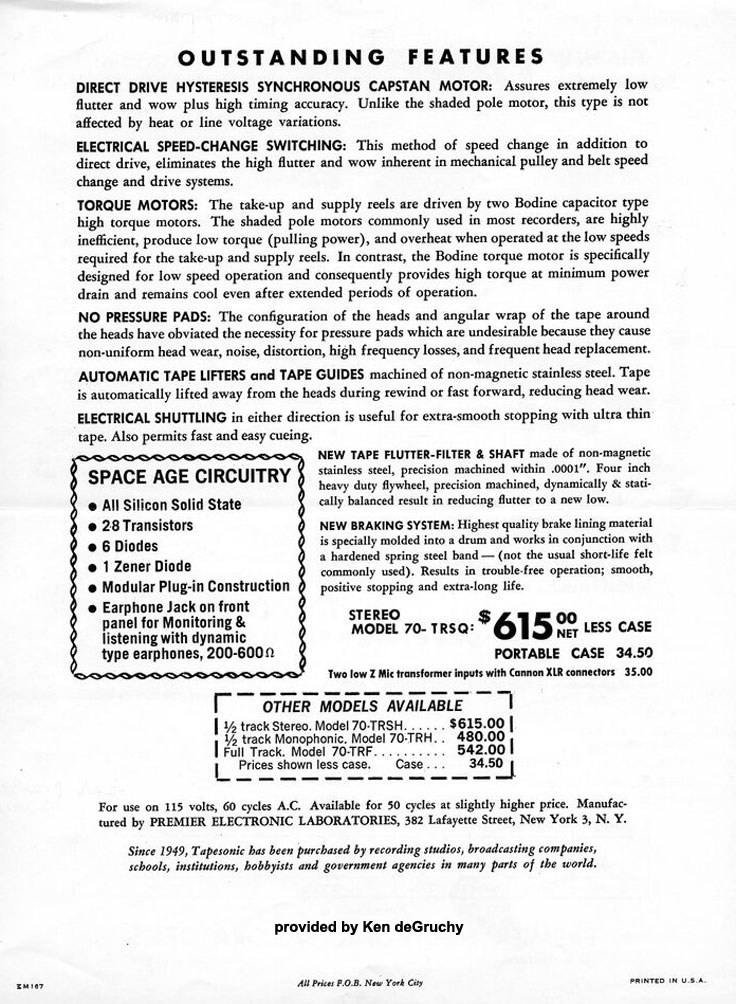 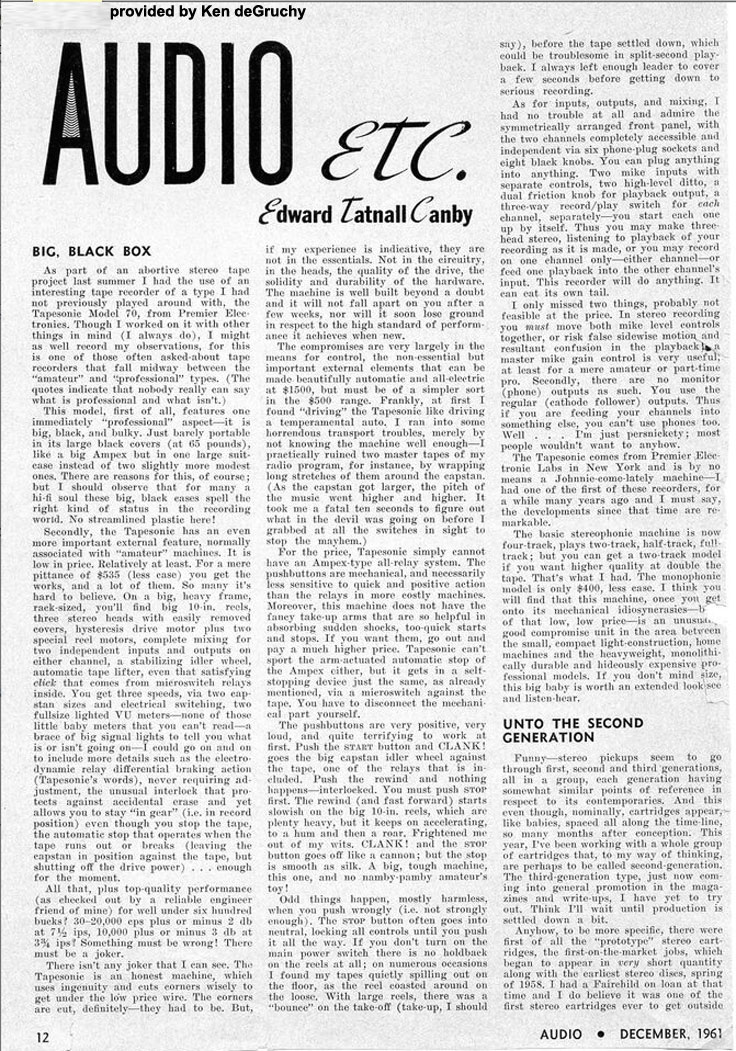
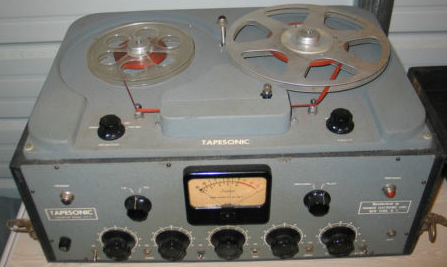 
Tapesonic 70-A
v
The following Tapesonic photos are provided courtesy of Dmitriy Shvetsov - partyny
Hi, there. Thanks for contacting me. Sure you can use the pictures. too bad i don't have the units any longer... Yes i know the guy from Tapesonic team. It was two man operation company. One of them still alive and his name is Harry Kolbeand i think his partner Sam retired long time ago and died in 1980's. Harry's phone is ___ .Say Hi from Dmitriy with Tapesonics. he will know.
good luck with your museum. Dmitriy Shvetsov - partyny
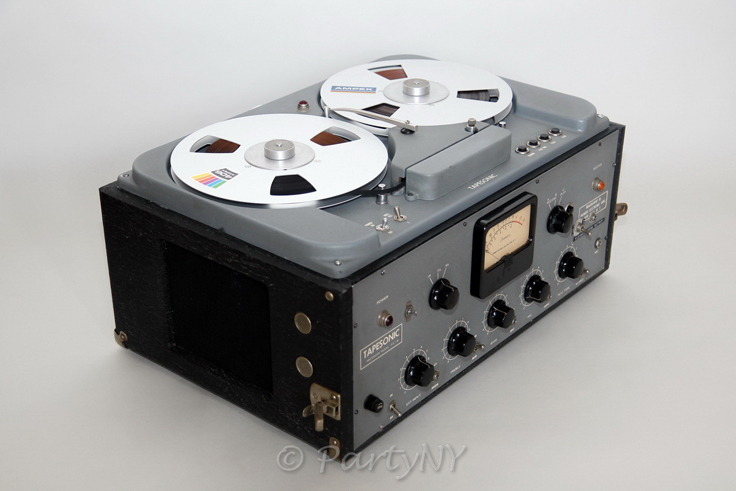 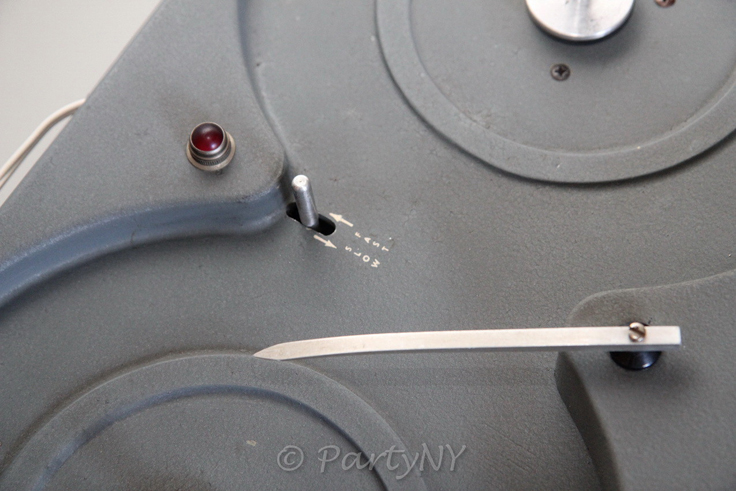 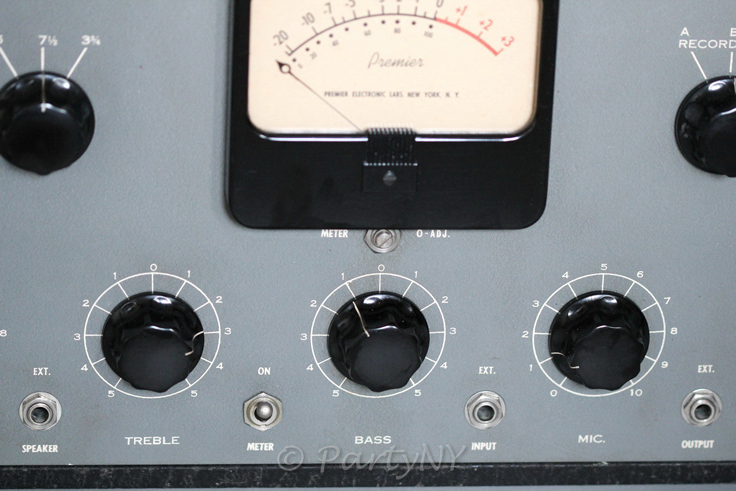  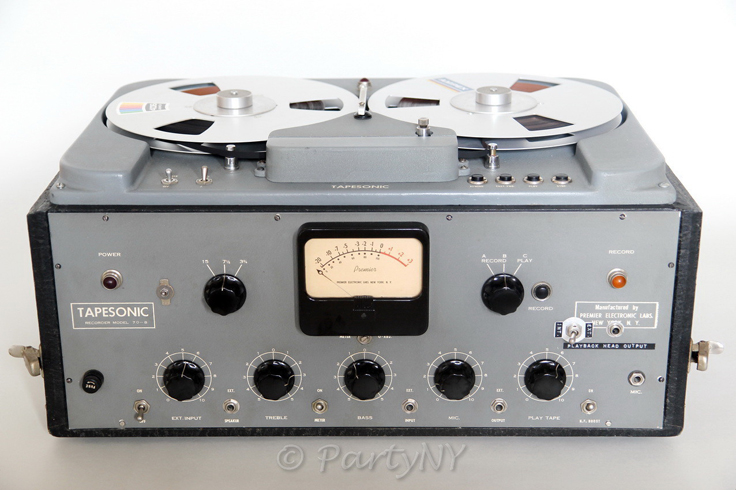 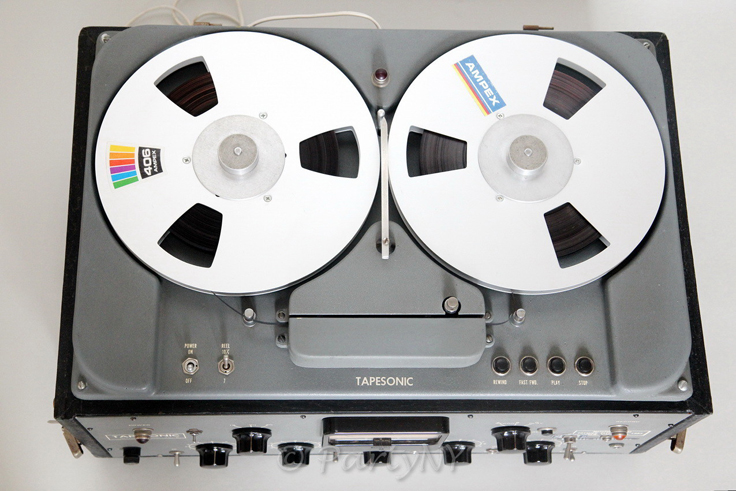 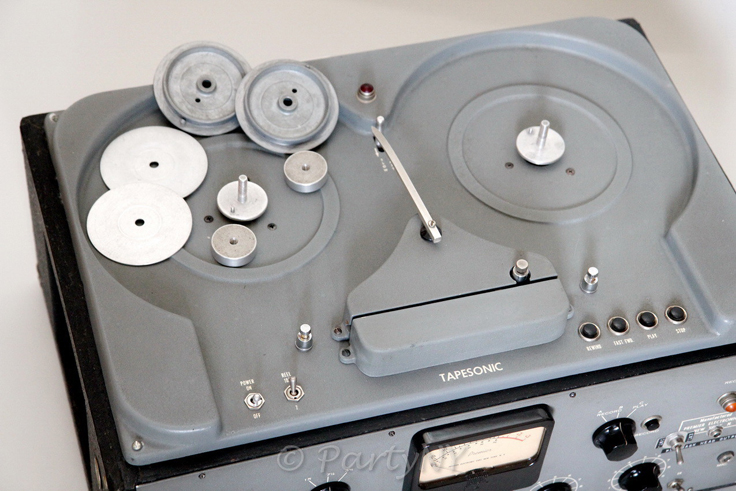 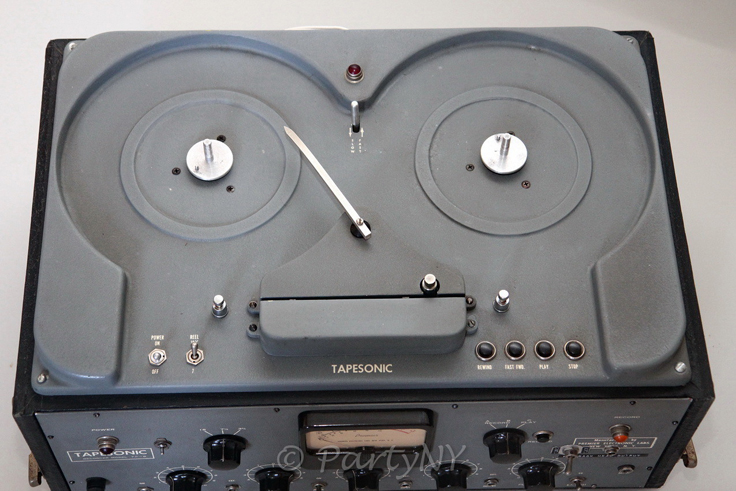 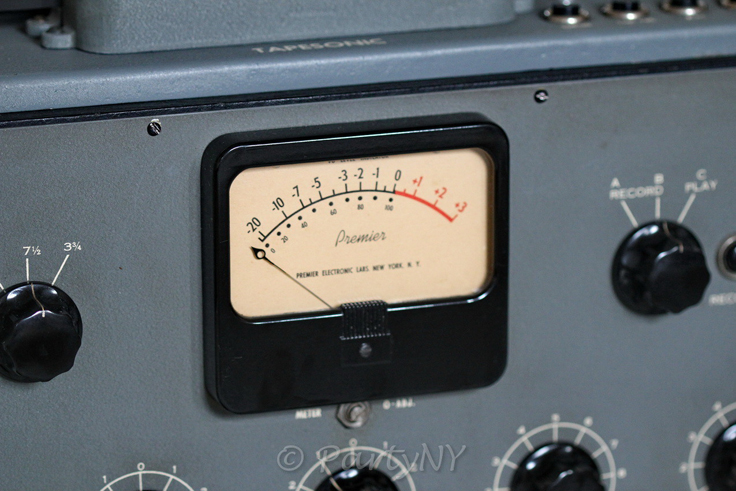 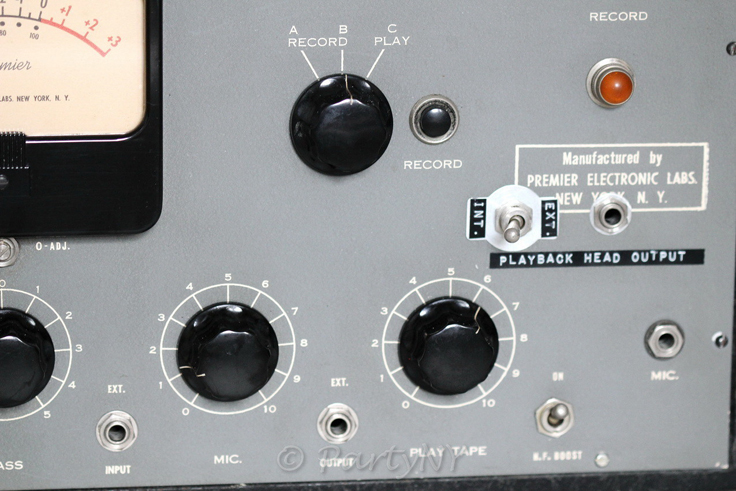 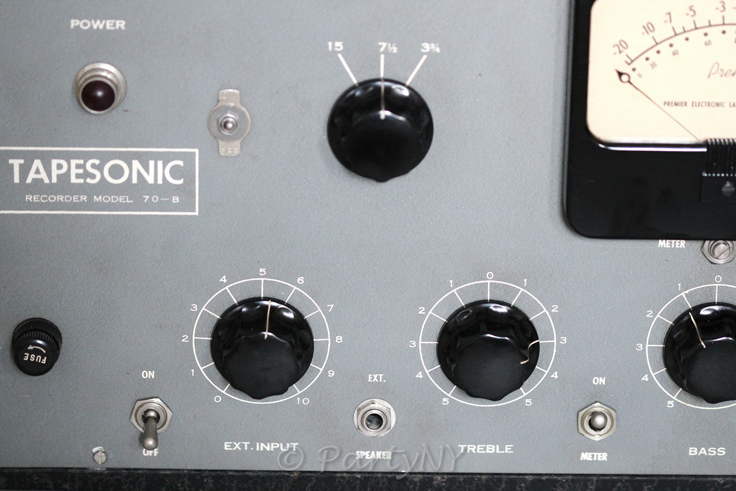 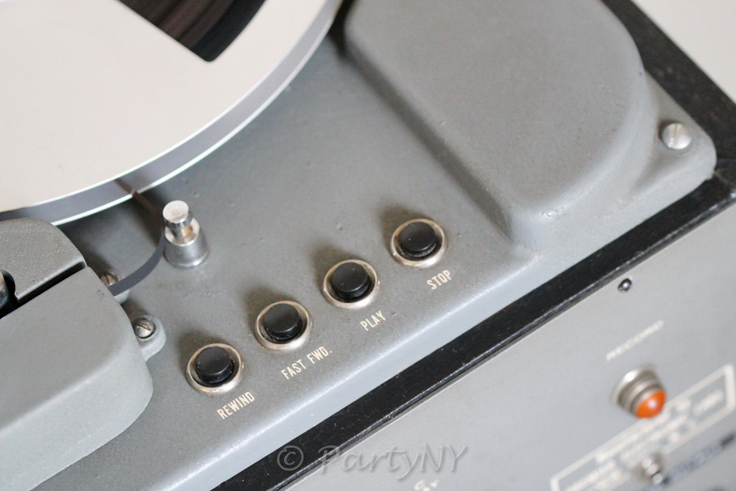 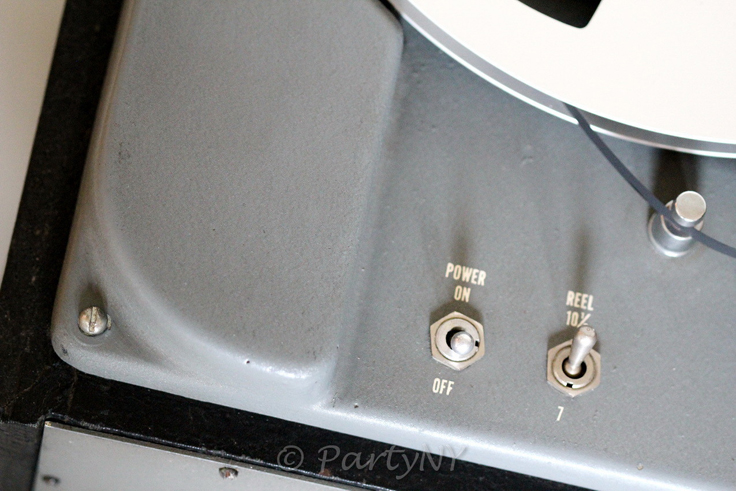 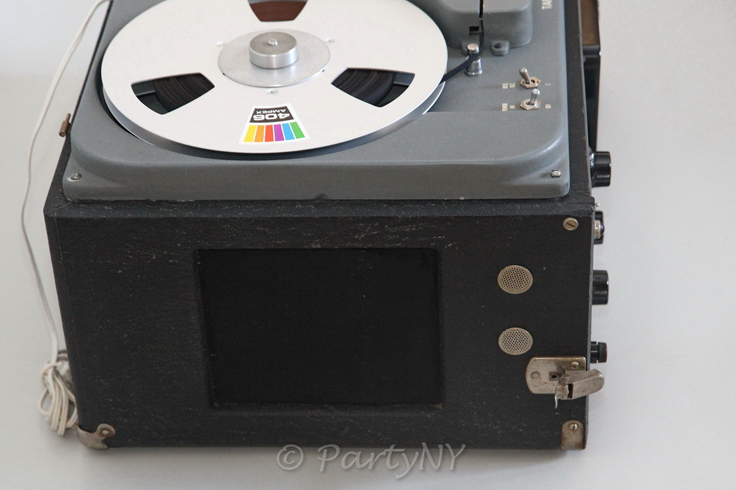 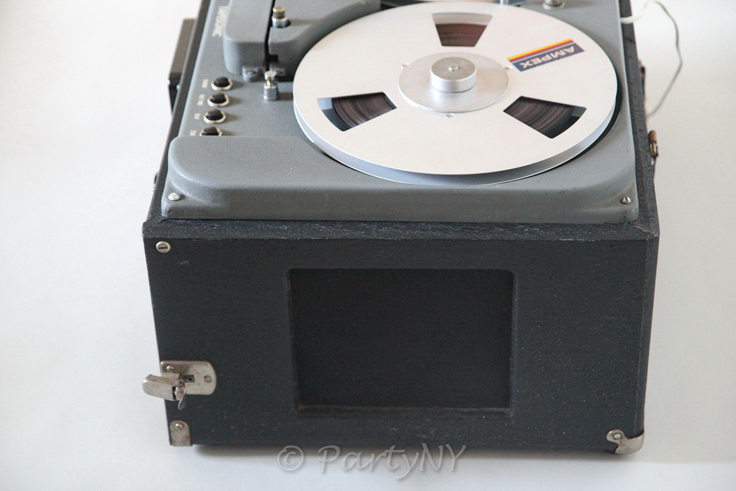   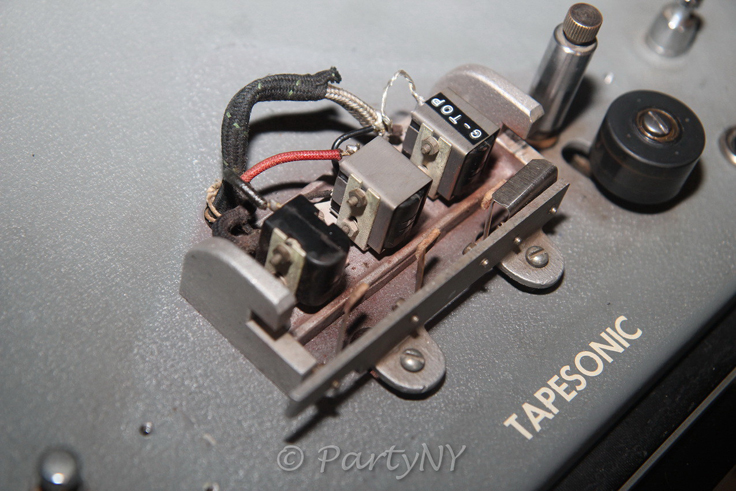 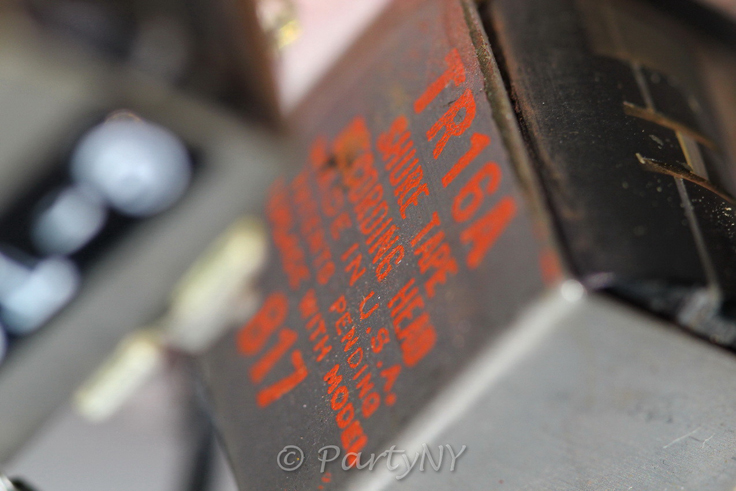 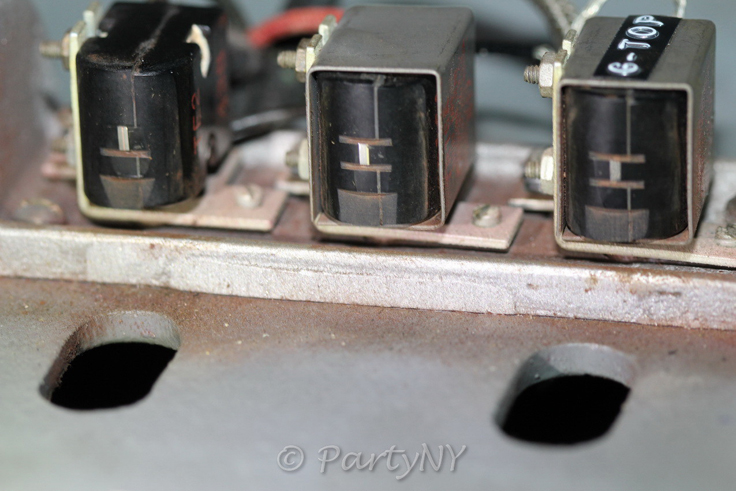  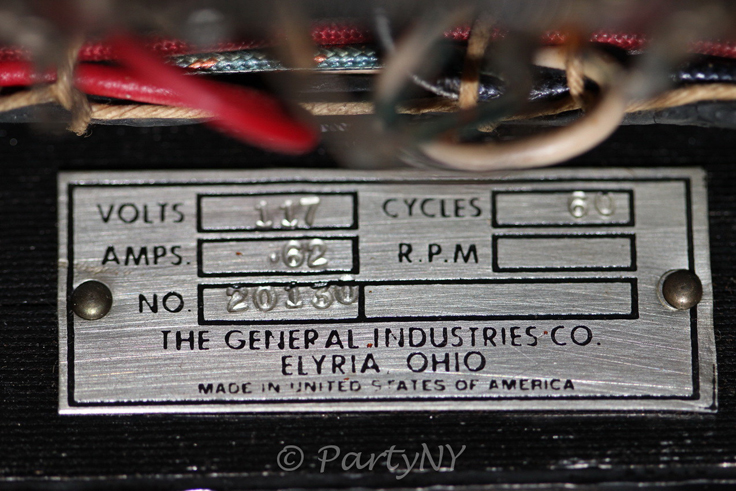 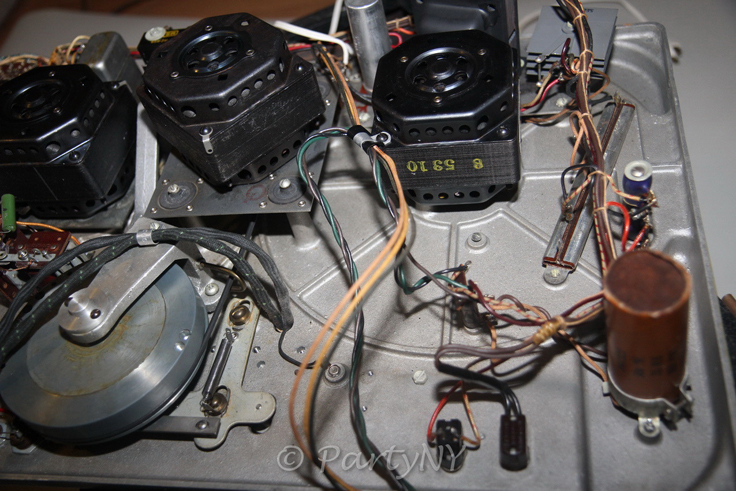 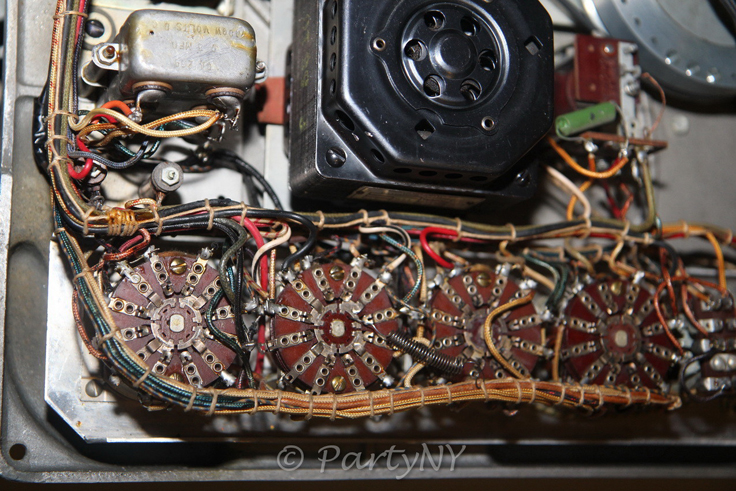 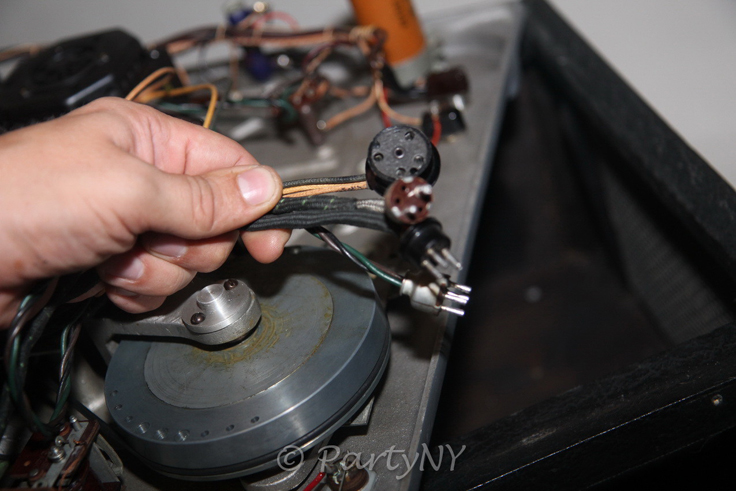 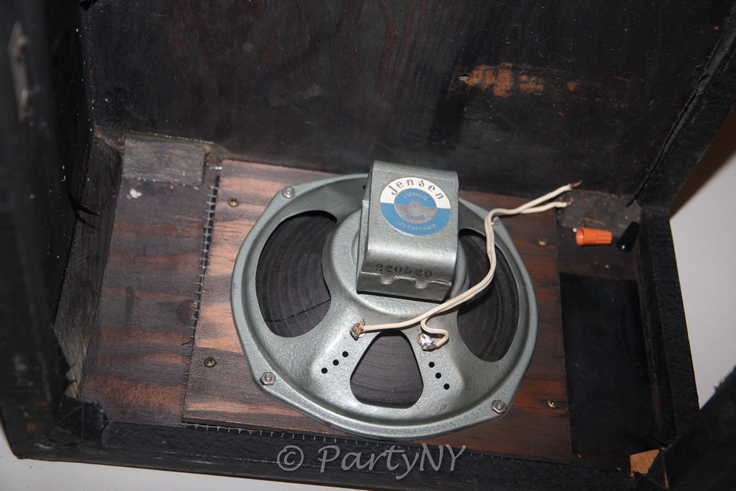 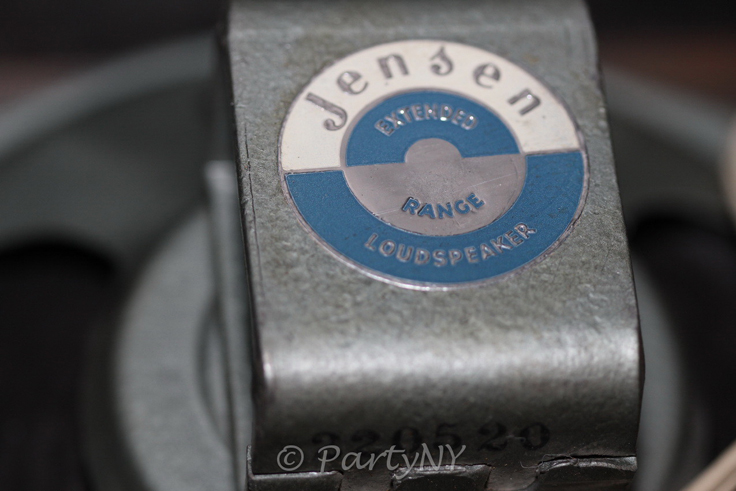 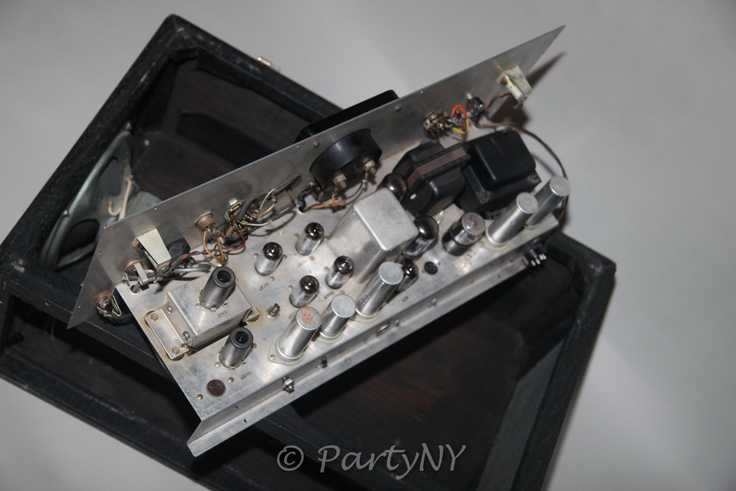 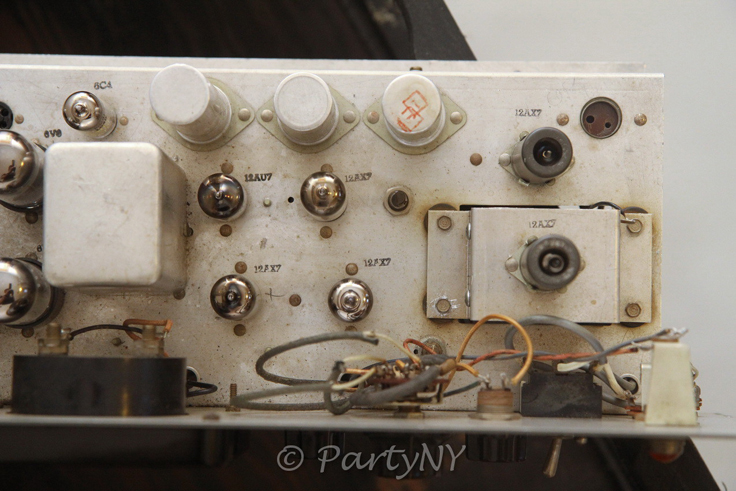  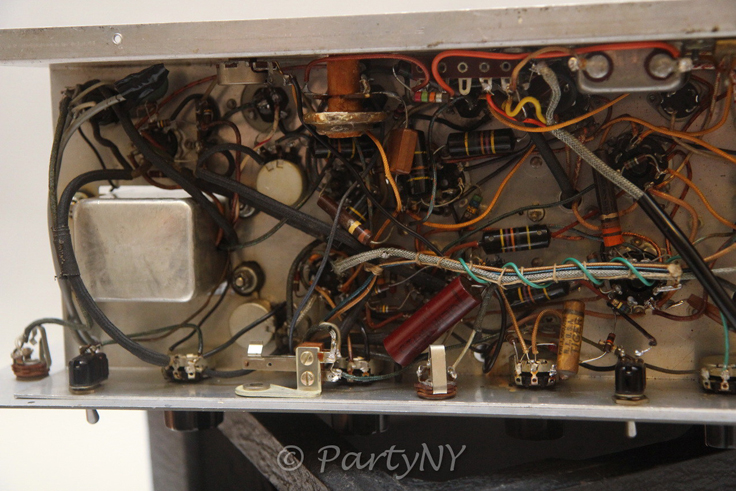  
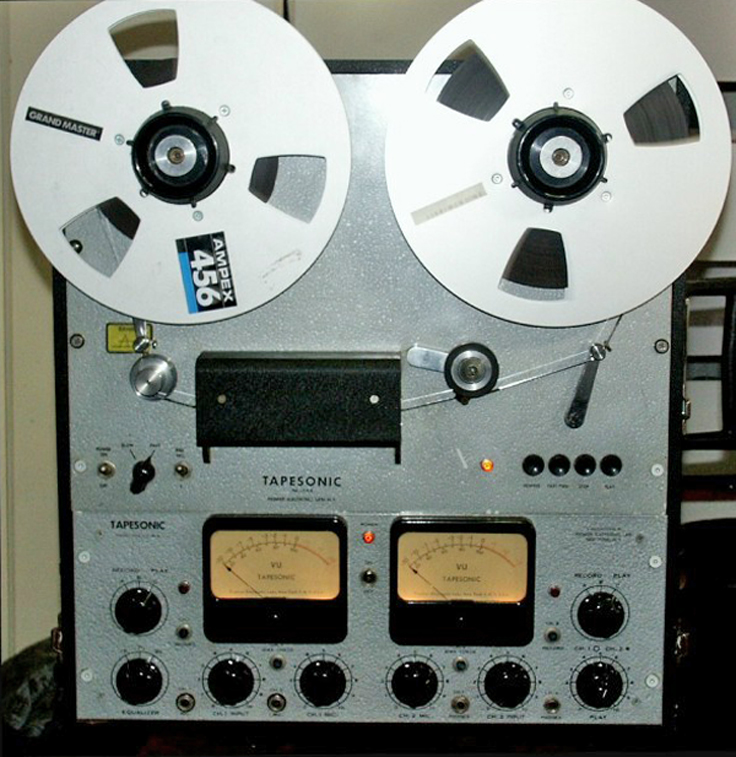 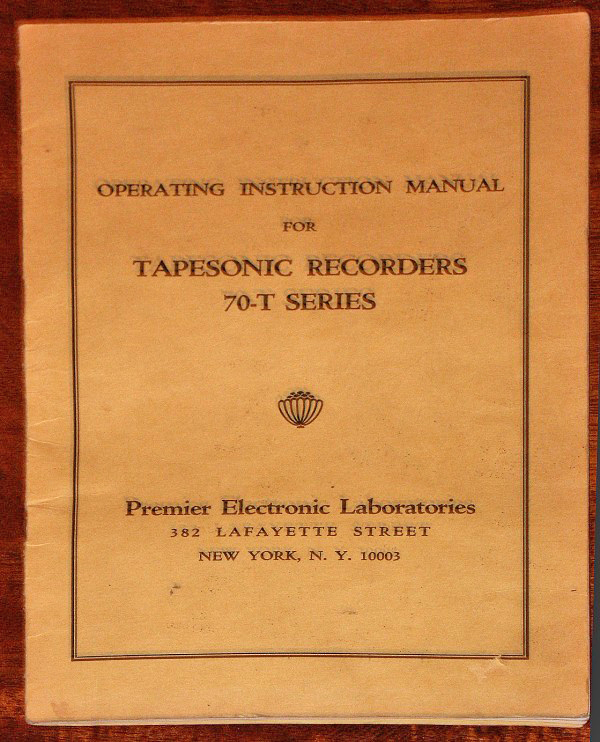 
From a sales summary in 2006 - This is a truly unique deck - wearing Premier Electronics manufacturing name, it was actually a collaborative effort between machinist Adolph Miller (transport) and Harry Kolbe (electronics & transport control). The deck has been (unjustly)) referred to as "the poor man's Ampex 350 [portable]", but, having owned both 3 & 4 series Ampex (I do love them, warts and all), this deck has quite a few advantages over the 3-series:
• No silly "door" which had to be lifted for winding to lift the tape off the heads $$ made splice work next to impossible - this deck has a mechanism similar to the 4-series Ampex.
• Much lighter than 350 portable - Ampex was a tank, designed for module-level maintenance (the military origins are obvious).
• The maintenance & alignment are simpler, everything from braking adjustment & reel torque to headset & eq alignment
• Huge VU meters & huge black Bakelite knobs which wouldn't look out of place in Frankenstein's lab - I bought the thing as soon as I opened the case.
This deck was ground-up restored ~5 years ago, transport adjusted for "kind" tape handling ( fast wind torque && breaking set up for gentle tape transport, rather than maximum wind speeds & on-the-dime braking, pressure roller turned, heads (1/2 track 1/4 inch) lapped, polished, and aligned with MRL tape for playback, and subsequently aligned for Ampex 456 tape (thus clicking the "bias-check button should make the meters point to 3db - ignore the operating manual on this - it talks about Scotch tapes). There is plenty of room for higher bias currents.
The tape deck & recording/playback amp come in a tolex-covered "portable" case, standard rack size, with front & rear covers. The back cover is vented & could remain on the deck during operation, and the deck works great in a 90 degree upright position (which is how I used it, but horizontal & slightly-tilted position is, at least theoretically, should give a slight advantage (lower mechanical noise, better bearing loading etc., etc). The front cover has one broken latch, which I've never bothered replacing, since it latched down just fine with 3 remaining ones, and i never used it as a portable.
The deck sat around for years (I no longer had the luxury of running a "break-even-if-you're-lucky Lo-Fi studio), the deck was weird & interesting enough to hold on to (built a few blocks away from where I live now, though bought in Massachusetts), but i have to seriously prune my "neat but never used" collection.
I've cleaned & fired up the deck, to make sure the deck was completely operational (both reels come with the deck, including the tape, which was not recorded on this deck & was not mastered by me - just a chunk of test tape I'm including so that you can test the deck without risking your own tapes). Everything on the deck works, no mods other than the two mono headphone outputs (one for each track) were combined into one stereo jack (if you choose to use the built-in headphone amp, which is not bad. The speeds are 7.5ips on the ""slow" setting & 15ips on the fast.
The ORIGINAL OWNER'S MANUAL is included, this was given to me by a man who's also responsible for the typed writeup (see pics below).
The deck's located in NYC, and, while local pickup is a plus, I'll package & ship, double-boxed etc., etc. While the deck itself weighs ~65lbs, with packing, think 75 pounds (had one bad experience with UPS, don't want to repeat it. If you need more pics or info, don't hesitate to ask.
|
| |

Teac Tascam
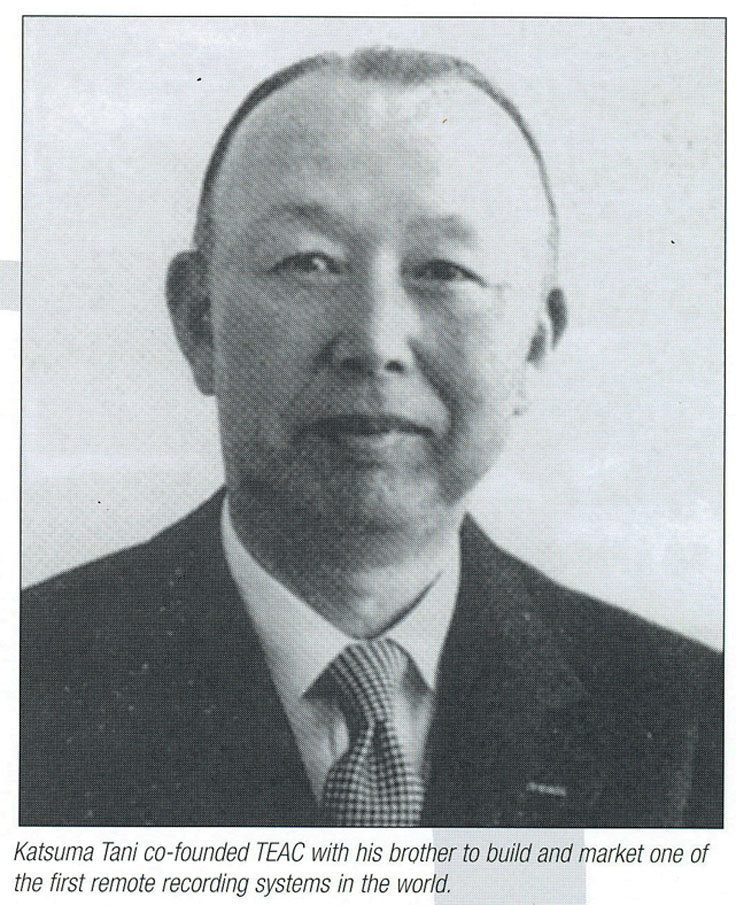 TEAC corporation was founded by in August 1953. Originally named the Tokyo Television Acoustic Company it employed Katsuma Tani, a former aviation and aeronautics engineer where he established a reputation as a highly qualified creator of audio equipment. TEAC corporation was founded by in August 1953. Originally named the Tokyo Television Acoustic Company it employed Katsuma Tani, a former aviation and aeronautics engineer where he established a reputation as a highly qualified creator of audio equipment.
In 1956 his brother Tomoma Tani brought home a hand made 3-motor, 3 head stereo tape recorder. This sparked Katsuma's interest in reel-to-reel tape recorders. Confident they could engineer a better tape recorder the Tani brothers founded the Tokyo Electro-Acoustic Company on December 24th, 1956.Its goal was to be a leader in magnetic recording technology. Factory was set up in Musashino City, Tokyo for the manufacture and sale of semi-professional audio components for recording and playback along with general electrical appliances.
In 1956 the company changed its name to the Tokyo Electro Acoustic Company and then to TEAC. The factory was setup in Chitose-cho, Sumida Ward, Tokyo for the production of audio components, measurement and optical equipment and tape recorders.
Go to much more about Teac/Tascam
|
| |
Technics
Panasonic National Technics, 3-5-1 Ariake,
Koto-ku, Tokyo,
Japan
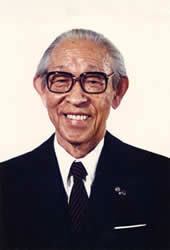 Panasonic was founded in 1918 by Konosuke Matsushita first selling duplex lamp sockets. In 1927, it produced a bicycle lamp, the first product it marketed under the brand name National. It operated factories in Japan and other parts of Asia through the end of World War II, producing electrical components and appliances such as light fixtures, motors, and electric irons. Panasonic was founded in 1918 by Konosuke Matsushita first selling duplex lamp sockets. In 1927, it produced a bicycle lamp, the first product it marketed under the brand name National. It operated factories in Japan and other parts of Asia through the end of World War II, producing electrical components and appliances such as light fixtures, motors, and electric irons.
In post-war Japan, the company came under severe restrictions imposed on large Japanese companies by the Allies. Matsushita was in danger of removal as president, but was saved by a favorable petition signed by 15,000 employees.
After World War II, Panasonic regrouped and began to supply the post war boom in Japan with radios and appliances, as well as bicycles.
Matsushita's brother-in-law, Toshio Iue founded Sanyo as a subcontractor for components after WWII. Sanyo grew to become a competitor to Panasonic, but the rivalry settled down and Sanyo eventually became a subsidiary of Panasonic in December 2009.
Since 1954, Matsushita also gained a significant share holding in manufacturer JVC by forming an alliance. It still retains a 50% share today.
In 1961, Konosuke Matsushita traveled to the United States and met with American dealers. Panasonic began producing television sets for the U.S. market under the Panasonic brand name. To the left is the RS-1000 reel to reel tape recorder with speakers.
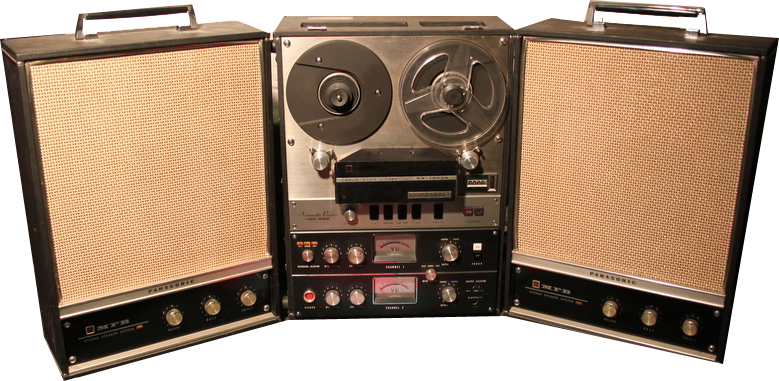 The company used the National trademark outside of North America during the 1950s through the 1970s. The trademark could not be used in the USA, probably because it was already in use by the The company used the National trademark outside of North America during the 1950s through the 1970s. The trademark could not be used in the USA, probably because it was already in use by the
National Radio Company who were operating in a closely related product area.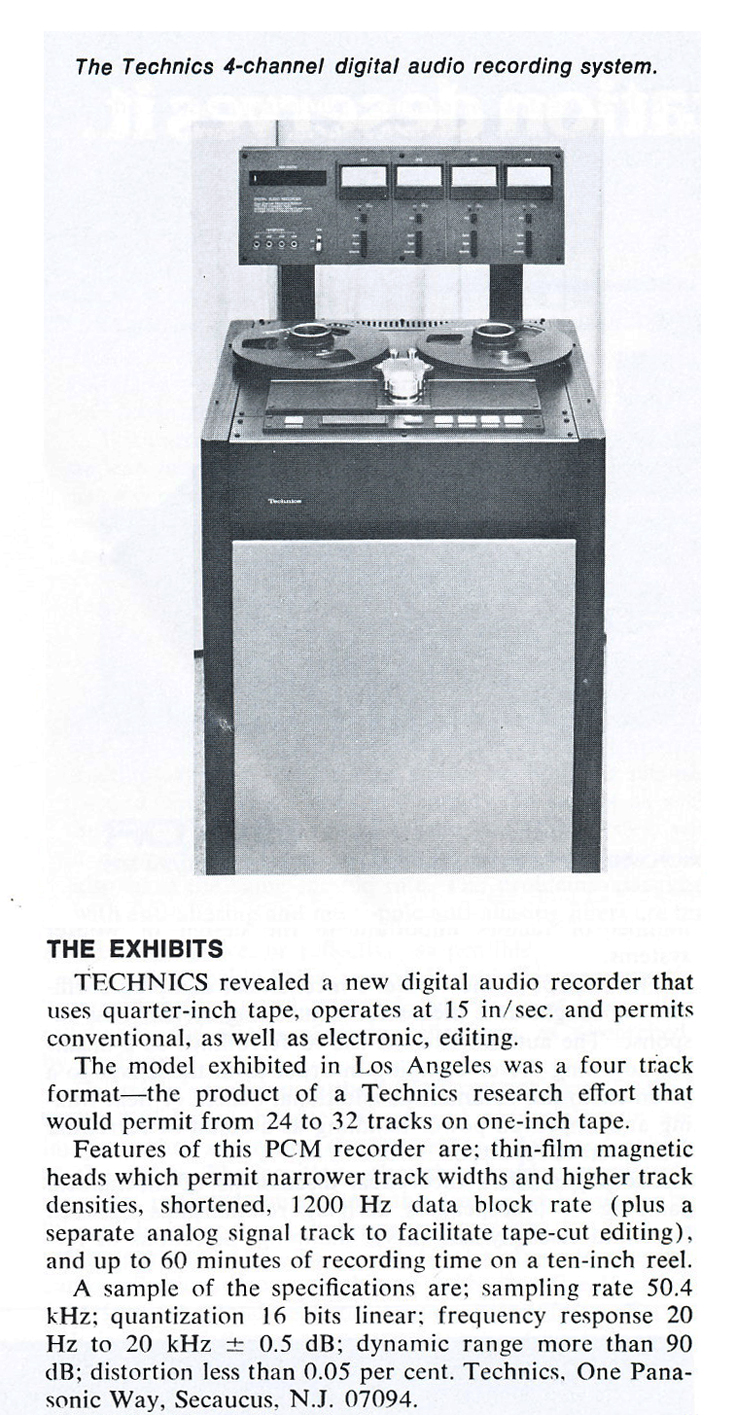
The company debuted a hi-fidelity audio speaker in Japan in 1965 with the brand Technics. This line of high quality stereo components became worldwide favorites.
Matsushita retired in 1973. Chronic lung problems lead to his death from pneumonia on 27 April 1989, at the a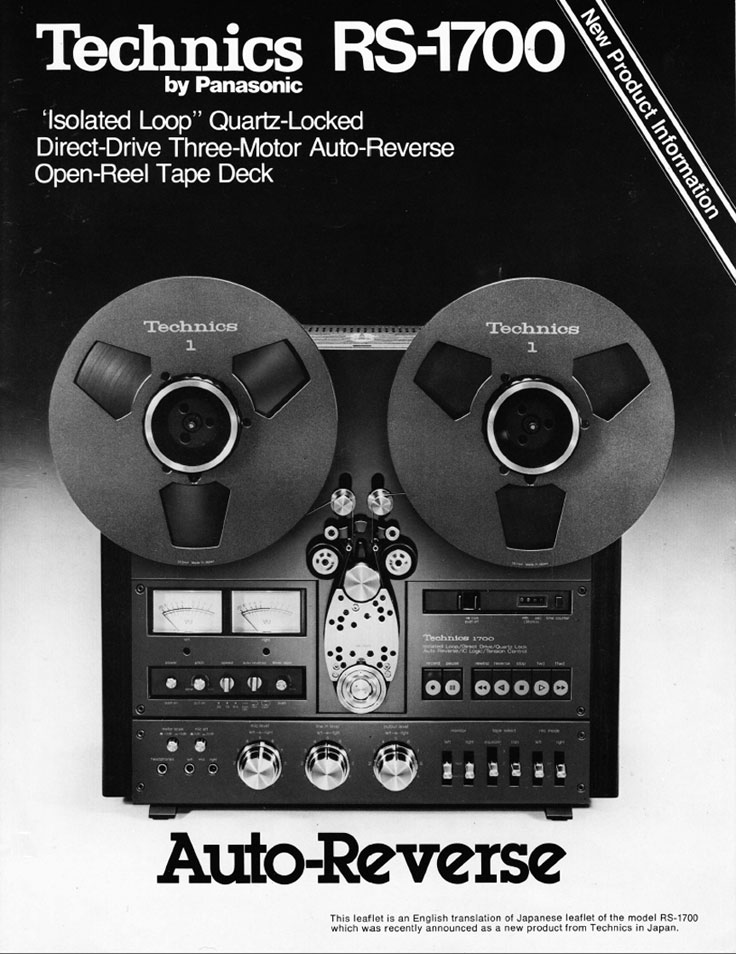 ge of 94. He died with personal assets worth US$3 billion, and left a company with US $42 billion in revenue business. ge of 94. He died with personal assets worth US$3 billion, and left a company with US $42 billion in revenue business.
The RS-1500 and the other related models (RS-1506, RS-1520 and RS-1700) of reel tape recorders were built from 1976-1985.
Panasonic has a good section on the internet about their history. However like many of the other companies, there is no mention of their Panasonic reel to reel production, nor their Technics "RS" line of closed loop reel tape recorders.
Cassettes & VCRs are mentioned but no R2R.
Below is the Technics RS-1700 in the Museum of Magnetic Sound Recording
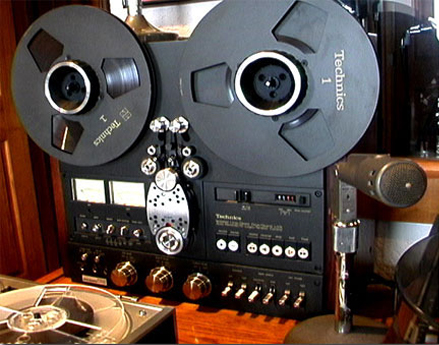
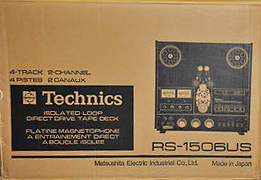 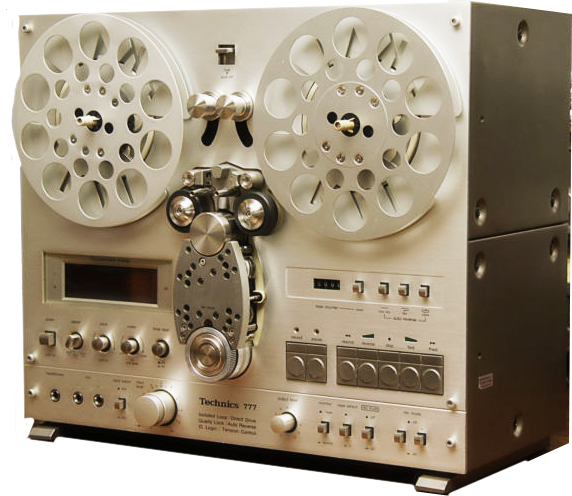 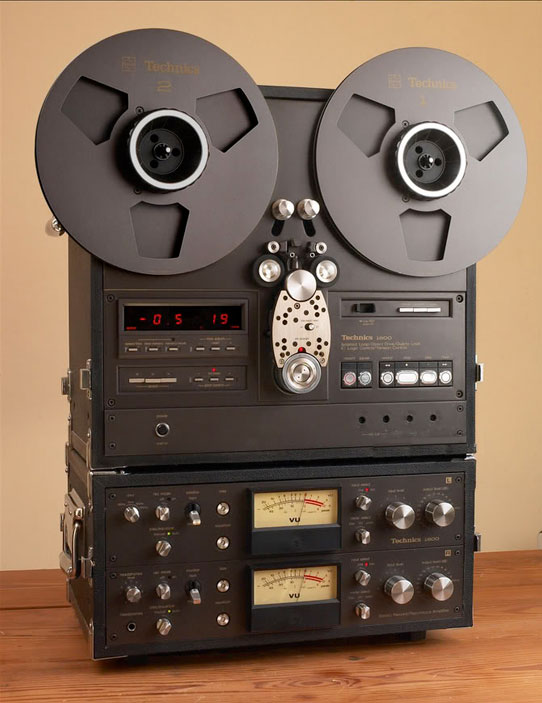
|
| |
Telefunken 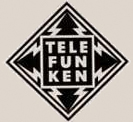
Telefunken Holding AG,Frankfurt, Germany - 1903 - present
Currently, Telefunken is the owner of more than 20,000 patents and active in over 130 countries around the globe
Telefunken is a German radio and television apparatus company, founded in Berlin in 1903, as a joint venture of Siemens & Halske and the Allgemeine Elektricitäts-Gesellschaft (General Electricity Company).
On April 17, 1904, the company changed its name to "Telefunken, Gesellschaft für drahtlose Telegraphie", and on July 26, 1932 Telefunkenplatte GmbH officially began its commercial activity with registered capital of 100,000 Reichsmarks.
The world tour of the Graf Zeppelin airship in 1929 got off the ground by using Telefunken transmitters, receivers and directional equipment exclusively.
Magnetophon was the brand or model name of the pioneering reel-to-reel tape recorder developed by engineers of the German electronics company AEG in the 1930s
On September 24, 1941, AEG took over the 50% of Telefunken shares owned by Siemens & Halske AGTelefunken became a 100% subsidiary of AEG.
AEG engineers made rapid strides in perfecting the tape recorder system and had practical stereo recorders by 1943
Magnetophon recorders were widely used in German radio broadcasts during World War II, although they were a closely guarded secret at the time
The reconstruction after the World War II posed a particularly difficult challenge to Telefunken. All production facilities and equipment were destroyed, disassembled or confiscated and many valuable experts were scattered around the world. Rebuilding began in West Germany and Berlin in 1945
The name of the company was changed to Telefunken GmbH on January 4, 1955
Telefunken GmbH became Telefunken AG on July 5, 1963.
The business activities of Telefunken were transferred to AEG effective January 1, 1967, and were continued under the combined name AEG-Telefunken.
AEG-Telefunken delivered the two-millionth tape recorder, a Magnetophon 204 TS, on August 5, 1969.
When AEG was bought by Daimler in 1985, "Telefunken" was dropped from the company name.
|
| |
Toshiba 
Toshiba - 1-1, Shibaura 1-chome, Minato-ku, Tokyo , 105-8001, Japan
1875 saw the establishment of Tanaka Seizo-sho (Tanaka Engineering Works), Japan's first manufacturer of telegraphic equipment.
Its founder, Hisashige Tanaka (1799 - 1881), was well known from his youth for inventions that included mechanical dolls and a perpetual clock.
The company became one of Japan's largest manufacturers of heavy electrical apparatus.
In 1890, Hakunetsu-sha & Co., Ltd. was established as Japan's first plant for electric incandescent lamps.
Subsequent diversification saw the company evolve as a manufacturer of consumer products.
In 1899, the company was renamed Tokyo Denki (Tokyo Electric Co.).
In 1939, these two companies, leaders in their respective fields, merged to form an integrated electric equipment manufacturer, Tokyo Shibaura Denki (Tokyo Shibaura Electric Co., Ltd.). The company was soon well known as 'Toshiba,' which became its official name in 1978.
Unfortunately there is no mention of their building reel to reel tape recorders.
|
| |
Uher 
UHER informatik GmbH
, Friedrich-Seele-Straße 3, 38122 Braunschweig, Germany
1952 - present
The "UHER works Munich GmbH" were established in 1952 and the first tape recorder was released in 1953.
In 1957 10,000 were built.
In 1966 Uher employed 1500 people and produced 180,000 units. (Uher engineer - right)
The Uher "Reporter" series were sold from1961 into the 1990's.
The Uher tape recorders were imported to the US by Martel.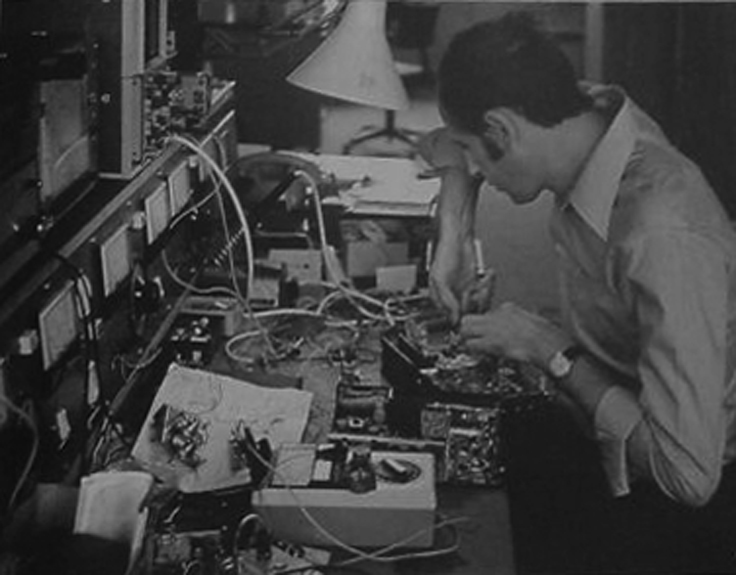
Martel was founded in 1957 and was one of the largest dictation and transcription companies in America.
Martel distributed their own brand recorders from Japan under the Martel and Telmar brands.
Martel was contacted to supply our 37th President, Richard Milhous Nixon with tape recorders for the white house.
Subsequently, Martel was required by congress to testify during the Water Gate scandal.
While the recordings were recorded on the Sony TC-800B, Nixon played them back and reviewed them on a Uher 5000.
Uher and Martel are both still in business today although not selling reel tape recorders.
|
| |
Webster Chicago & Webcor 
Webster Chicago which later became Webcor was founded in 1914. We have been unable to find any additional details of how or who founded the company. However the Webster Chicago company was acquired by the Rauland company in 1941.
Here's some additional information we found about the company on line.
The Webster-Chicago Story (www.webster-chicago.com/wcstory.htm)
Webster-Chicago Corporation of Chicago, Illinois, also later known as Webcor was once a leading manufacturer of business and consumer electronics spanning more than half a century from 1914 to the late 1960’Seth product line included phonographs and recording equipment, public address systems, amplifiers, intercoms and power supply's.
In 1925 the first factory built radios in this country included “B” battery eliminators and power packs made by Webster-Chicago. In 1926 the company designed and produced amplification equipment that helped create some of the first talking motion pictures. Webster-Chicago went on to produce and manufacture amplification and phonograph equipment for entertainment, public address and also business intercom systems which were state of the art for the time. They offered a new method of inter-office communications in large scale applications such as factory’s, office buildings, hospitals and schools.
Webster-Chicago Phonographs and Diskchangers were among the finest made and often incorporated by other leading manufacturers into some of the highest quality radio and phonograph combinations. The company introduced many different models and designs and led the industry in several innovations, including key contributions in pioneering the mutli-speed automatic Diskchangers that were famous for many years.
 In 1941 Webster Chicago was acquired by Rauland-Borg. In a 1941 catalog the electronics "were manufactured under license with Electrical Research Products, Inc. (ERPI), subsidiary of Western Electric Co., Inc., and AT&T. ERPI later became known as All Technical Service Company, or Altec which was later acquired by Lansing Company. The Webster Chicago - Rauland Borg association was said to have begun before the 1941/42 acquisition of the WC intercom and commercial sound business. In 1941 Webster Chicago was acquired by Rauland-Borg. In a 1941 catalog the electronics "were manufactured under license with Electrical Research Products, Inc. (ERPI), subsidiary of Western Electric Co., Inc., and AT&T. ERPI later became known as All Technical Service Company, or Altec which was later acquired by Lansing Company. The Webster Chicago - Rauland Borg association was said to have begun before the 1941/42 acquisition of the WC intercom and commercial sound business.
In 1945, Webster-Chicago became a licensee of the Armour Research Foundation and began manufacturing wire recorders,the first product being a version of the Armour "military" wire sound recorder which it sold to the U.S. Navy. The stainless steel wire media was perfect for military applications as it could withstand extreme temperature and climate variations in the field. After World War II came to an end, Webster-Chicago continued to produce wire recorders and introduced a whole new product line oriented toward the civilian market.
The Webster-Chicago brand was one of the top selling wire recorders ever made and the company specialized in models for both office dictation use and the private consumer market. The operation of the transport worked whereby a stainless steel wire with a diameter of .0036 inches traveled past a vertical motion recording head at an average of 24 inches a second. The units produced very lifelike sound quality, especially in some of the later high end models whereby the cabinet and amplification circuits were redesigned specifically for better frequency response. The production run lasted from about 1945 through the early 1950's.
In 1952 the company launched a new line of tape recorders and eventually discontinued its production of the modern wire recorder as the industry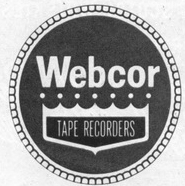 movement towards Hi-Fi was in it's initial stages. In that same year Webster-Chicago Corporation also decided to change its name to Webcor, a shortened and more streamlined name to take the company forward into the 1950’s. The conversion of the name actually showed up on some of the product line that year. One example was the model 210 Tape Recorder in which the top head cover displayed the name Webcor and the bottom head cover displayed the name Webster-Chicago Electronic Memory. movement towards Hi-Fi was in it's initial stages. In that same year Webster-Chicago Corporation also decided to change its name to Webcor, a shortened and more streamlined name to take the company forward into the 1950’s. The conversion of the name actually showed up on some of the product line that year. One example was the model 210 Tape Recorder in which the top head cover displayed the name Webcor and the bottom head cover displayed the name Webster-Chicago Electronic Memory.
The Model 210 was also the first tape recorder built for the consumer market with dual record/play heads and two balanced induction motors. This would allow for playing a tape in both directions without having to turn the reels over by hand and a single TV type control knob for ease of operation, huge selling points at that time. In 1953 the company also produced a matched 3 speaker series which began the company's endeavors into the Hi-FI arena. This development was also incorporated into the Webcor (Fonograph) product line as well.
Webcor continued to produce consumer electronics throughout the 1950’s and into the later 1960’s creating many innovations in Hi-Fi and Stereo. The company did have business problems in later years as the industry became more competitive and saturated with foreign and domestic electronics.
The greatest testament to the quality of Webster-Chicago products is the fact that so many are still working some five or six decades later and can be found for sale on many auction and vintage electronics sites. Whoever said "They just don't build them like they used to" must have meant Webster-Chicago.
Rauland - Borg history
Rauland-Borg's roots are in the founding, in 1922, of the Rauland Company by inventor and radio enthusiast E. Norman Rauland. In 1924, he became a pioneer in the radio broadcast industry by launching his own, Chicago-based radio station, WENR. Throughout the Depression, Rauland manufactured power amplifiers and equipment for public address systems. During this time, the Rauland Company won government contracts to produce radio and communication systems for the military.
In 1941 Norm Rauland and George Borg entered a partnership that would change the history of the company forever. The Rauland Corporation acquired the Webster-Chicago Corporation, a leader in school communications, and Rauland became firmly established as the dominant supplier of internal school communications systems.
In 1942, the Rauland Corporation acquired Baird Television of America. Rauland began developing the cathode ray tube (CRT), and as a result, the company became an important supplier of communications and radar equipment during WWII. After WWII, the Rauland Corporation began manufacturing CRTs for 10 and 12 inch televisions.
In 1948, two major events happened. First, Zenith Radio Corporation purchased the Rauland Corporation to acquire the CRT business. Second, Norm Rauland and George Borg started a new company, Rauland-Borg Corporation, for continuing the sound and communications business. As the company further developed its commercial and industrial communications components, they remained an important military contractor providing such essential products as the Navy's ship-to-shore radios, airborne radar jamming transmitters, walkie-talkies, classified cryptographic switching adapters, tank radios, intercom systems and radios for arctic regions.
In the early 1960s, the use of transistors was still limited but Rauland-Borg demonstrated its technological leadership by transforming its entire line of sound and communications products to transistorized and solid state components. Recognizing the need to keep school instructors and staff in touch with each other, Rauland-Borg introduced the first generation of Telecenter® products in 1968. Telecenter® was the first-ever commercial application of touch-tone technology which has since become the backbone of school communications, worldwide.
In 1979, after the acquisition of the Picker-Briggs Company, the prestigious manufacturer of the Responder® health care communications systems, Rauland-Borg established itself as a leader in nurse call communications.
In 1989, Rauland-Borg acquired Biamp Systems Company, a long-time designer and manufacturer of Biamp® professional audio equipment. In the 90s, the company expanded its existing product lines into Latin America and the Pacific Rim. Today, we respond to market needs worldwide with two distinct communication system product lines: Responder®, designed for the healthcare industry and Telecenter® systems which serve the educational market. Both product lines reflect our long-standing commitment to the cutting edge of communication innovation, and help ensure that we always have a product that is an exact fit for our customers' needs.
Here's some correspondence we received from Bill Carpenter who worked for Webcor, as well as Ampex. He provides information about Webcor's last reel tape recorder the Webcor Professional CP-2500. 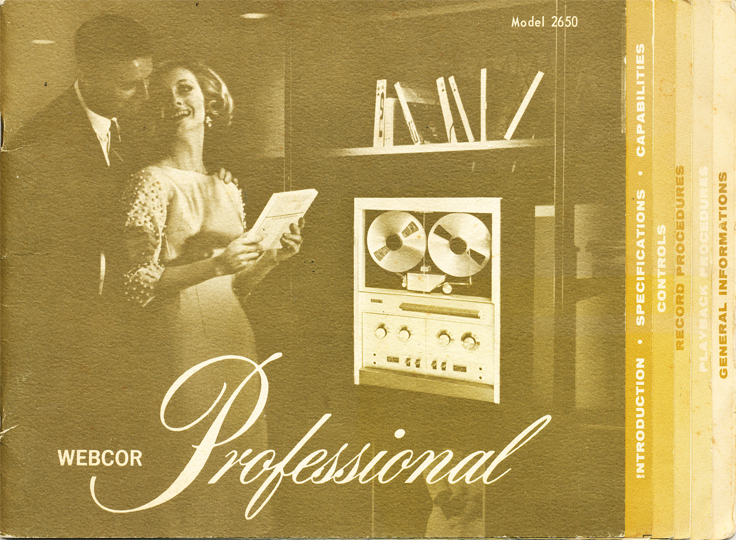
Thursday, August 6, 2009 at 11:13:07
To: Martin, Phantom Productions, Inc.
I just found your directory/museum and I think it's great.
I have a 1956 vintage, Bell & Howell "TDC" 3 motor audio recorder, which I bought in early 1956, and used to start a recording business.
Later I worked for the Govt. Div of Webcor, 1959-1964,
Webcor 1964-1965 ( I worked on the Pro 2500 product)
Ampex 1965-1971 EIPD ( Elk Grove, Il) on early 1" video recorders
Ampex 1971-1996 Redwood City,Ca, Broadcast Video Records, product management, marketing management.
I have spent my entire professional business career in magnetic recording, 12 years in design, and the remainder in management.
-----------
Hi again Martin ("Phantom")
No, The 2500 was not any cutting edge design, at least in the tape transport design. A typical BFB design of the period.
I should explain, "BFB", was our slang for " Babies First Burp", sorta like "point & shoot" for the late simple, automatic 35mm cameras.
The real development was in the sound output system.
The solid state transformer-less stereo amp was "bulletproof" in a day when a Stereo 10W/channel RMS amp was a scary design at best.
The speakers were a pneumatic loaded and were a acoustically sealed box, "bookshelf size" which were a cheap copy of the Acoustic Research AR-2a design.
They were sturdy plywood boxes, lots of fiberglass material for filling and even had a sealed RCA phono jack to make spec's
They contained a 8" soft edge long throw speaker and a 3.5" tweeter.
On low and mid range they were equal to the AR-2a's, but on the high end is where the outperformed everything available in the marketplace, except the Ionic tweeter which used a "blue gas", which was visible, and cost in the + !,000$ area, in 1965$.
The trick of the tweeter was that in trying to equal the high end performance of JBL's, Titanium Dome tweeter which was only part of the highest end systems, the design engineer stumbled on to something very great and very cheap. It was 3.5", very hard paper coned tweeter with a big magnet structure, and in our tests, the limiting factor was the spider.
In case you have never taken speakers apart, the spider is the device that centers the voice coil in the area around pole piece of the magnet.
When the engineer started cutting away portions of the spider, the performance improved and the tweeter was much flatter in response.
So, when it got so small & thin, he looked for something else to support & center the voice coil, and what worked very well was GREASE!
Not just any grease, but Dow Corning's, space age Silicon grease, namely DC-200, which was close to peanut butter in it's consistency, but silky smooth, and very slippery. They added a turned aluminum pole piece on the front of the magnet pole piece, which looked good, and did a small amount of field shaping, but the real breakthrough was replacing the spider with grease.
The speaker builder figured out how to contain the grease since it did not run and was stable over a wide temperature range.
When this was all complete, the SUPER Tweeter cost us about $3.26 each in a 100 unit quality purchase.
Many years later the speaker folks, used the same grease trick to dissipate heat to keep voice coils in big, high power speakers for burning up.
The other great feature of this product, was that to make the amp " bulletproof, a barretter, was added in series with the output transistors, which in essence, was a low resistance device in series with the output device which would change in value with increased current.
This was in the form of a 12V, taillight bulb, with two identical filaments and it was mounted on the small heat sink, between the two sets of power transistors, with wire leads going thru the pc board and a gob of silicon heat sink grease held the bulb in place during assembly.
So, when you were driving the system close to the 10W limit, the bulb would get very bright, and if you knew where to look when we were driving the system with our favorite test recordings, Leon Barry's pipe organ music, you could easily understand how well the system was working, if your ears could stand the sound pressure.
I was asked to support the first major product dealer demo, with the sales manager at the Friar's club in NY city, on about 2 hours notice, when somebody else backed out.
I said I would do it, only if I could take my own demo tape to show the system properly.
The demo went well, and I used this amp for my home stem for the next ten years, when it got replaced by a Receiver.
Bye for now, Bill Carpenter
|
| |
Wilcox-Gay 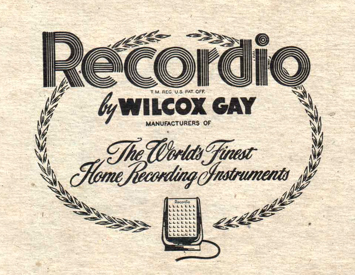
Wilcox-Gay Corp., Charlotte, Michigan
late 1910's to 1960
Wilcox-Gay Corp., which began in 1910 as a small company creating radios and transcription recorders in Charlotte, Michigan. As their business grew so did the product line they carried and in 1939 they launched the Recordio.
The Recordio device not only played records but also allowed the user to use a microphone that accompanied the player to record themselves onto a blank record - a "Recordio Disc."
The Recordio machine recorded at 78 rpm with decent fidelity. These machines also included an AM radio receiver. With this function you could record your favorite radio broadcasts to listen to time and time again.
These machines were marketed to the middle class through such media outlets as Ebony and Life magazine.
The player/recorder found its way into the hands of musicians, and Johnny Cash and Les Paul were known to use these devices.
In its debut year the Recordio device sold 25,000 units, but with the Great Depression underway and the adoption of magnetic tape the Wilcox-Gay Corp. sales declined.
In 1961 the company moved to Chicago and lasted two more years before finally declaring bankruptcy a second time and closing its doors for good in 1963.
RECORDIO
by Timothy Kastner, TapeOp the Creative Recording Magazine
|
| |
Wollensak
Wollensak, St. Paul, MN
1899 to 1972
The firm was founded in 1899 by Andrew Wollensak (1862 -1936) to produce camera shutters.
Andrew Wollensak was first employed as a machinist by Bausch and Lomb in 1882, and became a foreman the following year. He helped Edward Bausch with the design of the Iris Diaphragm shutter in 1890
The famous 'Optimo' shutter was designed by Andrew Wollensak in 1909, and was sold extensively until 1930.
At its peak in the 1950s, Wollensak employed over a thousand people.
The company had several owners, including Revere Camera Company in the 1950's and 3M Company in 1960 (3M known for their Scotch brand recording tape).
Revere started venturing into making tape recorders.
Wollensak took the basic Revere mechanism & designed a modern "aircraft construction" shell to house it, a simple 3-key and slider control system, and a compact amplifier and the "1500 series" was born.
3M acquired Revere & Wollensak in 1960. The division eventually became known as the "Mincom Division" with its headquarters in St. Paul, MN.
Wollensak needed a stereo RECORDER to compete. The engineers took the base mechanism and redesigned it to incorporate power-assisted operation and a new 2-channel amplifier. The case got a totally new look and side-mounted speakers creating the T-1580.
Ads with name musicians appeared in several publications. It retained all the traditional features, including PA ability.
The 1580 was expanded into a large upright unit seemingly inspired by the popular Roberts (Akai) units of the day.
The T-1980 "Sound Room" (1964-6) was mechanically and electronically mostly identical to the 1580 (1962-6) but bigger and more impressive, with meters instead of the neon indicators used until then.
Price had become a big issue for the consumer lines and production costs on the old 1500 mechanism and case had gone up, so a new series was designed for the consumer market - the 5000 series (1967-69).
The new designs were compact and rectangular. A reel on each side with a small control console between them. They could sit on bookshelves or be hung on a wall.
1969 Wollensak released their last R2R, the 6000 series (1969-72 to 1983) which had 2 motors and a 70 watt amp. This unit and the subsequent cassette decks were widely used by organizations and education.
Wollensak ceased operation in 1972.
Wollensak History Additional Even More 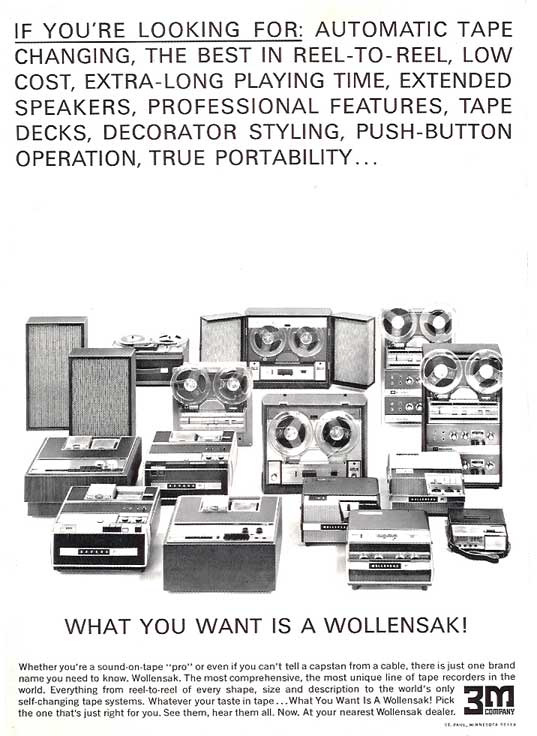
Wollensak Recorder History and Guide
by: stenkbomm
I suppose it might be helpful to write a Wollensak recorder guide while my memory still retains some details. I was a Wollensak Factory Authorized & Trained service facility manager and technician until their end.
Wollensak started out as a lens manufacturer over 100 years ago. They provided lenses and lens components to all the major American manufacturers during the 20th century until the Japanese took over the market. They also made some shutters and formed a partnership with The Revere Camera Company that led to them offering some cameras (mostly 8MM) under their name in the 50s and early 60s.
That partnership with Revere would have profound implications for both companies when Revere, like many other optical companies (Ampro, TDC, Bell & Howell, etc.) of the day (Early 50s) started venturing into making tape recorders. Revere's first offerings were mundane but they came up with a design that was a winner and would remain the basis for their machines for decades.
Enter Wollensak. They took the basic mechanism, designed a modern "aircraft construction" shell to house it, a simple 3-key and slider control system, and a compact amplifier. The resulting unit was small, light, stylish, and an instant hit. The "1500 series" was born.
Over the next few years Wollensak/Revere would make refinements and optional versions of it.
The original T-1500 was a half-track (2-track mono) recorder with a unique (for the time) amplifier, using an interstage transformer instead of a phase inverter to drive its push-pull 12AB5 amplifier. It had Record, Play, and Public Address capability which made it a hit with lecturers, schools, etc. The amplifier is often seen on eBay being sold as a "guitar amp" or other non-tape recorder usage.
3M acquired Revere/Wollensak as a perfect companion to its tape manufacturing business. The division eventually became known as the "Mincom Division" with its headquarters in St. Paul, MN. The new parentage allowed research and innovation.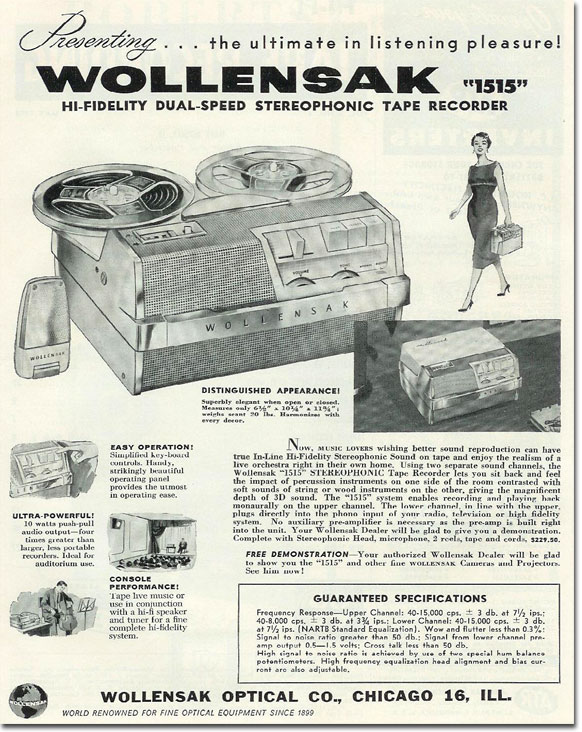
Variations of the 1500 quickly appeared. One of the first was the T-1515, a Stereo version. The 1515 replaced the standard mono head with a stereo head and added a small preamplifier for the second channel. By plugging the unit into a stereo system or adding a satellite speaker/amplifier the then-new Stereo tapes could be played. Recording was still only mono, however.
This was quickly followed by the T-1515-4 as the industry went to 4-track tapes. The head system was redesigned to include the new head and to provide a selector that moved the head up and down. The 4-track setting allowed for playing prerecorded 4-track stereo tapes. There was also a 2-track setting that lowered the head slightly so it tracked 2-track tapes without the loss in channel one that was common to other brands. A 3rd position allowed for recording 4-track mono by shifting the active (recording) poles to the different parts of the tape to accomplish this. Others would adopt this approach too, including Webcor & Akai/Roberts.
One of the rarest was the TS-1520/T-1700, which could run from standard AC or from a 12 volt DC (car) battery thanks to their built-in vibrator or inverter systems. (This unit should not be confused with the later 1520AV) This allowed location recording of a better quality than the average existing transistor and clockwork units then available but improvements in these designs made it obsolete very quickly.
Small internal improvements were made, mostly to the idler wheel carriers and later to the rewind arm but the drive mechanism was essentially still the original Revere design.
There was also an "economy" series of the two then-current 1500 models (T-1500 & T-1515-4): the "1400 series". The T-1400 and T-1440 were identical to the 1500 units except they were painted a dark gray instead of having the brushed or polished bare aluminum of the regular units.
For the "deluxe" end of the market they redesigned the shell and added push buttons and relays to make soft-touch controls and the possibility of remote operation available. The T-1600 & T-1616 were never great sellers but did look spiffy and added prestige.
The demand for mono recorders was falling, however, and what there was for it was increasingly being filled by cheaper units from Japan. Wollensak needed a stereo RECORDER to compete.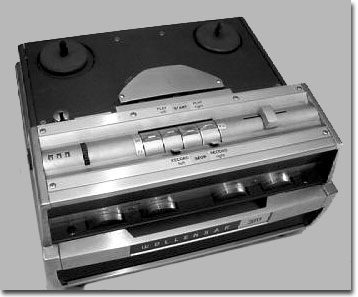
The engineers took the base mechanism and redesigned it to incorporate power-assisted operation and a new 2-channel amplifier. The case got a totally new look and side-mounted speakers. The T-1580 was an instant success and had fairly good specs for the price. Ads with name musicians appeared in several publications. It retained all the traditional features, including PA ability. A mono version, the T-1570 never caught on, but the 1580 remained in the catalog for a few years.
The 1580 was expanded into a large upright unit seemingly inspired by the popular Roberts (Akai) units of the day. The T-1980 "Sound Room" was mechanically and electronically mostly identical to the 1580 but bigger and more impressive, with meters instead of the neon indicators used until then.
The 1980 was also offered as a build-in version without the carry case as the T-1780.
The 1580 mechanism was also used, with different amplifiers, cases, in lower-priced or later models such as the T-1280.
In an effort to keep a foot in the low-end market a totally new design, the T-524 was offered but never did well.
During all this the original 1500 was still selling well, especially to schools and corporations. 3M renamed it the T-1500AV but otherwise it remained pretty much the same until they decided to update it to a transistor (solid-state) amplifier and give it a small meter. It was then dubbed the T-1500SS.
Price had become a big issue for the consumer lines and production costs on the old 1500 mechanism and case had gone up, so a new series was designed for the consumer market - the 5000 series.
The new designs were compact and rectangular. A reel on each side with a small control console between them. They could sit on bookshelves or be hung on a wall. A simple mechanism, plastic parts, and power-operated push button controls made for a lighter unit. All were solid-state. Models ranged from full portables with plastic cases to wooden-cased models with detachable wing or shelf speakers. With the exception of one mono model all were stereo. The first series was the 5200/5300 series (5150 for the mono version) and a later series with mechanical improvements and a headphone jack was the 5700/5800 series.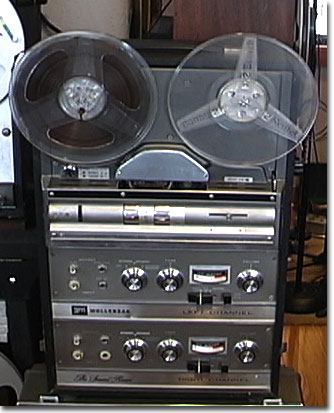
Introduced with them in 1967 was Wollensak's first and only battery portable reel-to-reel offering, the 3500. It was made in Japan and had all the features one could want at the time - selectable auto-level, solid construction, a counter, push button operation, 5-inch reel capacity, and a unique switchable speed system instead of changeable (and loss-prone) sleeves that also changed equalization for the speed selected. It was a good recorder too, with surprising sound quality for the time.
Wollensak also had started offering cassette recorders. The first, the 4100 & 4200 were rebadged Philips (Norelco) units from Holland. Buyers were not thrilled with the odd DIN connectors used, much preferring the standard jacks and plugs used by American and Japanese offerings.
After 2 years 3M gave up on the 5000 series and designed a whole new series from scratch. Nothing was carried over from the original Revere design or updates for the first time.
The new 6000 series featured a die cast chassis and head carrier. A DC motor ran the reels, leaving the AC motor free to just run the capstan, lowering wow, flutter, and speed variations. Simple key controls and open head access made use easier. It was hoped it would replace the 1500 series in commercial usage. The first model offered was a mono unit.
The line instantly expanded to all sorts of stereo units, from simple to 3-head decks and even self-contained sound systems with 3 head recording/playing and 70-watt amplifiers with turntable and tuner inputs in addition to the usual microphone and line inputs. Some were cased to be portable. The best selling of these, the 6250AV found wide use in colleges and music schools.
On the cassette front they came out with the revolutionary "dual peripheral" drive mechanism. This had a huge flywheel and good mechanical specs. A very effective auto-stop was soon added. It had the same controls as the 6000 series. Advent used this transport for its historic 201 deck (the second to use Dolby noise reduction) which kicked cassette stereo into the lead during the 70s. The mechanism would be used by Heathkit for their kit version.
Wollensak offered consumer stereo versions but chose not to make them themselves. Instead, they sent the mechanisms to Japan and had the consumer/Hi-Fi versions done there. Later units would be wholly Japanese.
These consumer versions featured contemporary items including crystal ferrite ("glass") heads. All were flat units and lost out when the industry went to upright front-loaders.
A line of 8-track recorders was also offered, including some nice ones with Dolby. They faded with the format but are much sought-after today.
Throughout all of this Wollensak cassette units, made in the U.S.A., had taken over the commercial market. With one exception they were mono recorders and nearly all had some form of projector control incorporated into them. Like the original T-1500 they were now replacing they had powerful amplifiers and PA capability. They could also program for and control slide projectors and even themselves. They filled language labs, trade shows, schools, and meeting rooms. The 2500 series ruled the market.
During this time the original 1500 design continued to have strong demand. It was updated with a new amplifier that added auto level recording and got a new green paint scheme and color-coded keys.
Competition to the cassette models began to appear at the low price end of the market so the bi-peripheral design was turned into a smaller version with a smaller amp and speaker to try to plug that hole. They never really caught on.
Wollensak also decided to offer high-speed tape duplicators during the 70s. There were reel and cassette master units and combined Master/Slave cassette models as well as add-on units. The mono 2770 was the most popular and allowed libraries and schools to turn out masses of cassettes for patrons and students in one pass. The stereo 2772 required two passes and was less common.
Wollensak finally had to just cancel manufacture of the 1520AV in 1981. Prices had reached $695 and they were still selling. 3M felt the 6000 units would serve as well and they were cheaper. There was a frenzy to find remaining stocks of 1520AVs when the word went out.
For 1982 the cassette units underwent a redesign and got bigger meters and other refinements. Digital control was added as was a deluxe stereo unit with multimedia features and full digital functions, a new servo motor drive and other features perfect for trade shows and wow presentations. It looked like Wollensak was set for the future.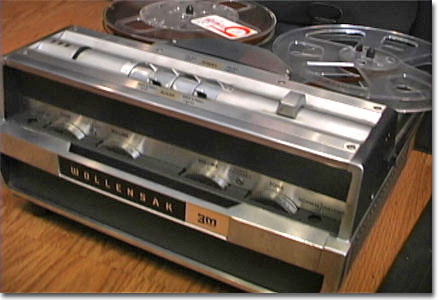
But 3M decided the profit margin on the Mincom Division was not high enough. They had a rule that said that any division that did not return more than 17% at that time was not worth the trouble. Wollensak was put up for sale and acquired by a small company who mainly wanted the duplicator line. A few of the traditional models were offered for a year or so then discontinued. The duplicators continued for a while but competition caught up and eventually they went too.
Left behind was a legacy of innovation and thousands of still functioning products, many of which will turn up here.
Major models/categories and approximate dates:
T-400, 401, 402 - Mini cassette battery recorders. (1973-5)
T-524 - Low-end offering of 1963
T-1220 - Mono version of 1280 (1964-6)
T-1280 - Shrunk economy hybrid of 1580 and 1980. (1964-6)
T-1400 - Economy version of T-1500 (1963)
T-1440 - Economy version of T-1515-4 (1963)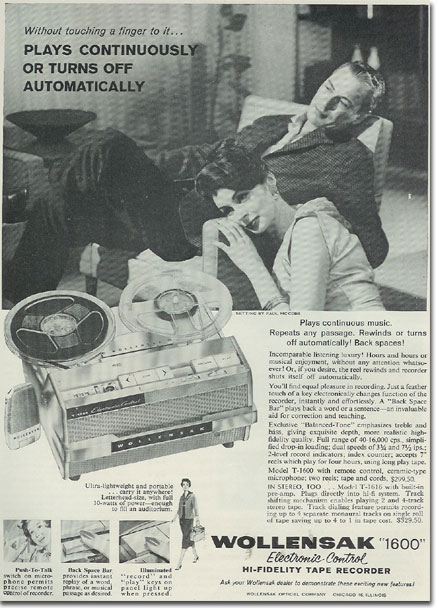
T-1500 - the original Revere-based design introduced in 1956. Offered for 10 years with various cosmetic changes/refinements.
T-1500AV - "Industrial" version of original (1965)
T-1500SS - The solid state update of the original design. (1967)
T-1515 - The 1958 "stereo" offering.
T-1515-4 - The late 1959 update of the T-1515
T-1520/TS-1520 - AC/12 Volt car model. (1960-2)
T-1520AV - The updated (final) AV model. Adds Auto Level Recording (ALR) (1969-81)
T-1570 - Mono version of T-1580 (1962)
T-1580 - First Stereo recorder. (1962-6)
T-1600 - Touch-control version of 1500. (1960)
T-1616 - Touch-control version of 1515-4 (1960)
T-1780 - Bare version of T-1980 (1964-6)
T-1980 - Large portable version of 1580 design. (1964-6)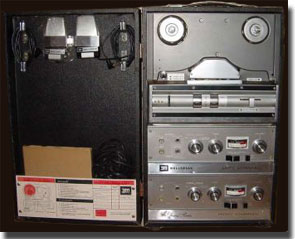
T-2520AV - Base AV cassette model. Mono record only. (1970 - 1981)
T-2522AV - Stereo AV model. No Dolby. (1970 - 1979)
T-2551AV - Most common sound/slide control model. (1971 - 1981)
(2500 series - There are many other variations including a huge one that housed a Kodak Carousel projector. 1971 - 1981)
2700 series - High-speed duplicators. (1973 - 83)
T-2800AV series - Replace 2500 series (1982)
T-3000AV - Strange late production of the original Revere classic. (1965?)
3500 - Battery portable. 5" reel capacity. (1967-9)
4100 - Cassette portable. Norelco 100 (1965)
4200 - Cassette portable. Norelco 150 (1968)
4300 - Rare cassette twin to 3500. (1969)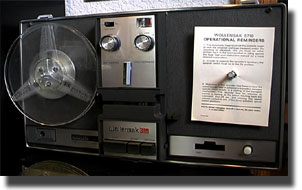
5000 series - Shelf-style replacements for consumer reel-to-reel lines. Early versions had 4 speeds. (1967-69)
6000 series - Replace consumer and AV models except for 1520AV. 3 speeds. (1969-72 to 1983)
There is no source for parts for these orphans other than belts.
- stenkbomm
The above summary used with the author's permission
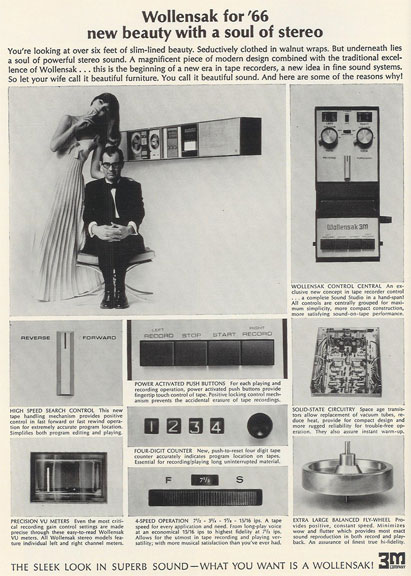 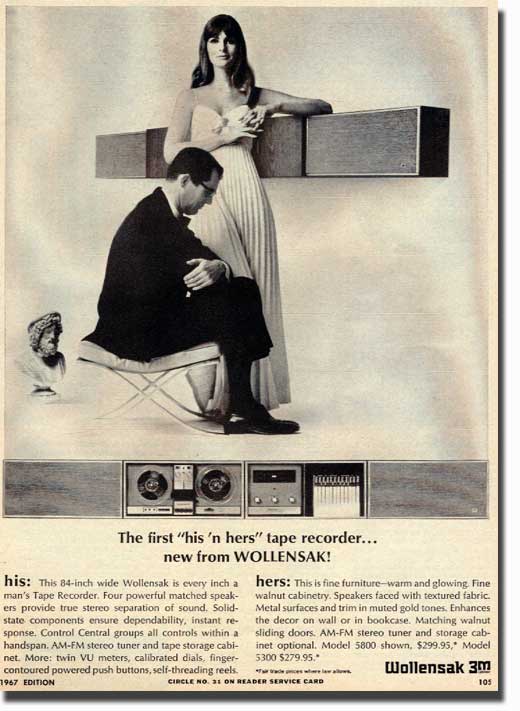 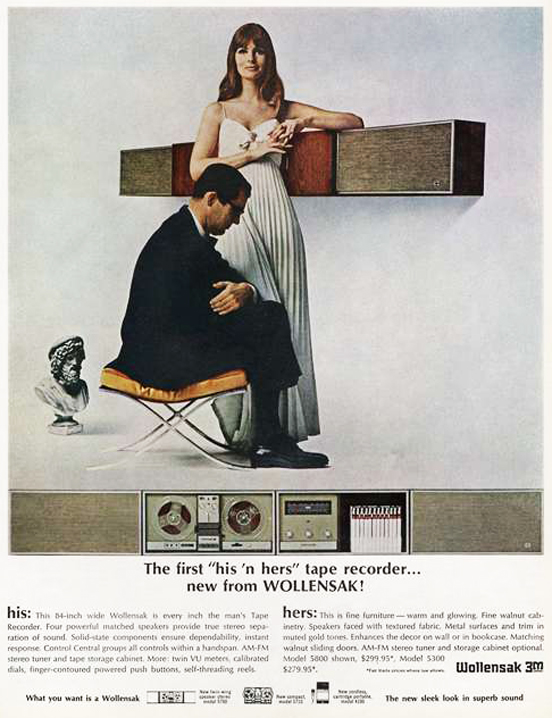 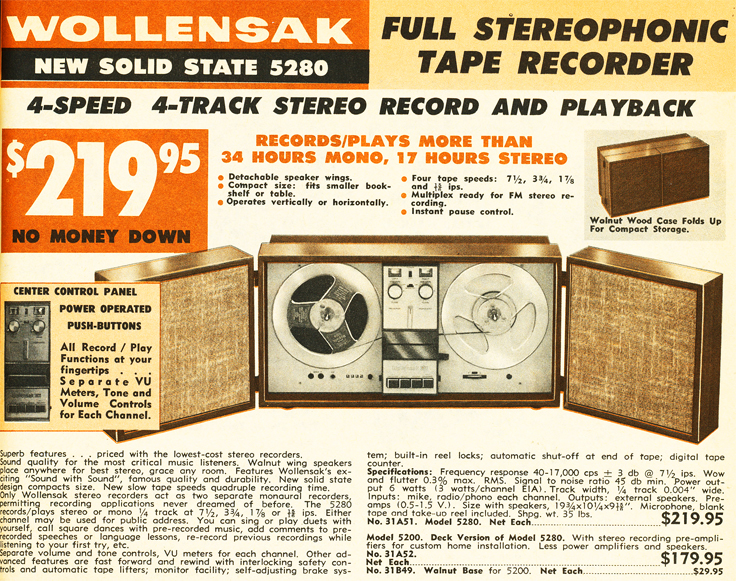 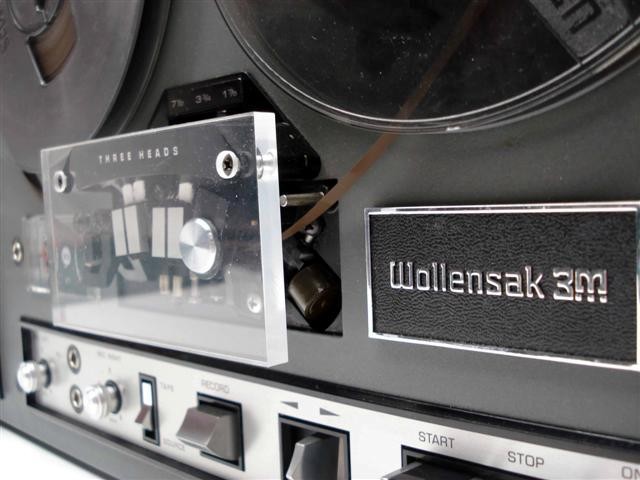 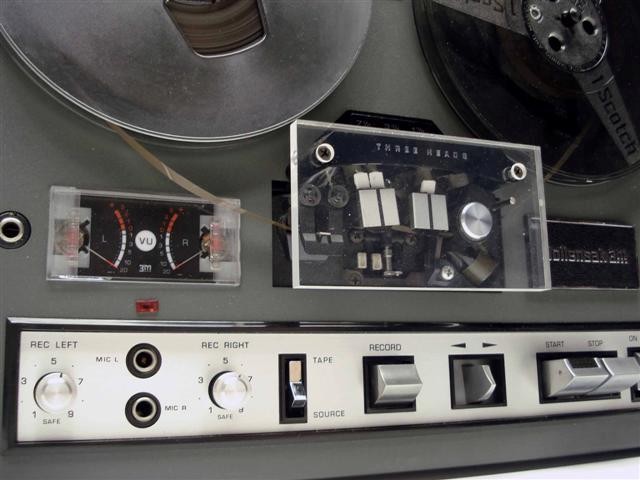 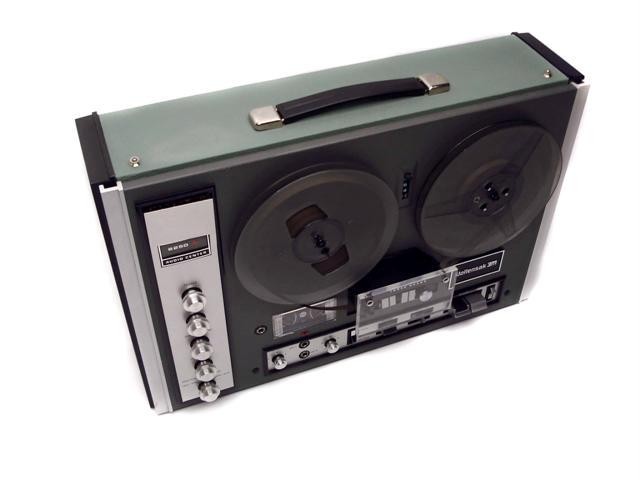
3M Wollensak 6250
3M manufactured both the Wollensak reel to reel tape recorders and the Revere reel tape recorders in the same building. The two brands were very competitive. Note the similar parts, however different looks in these photos.
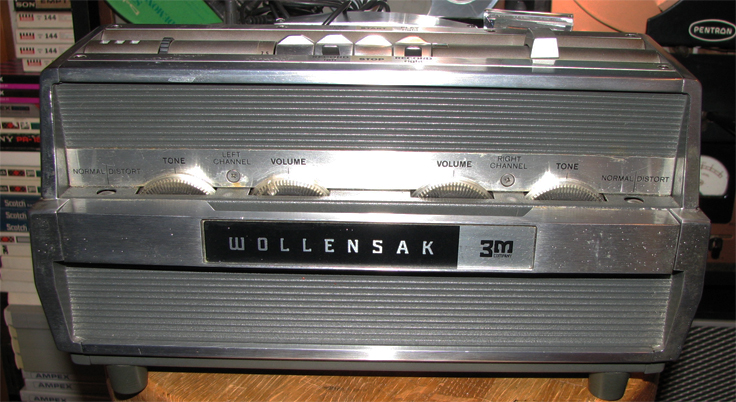 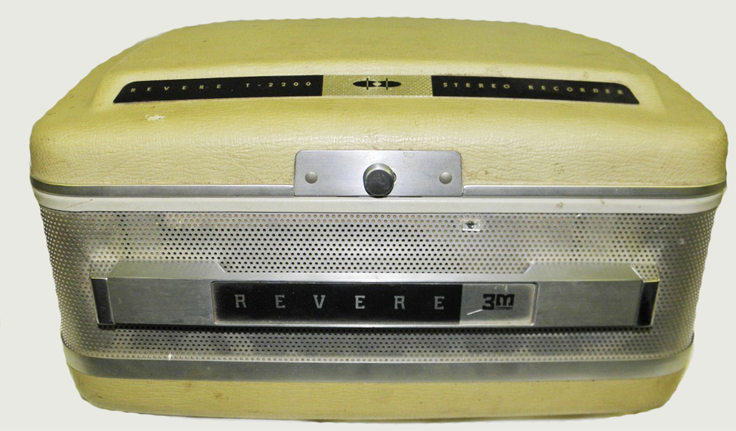
Wollensak 1580 (1965) • Revere (1961)
 
No ads for Revere were found after 1961.
Last Wollwnsak reel tape recorder information we found was available in the 1972 review of the 6364
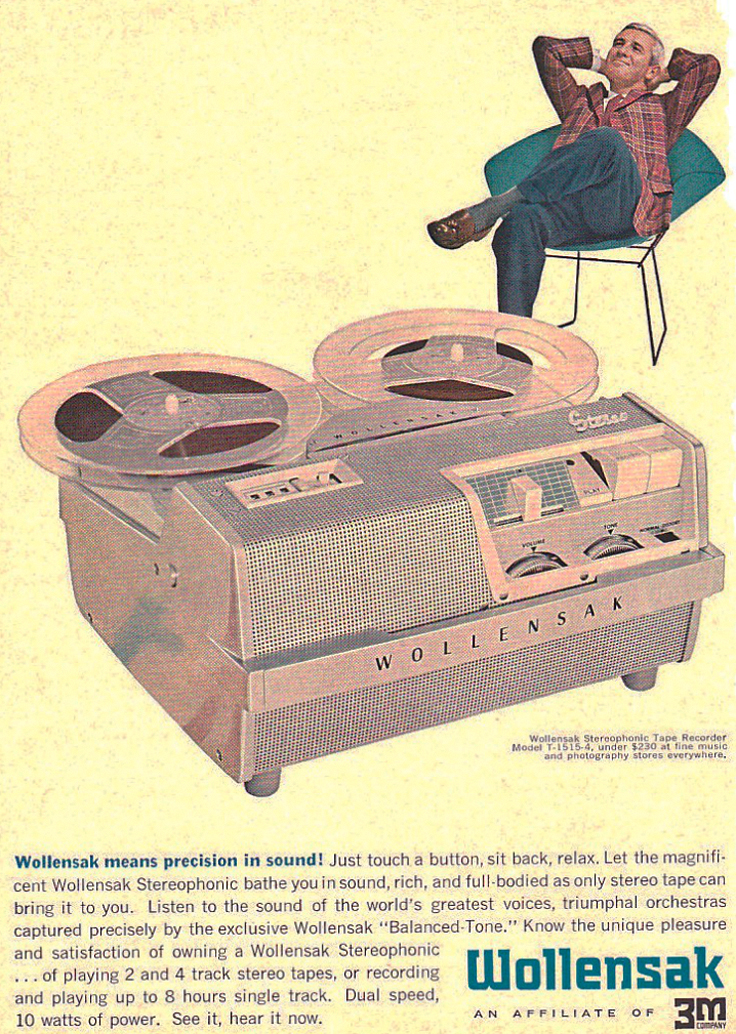 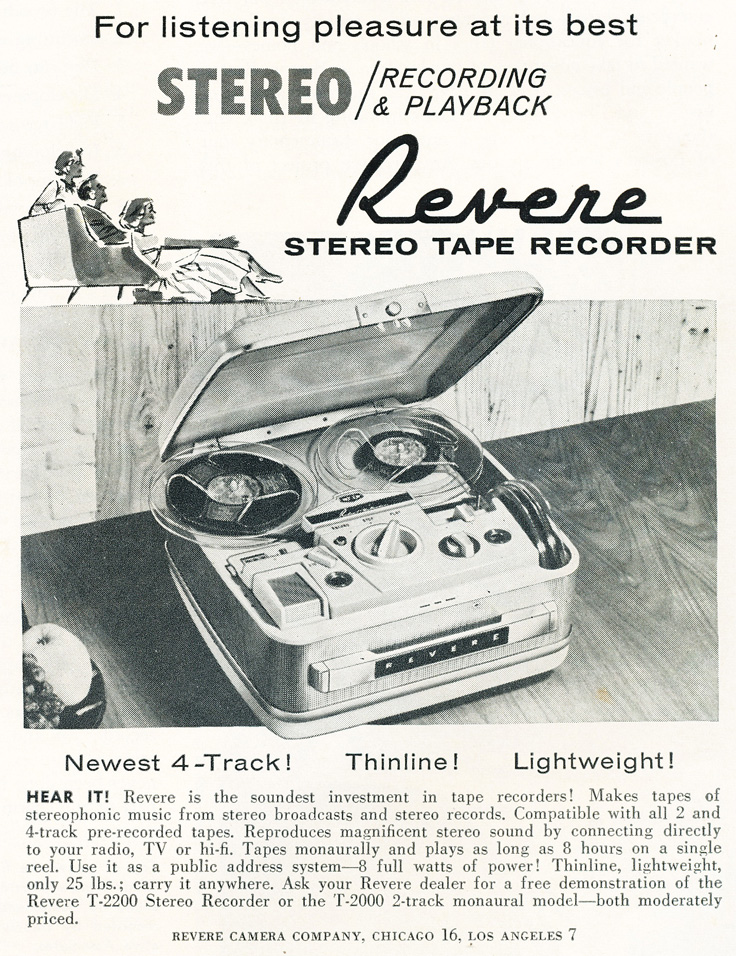
|
| |
UK Companies with tape recorders in our collection
There are 2 United Kingdom reel tape recorders in our collection. One is the Brenell Mark 5 that was added because of the history with John Lennon.
The other is the Spectone which we came across in a jumble shop near my wife Chris' home in Suffolk, England.
Brenell
First a bit about the Brenell.
In 1947, Brenell Engineering Ltd. were small, precision jobbing engineers, based in Northington Street, Clerkenwell, London. They made simple optical toys and metal screw caps for, it is believed, the photographic industry.
Founded by Czech refugee, Robert Hahn and Peter Glazer, who both served with the RAF during the war, they were contracted in 1953 to design and build a tape deck for a new home-assembly tape recorder, the "Sound Master".
The four speed, four-head Mk.5 is probably Brenell's most famous and attractive model.
The standard Mk.5 (which is in our collection) had a more basic 2-head configuration and simpler pre-amplifier with a central side-on 'magic eye' level indicator. Like all previous Brenells, the pre-amplifier had an output stage for the internal speaker and with its standard Lustaphone LFV59Zmmicrophone could be used for public address!
- brenelltape.co.uk
Brenell produced many more recorders including professional multitrack machines.
In January 1984, Brenell Engineering Ltd was formerly dissolved.
Spectone
Spectone Recorders
Specto Limited
Vale Road, Windsor, Berks
United Kingdom
1957 - 1961
|
| |
| |
| |
CREDITS
A very special thanks to my wife Chris who initiated this collection with the gift of the Edison cylinder player. Chris has helped carry many heavy tape recorders to our second floor studio and collection display. She's also put up with endless hours about tape recording.
Of course she does have her stable and horses too.
To my parents who always supported my pursuit of recording and allowed me to build a recording studio into their home.
Also, thanks to everyone who provided content or perspective to this production!
-----
3M recorder history
Dale Manquen at MANCO
Accurate Sound Company, Ron Newdoll
Akai / Roberts Information, Richard Diehl
www.labguysworld.com
Audio Engineering Society
Ampex manuals and ads
Ampex details & Ampex repair information, Wayne Gunn
Ampex donations, John King - Communications Director, City of Dallas
Kenneth A deGruchy Jr
Fox TV, WNYW TV, NY, Ch 5, DT44
Friend of Les Paul who helped repair and restore the octopus (Ampex 8 track)
Ampex repair information, George Schowerer
Ampex, Stephens, 3M, Nicholas Douhovnikoff, Engineer, California
Audio Village Equipment Brokerage
Bell RT 360 - This unit was donated to our collection by Chuck Heger
Berlant/Concertone/Teac History, Jerry Norton
Billboard
The Brenell tape recorder, www.brenelltape.co.uk
Brush Phonograph photos, Rich Flacks-Long Island, NY
Dokorder photos, TechNextDoor
Evolution of the Audio Recorder by Phil Van Praag
Here, There and Everywhere by Geoff Emerick (Beatles Engineer) and Howard Massey
The History of Magnetic Recording by Steven Schoenherr, University of San Diego
If These Halls Could Talk - A Historical Tour Through San Francisco Recording Studios, Heather Johnson
The Impact Music Library
iStockphoto
Magnecord, Dave Boyers and his Dad, J.S. Boyers, one of the founders of Magnecord
Magnetic Recording (1949), S.J. Begun
Magnetic Recording: The First 100 Years, Eric D. Daniel, C. Denis Mee & Mark H. Clark
The Magnetophon, Dr. Detlef Bunk, Germany
Mix Magazine
Music Business Handbook and Career Guide, David Baskerville, Ph.D.
Music Bakery
National Academy of Recording Arts and Sciences
Otari, Japan - T. Hora - "Otari History Resources" "We are proud as last producer of professional tape recorder. And we still can manufacture MX-5050 according to the inquiries."
Perfecting Sound Forever, An Aural History of Recorded Music, Greg Milner
Phantom Productions, Inc.'s vintage archive
Pictural Guide To Tape Recorder Repairs, Forest Belt
Preservation Sound - Chris, preservationsound.com
RECORDIO by Timothy Kastner
TapeOp the Creative Recording Magazine
Reel2ReelTexas.com's libraryof vintage catalogs and magazine ads
Rheem Tape Recorders, Nathan Luoto
Roberts Model 997 /iPod Conversion, W. B. Morton
Roberts Recorders/Califone/Rheem, Richard Metzner and his Dad, Robert Metzner, who founded Roberts Recorders/Califone
The Signature Music Library
Sony - Made In Japan, Akio Morita with Edwin M. Reingold & Mitsuko Shimomurn
Sony Superscope, Fred Tushinsky
Sound Recording - The Life Story of a Technology, David L. Morton, Jr.
Spectone - Michael Rogge, Collecting Cinematographica, UK
Studio Stories by David Simons
Tape Recorder Guide, Robert & Mary Marshall
The Recording Studio Handbook, John M. Woram
Bob Shuster, www.shustersound.com
Tonschreiber photos, Mr. S. E. Blacklock, Vintage Recorders, United Kindom
Tonschreiber photos, Per O Christiansen, Norway
US Library of Congress
Your Tape Recorder, Robert & Mary Marshall
Webcor - Bill Carpenter, Webcor - 1959 - 1965, Ampex 1965 - 1996
Webster Chicago photos, Mike Scholtz, uv201.com
Wikipedia
Wollensak Recorder History and Guide by: stenkbomm
Yahoo Reel to Reel Forum
http://tech.groups.yahoo.com/group/reeltoreel/
|
| |
These company histories, plus photos and much more information is available in the three DVD set available at this link.
Go to: Akai • Amplifier Corp • Ampex • Ampro • Bell • Bell Labs • Berlant Concertone • Brush • Crown • Dokorder • Edison • Eico • Fostex • HeathKit • Magnecord • Marantz • Nagra • Otari • Pentron • Philips • Pioneer • Roberts • Scully • Tandberg • Teac/Tascam • Technics • Telefunken • Toshiba • Uher • Viking • Webster Chicago/Webcor • Wilcox-Gay • Wollensak • UK - Brenell • Spectone
|
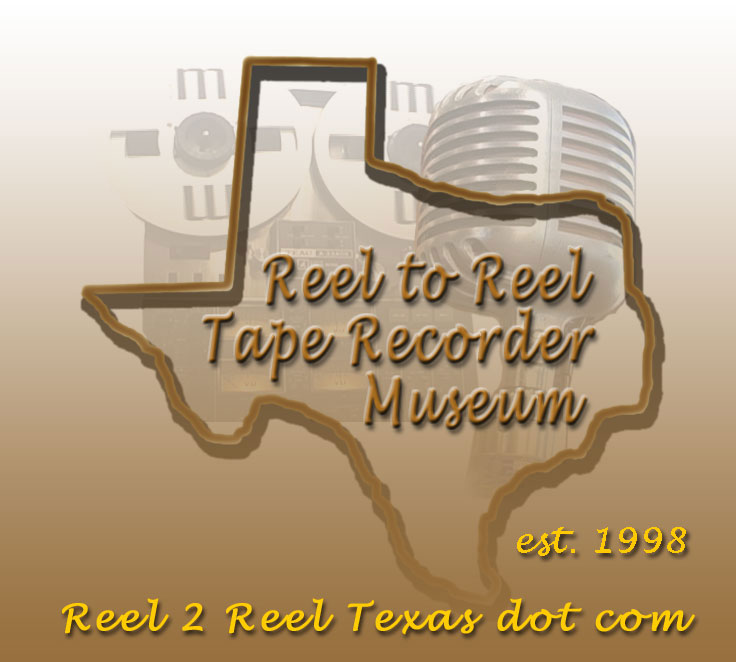


































 992 Craig Residence "Peppergate Ranch" - Built in 1939 and located in West Hills, this one-story single-family residence was designed by master architect Paul Revere Williams (1894-1980) in the Ranch Style. One of the foremost architects of Los Angeles in the mid-twentieth century, Williams was the first certified African-American architect west of the Mississippi River, the first African-American member of the American Institute of Architects, and also served on the first Los Angeles Planning Commission. The residence was built for Talton R. Craig, founder of the Craig Movie Supply Company. The home was built as the primary residence of Craig’s 29-acre ―Peppergate Ranch,‖ later subdivided in the 1960s as Woodlake Estates and Pinelake Estates. (Description from: City of Los Angeles - Office of Historic Resources)
992 Craig Residence "Peppergate Ranch" - Built in 1939 and located in West Hills, this one-story single-family residence was designed by master architect Paul Revere Williams (1894-1980) in the Ranch Style. One of the foremost architects of Los Angeles in the mid-twentieth century, Williams was the first certified African-American architect west of the Mississippi River, the first African-American member of the American Institute of Architects, and also served on the first Los Angeles Planning Commission. The residence was built for Talton R. Craig, founder of the Craig Movie Supply Company. The home was built as the primary residence of Craig’s 29-acre ―Peppergate Ranch,‖ later subdivided in the 1960s as Woodlake Estates and Pinelake Estates. (Description from: City of Los Angeles - Office of Historic Resources)











































 Massachusetts, United States, by Henry Kloss, Malcolm S. Low, and J. Anton Hoffman originally to produce loudspeakers. KLH had sales of $17 million, employed over 500 people and sold over 30,000 speakers a year before it was sold to Singer Corp in 1964. Later it was bought by Electro Audio Dynamics Inc. and moved to California in 1980.
Massachusetts, United States, by Henry Kloss, Malcolm S. Low, and J. Anton Hoffman originally to produce loudspeakers. KLH had sales of $17 million, employed over 500 people and sold over 30,000 speakers a year before it was sold to Singer Corp in 1964. Later it was bought by Electro Audio Dynamics Inc. and moved to California in 1980. 

































































































































 Robert G. Metzner and Robert Craig founded Roberts Electronics, Inc. Robert Craig's farther Talton Craig was Robert G. Metzner's Califone distributer. Talton Craig enabled Robert Metzner to acquire a wide distribution network for Califone & Roberts.
Robert G. Metzner and Robert Craig founded Roberts Electronics, Inc. Robert Craig's farther Talton Craig was Robert G. Metzner's Califone distributer. Talton Craig enabled Robert Metzner to acquire a wide distribution network for Califone & Roberts. 













































































































































































